A surprising happening … my spiny cactus suddenly burst out with all these flowers …
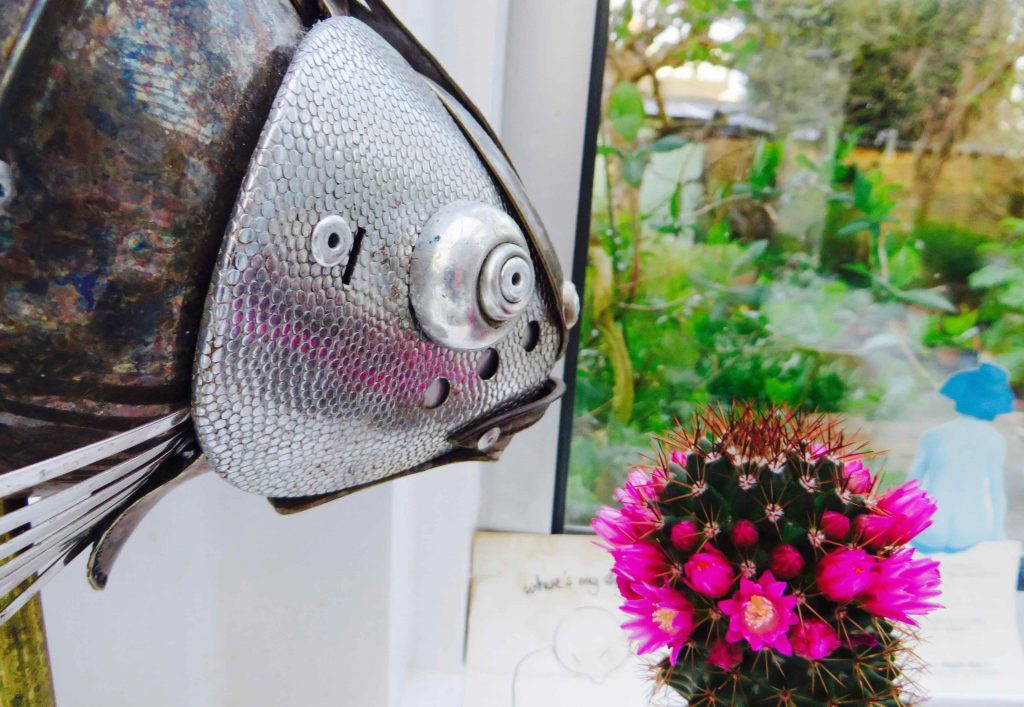
Shockingly glorious! I love ‘pink’.
A surprising happening … my spiny cactus suddenly burst out with all these flowers …

Shockingly glorious! I love ‘pink’.

I was aged ten when I went to the boarding school of St Mary and St Anne, Abbots Bromley, in 1957. Seven years later, in 1963, I left to explore the world.
In July 2019, there was an article in ‘The Times’ about Abbots Bromley closing down. It had changed over the years from a school where pupils did ‘O’ and ‘A’ levels with a bent towards vocational careers, to a less academic establishment, which included dancing and horse riding. Way back then, we were five hundred girls in nine ‘houses’ – later, there were only 300 pupils and it was mixed. Then in July 2019 it was closed altogether at the end of the Summer Term.
I don’t know how much Abbots Bromley influenced me in later life but I’m amazed by how much I remember about it. I suppose it was a seven year stint – of what now seems a strange existence. Five hundred girls in a small village, otherwise known for its Morris Dancing – and especially The Horn Dance. This was performed in front of The Buttercross, an ancient monument close to ‘The Goat’s Head’ pub.
We wore these ‘wimples’ on our heads only on Speech Day in the summer. Otherwise, we had straw ‘boards’ (boaters). In Winter, a navy uniform with a white shirt and a tie whose colour showed what ‘house’ we belonged to. Mine was pale pink.
I envied the dark green one. Those belonged to ‘Crofts’ – a small ‘house’ which was in a very pretty building, covered in vines, in the village. I had a friend called ‘Jinx’ there and was sometimes invited for lunch, which was very cosy and ‘unschoollike’. Otherwise, ties were red, blue, purple, turquoise, orange, light green and yellow. A rainbow.

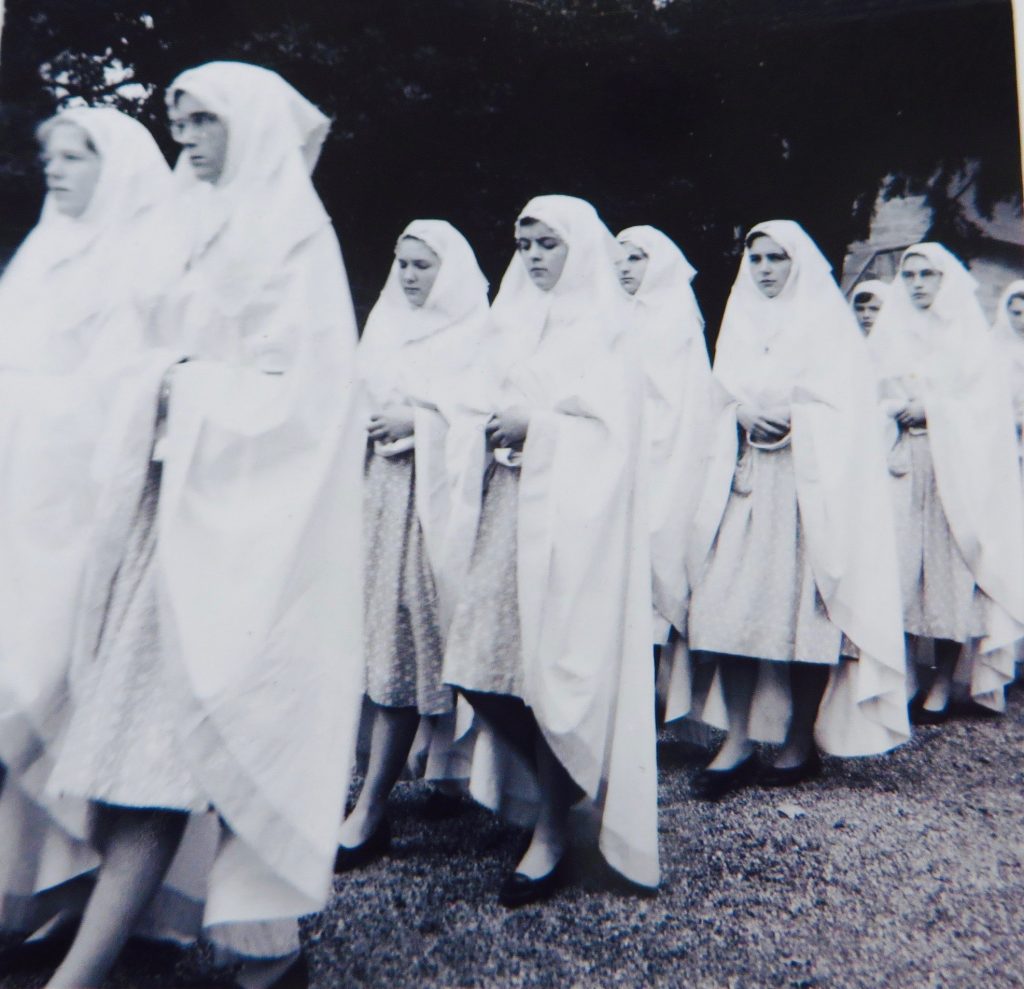
Abbots Bromley was one of the Woodard schools, set up by a clergyman. There was a lot of church going, which was High Anglican. One of the sixth formers swung the thurible, filling the church with the scent and smoke of frankincense and myrrh as she made her way to the altar, followed by the ‘boat boy’, who carried the aromatics in an oblong silver vessel. I would have liked to have been a ‘boat boy’ but this dream was never realised. But I did get to light and snuff out the three red sanctuary lamps in the chapel at Evensong.
My main memory of the chapel was fainting at First Communion and knocking over the whole row, who were praying on their knees. After I had been dragged out, following a terrible ruckus, I had to go and apologise to the headmistress, Miss Roch.
Luckily, I didn’t miss First Communion breakfast. We were given a beautiful bouquet of Easter flowers and a card showing Jesus, ‘The Light of the World’, painted by William Holman Hunt (1827-1910). I kept this in my hymnal, which we used every morning at School Prayers.
We sang both a psalm in plainsong and a hymn before the headmistress read out various events that were going on. I think it was in the Spring term that the whole school sang the ‘Benedicite’ in prayers. It had a strong rhythm and melody and we all sang our hearts out. It included God blessing all the animals and sea creatures and insects, which I liked.
Evensong, in the chapel, was on Wednesdays and Fridays, Compline was on Saturday evening. On Sunday morning we went in a crocodile line down to the church in the village, where the Chaplain was waiting to conduct the Morning Service. Then it was back to chapel in the evening for another Evensong.
The entry into the chapel had a lot of white marble, including the floors and a beautiful table, always decorated with a vase of fresh flowers. The cloisters gave onto the private gardens, belonging to the staff houses. We all had our favourite hymns and wrote notes of undying love to our friends on those pages. Forbidden, of course.
Lining up in the houseroom to go to chapel on a Sunday evening clashed with ‘The Top Twenty’ popular songs on radio. This was a precursor of ‘Top of the Pops’ on TV. But The Beatles were just about in evidence and becoming the talk of the dormitory.
Meanwhile, we also had to learn the Catechism, followed by a ‘collect’ every Sunday. In the afternoon we wrote our letter home, which was checked before sending. Our housemistress would pounce on somebody to stand up and recite the ‘collect’ by memory.
Our choir was in the hands of the glamorous Louella Harris and I still remember the beautiful swoops of the ‘Ave Verum’ and the ‘Kyrie Eleison’. Those of us who didn’t get into the choir (like me), were left with Miss Roadknight, whose determination to get us to sing as well as possible elicited a lot of spitting as she enunciated … nobody wanted to sit in the front row.
I was quite anxious when my parents dropped me off at the dark, oak panelled entrance to the school for the first time, leaving me to confront an unknown world as the old Austin disappeared down the driveway and turned out left into the road on its return home.
But a smiling face appeared. An older girl, Jennifer Fisher, greeted me and took two of us new girls for a cup of tea and a bun before accompanying us up to our dormitory. Matron had made up our iron bedsteads – she took our tuck boxes and locked them in a cupboard. Life at school began.
TEACHERS I REMEMBER
Miss Crawley-Boevey. She was deputy headmistress and taught Geography. She had some sort of contact with royalty and her brief included teaching us about sexual intercourse later on. She was a handsome figure.
The Honourable Xenia Pleydell-Bouverie. She was the games mistress who taught us lacrosse. I was left wing and did a lot of speeding up and down along the edge of the playing field. Miss Pleydell-Bouverie joined in the action, shouting ‘cradle’, ‘cradle’, as we tried to get the ball into a tiny triangular goal. She also came from an aristocratic family and it was said she’d run away from home to become a games mistress? I preferred netball (shooter) and rounders and tennis in the summer. We also played cricket and I enjoyed being ‘long leg’ in the long grass. So not very sporty really.
Mrs Atkinson. She taught ‘A’ level German (she was German) which I studied along with French. We read German literature (‘Wallenstein’ by Schiller and poetry) in the old fashioned script. Mrs. A was dramatically beautiful with a creamy complexion, dark curly hair that flowed over her shoulders and a slash of red lipstick. She was very different from the norm. One day she was late for our class – there were only six of us. She breezed in saying ‘Mein B-H ist kaput’. Her bra had snapped! We liked her a lot. Where did she come from, where did she go?
Mr Heald. A token man. He was a great Maths teacher, although it did take me five times to pass ‘O’ level Maths. Everyone clapped when I got the long longed-for result. Mr. Heald was full of enthusiasm, a favourite among us all.
Miss Hann. Our English teacher. She was under five feet tall and a purposeful character, discussing our essays with great pzazz. She taught me to love the Romantic poets and we pushed back the desks to act out Shakespeare. I was lucky to have her, as this was my best subject. In the sixth form, we were allowed to write our essays in the library, which was light and warm with French windows opening onto the garden. I wish I had made better use of it. The prefects’ Common Room was more tempting as we could make toast and tea and have a chat with the other heads of houses.
Miss Jesse.(known as Jezebel) She had been a pupil at the school. Her voice was unintelligible and she gave out many detentions. She sat at the front of the class on a high desk and we all got a detention for laughing when one of her stockings fell down. She also taught Girl Guides. One time we almost died of food poisoning after trying to cook sausages over a bonfire. Carbonised on the outside, raw within. I’ve never liked sausages since.
Mr Hensher was something else. The Chaplain became ill and he arrived to be the religious stand-in. He was tall and good looking but with strange, wide apart, eyes like marbles, which seemed to see through you. He taught us Divinity besides being our Chaplain and we were mesmerised as he talked about the dark clouds of the nether world.
He asked us to think of a flower without saying what it was, then he would go round the class, getting all our flowers right. We were agog. He finally organised us to go on a CND march to London one weekend and at that point he disappeared. I expect he was sacked.
Later on at university I opened a ‘News of the World’ Sunday paper. There was Mr. Hensher – a vicar in a country village with his black labrador, advertising for a wife who looked like Ingrid Bergman. The congregation were up in arms! He brought melodrama and excitement into our lives for a short time.
I liked biology but somehow didn’t crack Physics and Chemistry. We had an exciting lesson in Chemistry when Miss Underwood dropped a piece of sodium into water by mistake and it exploded everywhere. To add to the general pandemonium a girl who was rather glamorous and came from Zanzibar, fainted. We made pink soap and blue crystals but valences escaped me.
We also had a weekly lesson called ‘Human Biology and Hygiene’. This taught us how to look after our bodily selves and then progressed on how to run a house, have a hygienic kitchen, mend clothes, make beds (with so-called ‘hospital corners’), mop floors and perform basic first aid in case of accidents.
Unfortunately, cooking didn’t come into it for me. The choice was Latin or cookery. The two top forms did Latin and the third level got to cook and eat their own lunch every Wednesday in a modern cookery lab. We were all very envious!
I learned to cook later on – something I now do nearly every day – I have no use for Latin but I suppose it helped with French and German. I did enjoy Virgil’s ‘The Aeneid’ but Caesar’s Gallic Wars with their wretched earthworks drove me to distraction, as did the subjunctive. But I do love both Greek and Roman mythology. I later discovered that I love going out to restaurants instead of cooking all the time …
Some mothers sent birthday cakes in a tin by post and this was given out in slices to friends. I remember an iced cake covered in crystallised violets. Sprigs of real violets dipped into hot liquid sugar and left to dry. When you bit into them the remains of the petals could be seen.
There was a wonderfully old-fashioned art studio upstairs in an old barn but I just couldn’t paint, even though I loved colour. Miss Foster, who wore eclectic smocks, did have her favourites. She lived with the Head of Music, Miss Wadeley, who was in charge of a big, old fashioned music wing with separate rooms for practising piano.
The ‘cells’ all had names of famous musicians on the doors. Palestrina, Mendelssohn, Brahms, Beethoven, Liszt, Mozart etc. Miss W used to come and listen at the door to make sure we were practising. My sister turned out to be a very good pianist.
Matrons presided over the dormitories and generally oversaw hairwashing, bathing, mending and shoe cleaning. Head matron, Miss Jones, who treated our ailments, was known as Kipper Feet, due to the way she walked. Her lair was in Doctor’s Room. Sore throats had to make a line. She had a long paintbrush which was dipped in a jar of sticky, black liquid and painted our throats one by one. What was it? I didn’t ask. We got better.
Miss Metcalfe handed out clean sheets each week from the ‘hot cupboard’ and kept a watchful eye on the tuck boxes, which were in another locked cupboard, opened by her once a week.
For some reason she refused to let us have our sweets one week, so two of us locked her in the hot cupboard, which was actually a small room. She did manage to call for help in the end and we were all called together in the houseroom and asked who had done this. Nobody told. There was a unbreakable sense of solidarity.
Each table in the dining room had a teacher or prefect in the middle. We had to make conversation with her so as not to get a bad table grade. At the same time we were not allowed to ask for, say jam for our bread – somebody had to ask you if you wanted some and then pass it to you. If you failed to make sure your neighbour had all she wanted, that meant another black mark.
Meanwhile, bacon on fried bread, which I loathed, was being clandestinely pushed behind the radiator. Semolina pudding was for seconds – one day I found a bluebottle in mine, so I couldn’t bear ‘seconds’ any more. We were meant to eat everything – so nobody had allergies then?!
My sister was in the choir and they were sometimes asked to sing at weddings. If they got back late at night, they had to come in through the dining room, crunching cockroaches underfoot. This haunts her still. I suppose all that food that fell on the floor ‘by mistake’ made up a banquet for ‘creatures of the night’.
We had two baths a week, which I looked forward to, especially in the Winter. There were no doors on the bathrooms and Matron would come and check that all was well and that we hadn’t used too much hot water. I filled it up after she had left.
In the sixth form, we were allowed to go in threes for a bicycle ride. One day we came upon a dead fox and extracted its teeth. I kept this long canine tooth in my pocket and would polish it from time to time. Sometimes on our rides we would get as far as Uttoxeter and find a café which served fish and chips and mushy peas – much preferable to school dinners. We became bolder.
The playing fields were enormous. Each morning we ran around them before breakfast and got back in time to turn our mattresses before the gong went. There was five minutes before the second gong. If you were late, you got another bad mark. You were not meant to run down the corridors … a no-win situation!
We did go to Stratford-upon-Avon a number of times in a coach to see Shakespeare’s plays, which was a great treat. We also went to Wimbledon one year as the father of one of the girls was a vicar whose parish was near the tennis courts. He supplied us with delicious bowls of strawberries and cream in his garden afterwards.
There is a fantastic photograph by Jane Bown of schoolgirls at Wimbledon in the 1950s. It was shown in ‘The Observer’ on 23.06.19 as ‘The big picture’. It’s a perfect photo to show how we were about to experience a great cultural shift. How ‘the teenager’ was about to appear and change the lives of young people like us. Do look it up. Life outside of Abbots Bromley beckoned … but we didn’t yet know quite what was in store …
Meanwhile, there were films (set up in the gym) some weekends. We swooned over Gregory Peck, Kenneth More, Richard Todd, Humphrey Bogart … I think it was then I fell in love with David Niven in ‘The Guns of Navarone’ but I rather fell for Gregory Peck too.
‘Lassie’ (the dog) was a hit. Alec Guinness was in ‘The Ladykillers’, ‘Kind Hearts and Coronets’ and ‘Bridge on the River Kwai’. Cary Grant in Hitchcock’s ‘North by North West’. ‘The Lady Vanishes’ with Margaret Lockwood – another Hitchcock. ‘Brief Encounter’ with Celia Johnson and Trevor Howard made us aware of the trials and tribulations of forbidden love …
We wept for Richard Todd and his black labrador in ‘The Dam Busters’. Romantic films with sex scenes, though, were few and far between. I think we got to see ‘South Pacific’ with smoothie Rossano Brazzi. I definitely remember ‘Casablanca’ – wet handkerchiefs all round. I identified strongly with Ingrid Bergman and she just blew me away. Life after school – it was all to play for …
One time I had ‘flu so badly, I was sent to the ‘San’, which was hidden behind trees at the bottom of the tennis courts. It seemed as if I was in solitary confinement as the only person I saw was ‘Sister’ in her white coat, who brought me subsistence meals.
I found a shelf of books as I began to get better. They were all Agatha Christies and I read every single one. Perhaps that’s why I like Agatha Christie. She had an interesting life herself and I recommend her account of accompanying her husband, Max Mallowan, on his archaeological trips to the Middle East. She had a very self deprecating and dry sense of humour.
Each year we made things for the bazaar. We knitted hats and gloves and teapot cosies and sewed furiously, but the main stall was lampshades, made with raffia woven on a steel frame into intricate patterns. For some reason, they were very popular.
I can’t help thinking of ‘Molesworth’ in this context. The book ‘Down with Skool’ by Geoffrey Willans, wonderfully illustrated by Ronald Searle, has a character in it called ‘Grabber’ who is ‘skool captane of everything and winner of the Mrs Joyful prize for rafia work’. I think the proceeds of all of this industrious toil were sent to deserving charities with a religious bent.
Our parents were allowed to visit us twice a term. We could take a friend out. My mother often brought the lunch from home and we ate it from the back of the car, overlooking the Blithfield Reservoir, near Bagot’s Wood. We finished off with tea in a thermos flask. It wasn’t very relaxing and sometimes the weather was bleak and cold. Somehow I felt school was school, home was home and it was best not to mix the two. But she did make a great lunch in difficult circumstances …
I had gone to ballet classes before I started school but now we learned the waltz, the quickstep and the foxtrot – did we try the tango? I don’t remember.
No boogie-woogie, no twisting by the pool, no jiving (I do wish I’d learned to do this). And certainly no jitterbugging. That was all to come. I was one of the taller girls, so I always had to play ‘the man’, which I found awkward when I had to do it the other way round. One girl’s mother sent her a pair of ‘kitten heels’, which we all drooled over.
In the sixth form at the end of the Autumn term, there was a dance at a nearby boys’ school – Denstone. Our mothers sent us suitable dresses and shoes for the occasion. I expect we looked frumpy. Partners were chosen by putting one of our shoes in a pile in the centre of the room and the boys picked one they liked. Disaster.
Repton was another favoured boys’ school, which I found rather more engaging. Boys were allotted a girl’s name and had to write to us beforehand, introducing themselves. We got quite excited but my boy wrote to me a few days before the dance to say he had been expelled.
My mother had sent me a green, silk dress with capped sleeves, which she had made. I thought it made me look like a water nymph – (sadly mistaken, no doubt). See ‘Hylas and the nymphs’ – painting by Waterhouse (1849-1917). One girl’s mother had sent lipstick, which we all borrowed … it was called Pink T.N.T.
Our coach arrived at Repton and I had no partner. Matron said I could sit with her in the dance hall. Each boy held up a board with their girl’s name on it as we got out of the bus. Then I saw my name. Somebody had made sure I wasn’t to be alone all evening.
And the boy was tall and handsome with a big smile. We were not meant to leave the dance hall and our partner had to have a dance with Matron. After this, he asked me if I’d like to go for a walk in the grounds. We had a lot of fun, only curtailed by one of the Masters spotting us and sending us back. I was very popular for a day or two recounting my adventures and it was a great boost to my confidence.
I still have one of those long school photographs of everybody – girls and staff. It was taken on the tennis courts. But I only know one girl from Abbots Bromley now.
For all these seemingly odd and pointless rituals that we went through, I did develop a sense of responsibility towards others and a consciousness about what was right and wrong.
We were taught to always think of others before ourselves. This was good in some ways but somebody was complaining in the paper the other day that ‘coronavirus’ had changed her into a fifties housewife. I completely understand this. Family life is more balanced today in that women do have more opportunities but there’s still some way to go. And if you have been instilled with a certain mindset, it’s difficult to change. But the next generation have more chance.
The strong religious element of Abbots Bromley never quite captured me. I feel more pantheistic than anything and always did. Maybe that’s why I ended up married to an environmentalist.
Churches were often built on the sites of old temples to the sun. The number of different religions is enormous but they seem also to instigate violent wars against one another. Without the sun and water and the right sort of balance and temperature, we simply wouldn’t exist anyway. But living life within an infrastructure is quite helpful and that can be religion for some. Formal religion didn’t work for me, although I am not totally against it. I loved singing ‘And did those feet in ancient time’… on Speech Day. Horses for courses …
Above all, Abbots Bromley had a good heart and probably turned out many girls who made a difference to a sometimes challenging world. It made me independent and able to look after myself in the years to come – and instilled a strong streak of common sense to overcome adversity.
I wouldn’t have written about my school except for the fact that first it was closed down and now is about to be re-opened by the Chinese. I am curious to know what will happen next. Maybe we should be singing, ‘And did those Chinese feet in modern times …’?
I’m happy to have tried to make some sense of those seven years. I thank my parents for trying their best to give us an education that would stand us in good stead for life ahead. They gave it their best shot. They can’t be held responsible for the outcome.

Recommended books about the 1950s :-
‘Perfect Wives in Ideal Homes’ – the story of women in the 1950s by VIRGINIA NICHOLSON
‘The Fun of the Fifties’- Ads, Fads and Fashion by ROBERT OPIE
‘The Best of Times’ – Growing up in Britain in the 1950s by ALISON PRESSLEY
‘The Hulton Getty Picture Collection – 1950s’ – NICK YAPP
END
Last September I had been complaining that a ‘real’ holiday, not accompanied by work, had become, more and more, a ‘pipe dream’. ‘Well, just book something and I’ll fit in with it’, said John, as if he was batting away a mosquito. I had just got a brochure from ‘Travel Editions’. One of the trips was almost the same as our Greek odyssey in 1970, where six of us travelled in an old Land Rover across Europe, ending up in the Peloponnese, via the island of Skiathos and Athens.
One site we were disappointed to miss out on – because for some reason it was closed – was Delphi. This current tour took in Delphi, Olympia, Nafplio, Mycenae, Corinth, Mystras and Sparta, nearly all of which we did manage to visit – fifty years ago. John was hooked, I was excited and happy …
But in February ‘coronavirus’ was in the news more and more frequently, rearing its ugly and terrifyingly invisible head. It reminded me of Hercules trying to kill the Hydra – a serpent with numerous heads. If you cut one off, two or more would quickly grow out of the stump. This virus was stalking the world, creating chaos and in many cases, death. It had apparently arisen from wild animal markets in China, linked to bats and pangolins and had made the jump to humans. I was getting more and more anxious but when I rang ‘Travel Editions’, the tour was still up and running. We decided to risk it.
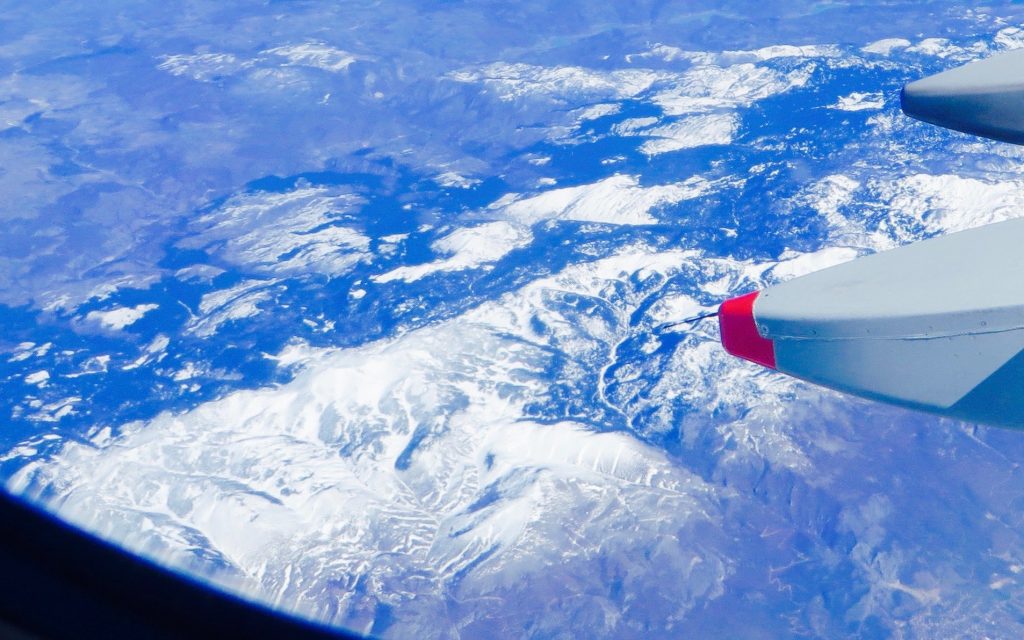
Jeremy Paterson, our enthusiastic tour guide, who taught Ancient Greek and Roman history for over forty years at Newcastle University, collected us together at Athens airport and we were soon plunged into the Greek landscape with Nikos, our driver. I felt relaxed, footloose and ‘fancy free’. We had got here, Jeremy was in charge and I could sit back and enjoy a ‘real’ holiday, with somebody else doing all the organising. Bliss!
Arachova is a delightful mountain village near Delphi. Our room at the hotel Likoria had a balcony overlooking the mountains and the Delphi valley. We arrived in time to explore, Jeremy suggesting we visit the church, which was approached via 100+ steps …
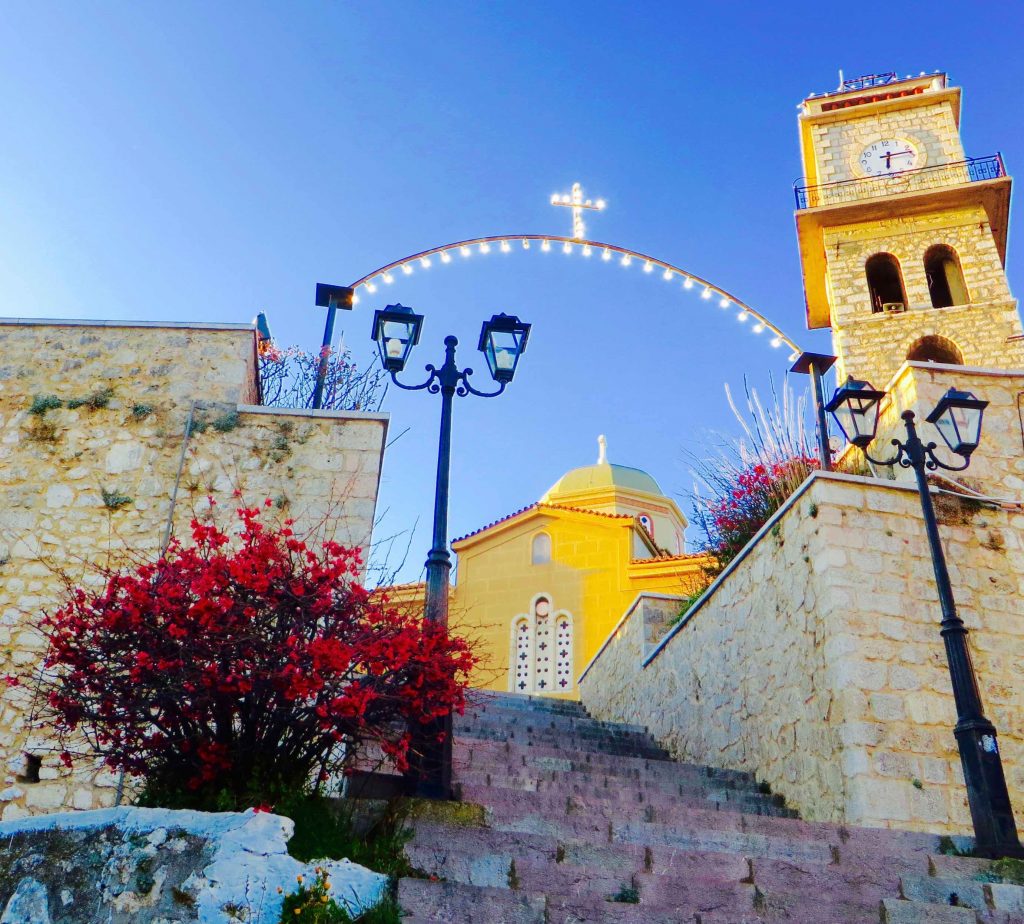

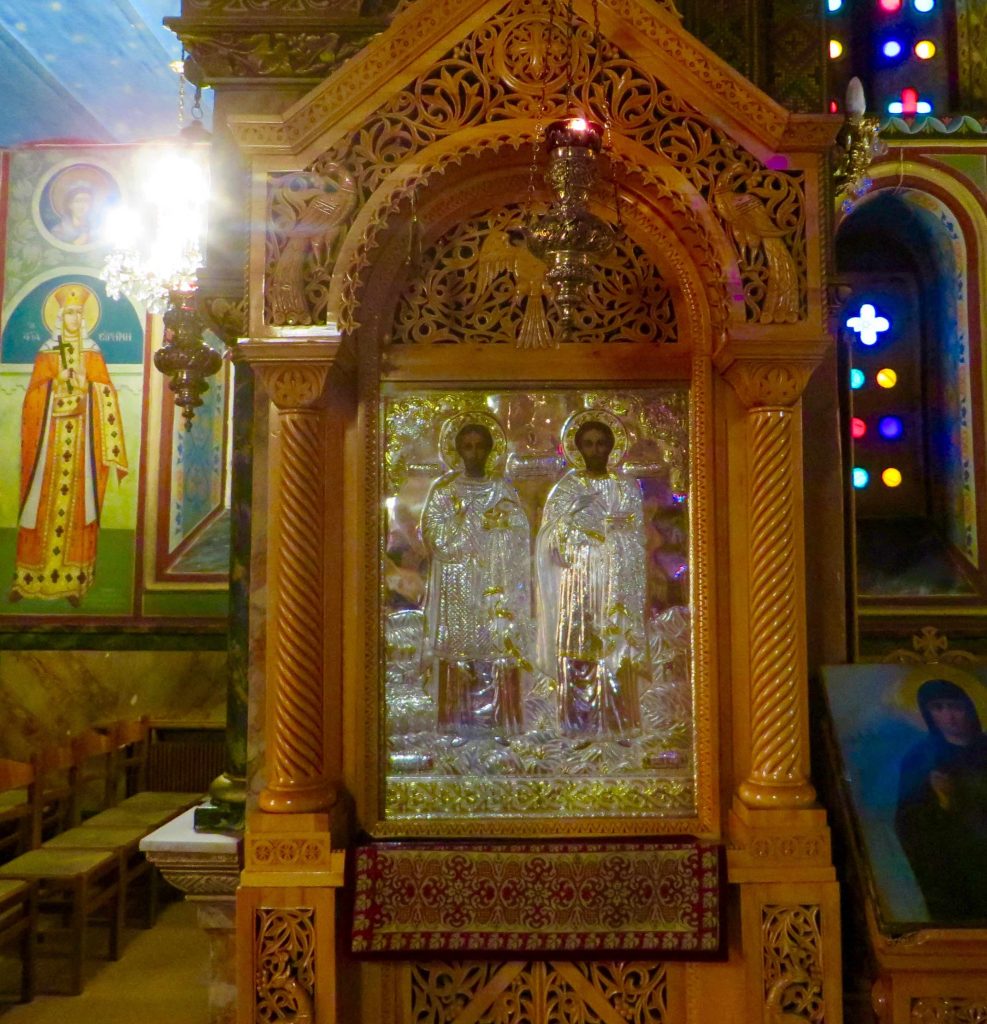
The sun was beginning to wane and there is that magical moment when it blazes for the last time before slipping behind the horizon. I’m not particularly religious in a formal way but I lit a candle and made an offering for being here.

We negotiated our way back to the main street via stray cats patrolling crooked alley ways. Jeremy had recommended a tea shop, which was easy to find, as the window was full of teapots. It not only sold tea but we bought dried apricots, mango, almonds, sesame biscuits and some kind of large citrus fruit which was dried, sliced and vivid green. I wish I had bought a huge bag of it – it was so very delicious.
This village has an alpine feel to it as there is skiing in the winter, which is very popular. But we were in a quiet time between that and summer tourists.

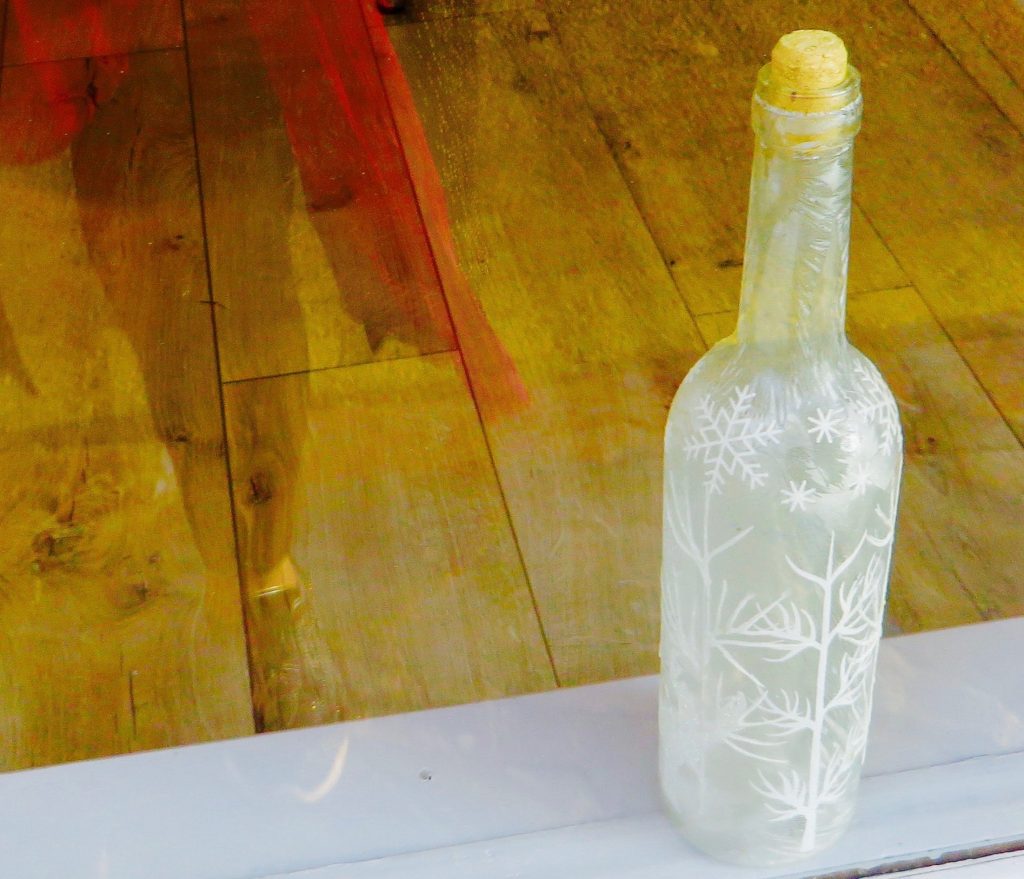
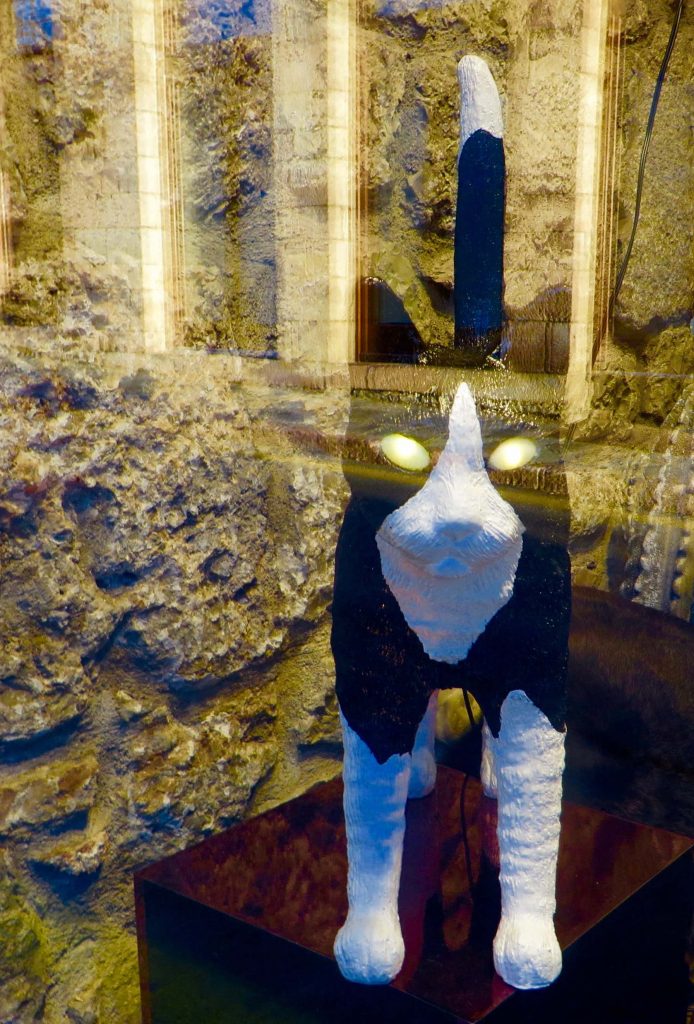
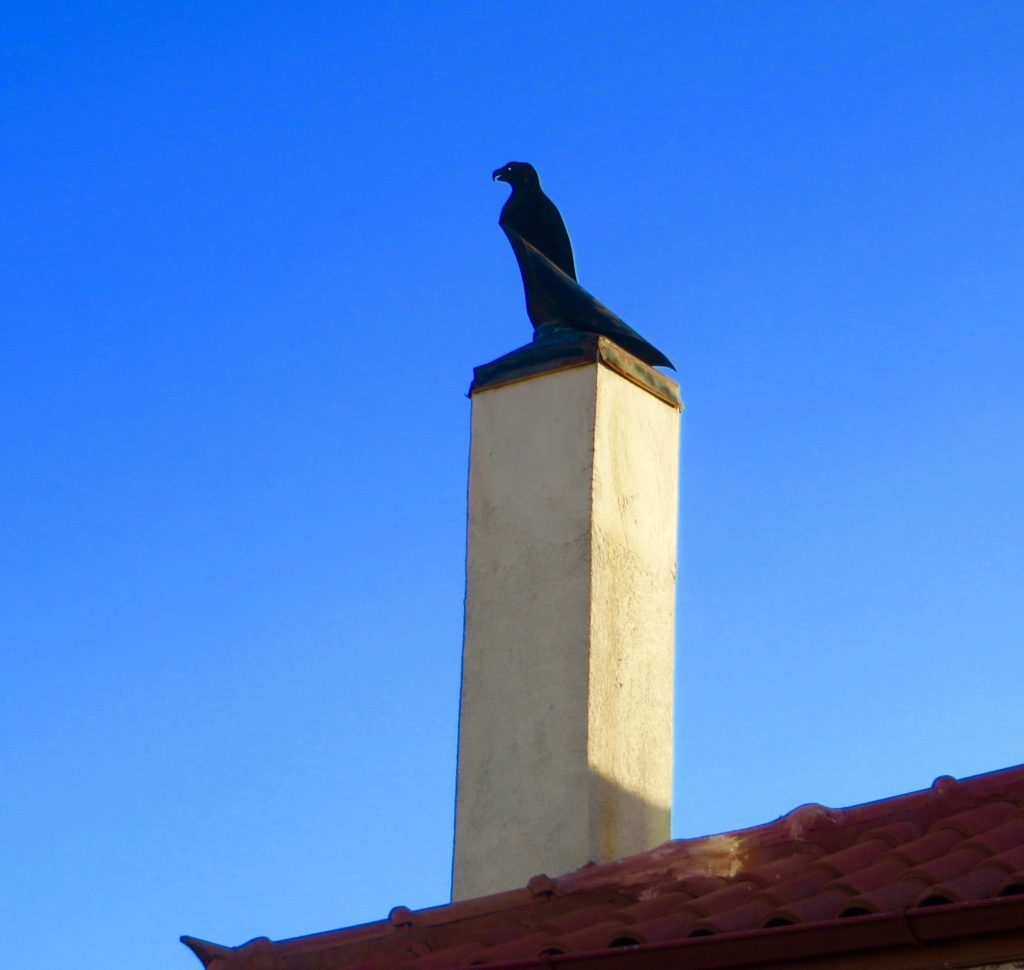
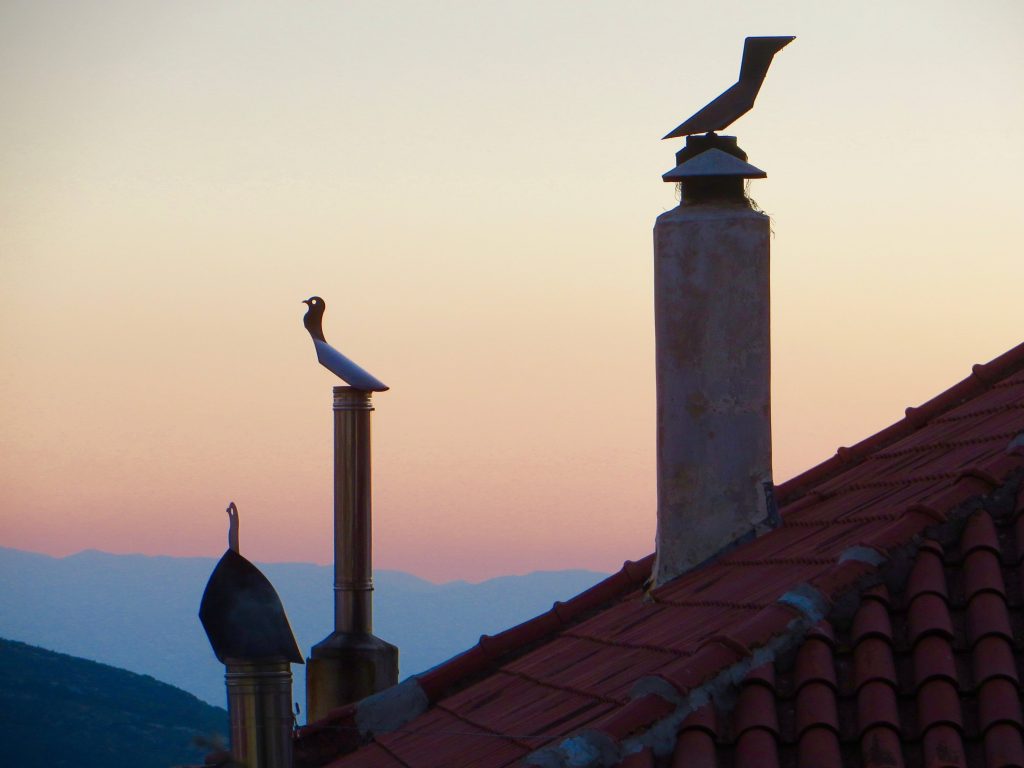
I wonder why Greek chimney pots often resemble birds?
Time for supper at the hotel – the bed is comfortable and I’m looking forward to a good night’s sleep in the mountain air.

I’m more of a one-to-one than a ‘group’ person but Jeremy and Bianca make me feel at home, always ready to answer any questions and full of interesting stories. And I am absolved of all responsibility – they will sort things out. I didn’t realise then how much sorting out they would ultimately have to do.
It’s a glorious day, sunny and warm, bathed in that ‘special’ light of Greece. Greek myths tell us that Zeus sent two eagles out from the ends of the universe to find the navel of the world. They met in Delphi, which was for many centuries the cultural and religious centre and symbol of unity for the Hellenic world. (Jeremy’s notes). Its setting in the landscape is spectacular.
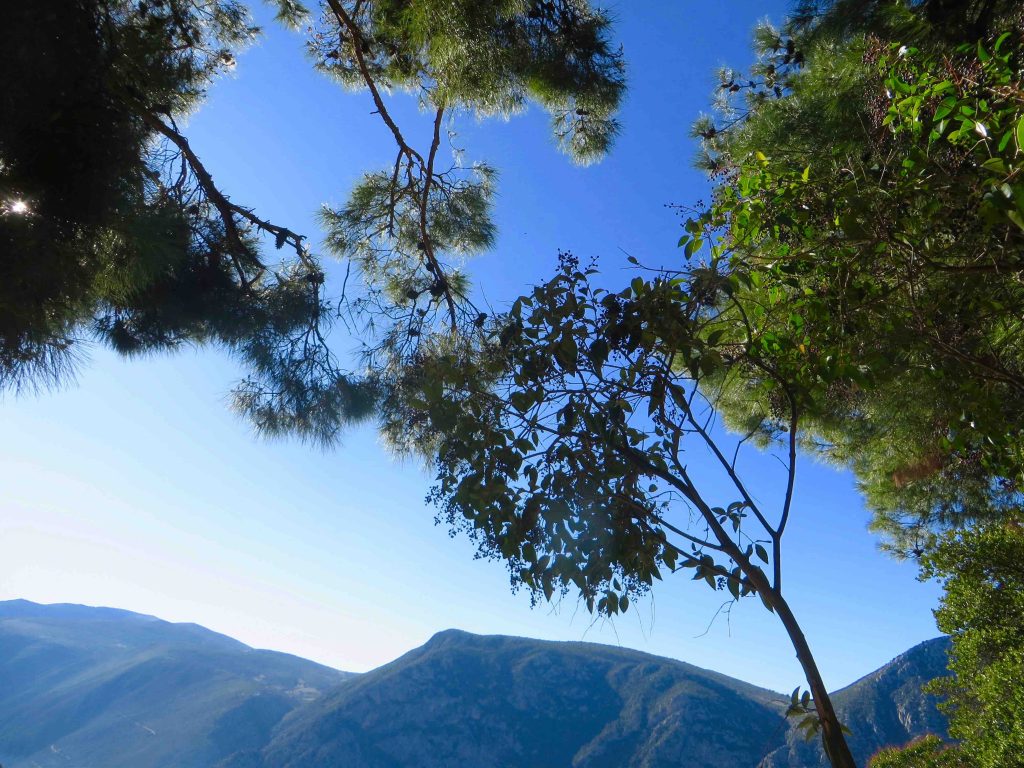
We pass by the Shining Cliffs and meet up with George, our Greek guide, who lives locally and is the son of a priest. He and Jeremy go back a long way. George points out the Castalian spring. This sacred fountain was used to purify people before entering Delphi. Byron apparently plunged in, hoping to enhance his poetic spirit. I held out my hand and drank the clear water, splashing it on my face. I’m open for anything good coming my way. … I hope the ‘Pythia’ was listening …
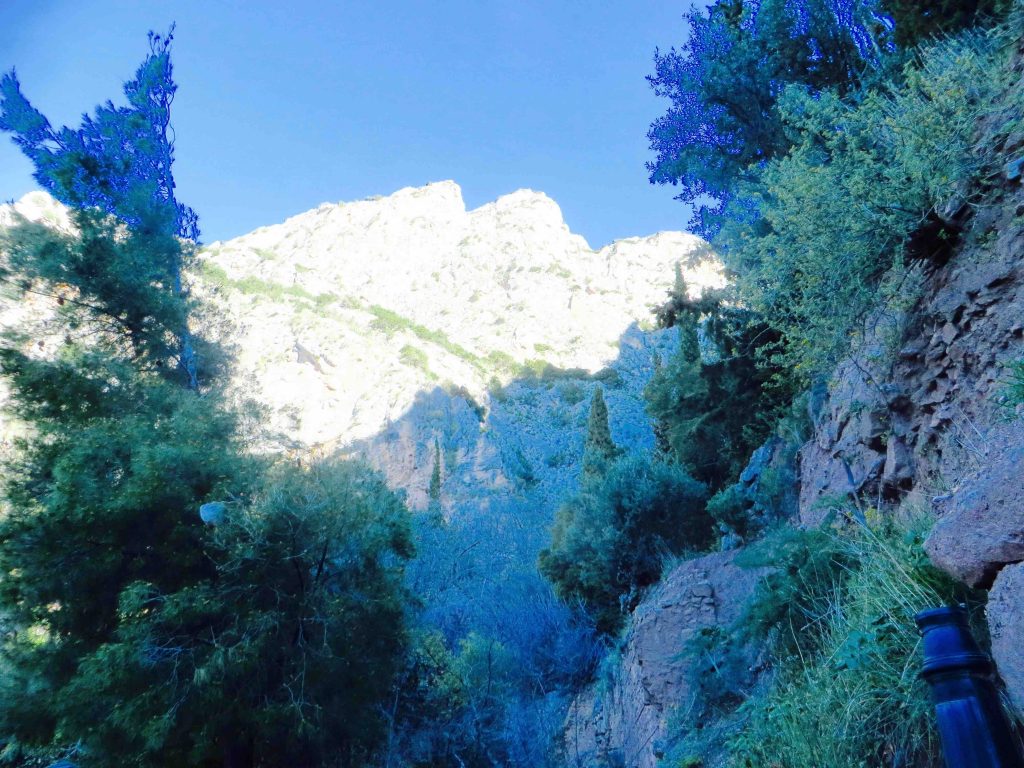
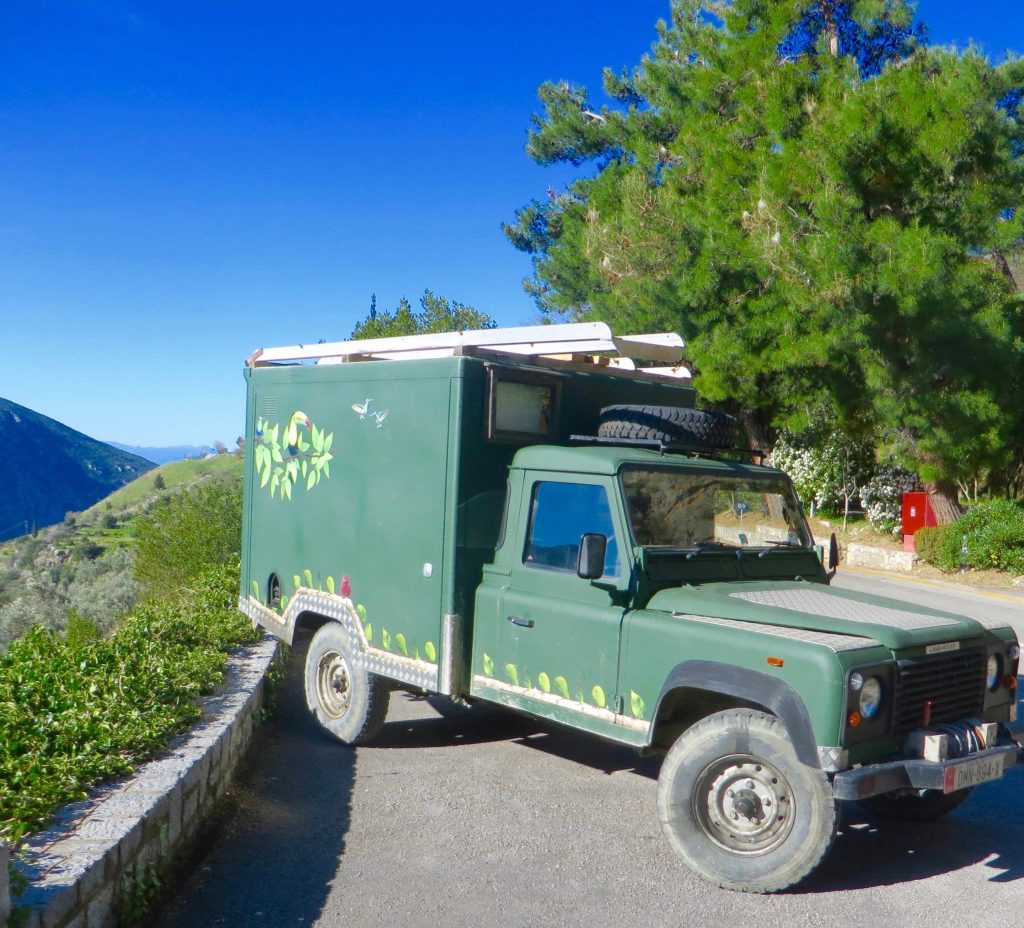
Behind the bespoke Land Rover you can see the tent like nests of the processionary moth, whose larvae attack pine trees throughout the Eastern Mediterranean. It’s a massive problem.
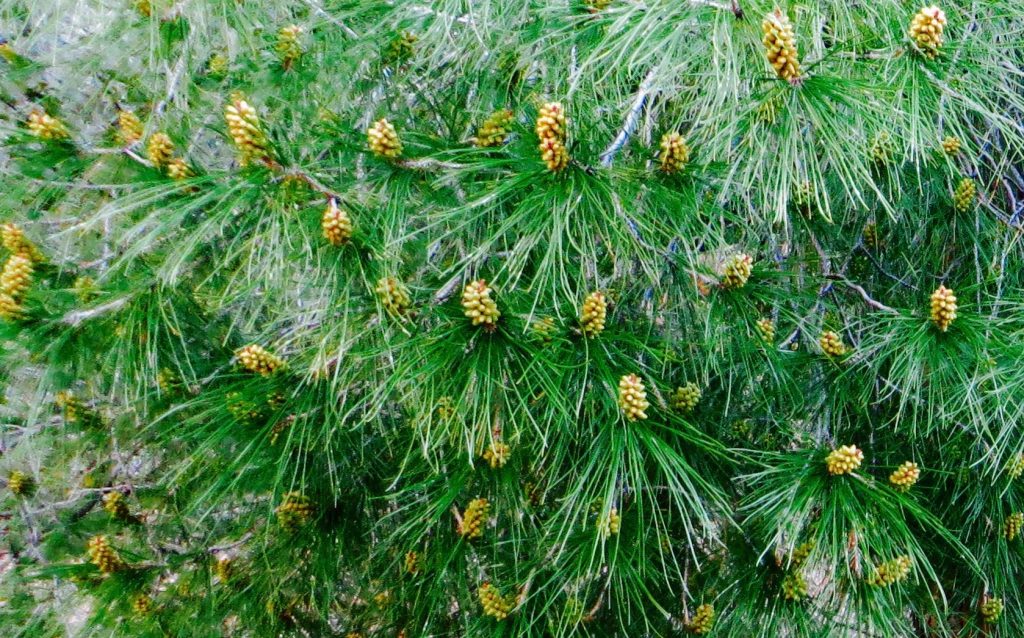
Lots of birdsong. We walked under a bower of yellow, strongly scented flowers, which were buzzing with cohorts of bees …
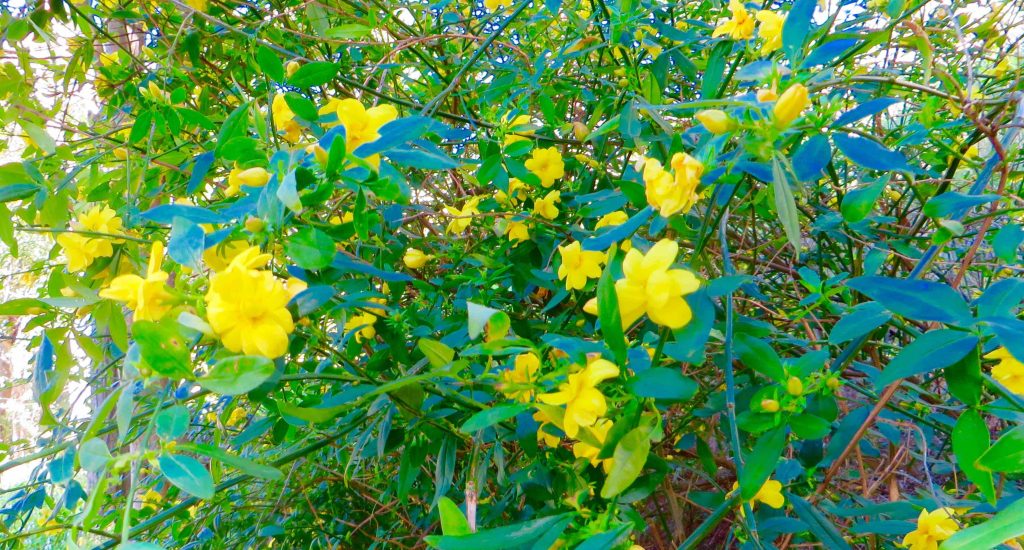
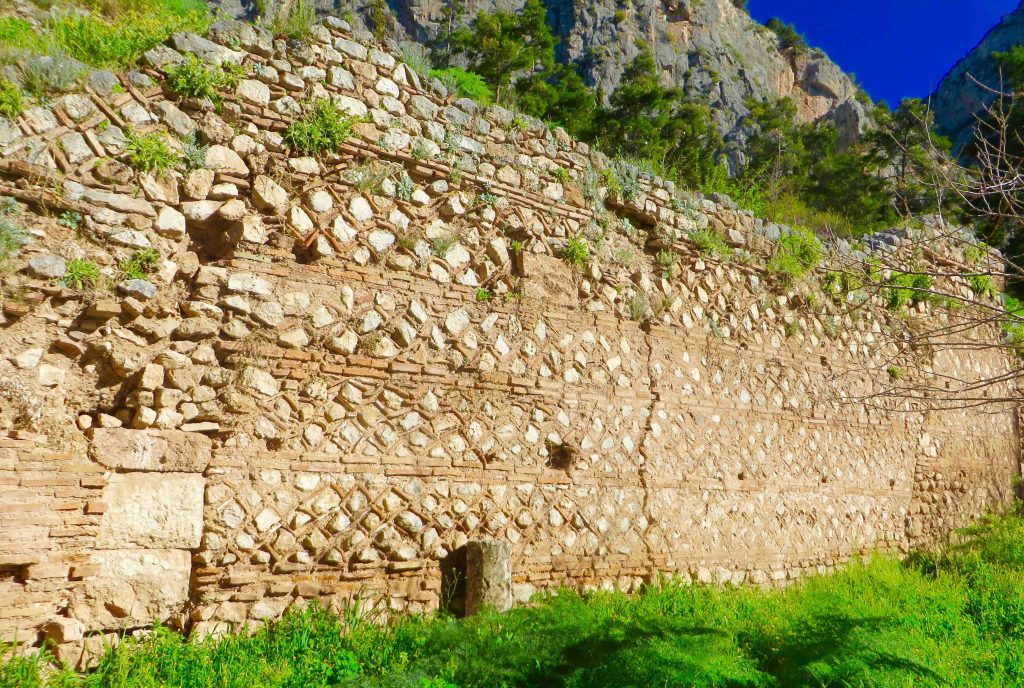

This is a replica of the original 8 metre, bronze column, which is now in Istanbul. There used to be three serpent heads on the top – destroyed – although a small piece of one serpent’s jaw is in the museum in Istanbul.
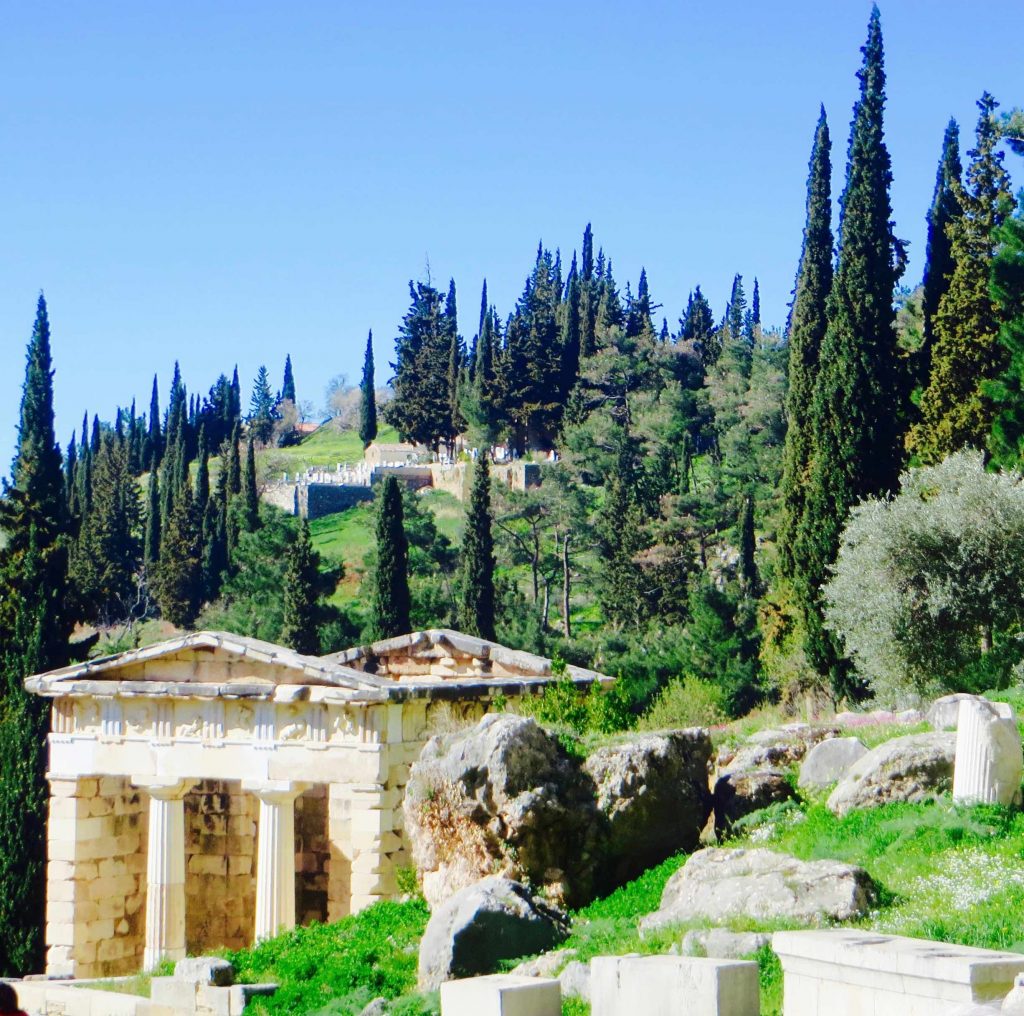
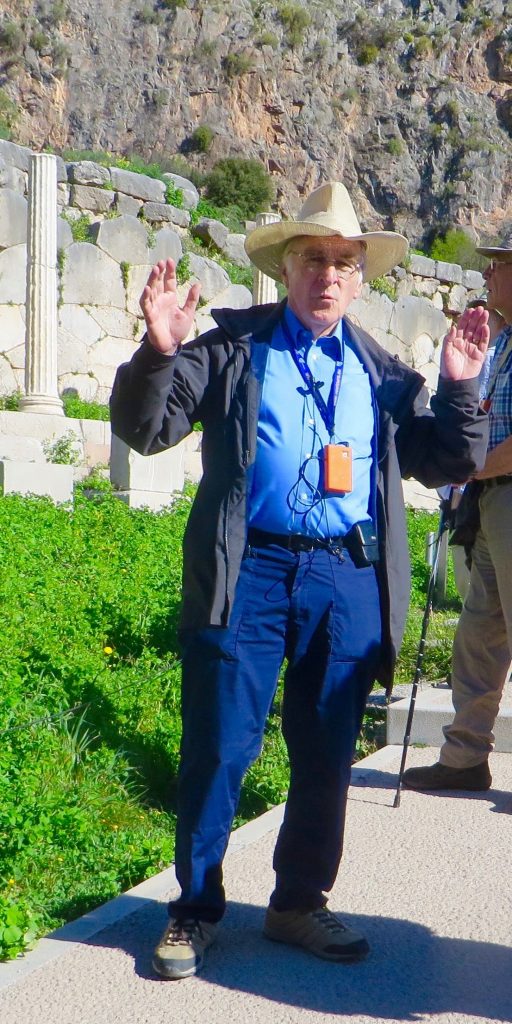
A lot of the stones are carved with inscriptions – in Greek, so I can’t translate them – but apparently many of them relate to the emancipation of slaves. The Greeks’ view of making slaves free men is interesting – different from the norm.
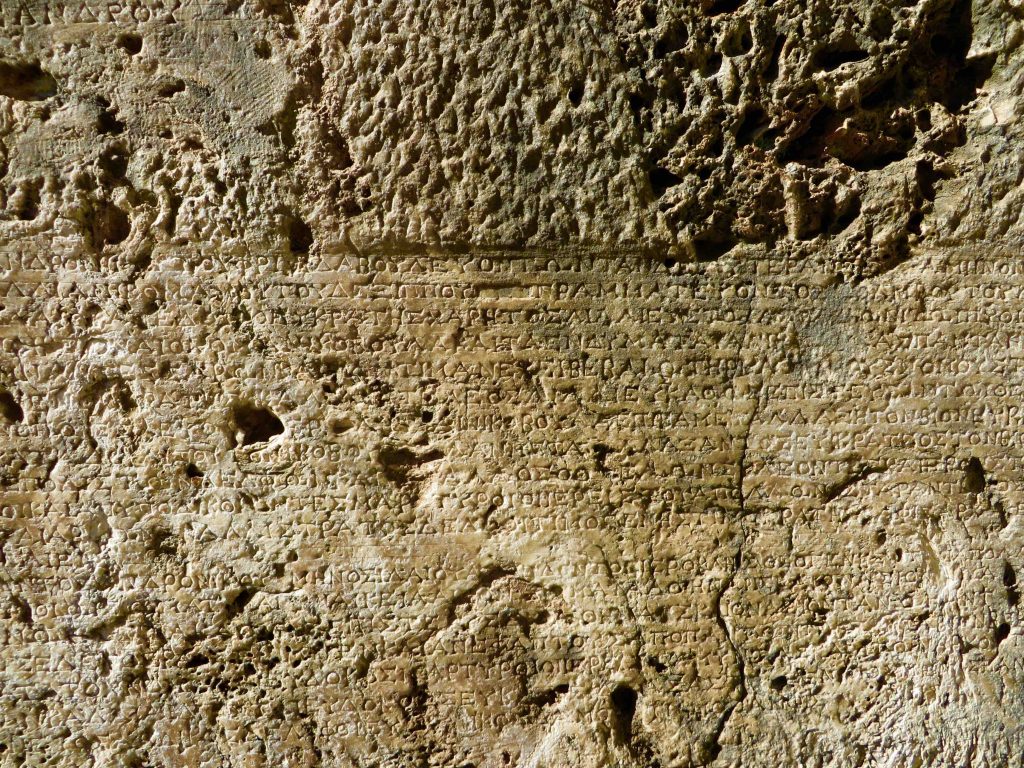
I don’t own a cat but I was rather taken by the one which followed us around the ruins …
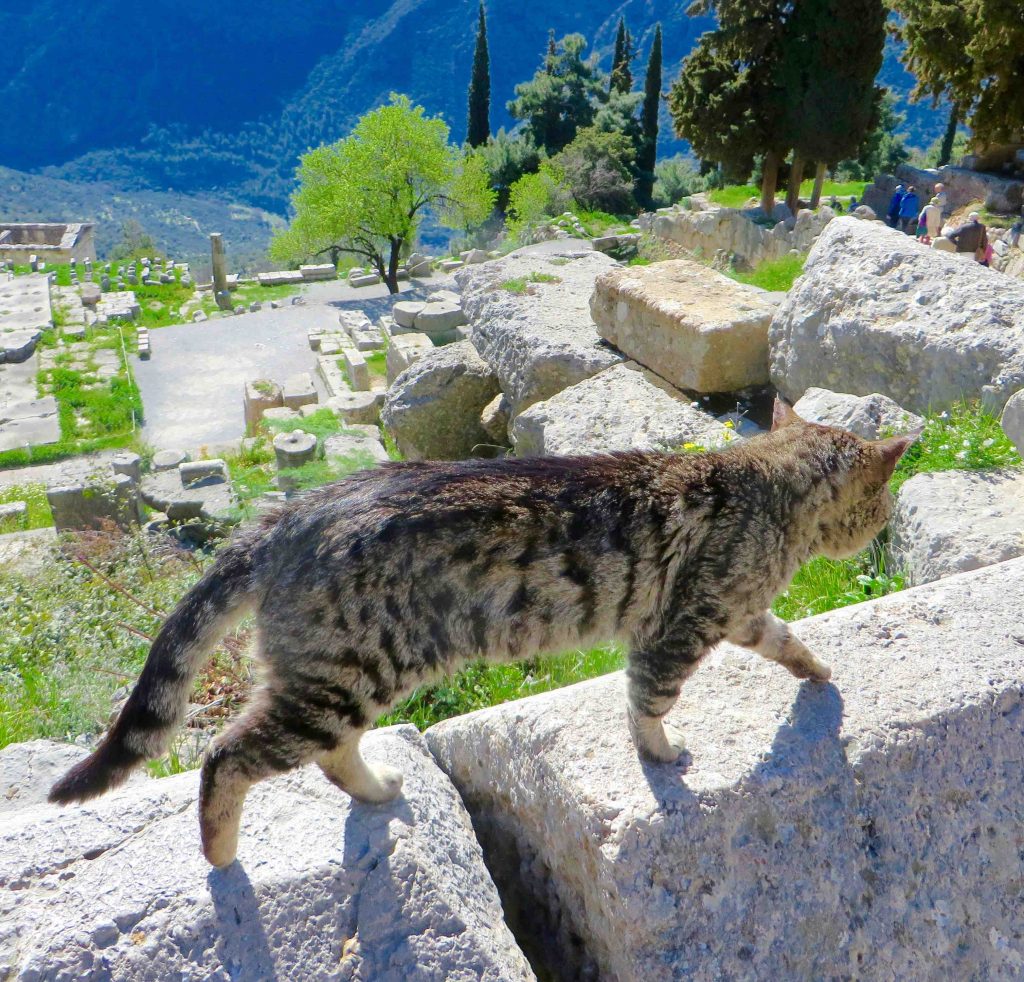

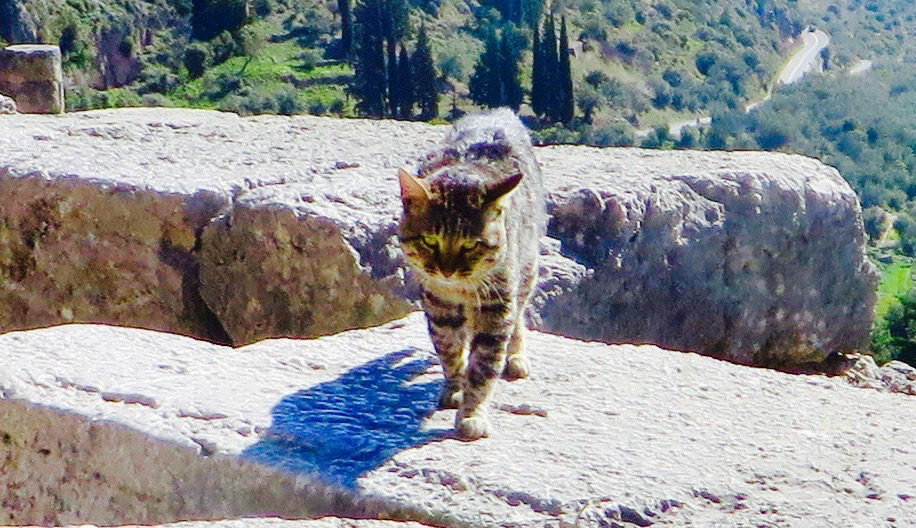
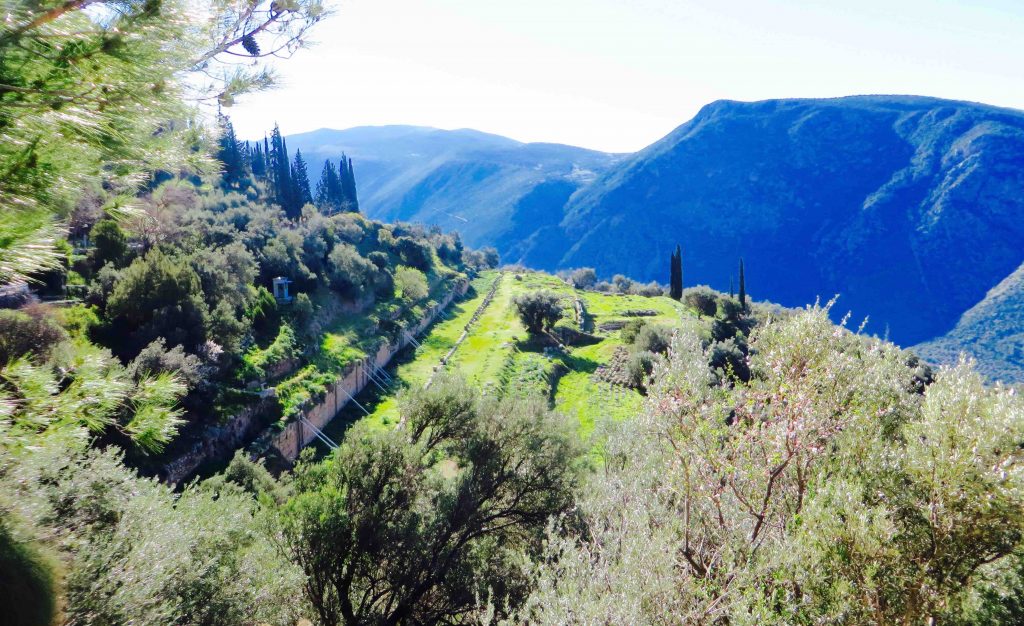
Looking down from Delphi into the valley, you can just make the temple remains out on the left, shaded by trees. As the museum was closed, due to coronavirus, we got a chance to visit the temple instead. Next day the whole site was closed down – we managed to squeeze in with twenty four hours to spare. The ‘Pythia’ was benign on a perfect day. Luck was on our side.
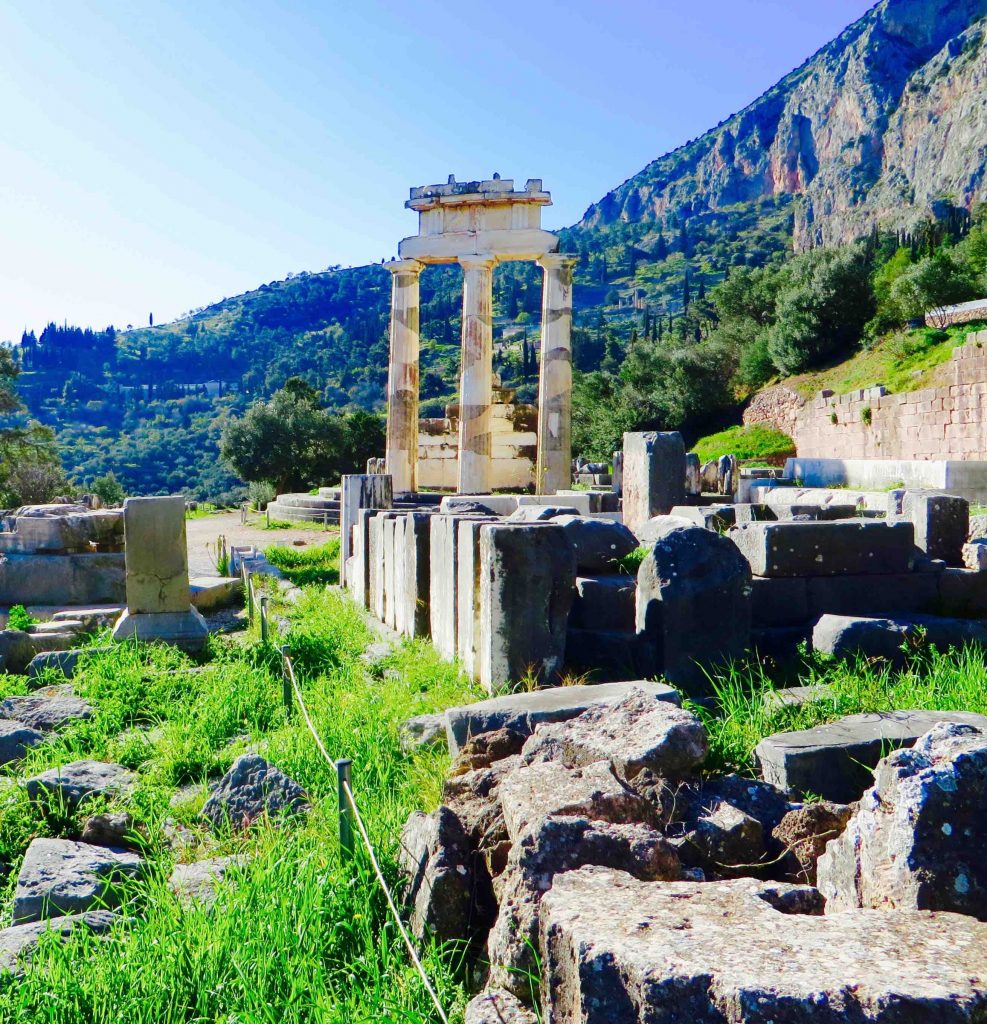

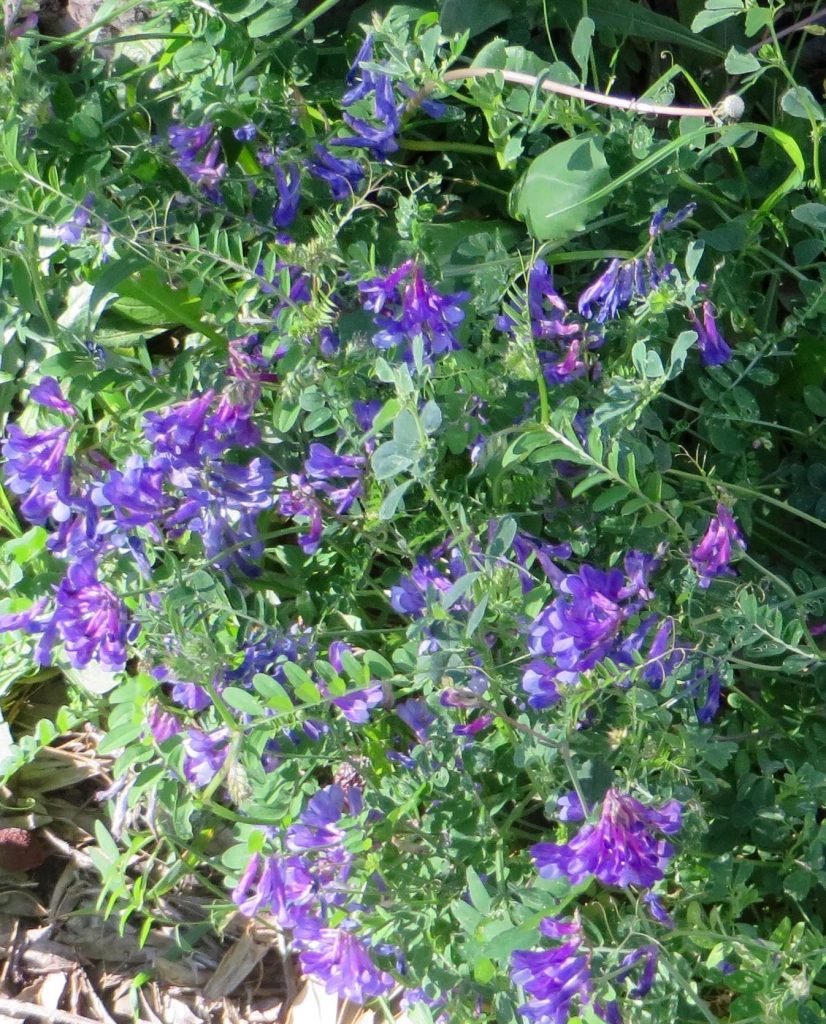

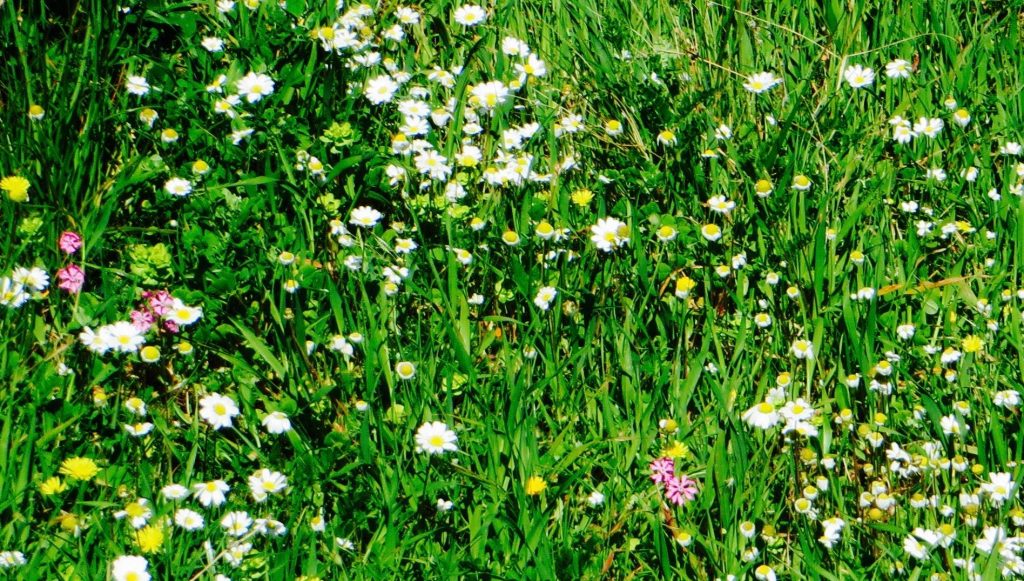

… as we leave for the monastery of Osios Loukás, which is quite close.
Time for a coffee break on the way in a quiet village. Old men playing the even more ancient game of backgammon. They were happy for me to take a photo. When I was in Fethiye in Turkey I asked some men if I could take their photo and they invited me to sit down with them and bought me tea in a glass – sadly, I didn’t have time to learn backgammon.
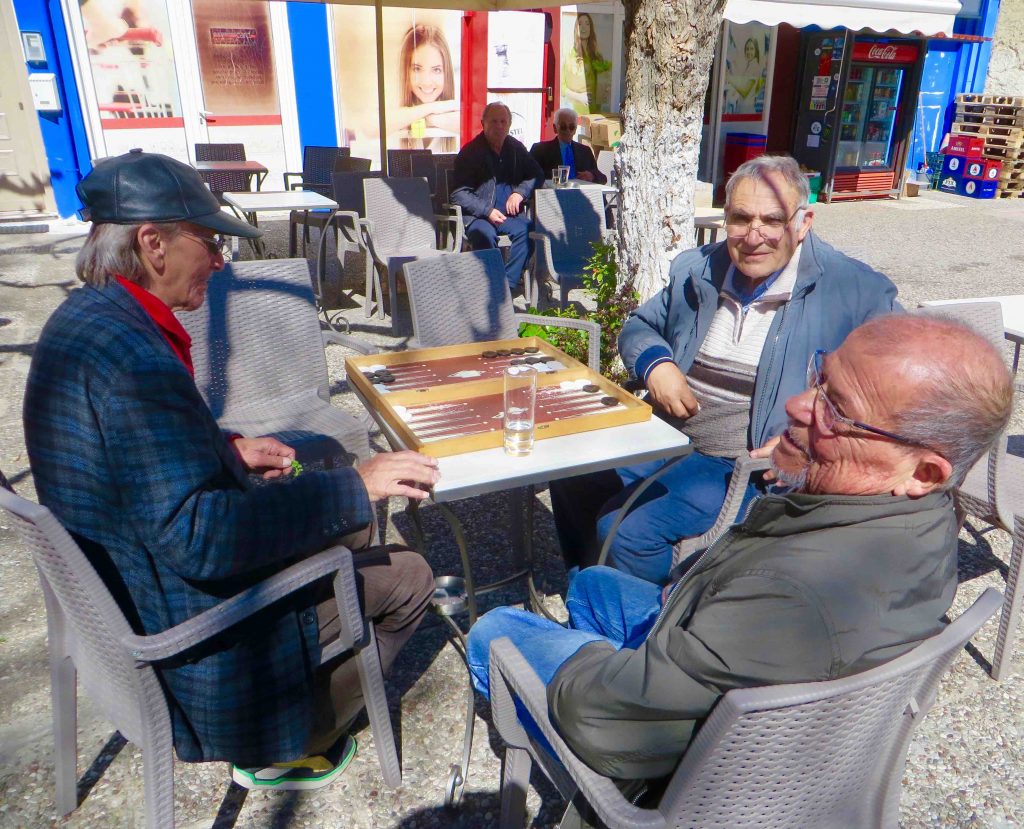
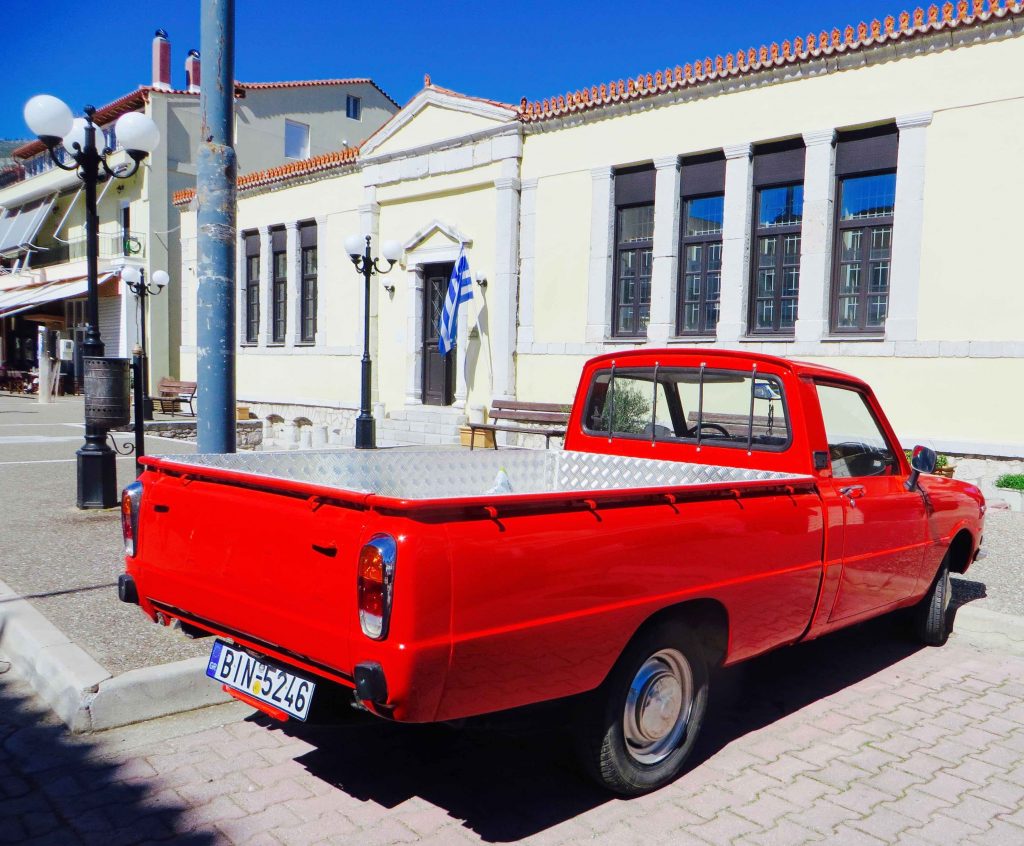
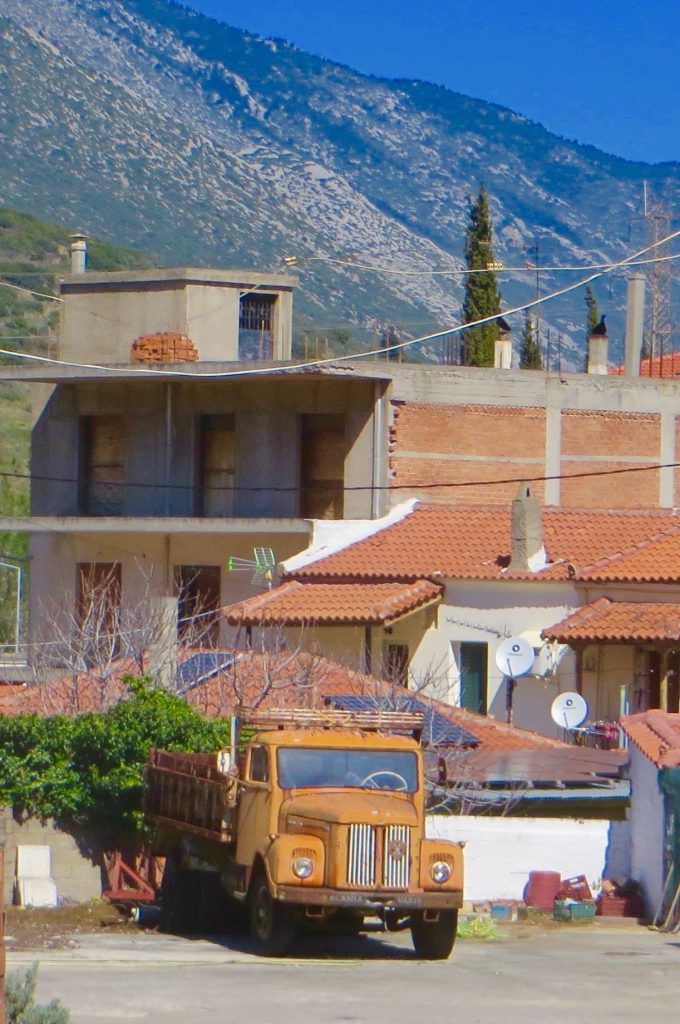
The site of the monastery on Mount Helikon dates from before AD 944. It exceeds all expectations. The location is secluded, the atmosphere is tranquil and the silence all embracing.
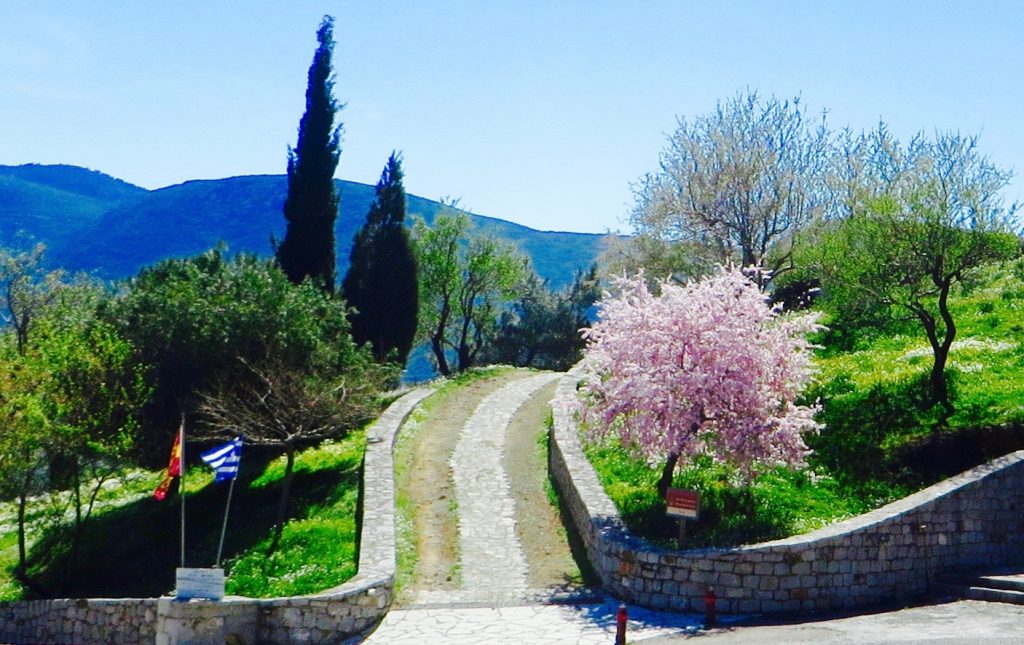
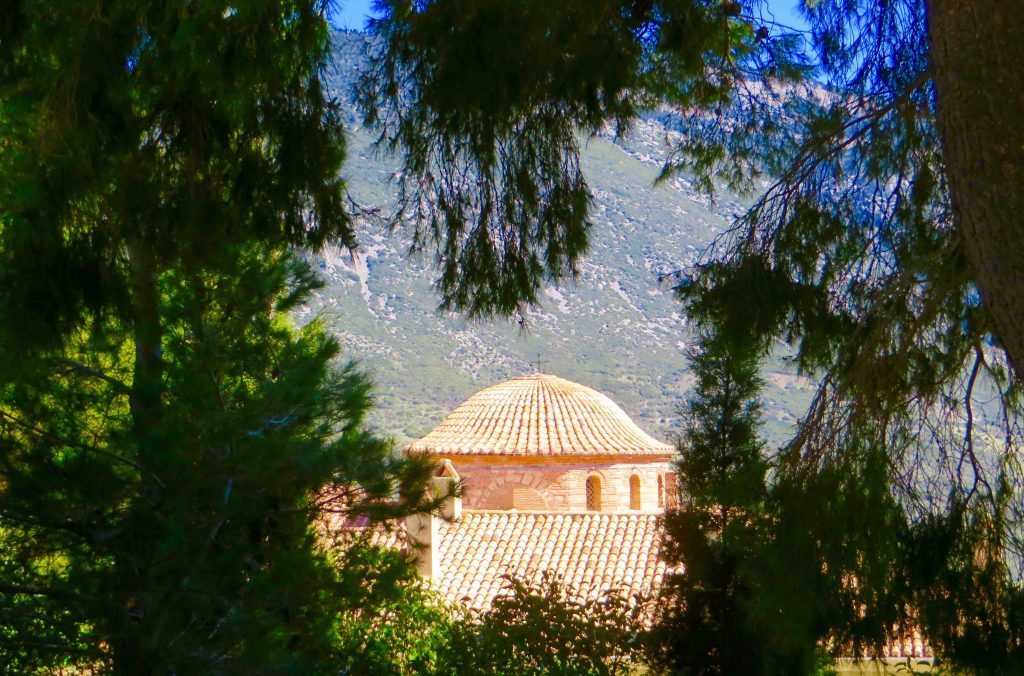
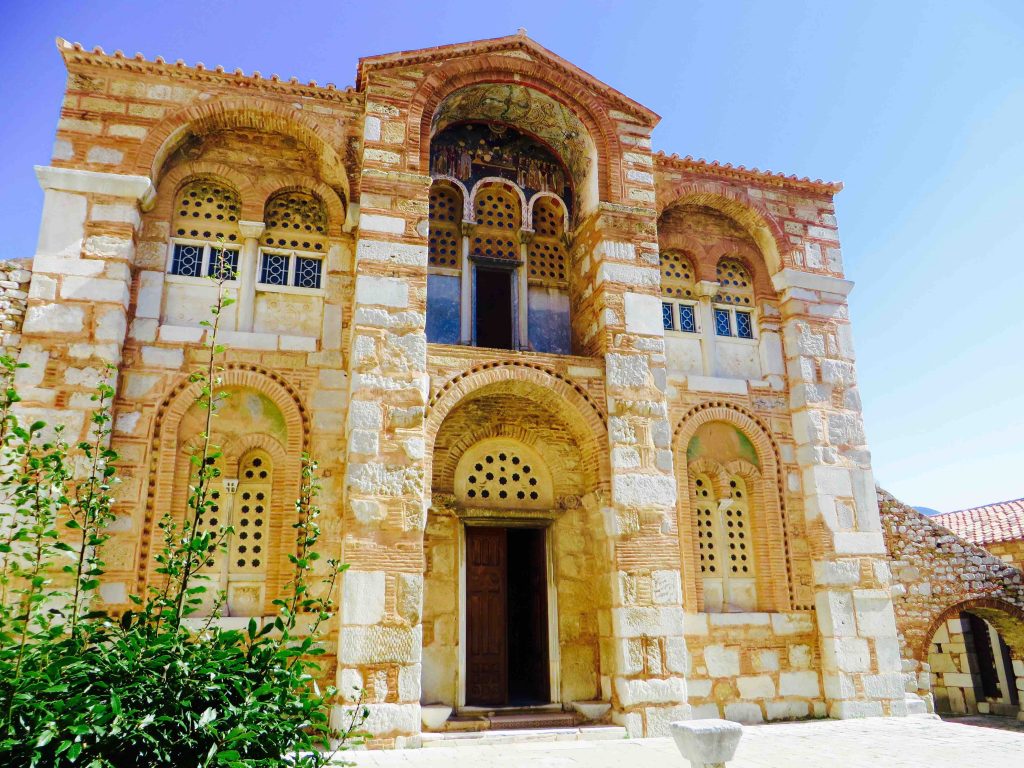

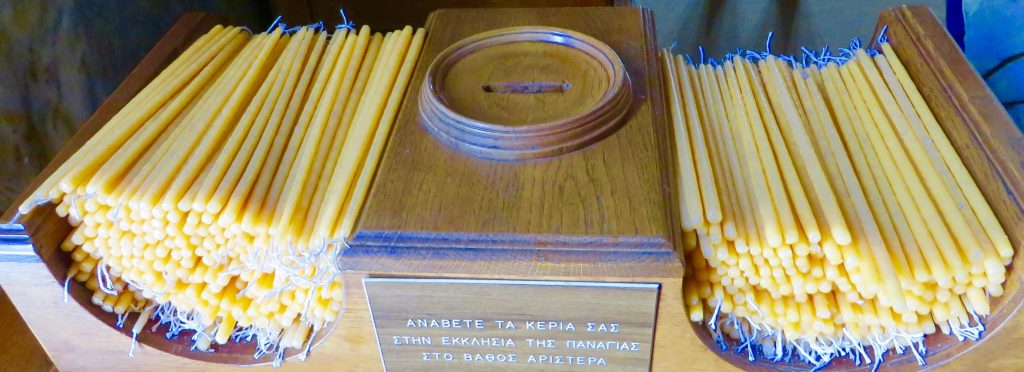
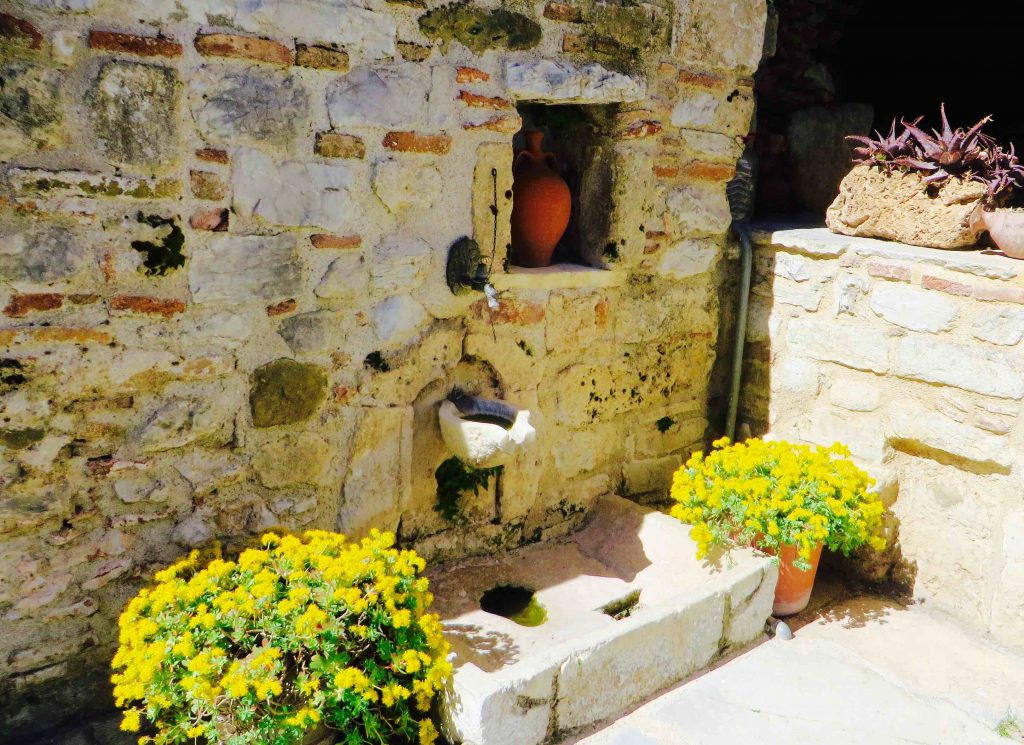
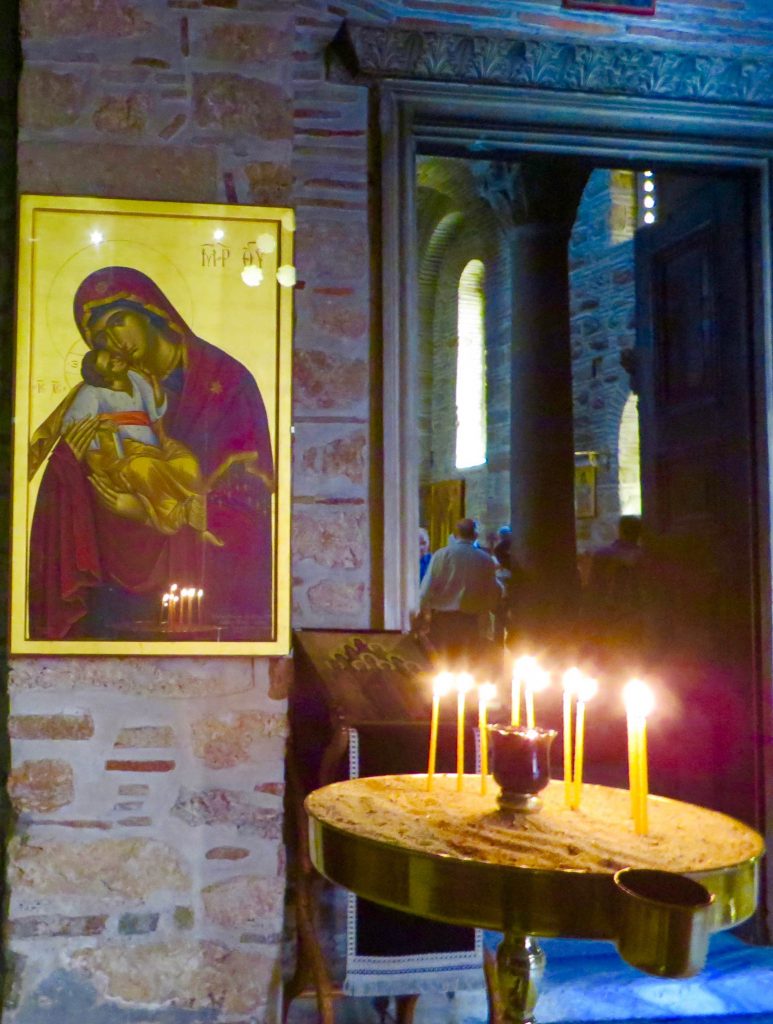
While I was taking photos, George started to sing in Greek within the church. He has the most mellifluous voice – molten with the honeyed smell of beeswax candles …
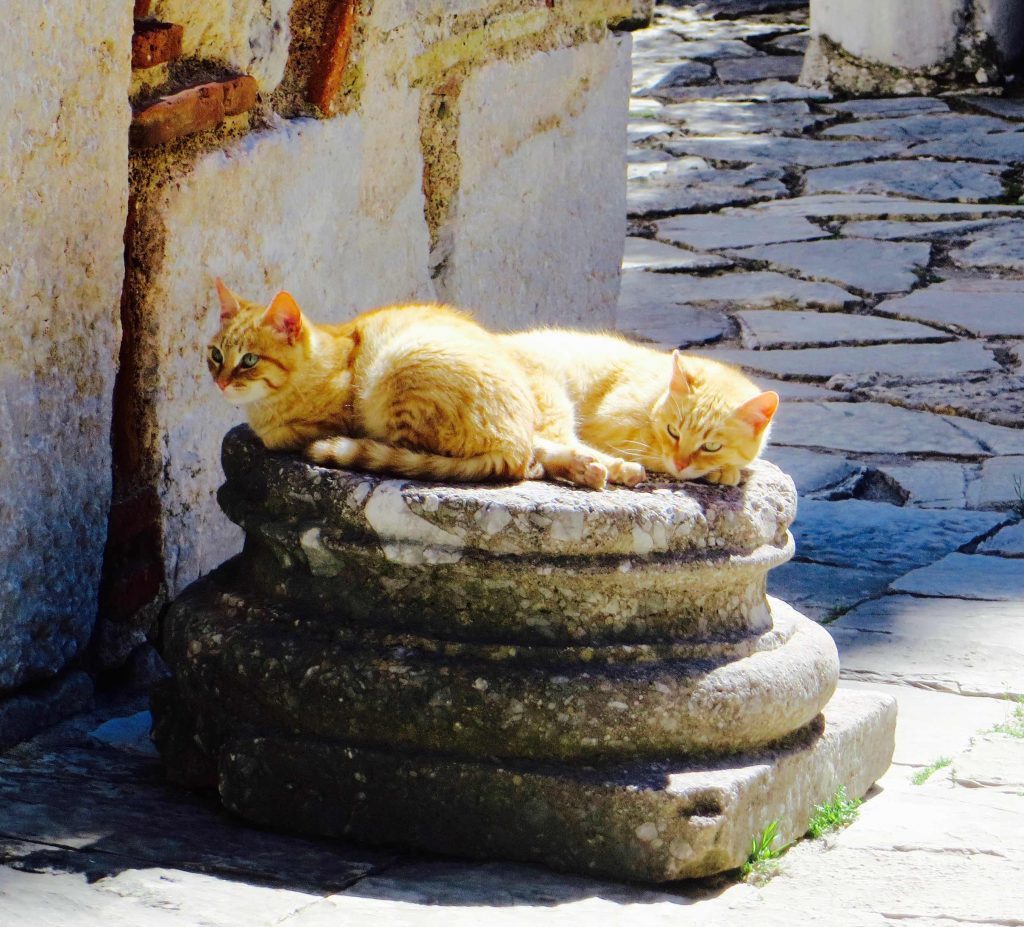


Coronavirus creeps closer. As we leave the hotel next morning the owners close it down. Our itinerary must change as many sites are now being closed too. However, Jeremy, George and Bianca are full of innovative ideas and we end up at the delightful town of Nafpaktos by the sea with its impressive looking castle on the top of the mountain.



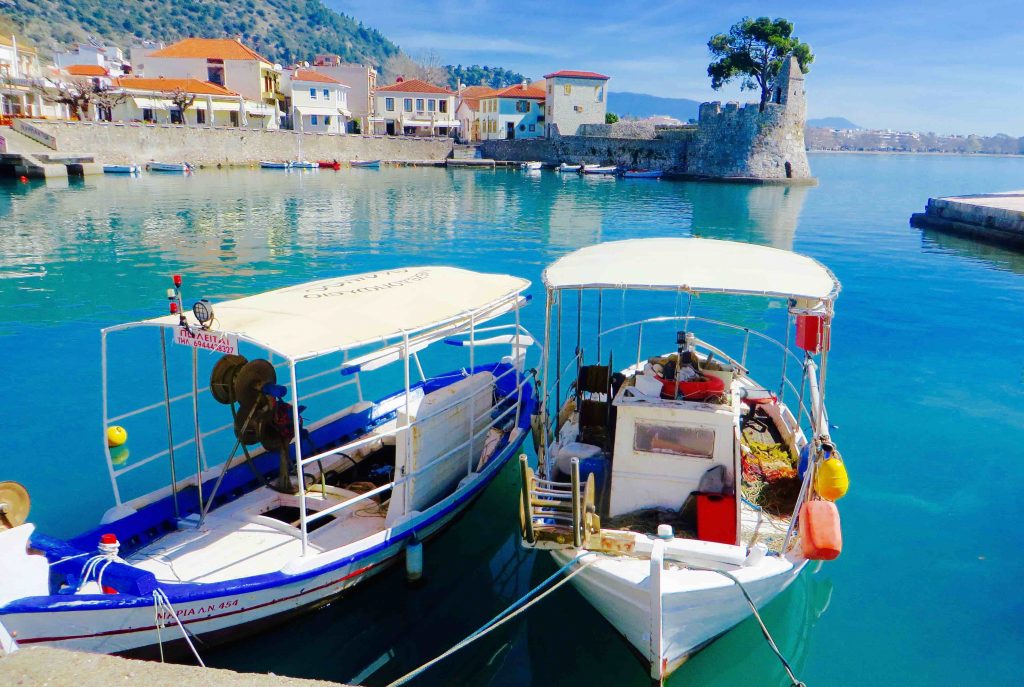
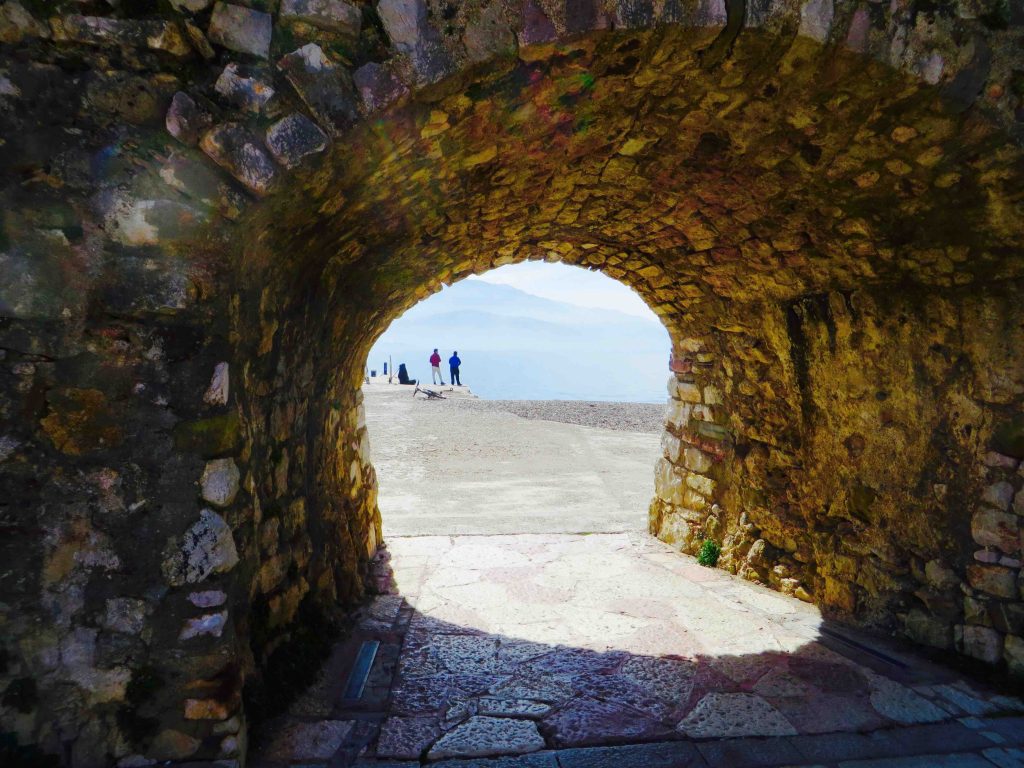
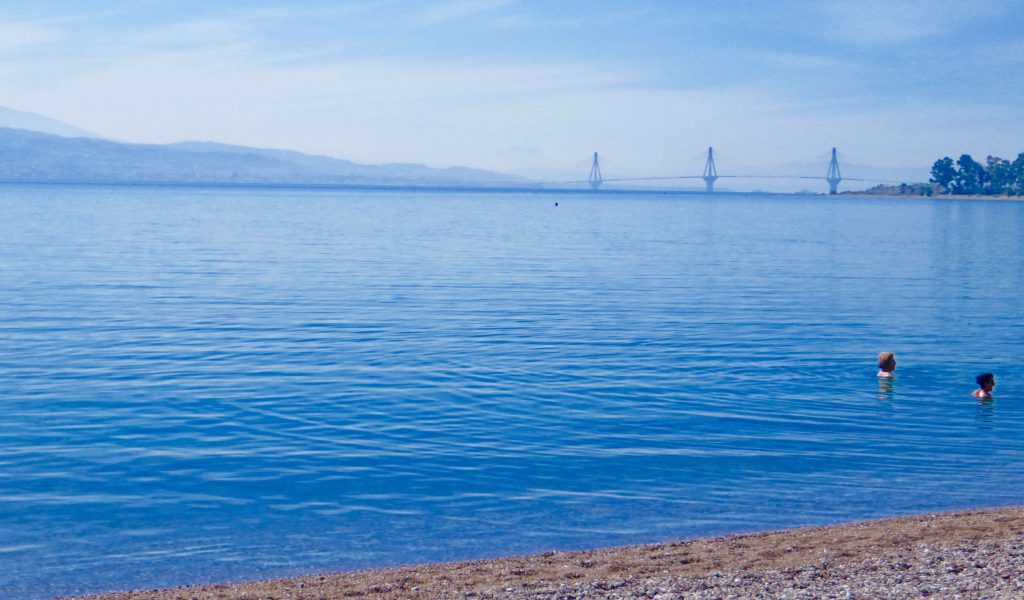
The Rio-Antirio bridge is the world’s longest multi-span, cable stayed bridge. It crosses the Gulf of Corinth, linking the town of Rio on the Peloponnese to Antirio on mainland Greece.
Nafpaktos was known as Lepanto during part of its history and by the harbour is a statue of Cervantes, who took part at the Battle of Lepanto. There is another statue on the harbour wall of Giorgos Anemogiannis, who lost his life defending his country. The two statues seem to be waving to one another …

Most shops are closed and although bakeries are open, only two customers are allowed in at a time.
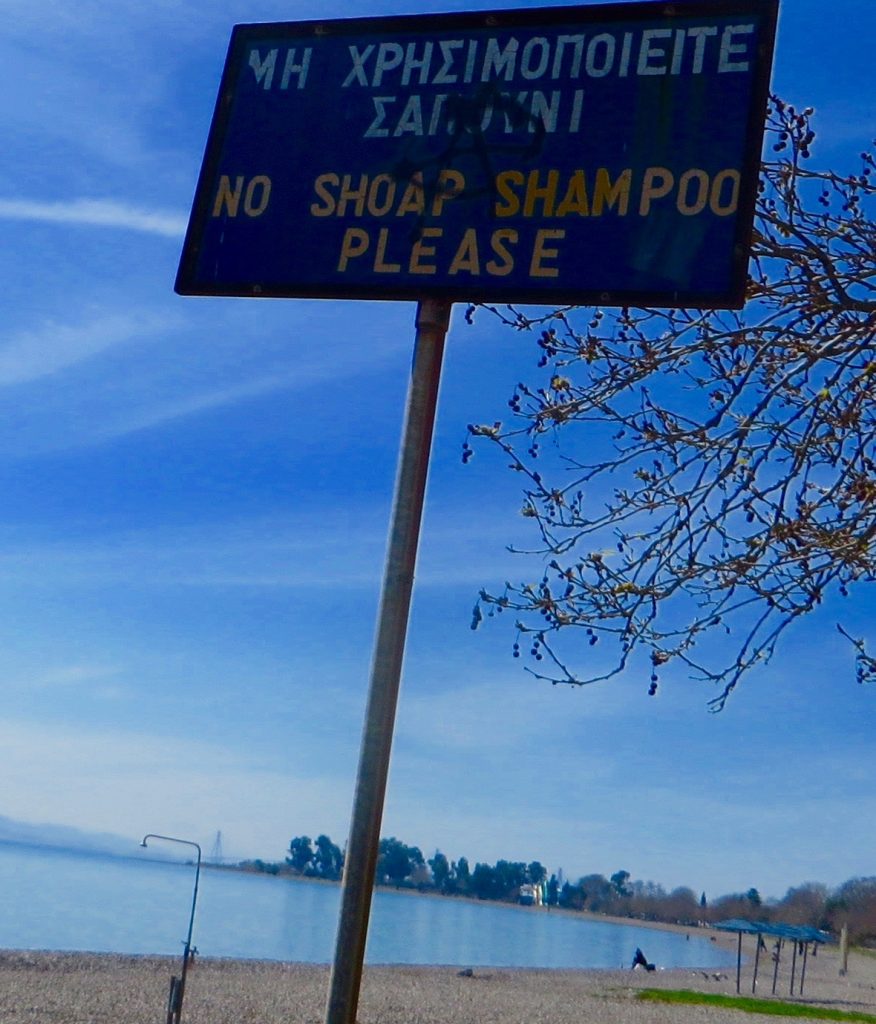
As we walked back to the bus along the shoreline I noticed a shower was set up on the beach with a large notice not to use soap or shampoo. Seeing spelling of ‘shoap’ on the notice made me think of the roots of words and language. If it’s shampoo, why not shoap …
Shampoo seems to have had Indian roots and was first noted in England in 1762. Its original meaning in Hindi was ‘a full body massage’. Soap seems to have German/Dutch roots. My most successful chemistry lesson at school was succeeding in making a bar of soap! Digression …
Next stop is at the bridge – we take the ferry across to get the best view of it.
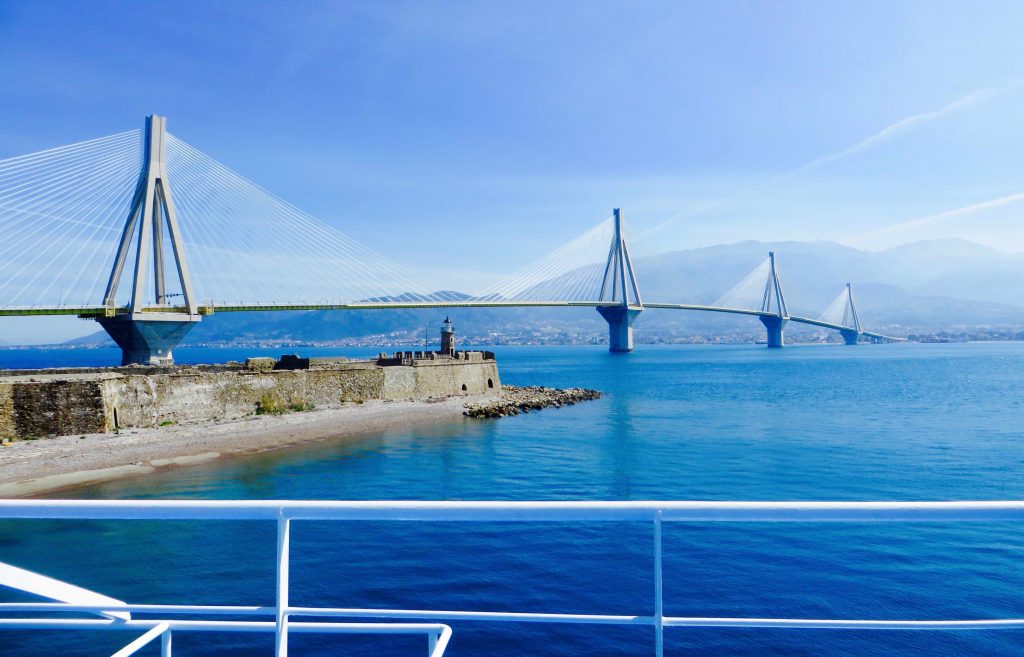
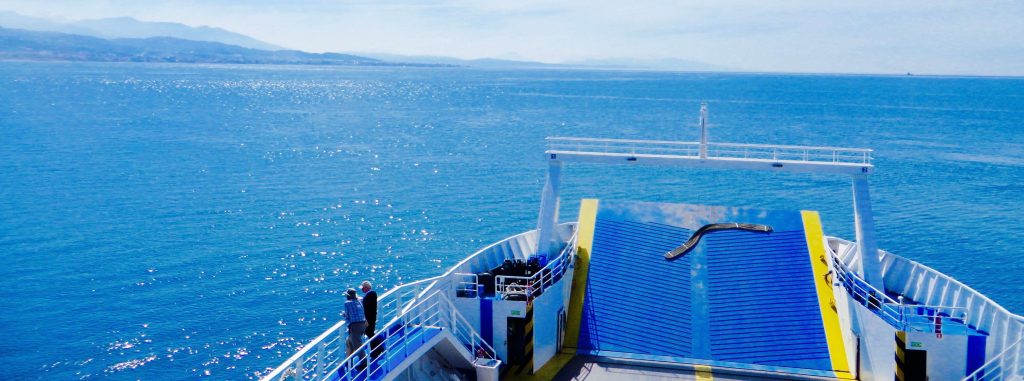

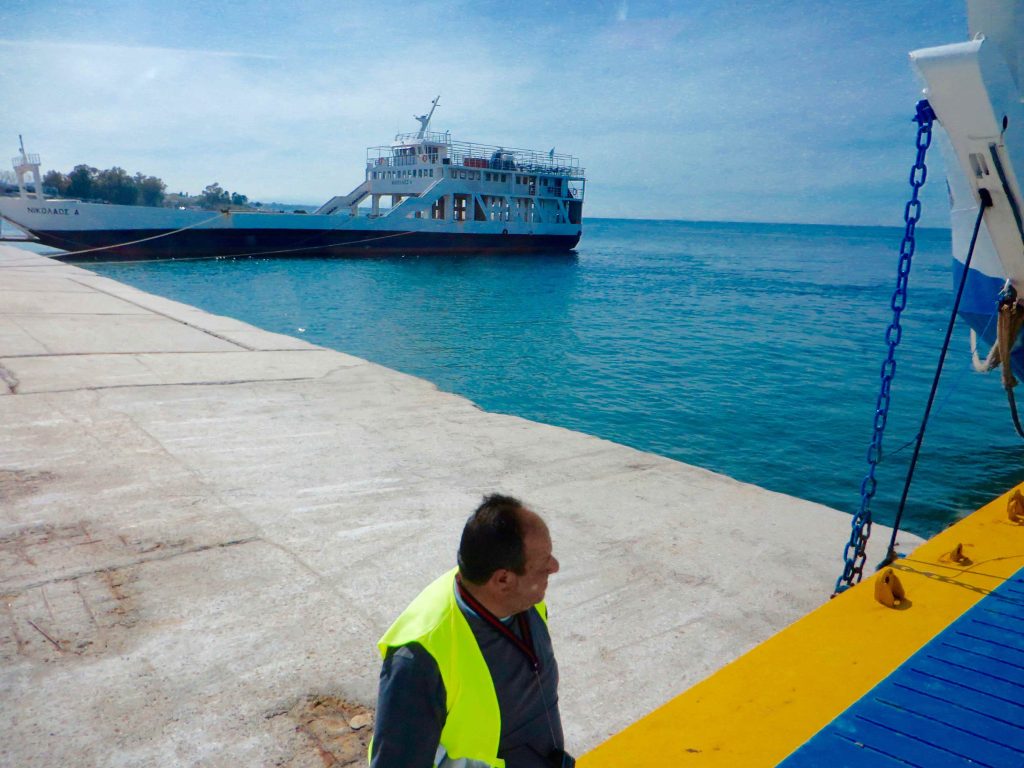
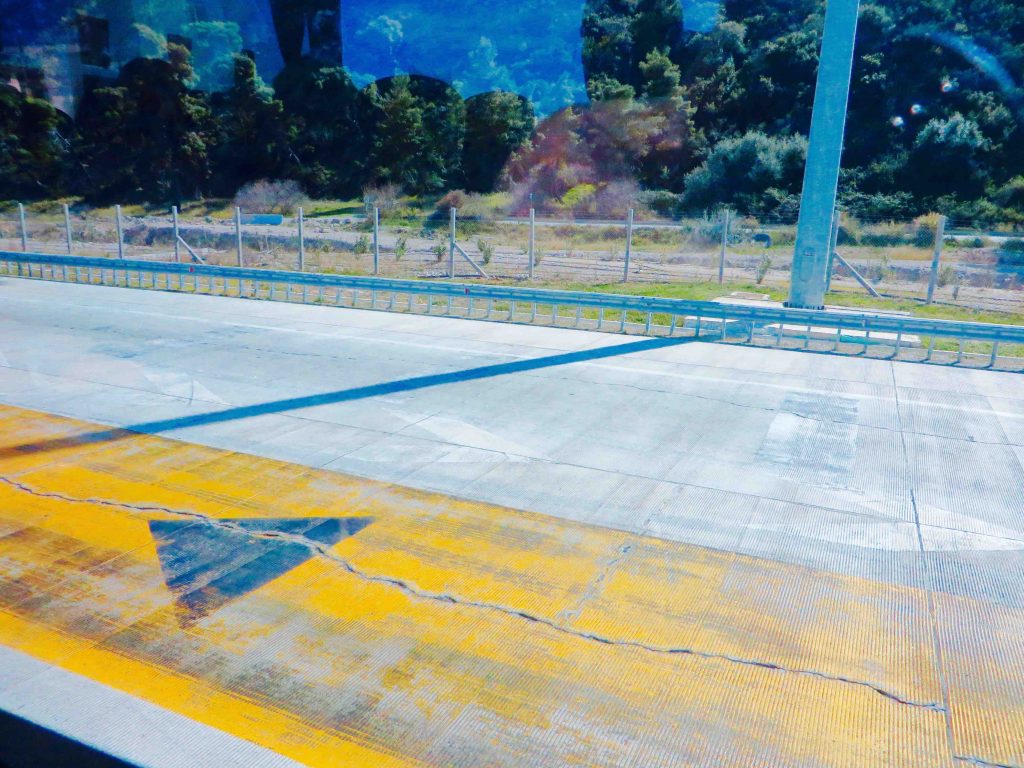
This photo reminds me of the work of Richard Diebenkorn, a Californian artist, whose paintings are a mix of abstract and figurative. I especially like his colour palette.
He manages to be both geometrical and lyrical at once, which brings on a train of thought. How music and mathematics are in tandem… how poetry works lyrically, limited yet enhanced by lines of a sonnet or haiku … how a painting speaks to an audience in a more emotional way when constructed invisibly by the harmony set by ‘the Golden Mean’.
An example of this is in ‘The Baptism of Christ’ by Piero de la Francesca, who was also a mathematician and a pioneer in the field of perspective. I am always drawn to his paintings – the way he uses colour and light. And the invisibility of the ‘Golden Mean’ underlying it all.
If this photo appeals to you, it’s worth looking up more on Diebenkorn too. (1922 – 1993).
Back on the bus, I snap these weird looking cliffs. They remind me of Ursula Le Guin’s ‘The Wizard of Earthsea’ or a film set in ‘Lord of the Rings’. However, I think this is merely a quarry.

Maybe I’m flagging a bit – needing a siesta … I remember I bought something to eat in Nafpaktos so I rummage around in my bag to find it.

I’m sure one or two of these will raise my energy levels. The label mentions that they are ‘fumigated’. I don’t know what that means but I’m hungry so I’ll risk it…
The site at Corinth is already closed but we can look through the fence as various companionable dogs follow us.

You can just see the fortress of Acro-Corinth on top of the mountain in the right of the picture.
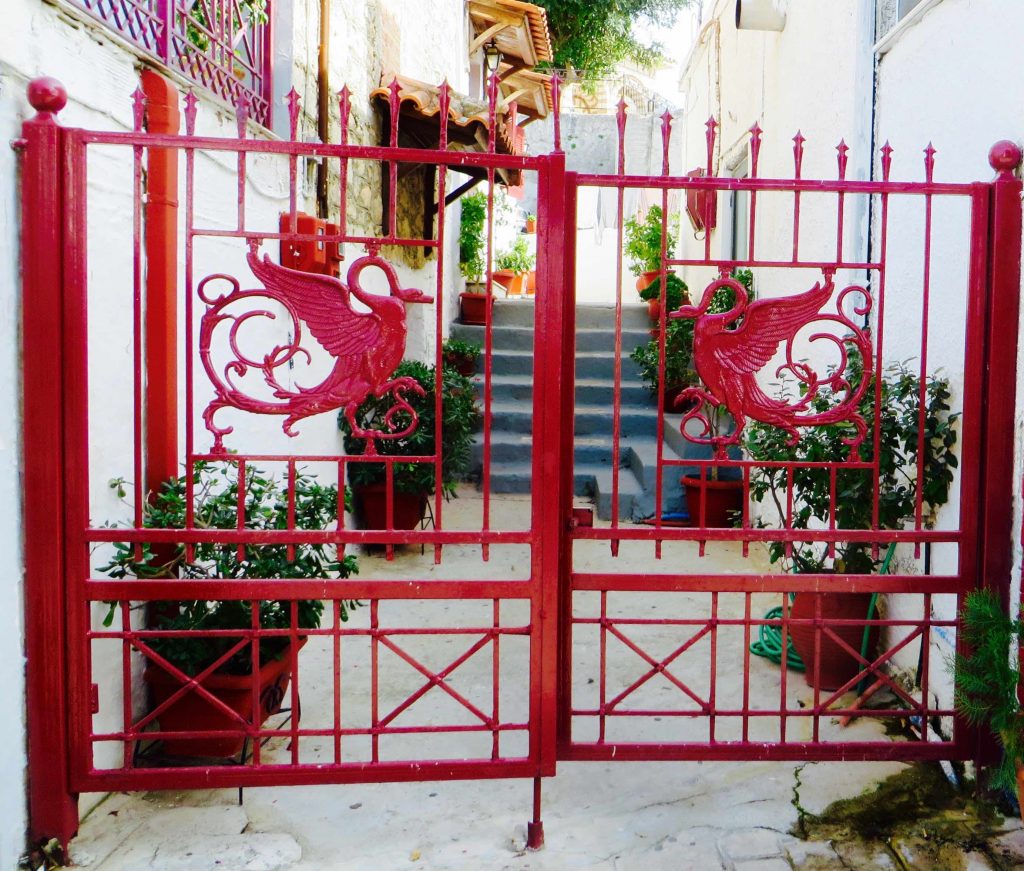
This reminds me that when we get home John’s new book, his twentieth, will be published. It’s called ‘Green Swans’ – The Coming Boom in Regenerative Capitalism – and has already had some positive feedback from both business and environmental people.

I notice lots of shrines by the side of the roads as we pass. Bianca says that many of them commemorate people who have died in car accidents. One man even built a chapel of remembrance for his son on the spot. I am glad that Nikos is our driver, as he is excellent …
And the best is yet to come – we are driving up the mountain to Acro-Corinth.
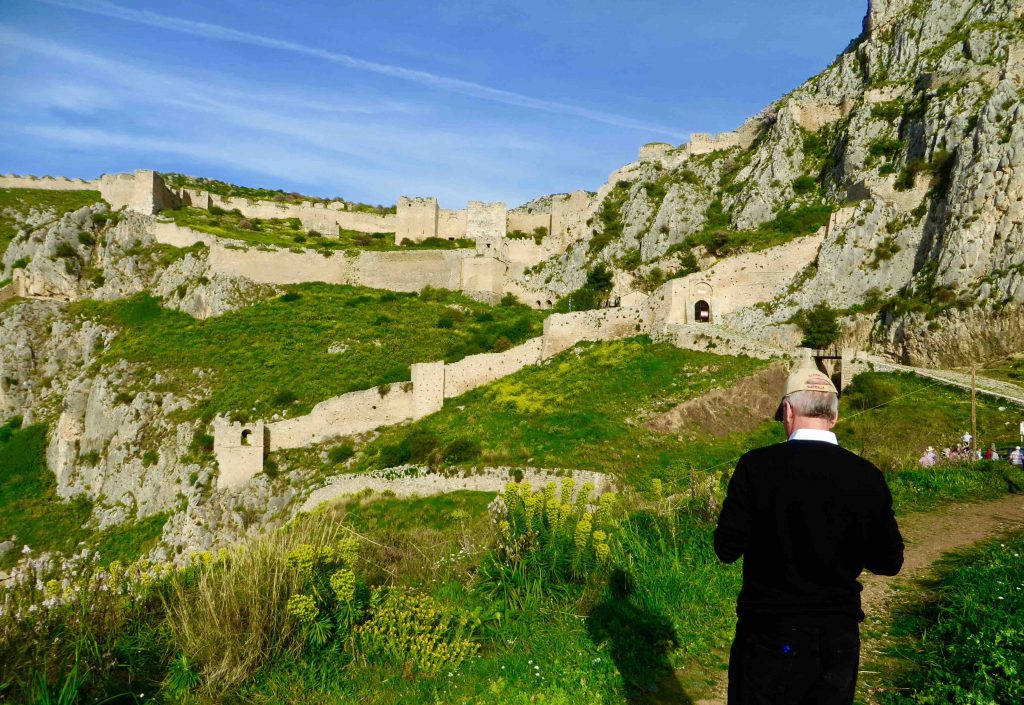
The fortress had its own water supply – the spring of Pereine – and a commanding view from the mountain top over the Isthmus of Corinth.
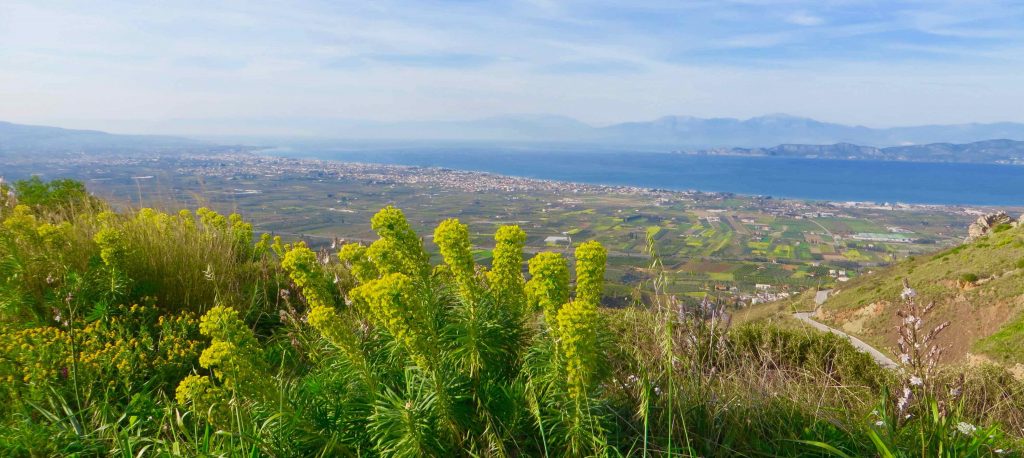
Asphodel grows here – the sacred plant which is connected to the Elysian Fields, where knights and warriors who lost their lives defending their kingdoms entered – the equivalent of Paradise. I first came upon asphodel growing on the ramparts of the castle by the harbour in Kyrenia in Cyprus. It struck a chord – it is wonderful to see it growing here.

Asphodel is the pinky white flower – the other is euphorbia, which grows everywhere we have visited.
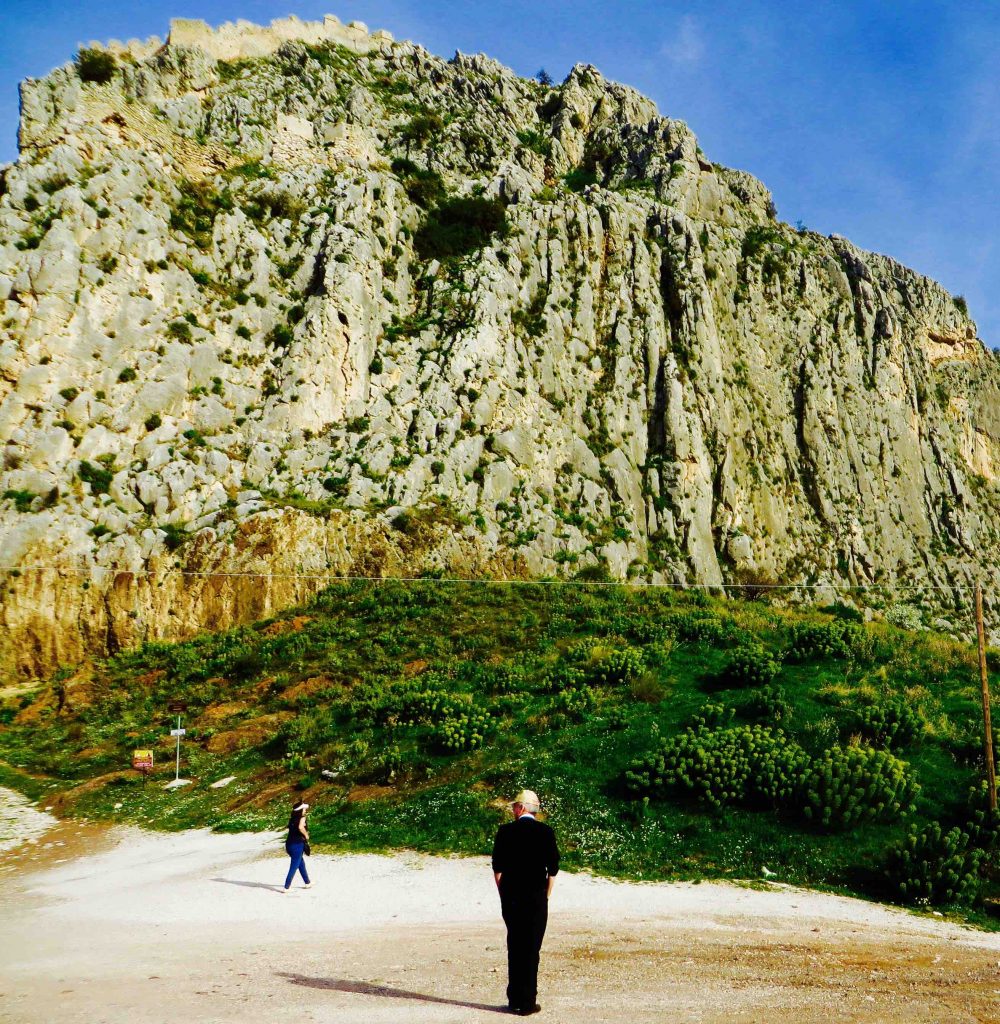
Nafplion. I’m so looking forward to seeing this town again fifty years on. It’s a small port and again, like Nafpaktos, has an impressive Venetian fortress, Palamídi, towering over it. There is also another fortress – Bourtzi – located on an islet in the middle of the bay.
But our first point of contact is the Hotel Amalia, a few minutes drive outside the town. It’s huge, spacious, full of light and our room has French doors onto the gardens and a small nature reserve, full of bees, birds and croaking frogs. I’d like to explore it but it’s cordoned off and I think the ground must be quite marshy, given frogs are in abundance.

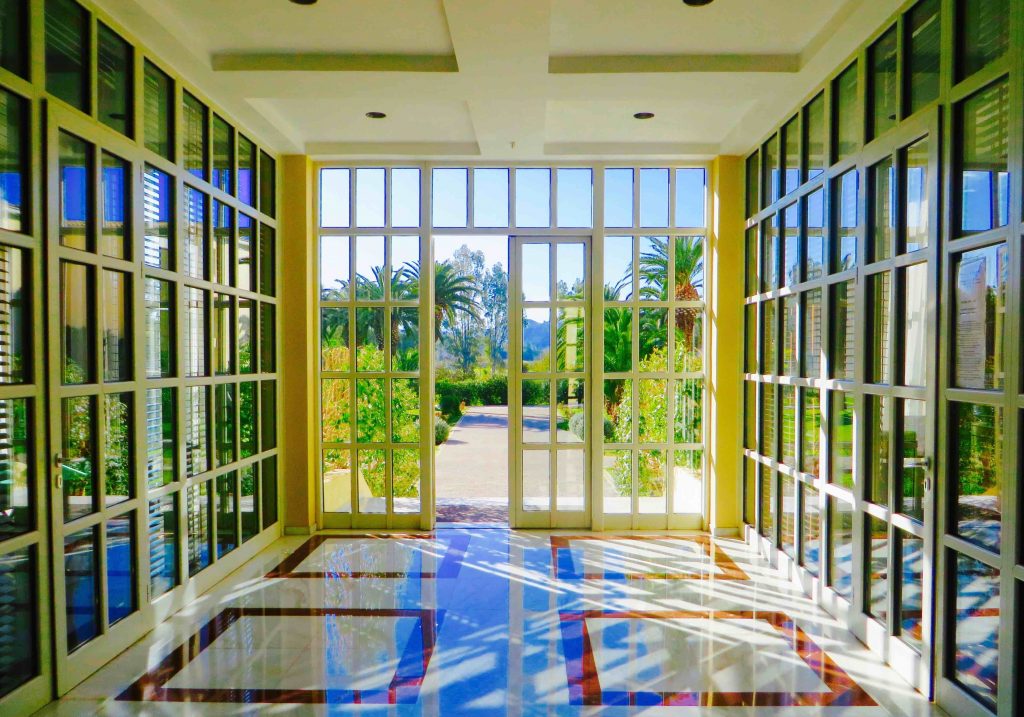

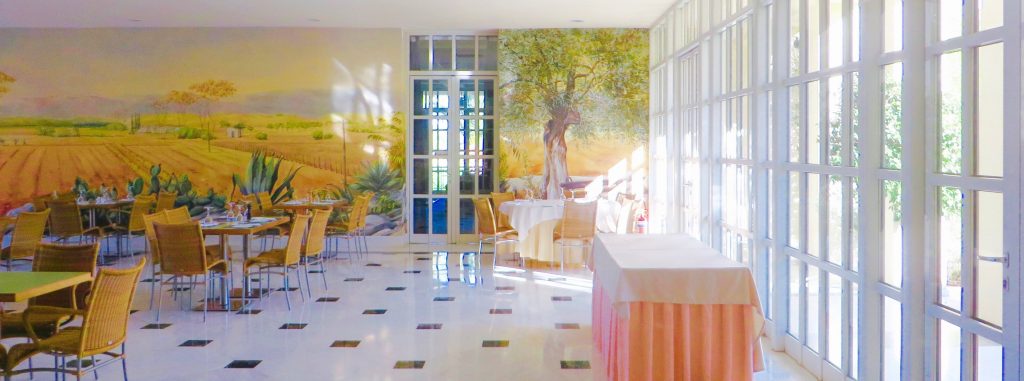
The hotel is silent and almost empty – except for us. I’m enjoying the breakfasts with oranges off the trees and delicious, thick cut quince jam. Add it to Greek yoghourt – fabulous … it’s alright to have seconds on holiday …
Jeremy, George and Bianca have sorted out interesting things for us to see, despite the castle being off limits. We drive right up to the entrance with the view of Nafplion spread out before us.
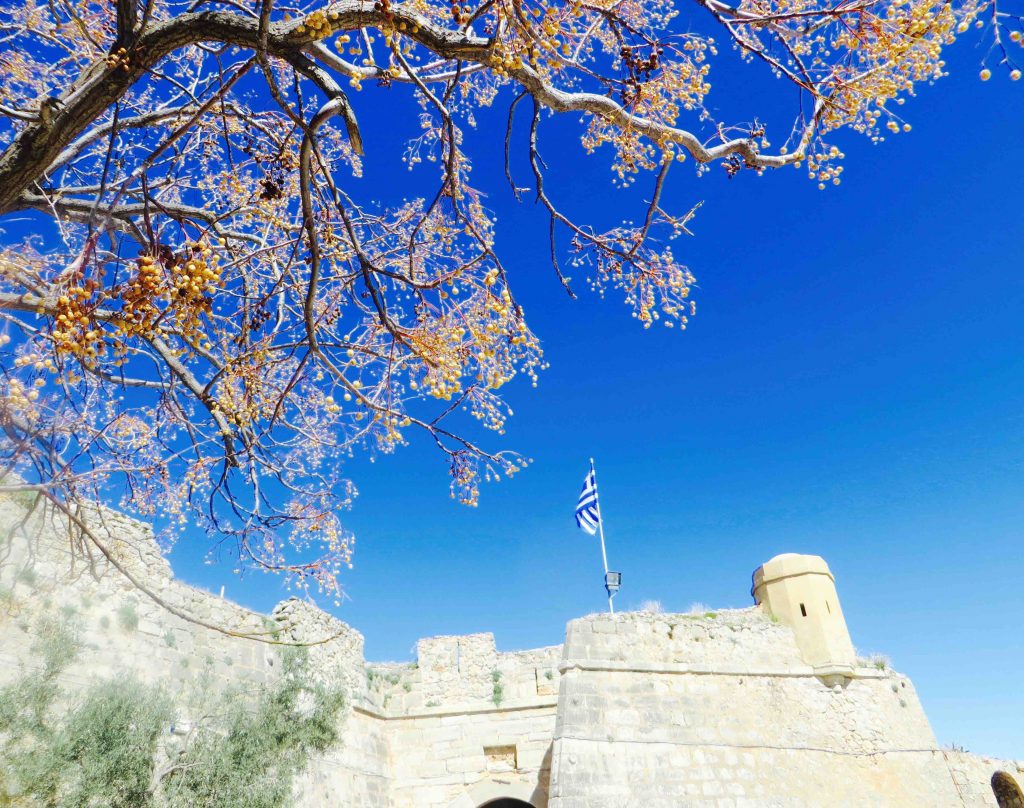
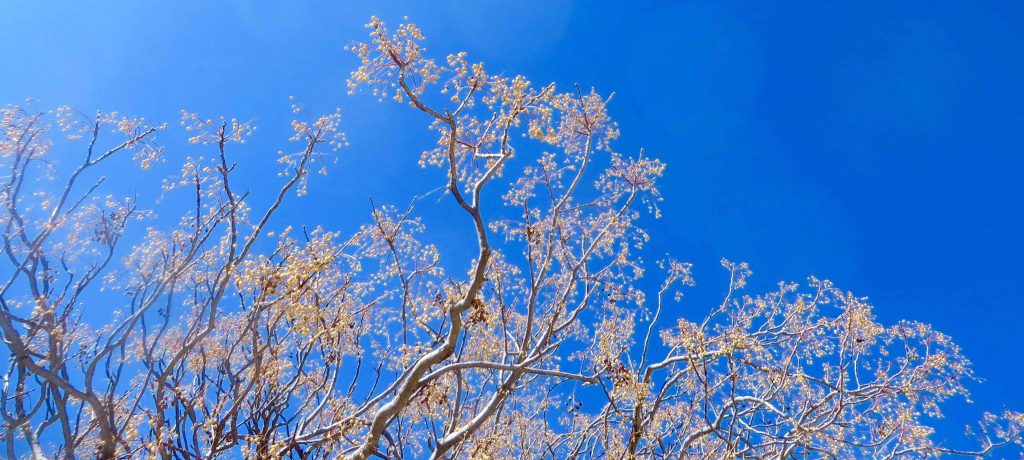
I’ve fallen in love with this tree. I keep seeing them and wish I could grow one at home.
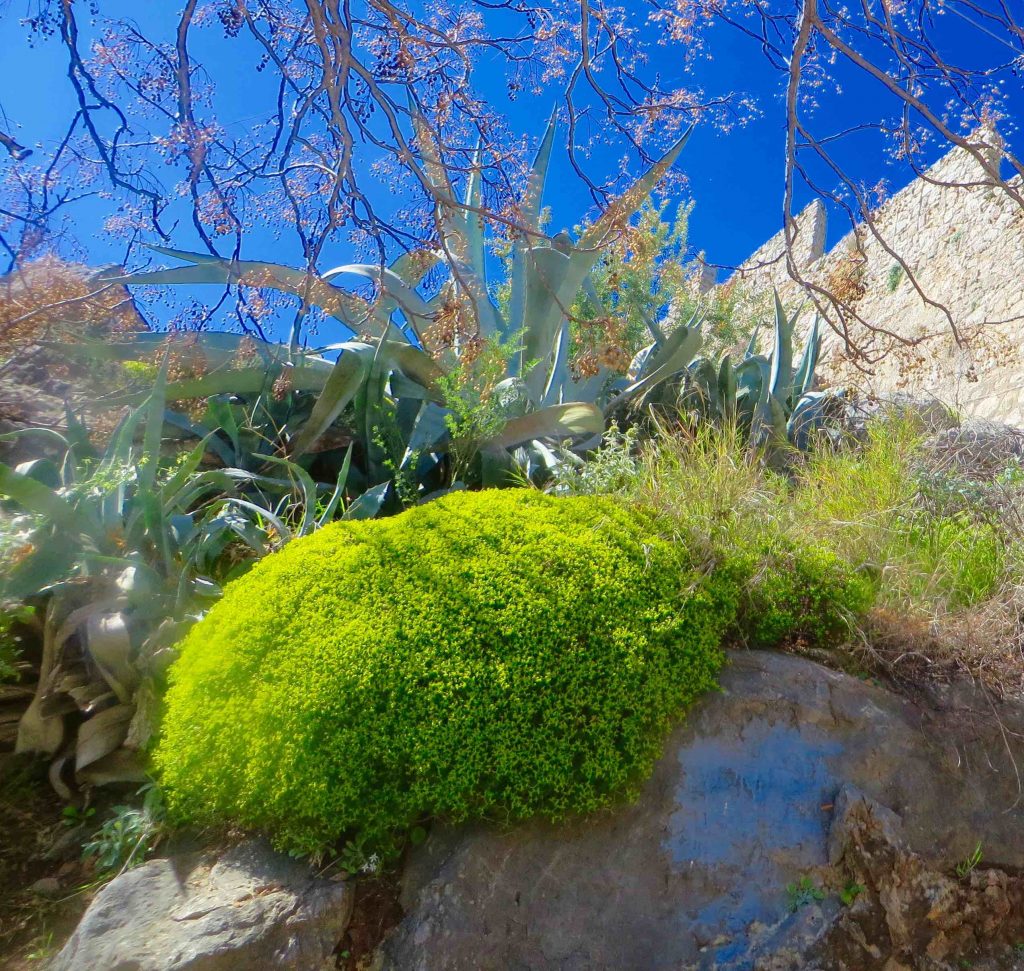

Graffiti persists the whole world over – I suppose it did in Greek and Roman times too …

On the opposite side of the road is the ‘Lion of Bavaria’, carved out of the living rock. It dates from 1840. The sculptor was Christian Siegel, the first professor of sculpture at Athens Polytechnic. It was commissioned by Ludwig of Bavaria – father of Otto – who was the first king of Greece – in memory of Bavarian soldiers who died during the typhoid epidemic in Nafplion (1833/34).
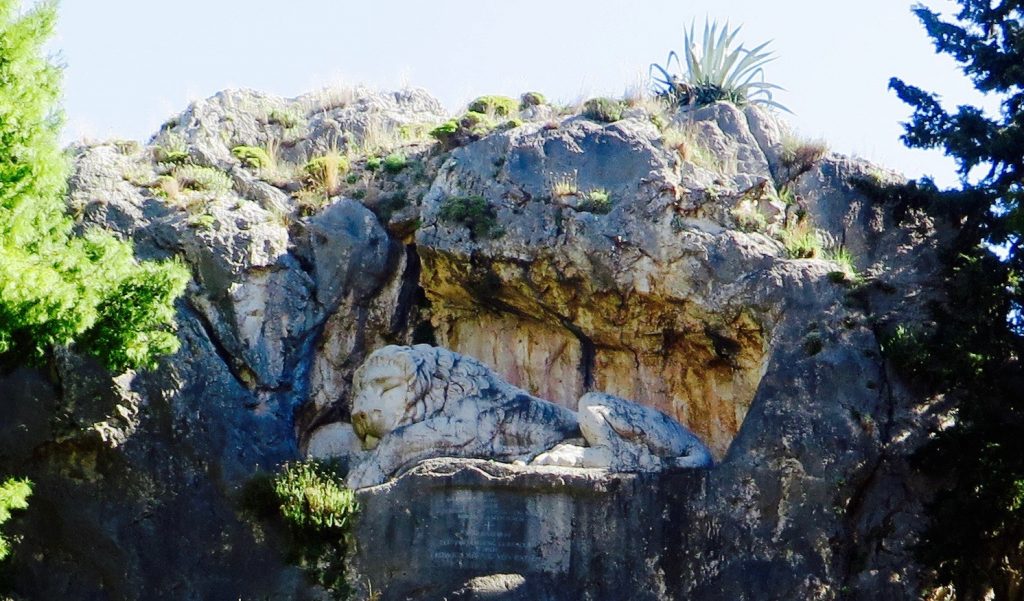
He looks pretty exhausted but he was commemorating a grim typhoid epidemic. It is quite an extraordinary achievement.
As Nafplion was once the capital of Greece, there are many commemorative statues, where Jeremy and George can expand on our knowledge of Greek history.

TK was a Greek general and leader of the War of Independence (1821-29) against the Ottoman Empire.

Kapodistrias came from Corfu and studied philosophy, medicine and languages in Padua before going into politics. He established the first agricultural school and the first printing shop, when becoming the first governor of Greece. Sadly, he was assassinated in 1831. He is deservedly honoured in the country today. Statue now under renovation …
My favourite statue is of King Otto, who came from Bavaria and ruled as king in Greece from 1836 to 1862. He married the rather beautiful Amalia of Oldenburg. In 1862 there was an uprising, forcing the royal couple into exile. They spent the rest of their lives in Bavaria, deciding to speak Greek every day between 6 and 8 o’clock to remember their time in Greece.

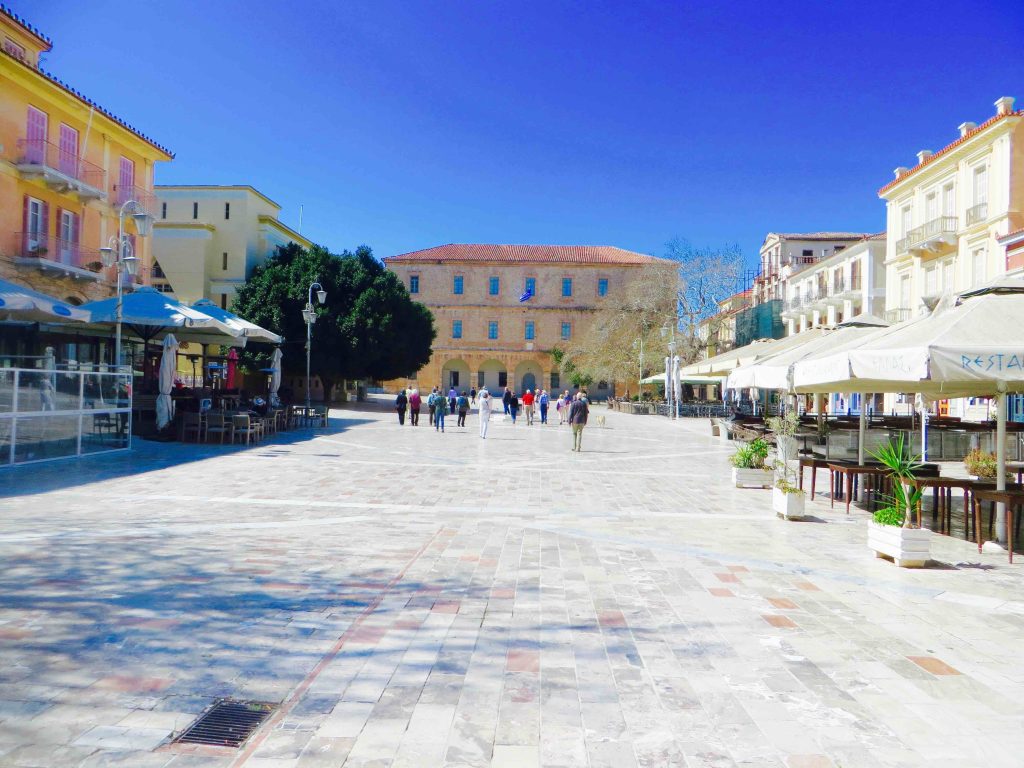
This square is the heart of Nafplion and must usually be buzzing with people but now it is eerily quiet. I’m a bit behind the rest of the group as I came upon a Gelateria that was open and bought a lemon ice cream cone – later on, I sloped back for another. Greek and Turkish ice creams are the best.
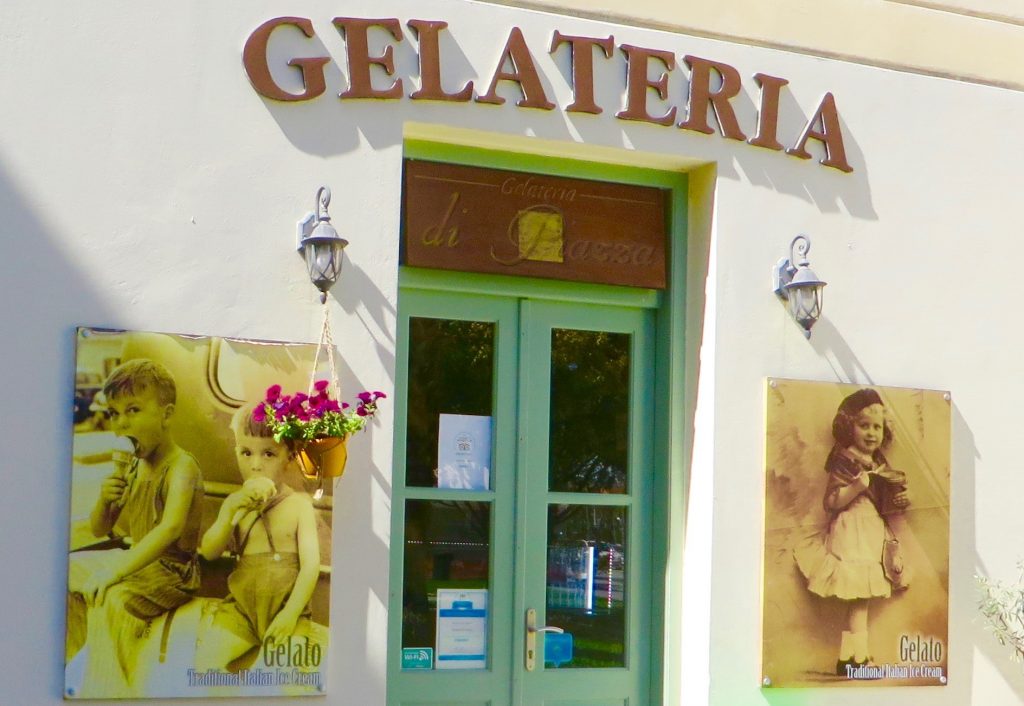
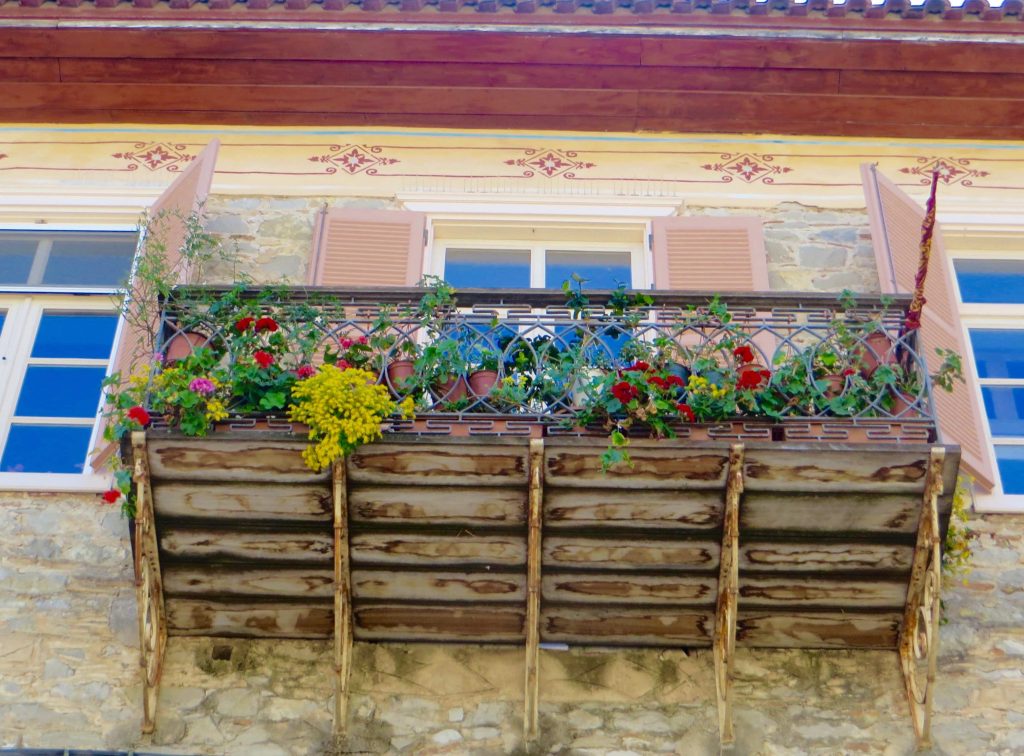
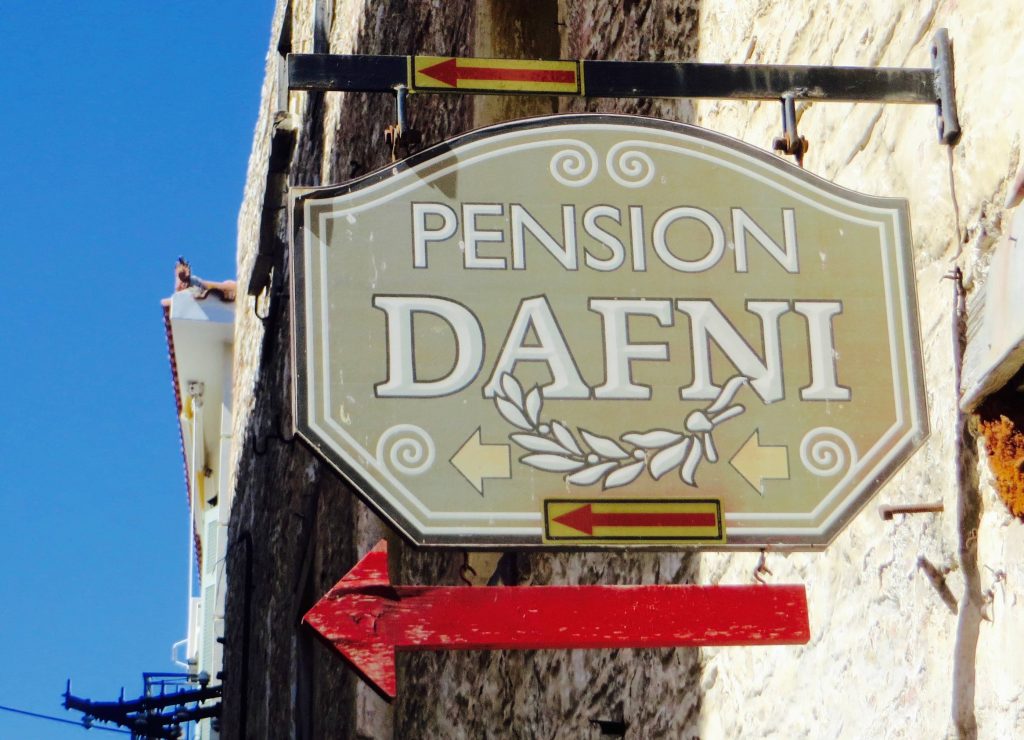
I looked this up when I got home and it appealed. It’s always good to have recommendations of places to stay. Often best to book direct with the hotel.
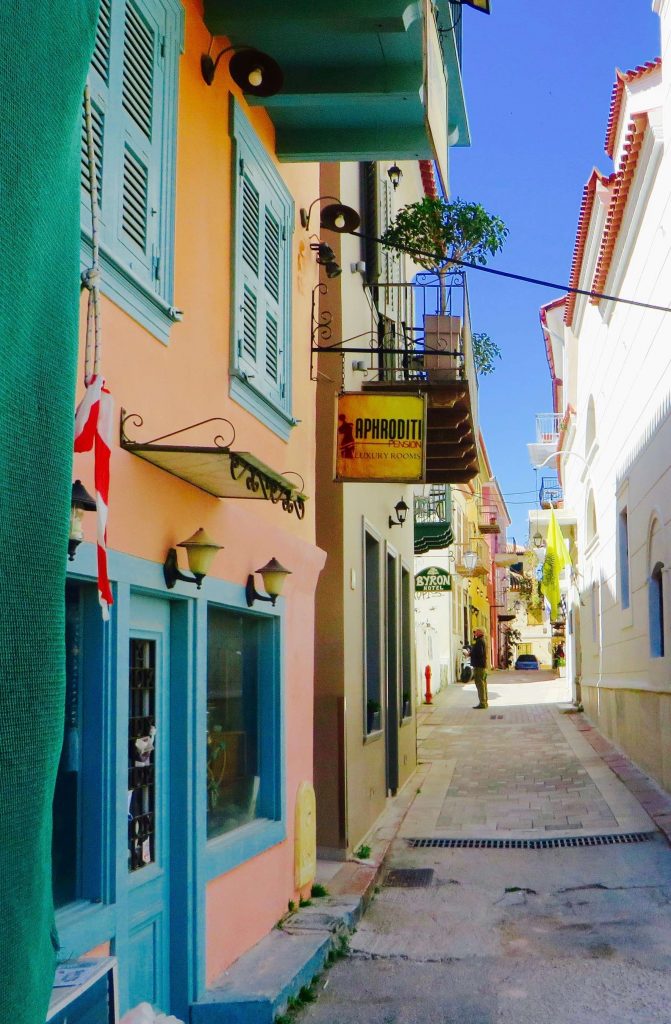
We are left free to roam around this afternoon. Hardly any shops are open and I can’t even find postcards. I don’t expect many people bother with writing them nowadays, finding stamps etc. – I always used to send them because I liked receiving them from others in far flung places. And I was excited to be abroad and exploring. This is a postcard odyssey of sorts I suppose … without stamps …
We walked along the shoreline. I’m fascinated by the tiny fortress of Bourtzi which takes up the whole of an islet in the bay. There’s more about its history on www.greeka.com. It holds a music festival in the summer.
There’s a slightly sinister side. Until 1930 the fortress was the home of the local executioner. It defended the only navigable channel in the bay, which could be closed off by a chain reaching between the fortress and the town. (info gleaned from Eyewitness Travel book on Greece, published by DK).
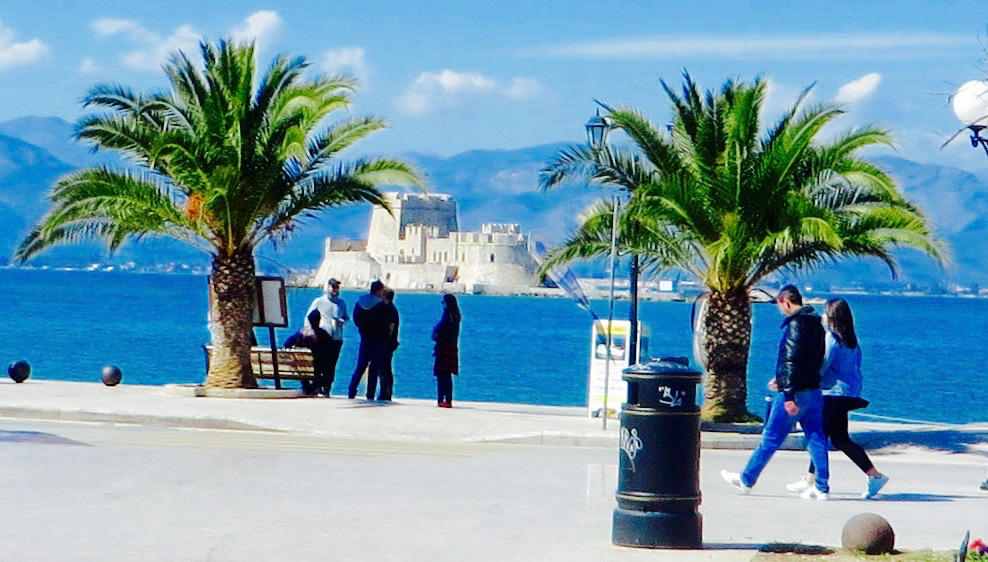
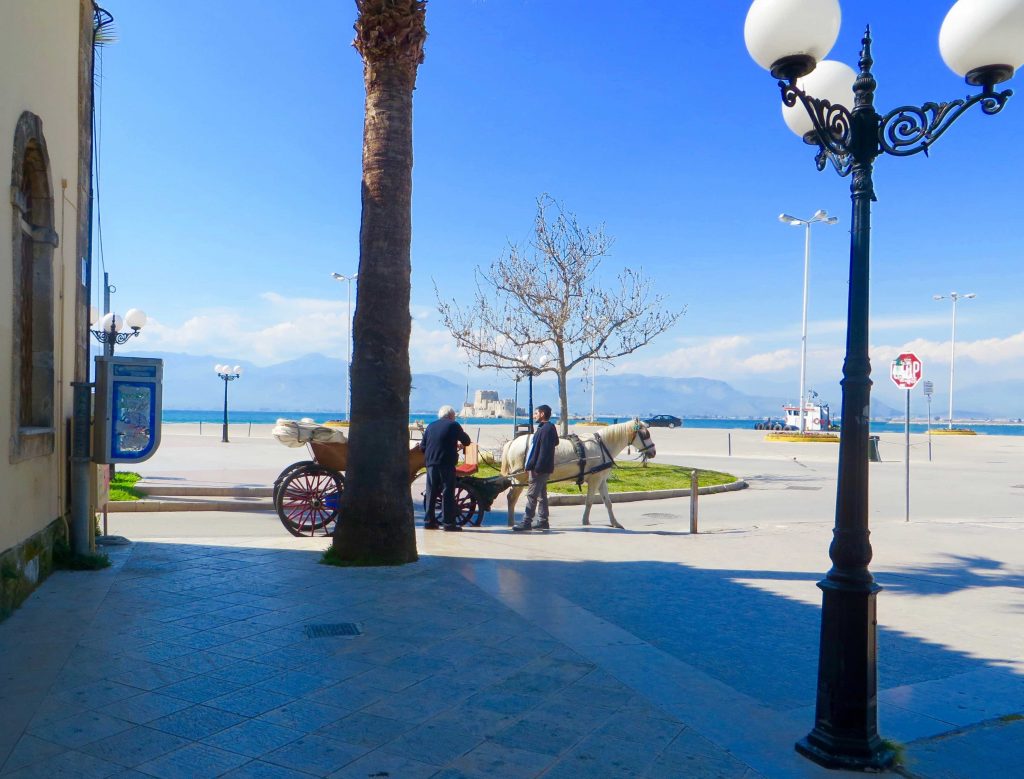
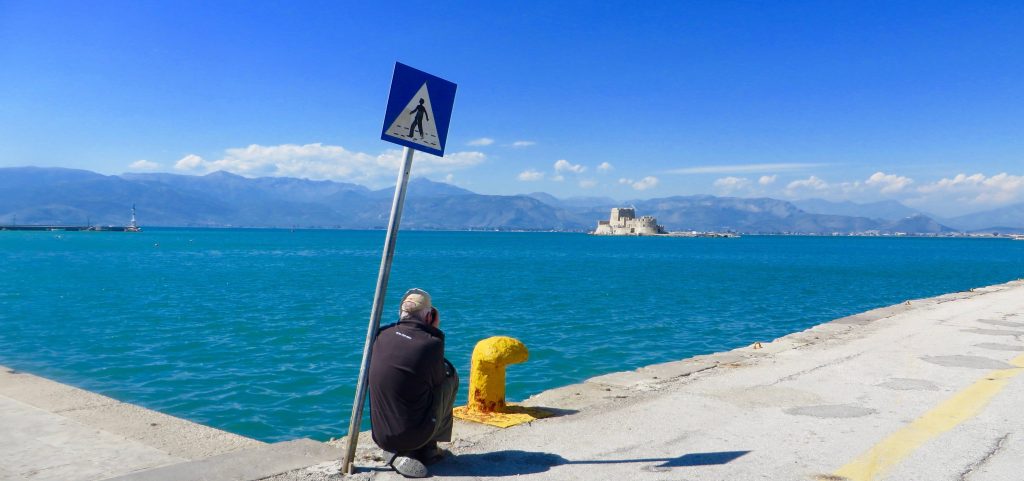
The streets are silent. The tavernas are closed. But the air is fresh with a sea breeze and it’s lovely to be here …
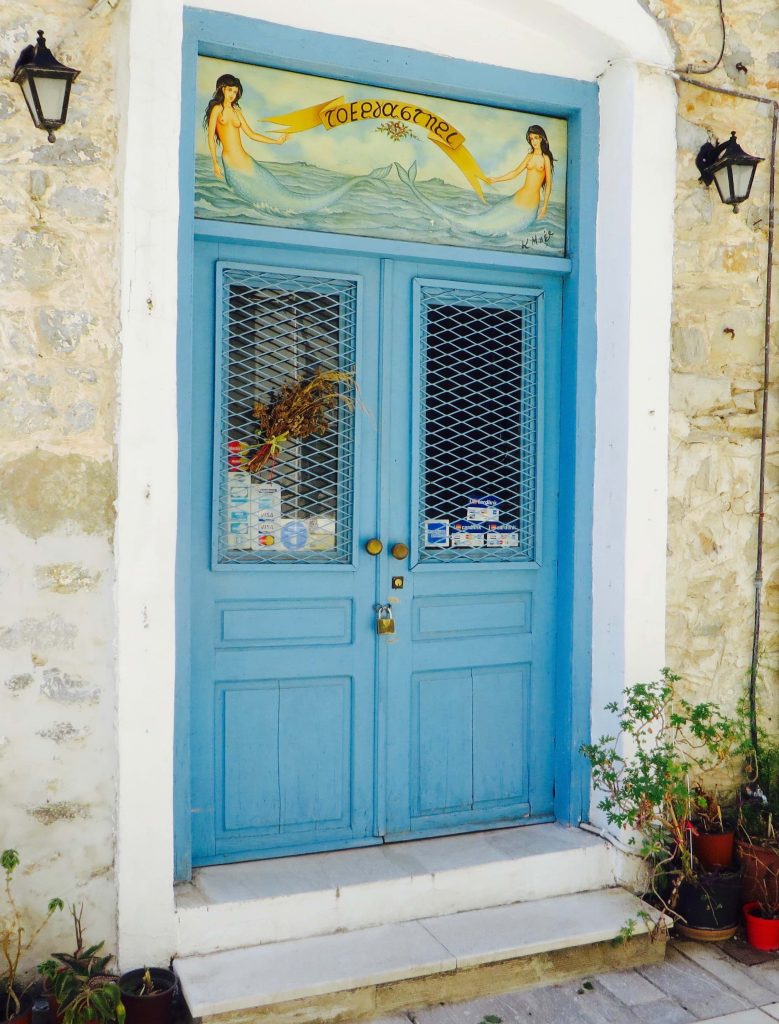


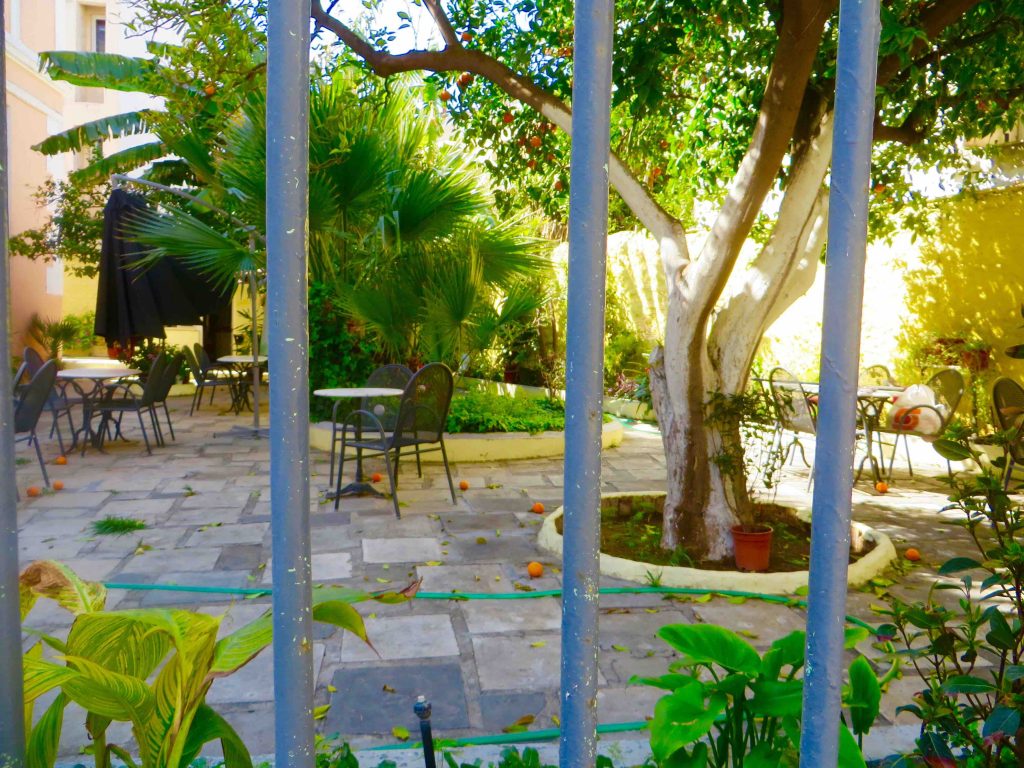

In Greek mythology the little owl was the messenger of Athene, goddess of wisdom. Fifty years ago, we bought a print from a gallery in the Plaka in Athens and the owner gave us a tiny print of a ‘little owl’ as a gift. I hadn’t thought about this for a long time until I saw these owls in a shop, which was also, sadly, closed. I have to say I am missing ‘the shops’ !
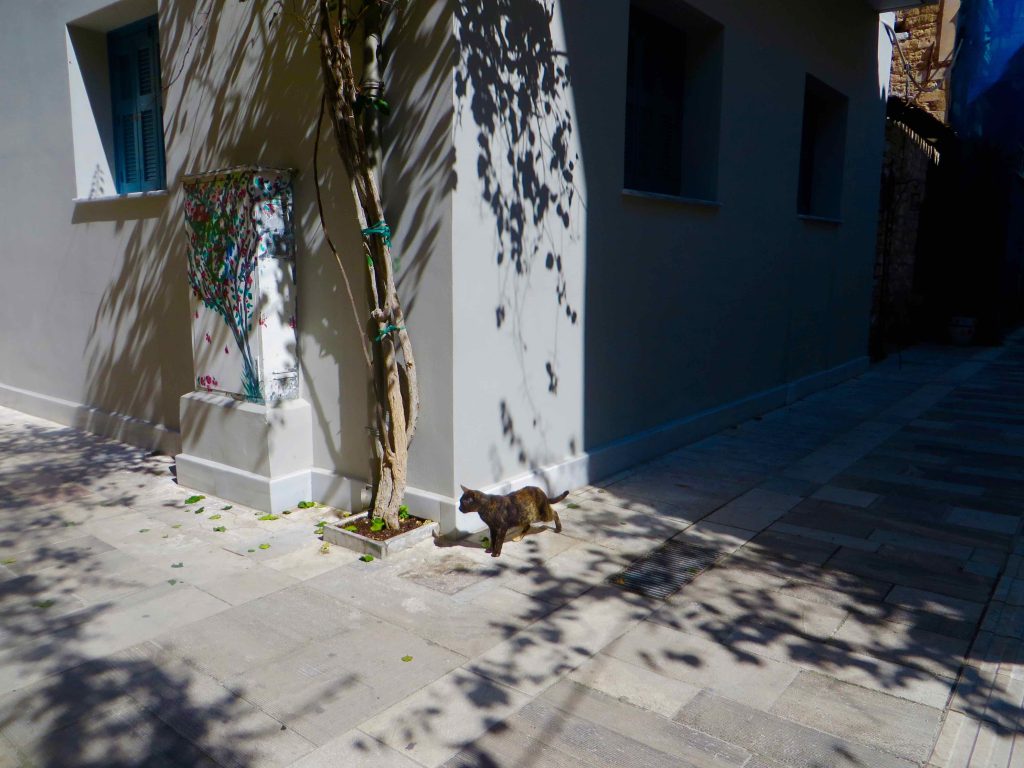
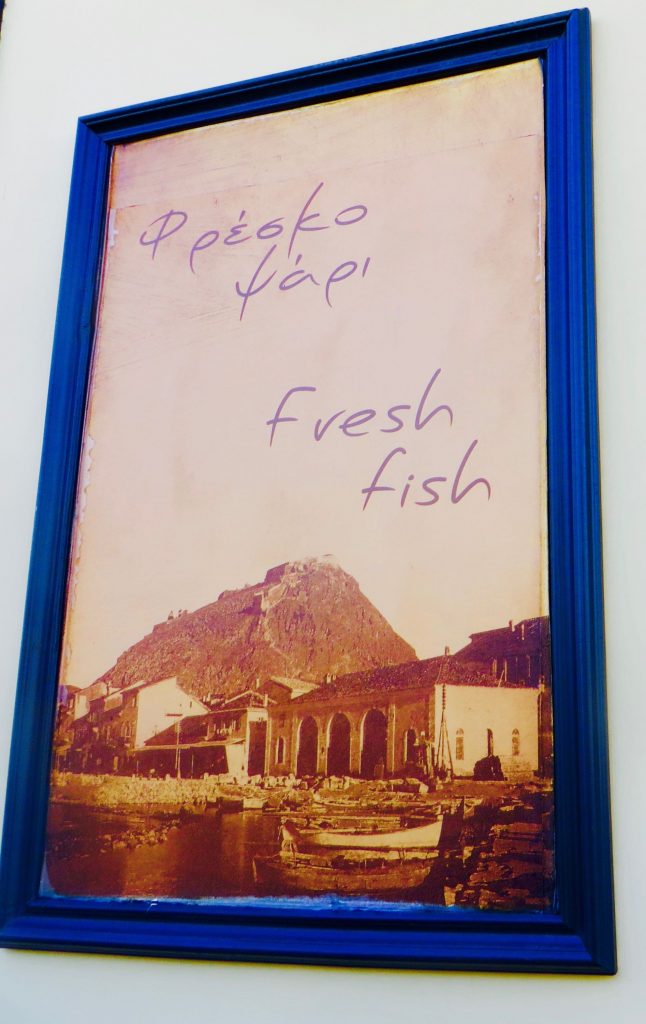
This is an old photo, showing the fortress and the harbour of Nafplion – the fish is still fresh today but there was probably more to catch then …

I hope I may come back one day.
Back at the hotel, I now know where its name, Amalia, comes from. The wife of King Otto. Jeremy said Otto really tried hard to be a good king in Greece. I’m lying on my bed having a rest before supper and idly looking at the picture of a mimosa tree on the wall. Mimosa is one of my favourite blossoms – a yellow, fluffy harbinger of Spring, coming out to give cheer in February, with the most delicate, seductive fragrance.
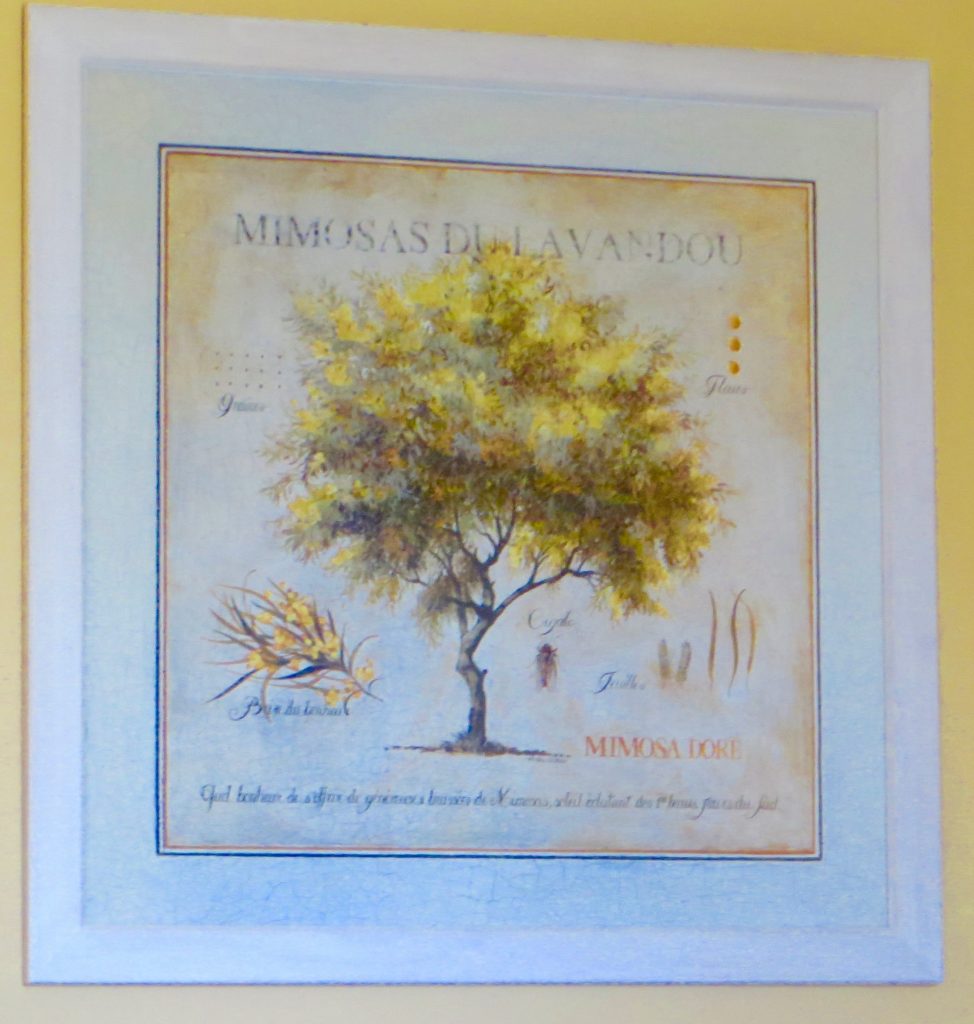
There are two life size ‘fake’ statues which we pass on the way to the dining room A woman holding a lute and a man who seems to be holding a giant ice cream. That ice cream in Nafplion was especially addictive …
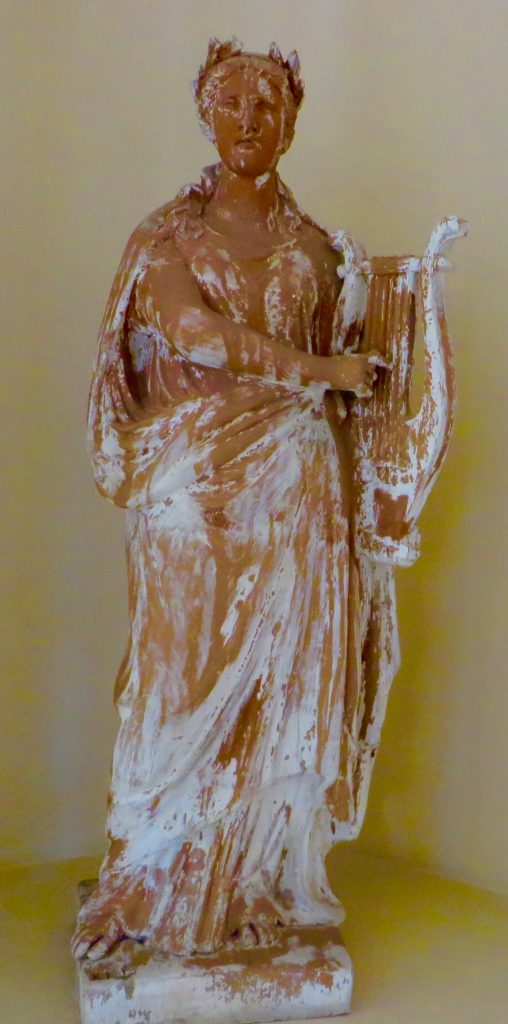
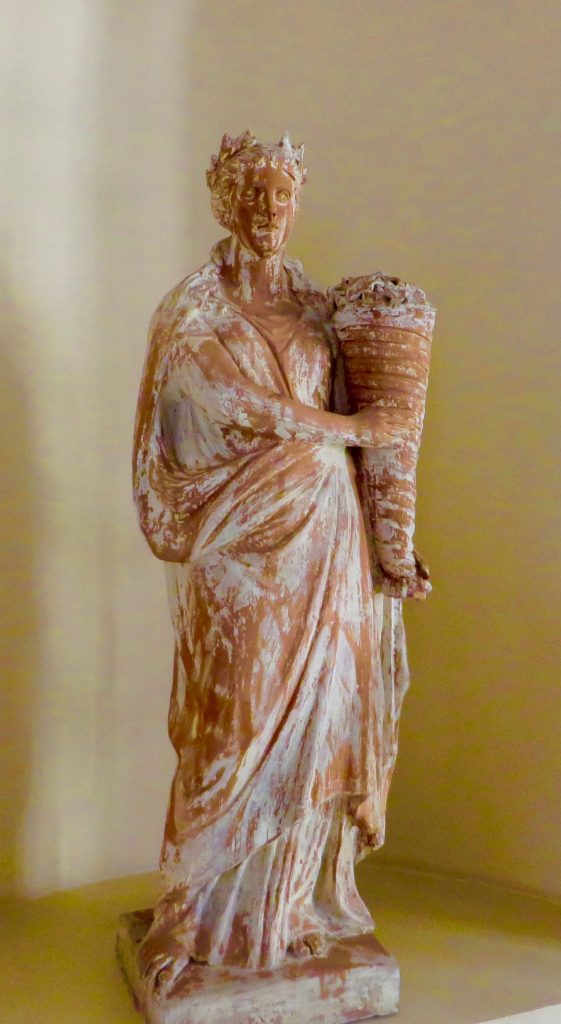
This may sound flippant but as all the museums have been closed from day 1, I don’t have much in the way of Hellenic sculpture to show.
Next morning is cool and cloudy. George had a word with some nuns last night, who offered to show us round their nunnery, two at a time. On arrival all is silent and after many attempts with the bell pull and his phone, George decides that they must have changed their minds. The small shrine at the entrance will have to suffice.
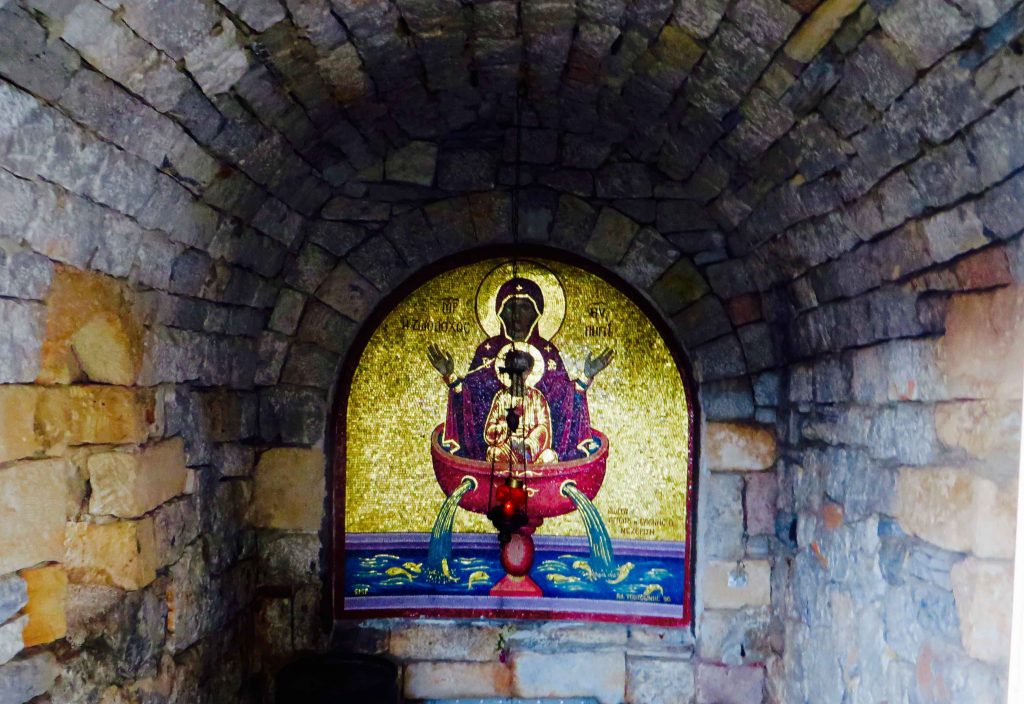
We pass by the site of Tiryns and drive on to a small church where the caretaker arrives on his bicycle to let us in.
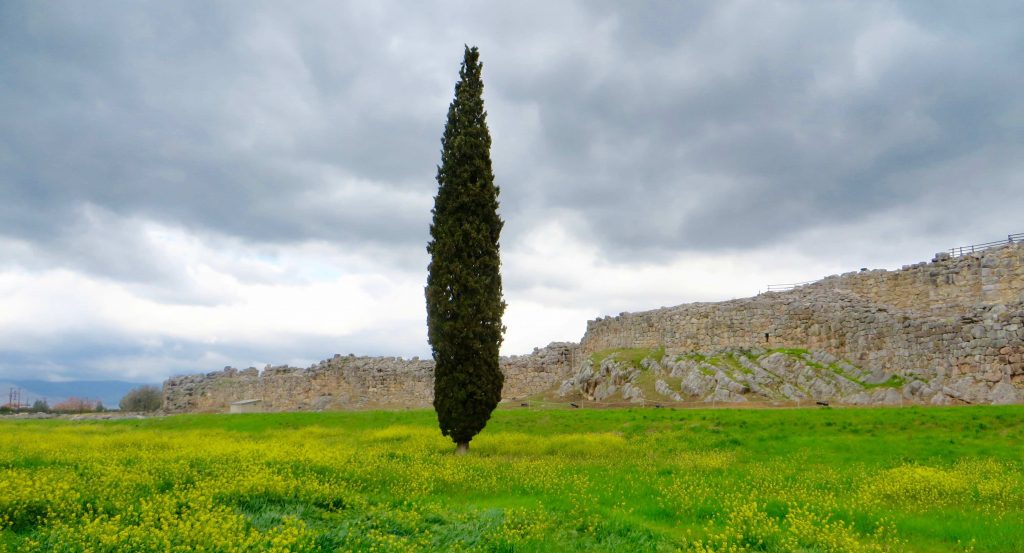
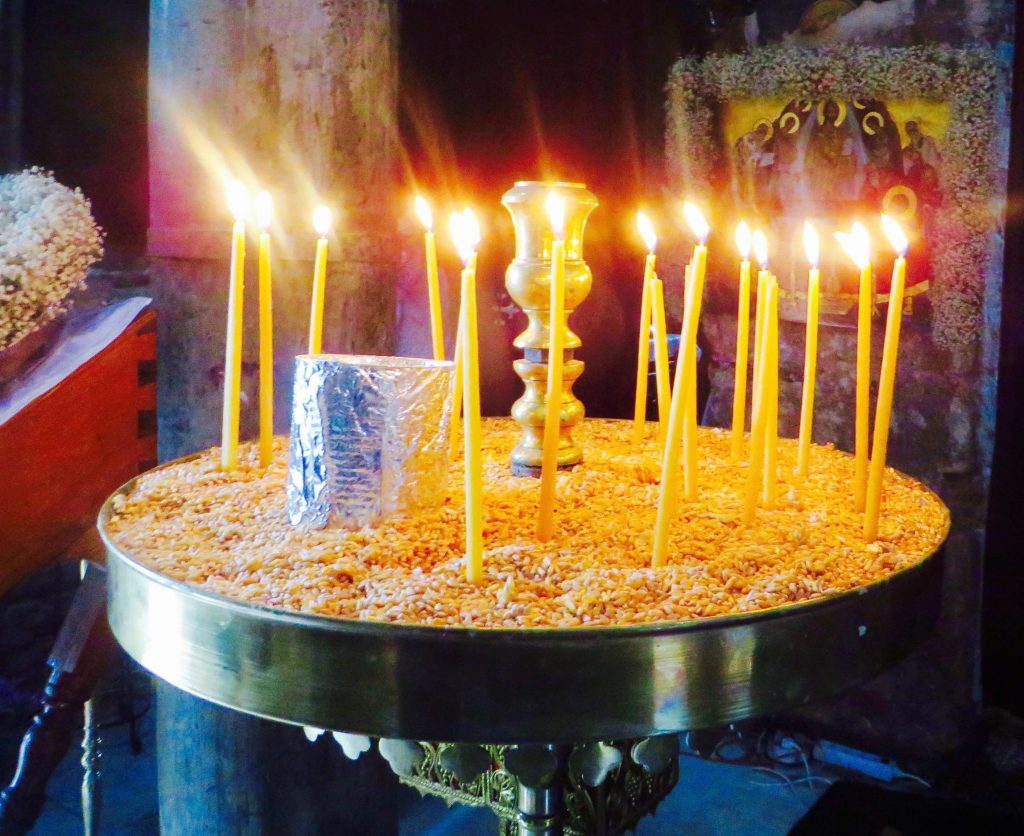
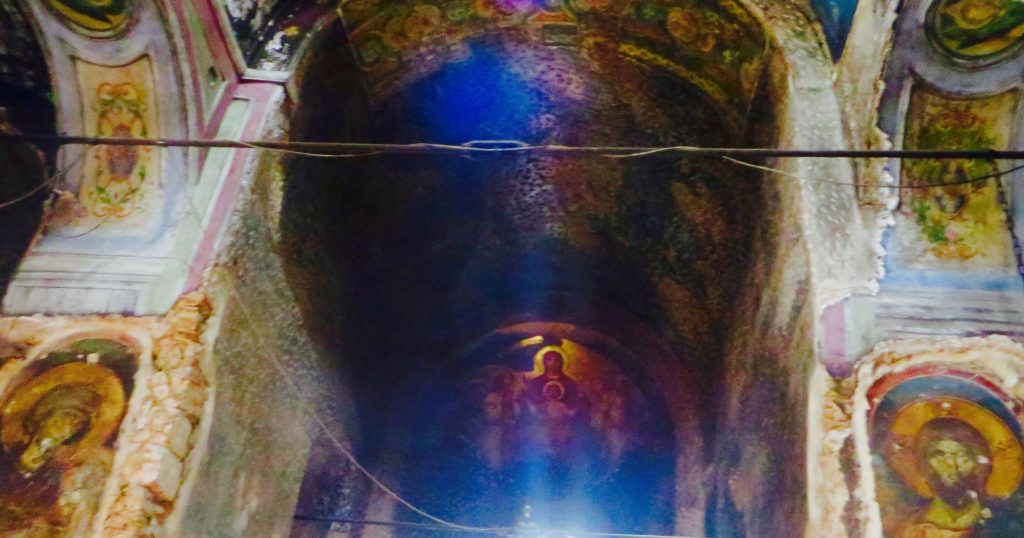
We’re going on to Mycenae but will only get a superficial look as the site is now shut and we’ll miss seeing the Lion Gate and the tombs. This complex of buildings was discovered by Heinrich Schliemann in 1874. It spans the years 1700 – 1100 BC, when it was abandoned. John remarks on first view that it reminds him of a battleship. I expect it survived many battles before sinking into the earth. We’ll have to make a return visit.

The car park at the top is empty, except for our bus and a ‘pussy posse’ who explode out of the underbrush in the hopes of food. Bianca supplies this as they circle around her.
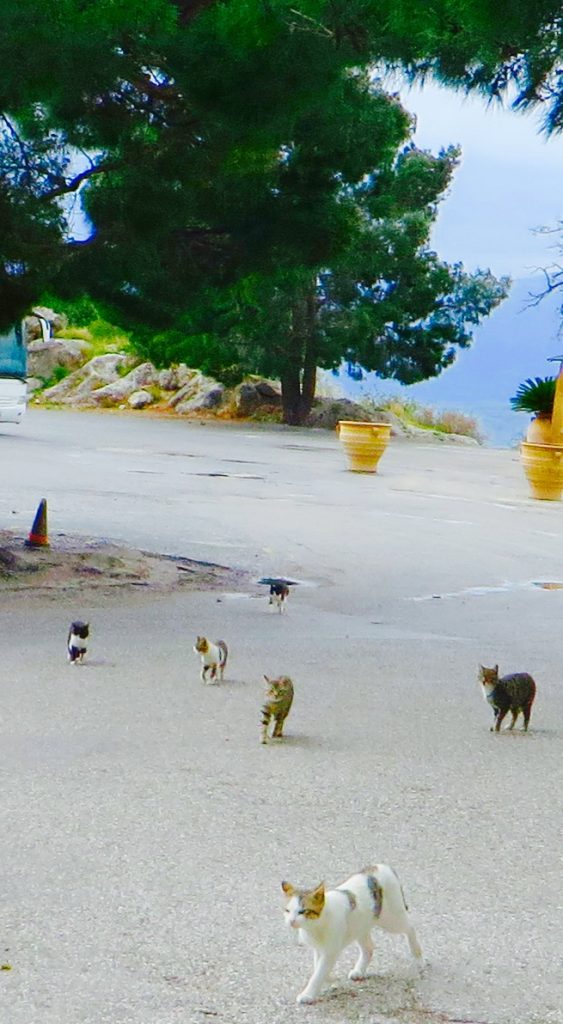
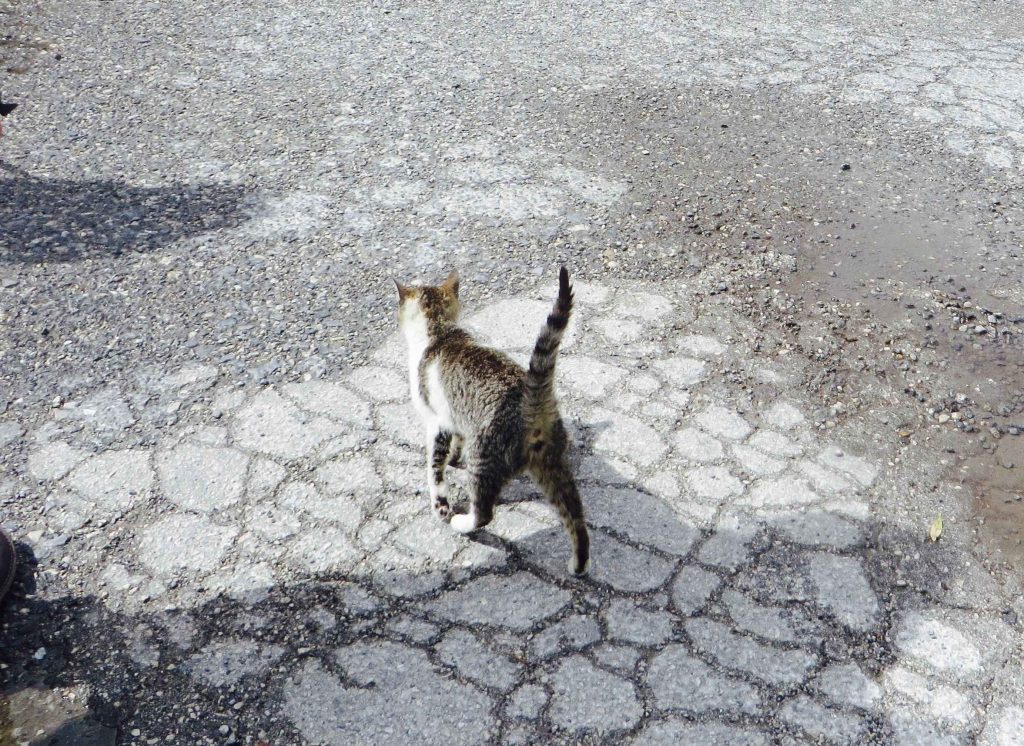
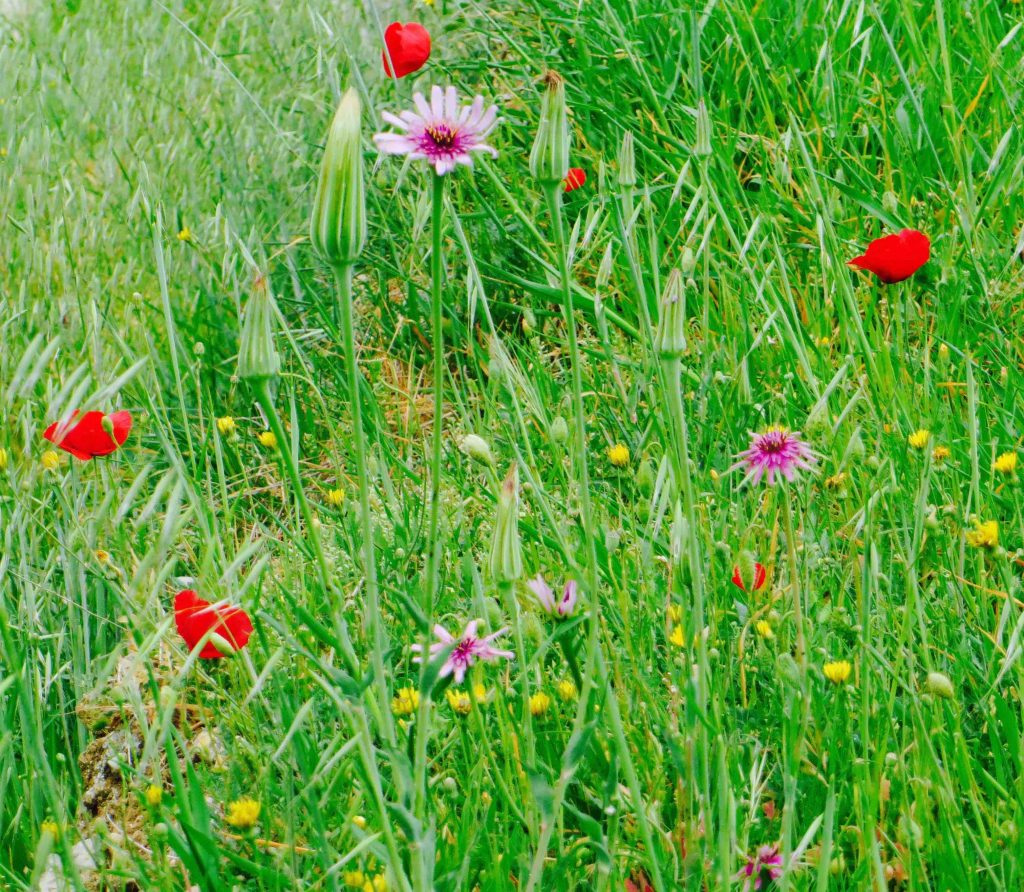
Petrol station alert – we stop for food and facilities and find there’s a shop attached. I did rather covet the head of Medusa and thought about buying an ‘icon’ of St. George and the Dragon’ and/or an octopus plate but ended up with six bars of orange blossom soap to give as gifts when we get home. I don’t yet realise how very welcome these gifts will be …
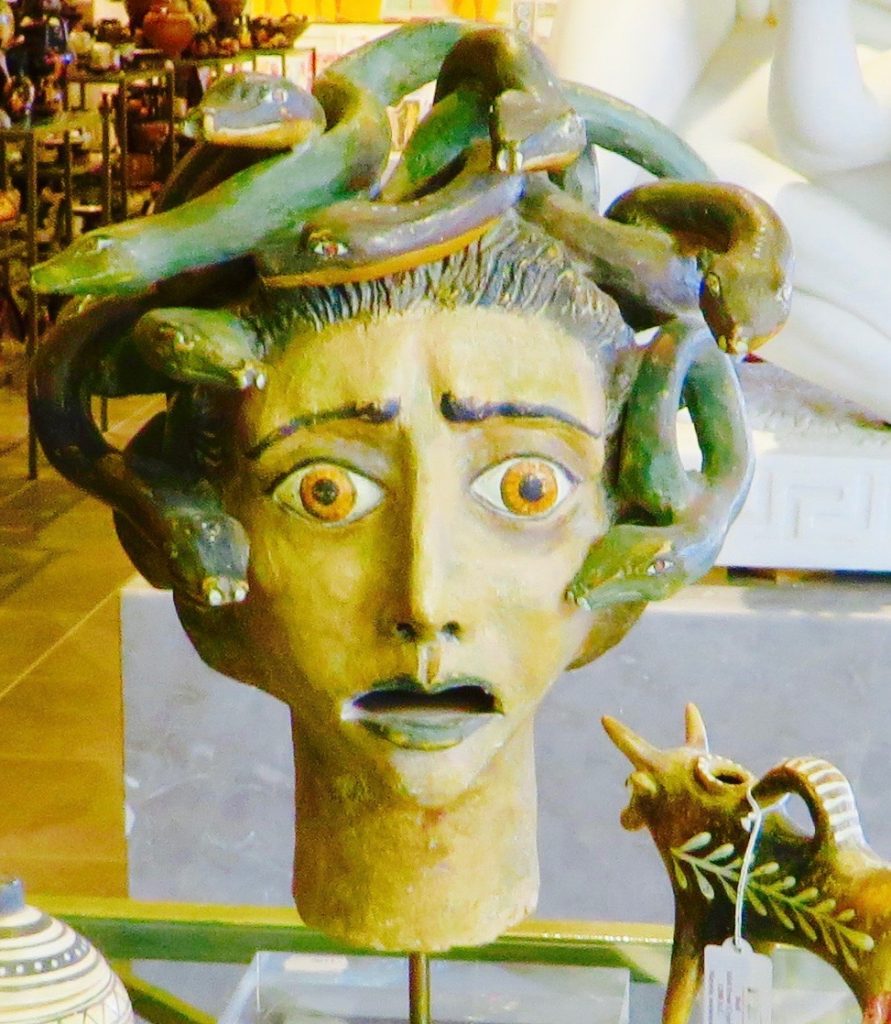
Her hair was live snakes and if you looked at her you would be turned into stone. Hercules managed to kill her by looking at her reflection in his shield.
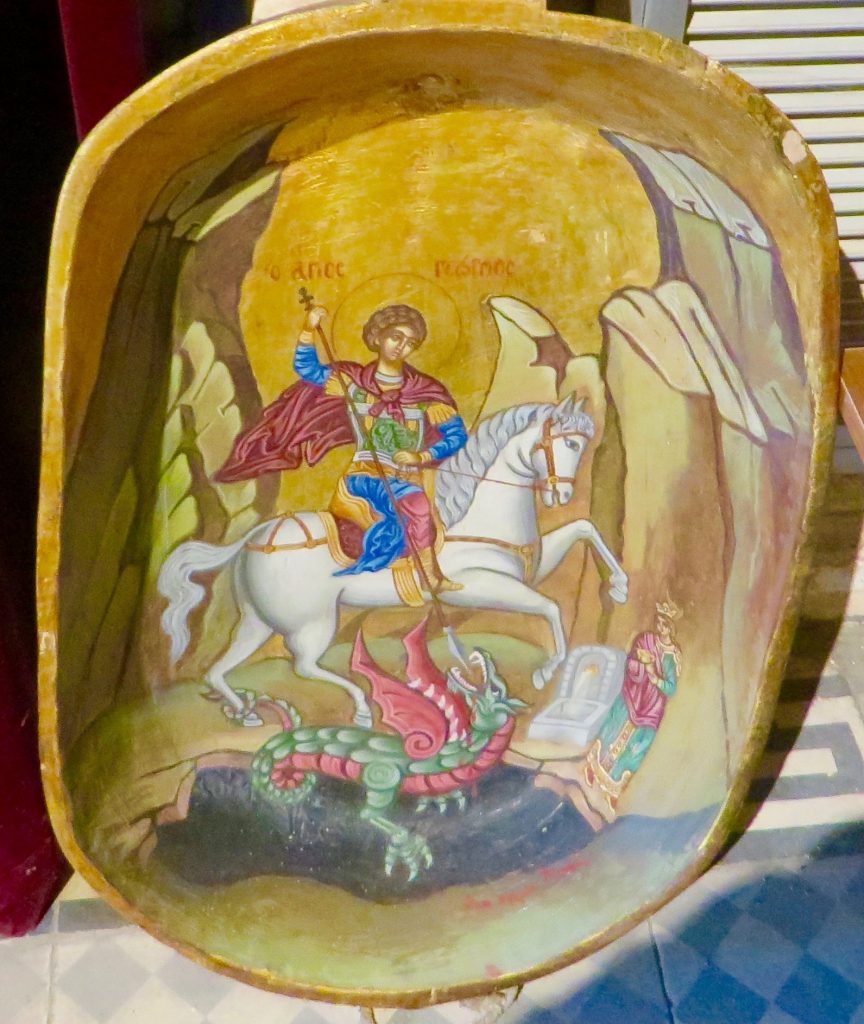
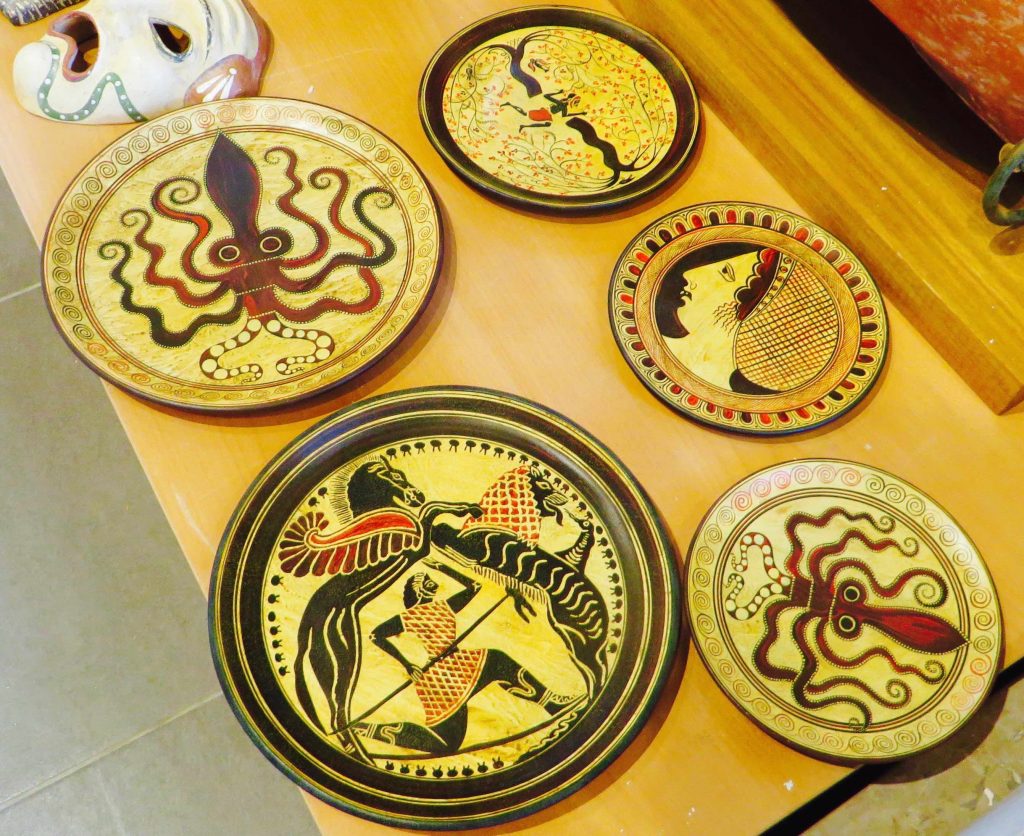
Outside there’s a reproduction of the ‘Jockey of Artemision’. This is a bronze statue of a young boy riding a horse, dated to around 150 – 140 BC. It was lost in an ancient shipwreck and found in the wreck in pieces only in 1926. Then it was reconstructed and can now be seen in the National Archaeological Museum in Athens.

Coronavirus is now snapping at our heels and any other tourists seem to have evaporated. We are alone but in good company with our three guides and Nikos at the wheel. Our destination today is Epídavros but we stop off on the road from Tyrins to look at a famous (Arkadito) Mycenaean bridge, which is, astonishingly, still here – dating back to the Greek Bronze Age.

We stop in a small town to look at an exquisite little church that I feel I could hold in the palm of my hand. There’s an orchard of almond blossom behind it, sunlit orange and lemon trees … we have now been told that ‘Travel Editions’ has got us onto an earlier plane, so home tomorrow. It’s probably for the best.
What I will miss most is going to Mystras and Sparta, which I remember very clearly from fifty years ago. We walked up steep hills, baking in the hot sun, fragrant with oregano, thyme and rosemary beneath our feet. When you want something and know you can’t have it, then you want it even more – we are so near and yet so far. Even more of an incentive to try again next year …
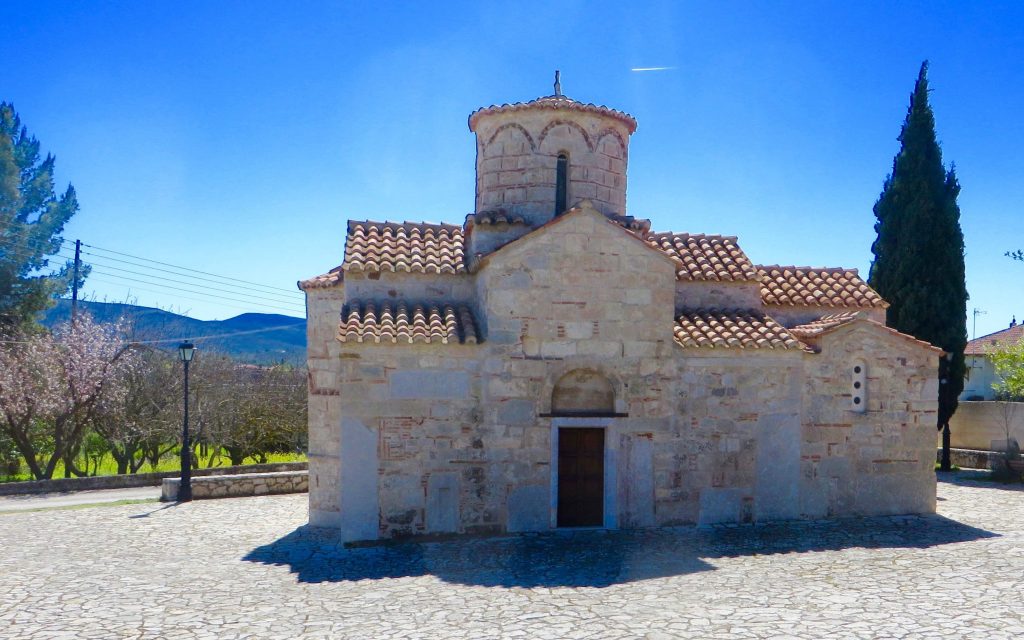


George tells us that there are lots of different kinds of oranges grown in Greece. I’m not sure from this picture whether I’m photographing oranges or lemons – the latter, I think. But they are super large. If you’re interested to know more about the history of citrus fruits, the book ‘The Land Where Lemons Grow’ by Helena Attlee is a great read – but mainly based in Sicily. It also includes some recipes.
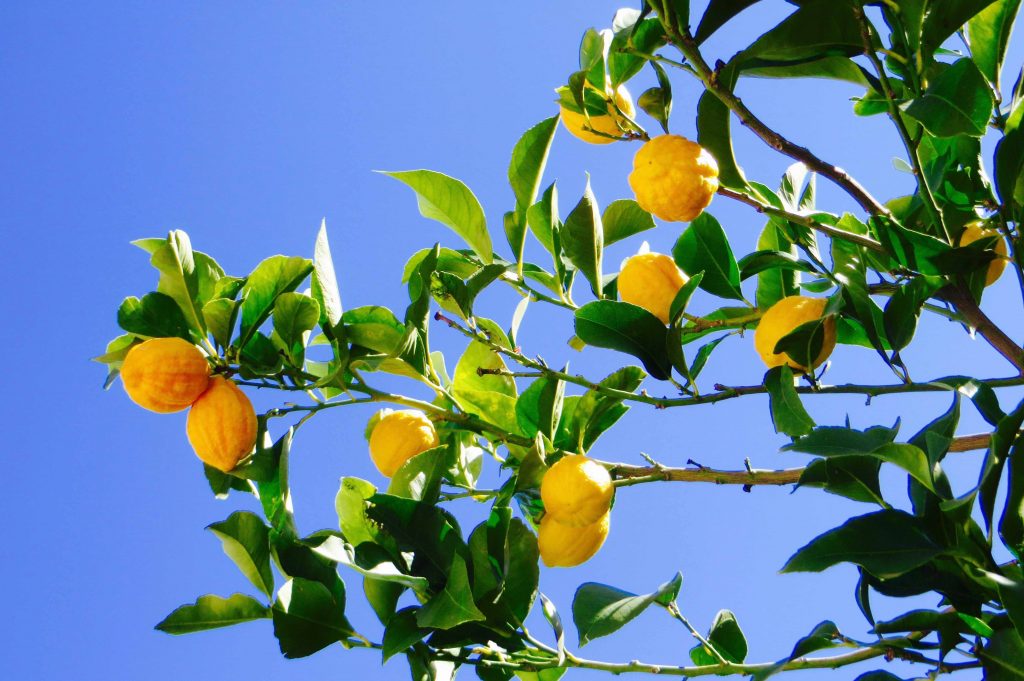
The skin is rough and knobbly but they look delicious. I desperately want to pick one and eat it – but they belong to someone else. I turn my attention to other things …

It’s so warm today – almost like summer now – Easter flowers – a perfect spot to enjoy sleeping in the sun.
I notice a tree that’s been cut down by the church, where a beetle has bored lots of holes through the stump.
Two years ago we stayed in a lovely hotel called ‘Es Moli’ in Deia, Mallorca. The gardens were beautiful but some of the pine trees had holes in the bark, just like this. It’s an attack by an evil looking beetle. One landed on my hat and I should have killed it at the time but then we didn’t know what it was. There are photos of it in my journal about our stay in Deia. Diseases of trees are very much on the increase, throughout the world.
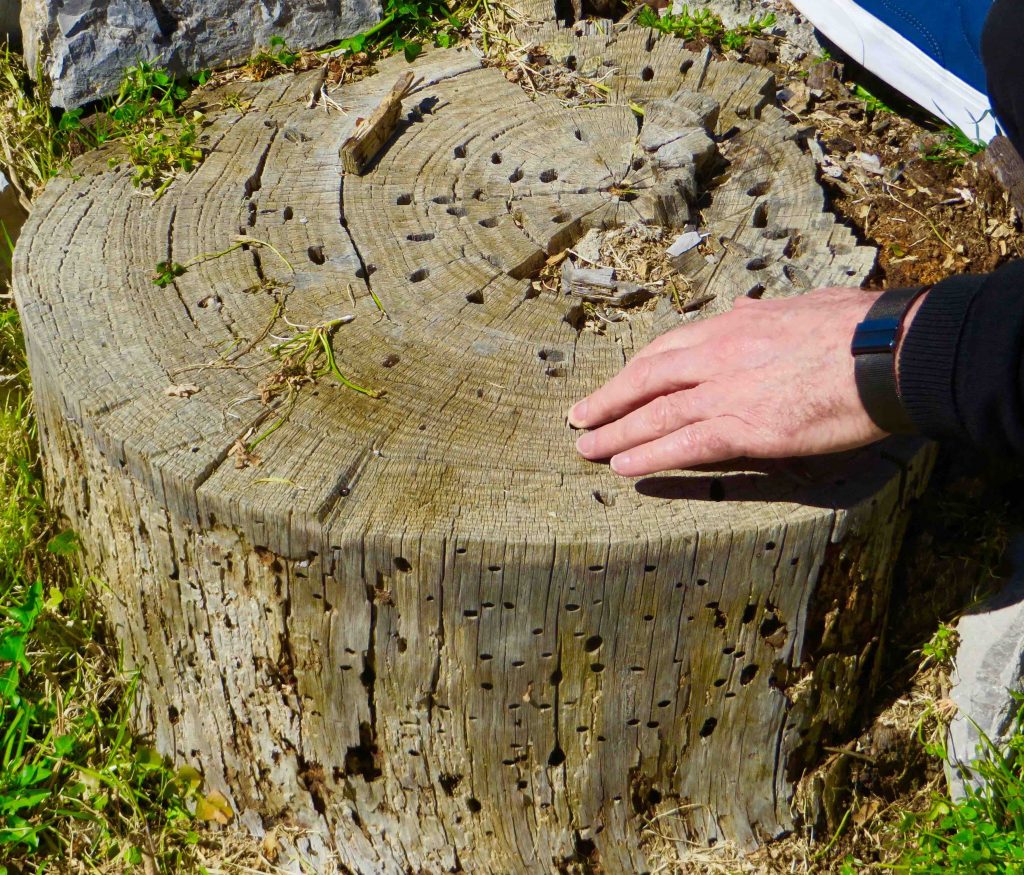
George has devised a walk for us through olive and orange groves to the village which is near the site of Epídavros. It’s delightful to be by the sea again. And I love being off the beaten tourist track, despite missing some of the sites. I feel the pull of Greece and I want to come back.
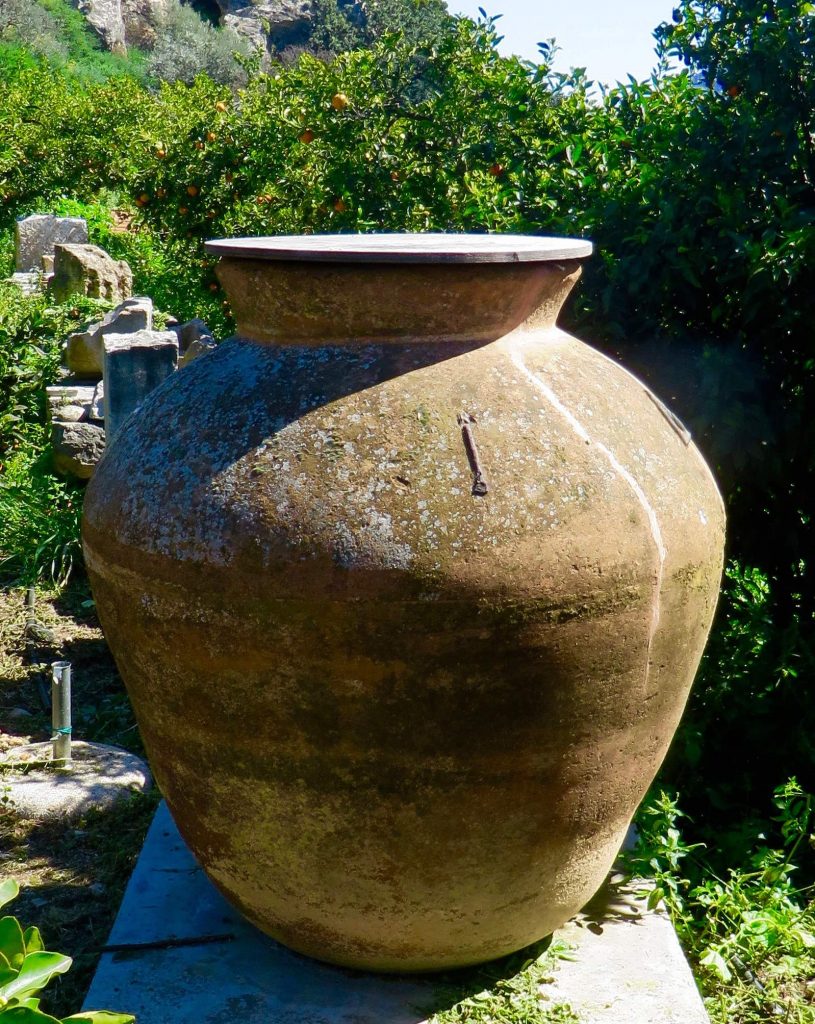
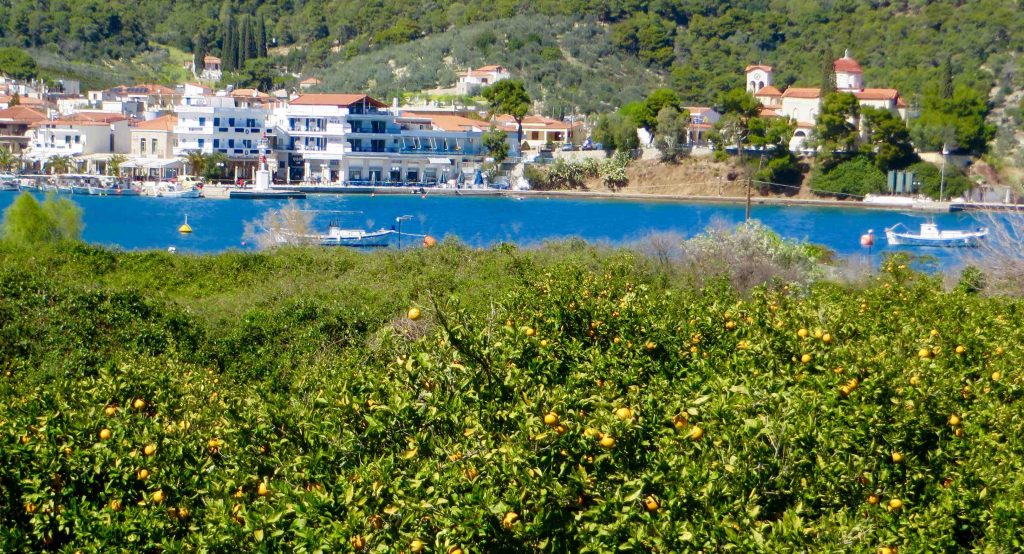

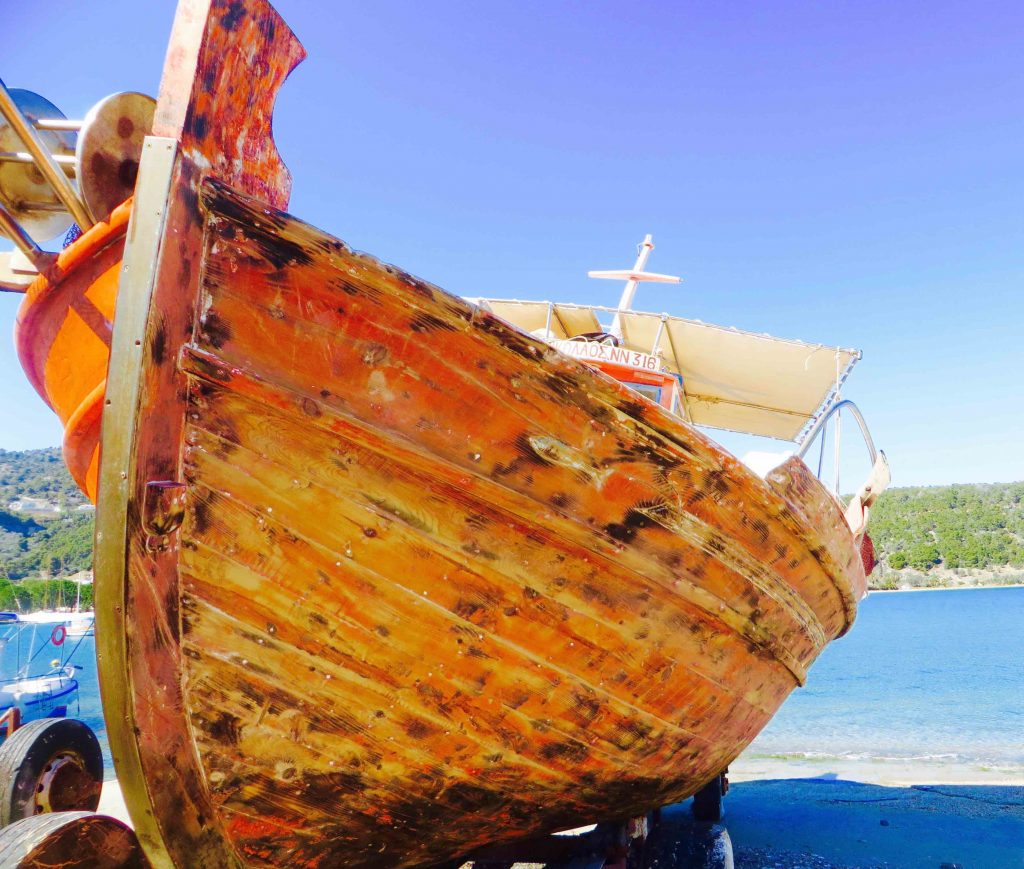

Look how the patterns in the wood mimic patterns in water …

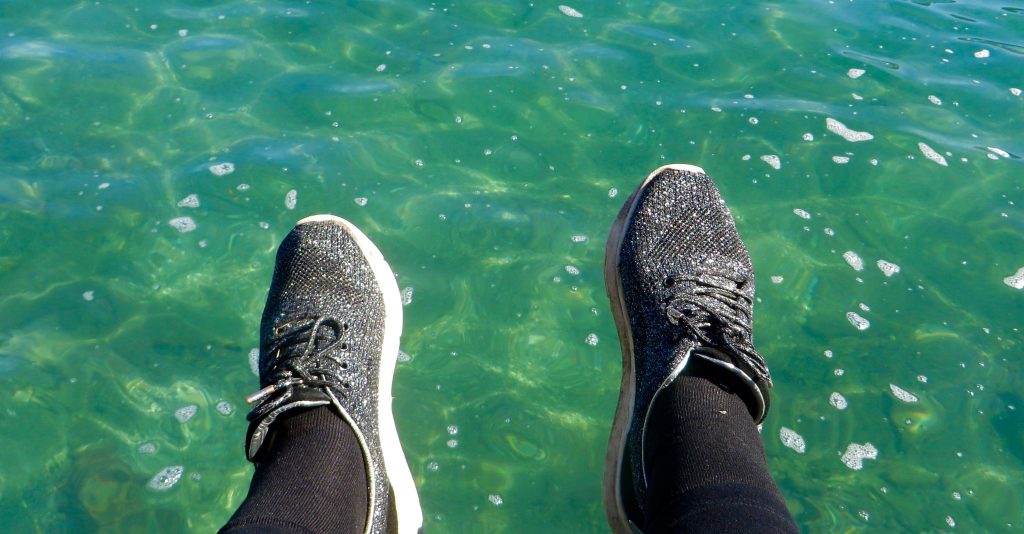

Greece has had such a battering over the past few years and now they are losing the tourist trade because of coronavirus. We’ve been welcomed and had a brilliant time here but I feel guilty leaving the Greeks to yet another uncertain future, just as they were getting back on their feet.
But they are a tough people and will keep going and we’ll be back. If Europe can’t get itself together a lot of us will be in the same boat. This is the first time I am querying whether we should stay in the U.K. I see myself as European and then British. But where are we now? We should be strengthening our bonds and making Europe a continent to be reckoned with. China and the U.S. are powerful but they also have huge problems – even more so in the present circumstances.
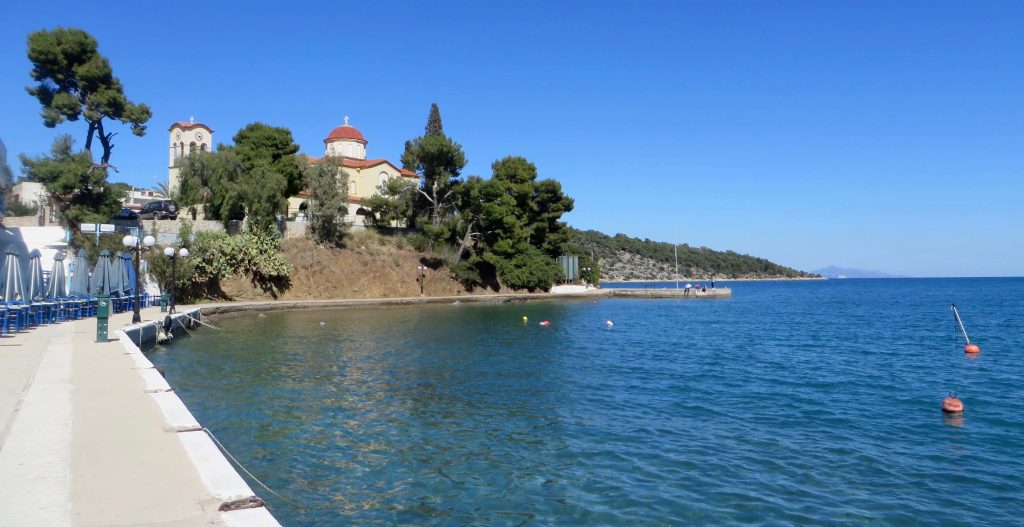
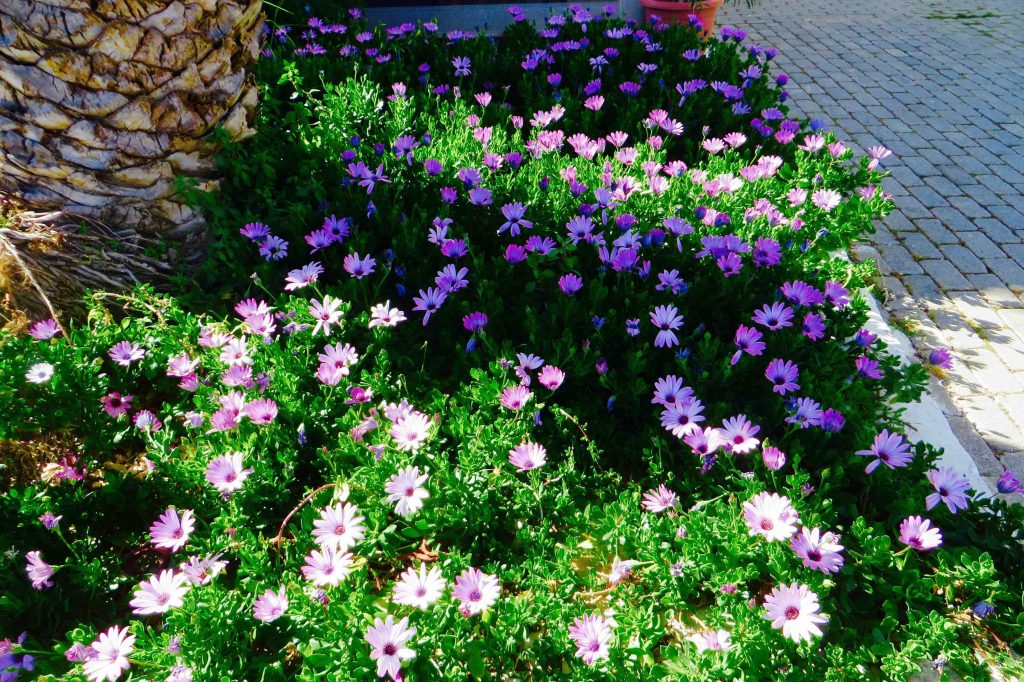

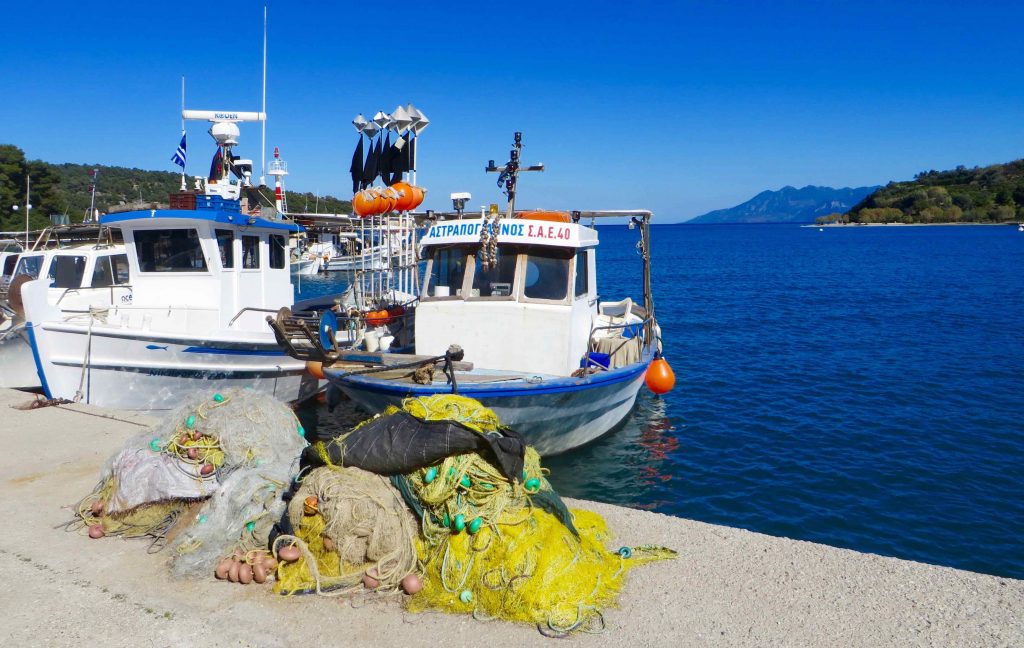
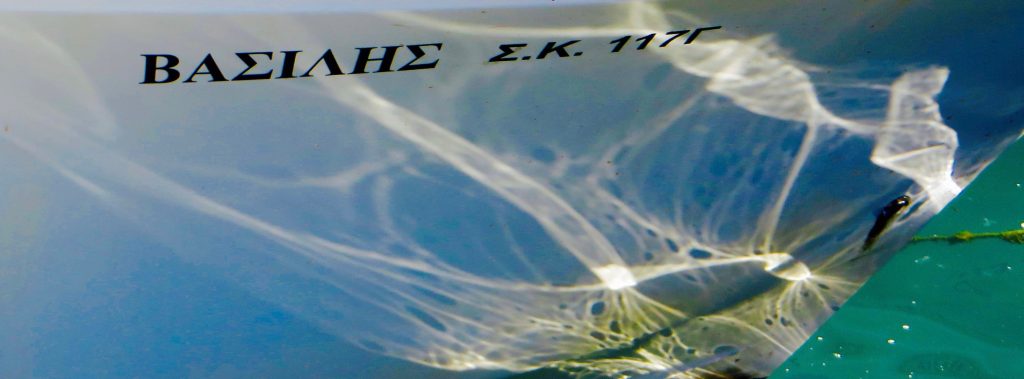
I’m aware that I’m teasing out this last day to make the most of it. We are now on our way to the site at Epídavros. It’s closed too but the location is magical.

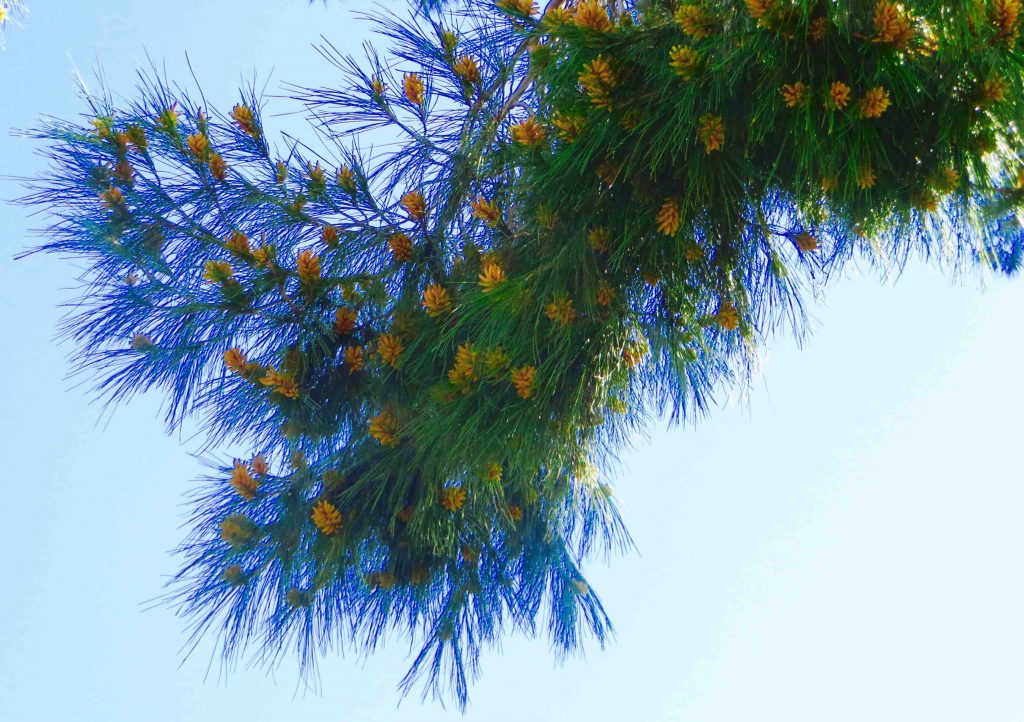

Persephone is the goddess of Spring. Her Roman name is Proserpine. Khloris is the goddess of flowers. Her Roman name is Flora. I need to find a book which gives me all the Greek names of the gods and goddesses with the equivalent Roman ones. One book which sounds very good is ‘The Complete World of Greek Mythology’ by Richard Buxton.
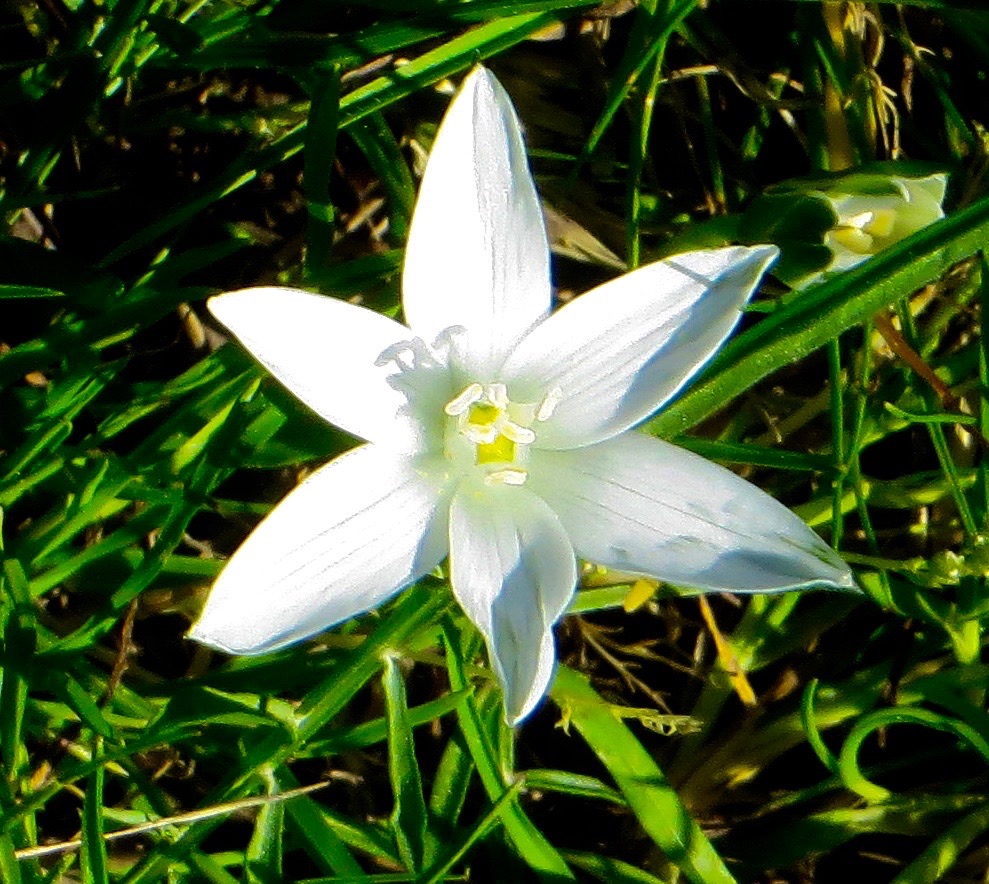
This grows on many of the sites we have visited. It is part of the lily family and poisonous to eat. And beautiful …
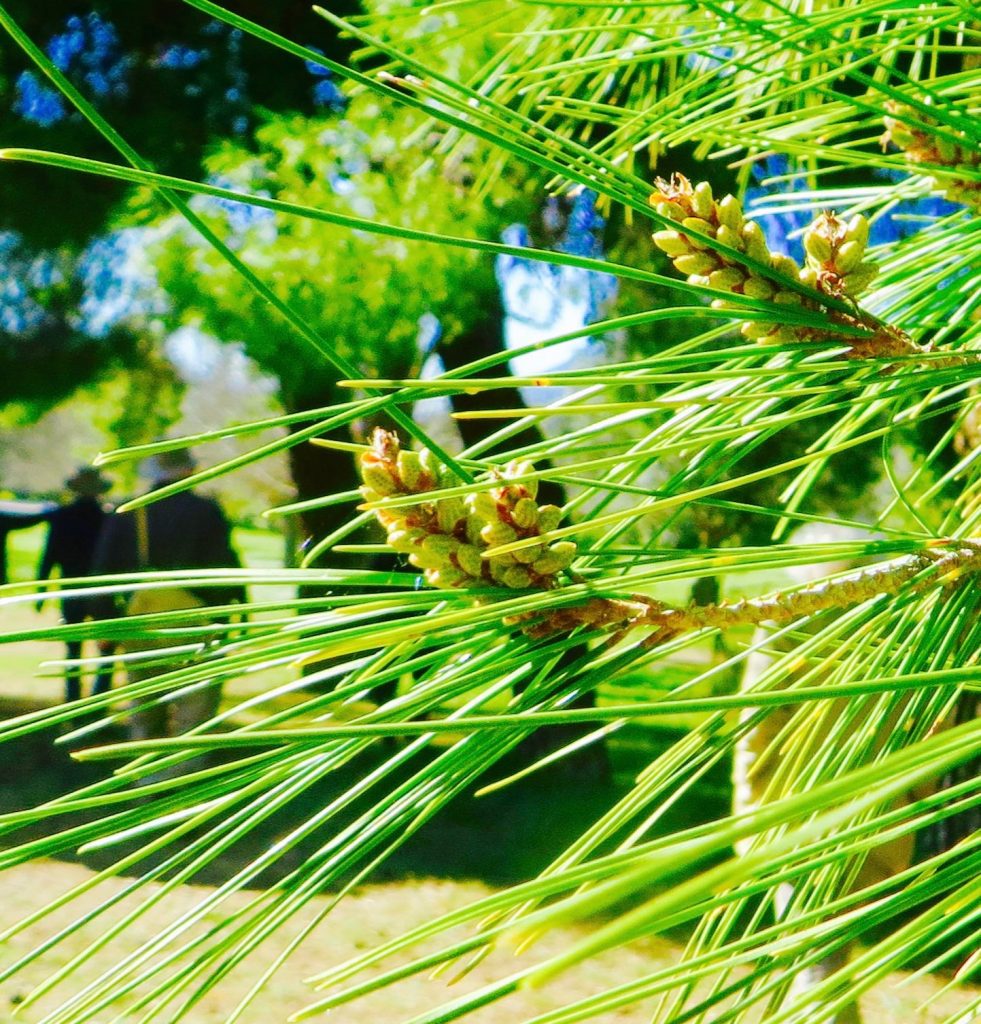
Tomorrow we pack up and leave for the airport. The hotel waves us goodbye and closes down. Soon we will all be scattered to the four winds but there are still one or two treats to be had together.
I took a fast moving photo from the bus as we passed the ‘open’ prison on the other side of the road from the hotel. John and I realised that it was the same place where we had pulled off the road fifty years ago as it was getting dark and we had nowhere to stay the night. The others put up their tent in what we thought was a field, while John and I slept in the back of the Land Rover with the tailgate down. I was woken at dawn, having a dream that somebody had cut off my feet. When I lifted the canvas at the back of the Land Rover, a man with an axe was standing there.
Dreams like that don’t usually come true – and my feet were still attached. We worked out that the man had murdered his wife’s lover – and was here atoning for his sins by working at the prison in the olive groves. He seemed content and we enjoyed his company. I still wonder about it …
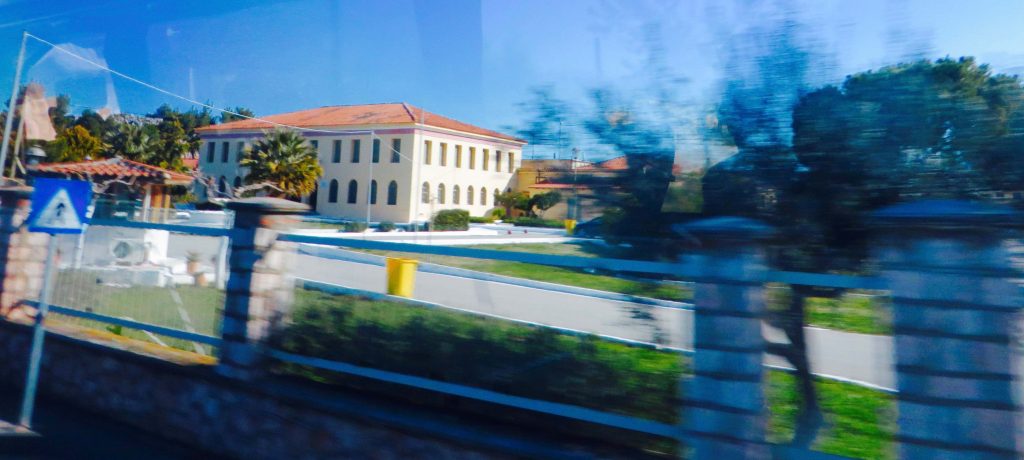
We’re stopping to get a view of the Corinth canal. There’s an old photo of this in our album at home with a ship coming through.
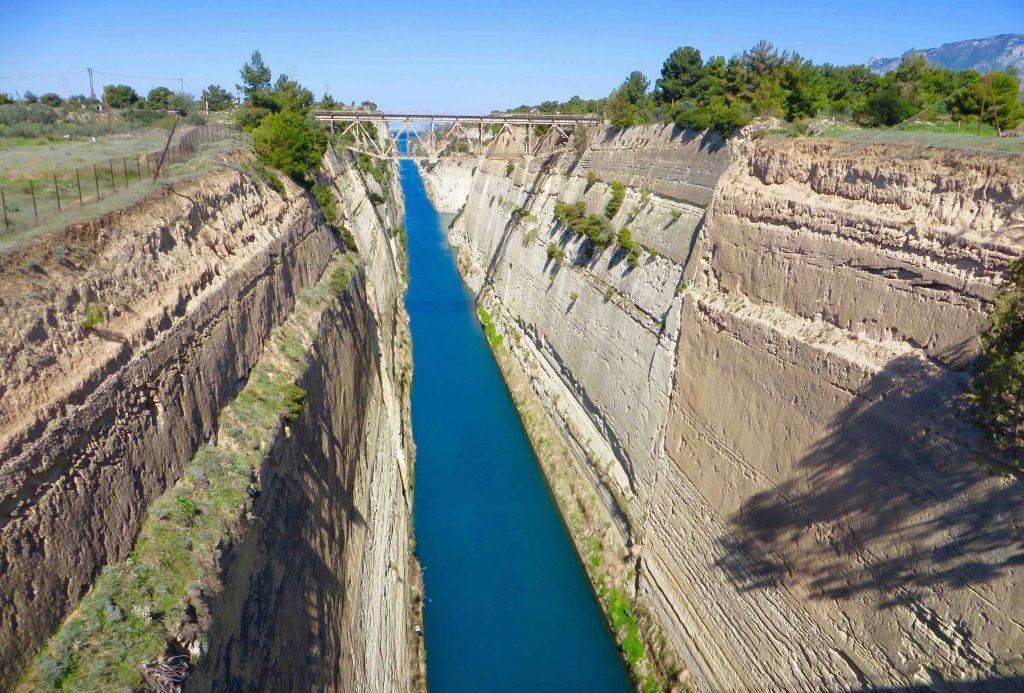
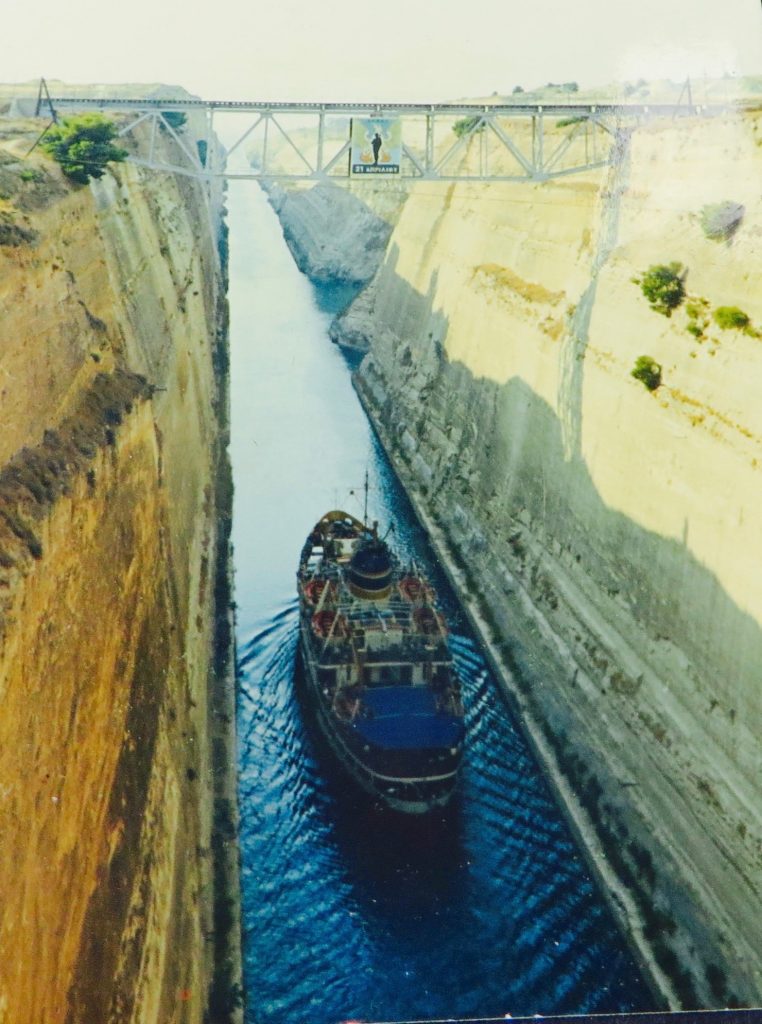
John took this photo fifty years ago. Things don’t seem to have changed a lot – except there’s no poster today showing the ‘Regime of the Colonels’ – far right military juntas that ruled Greece from 1967 – 1974. But something isn’t quite right …
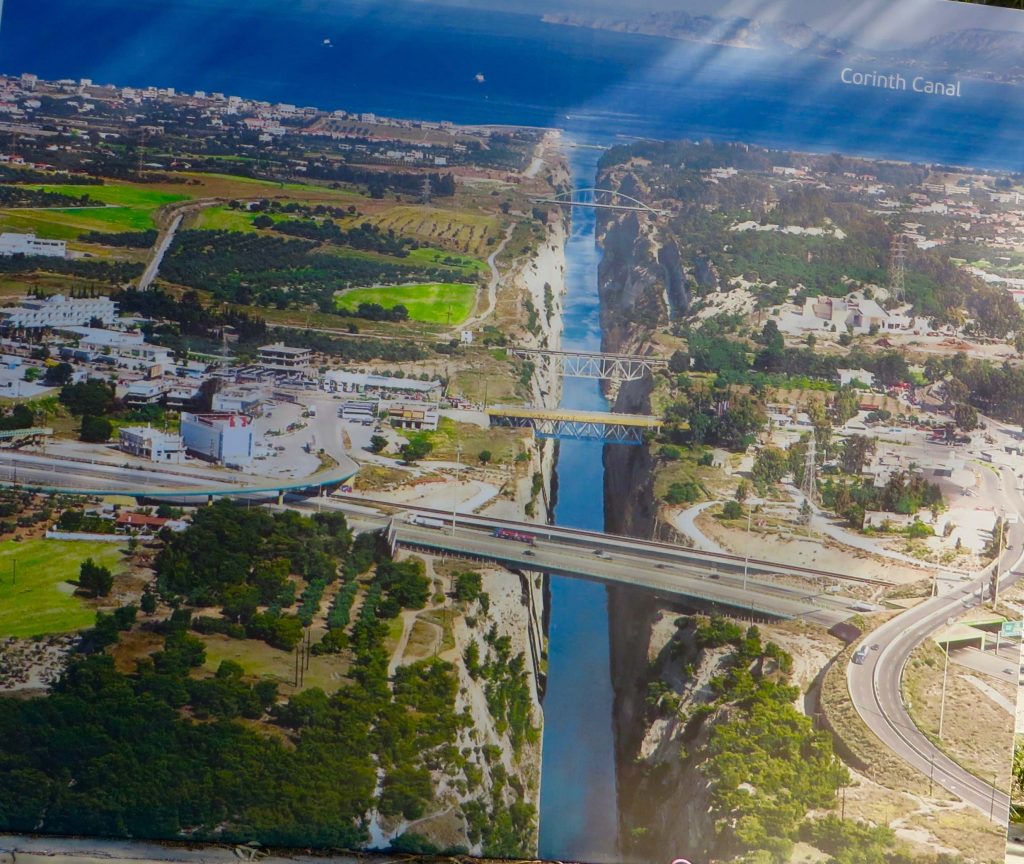
I took a photo of the bridge shown at the information kiosk. Having wondered how John managed to take his photo, I realise that the motorway, where we are standing today, wasn’t there. John’s photo was taken from the next bridge.
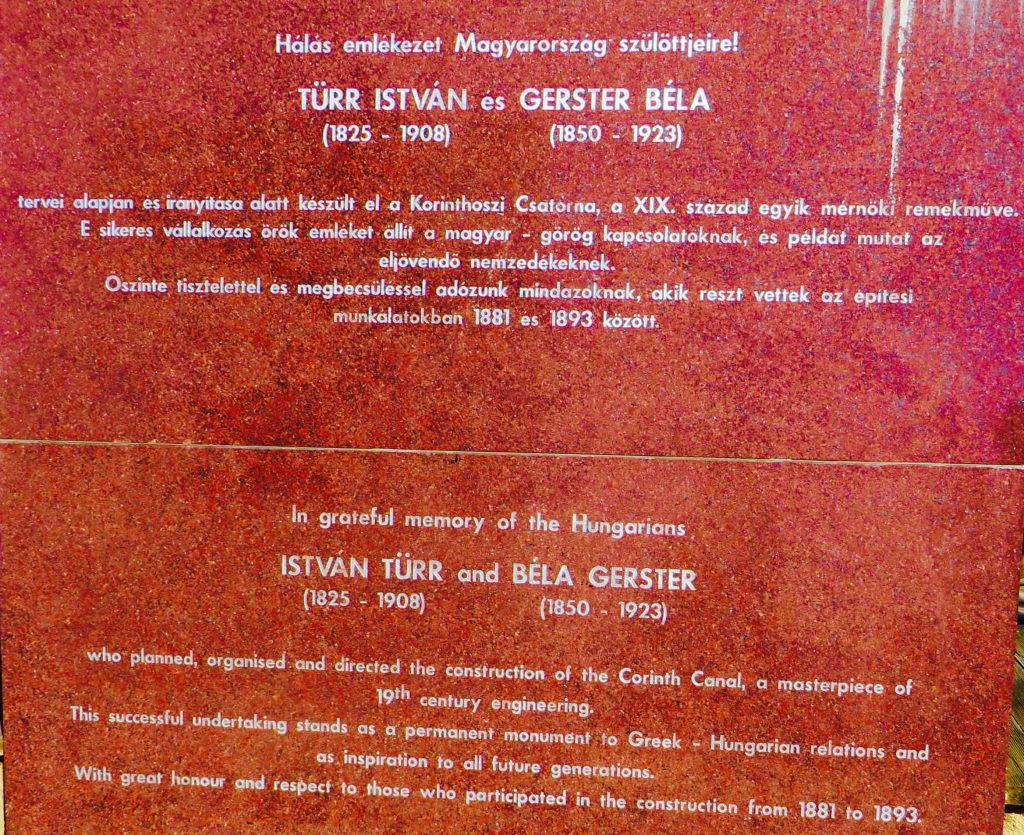
Athens airport is fairly empty – all the staff and many people wearing masks. As John travels so much we are able to sit comfortably in the lounge and have some something to keep us going on the flight ahead. I’m really happy not to eat on planes at the best of times. This time coronavirus is stalking the aisles no doubt.
I can finish my book and look out of the window. I’d been watching Mark Kermode talking about films and he reminded me about how good ‘The Day of the Jackal’ (1973) was. Edward Fox played the jackal. I’d never read the book by Frederick Forsyth, so I bought a copy before we left. It’s a great thriller – you are on tenterhooks from the start and if you know Paris, that’s an extra bonus. It turns out to have been a perfect choice for this trip … and it is so filmic …


I’m so glad we managed to get here despite having to come home early. Thank you to Jeremy, Bianca, George and Nikos for a wonderful Greek odyssey and for keeping us entertained and safe and to ‘Travel Editions’ for getting us home ‘in the time of coronavirus’.
END
I don’t know if it’s a case of getting older but I do sometimes re-read books I have loved. These include ‘The Greengage Summer’ by Rumer Godden, ‘The Lady Vanishes’ by Ethel Lina White, ‘The Balkan Trilogy’ by Olivia Manning, ‘Hotel du Lac’ by Anita Brookner, ‘Unreliable Memoirs’ by Clive James (after his recent death), ‘Any Human Heart’ by William Boyd, ‘The Diary of a Nobody’ by George and Weedon Grossmith, ‘The Young Visiters (sic)’ by Daisy Ashford, ‘The Humans’ by Matt Haig and ‘The Places Inbetween’ by Rory Stewart. I love Patrick Modiano’s books in french, often just re-reading a chapter because of the brooding atmosphere of impalpable menace he is so good at invoking. ‘Maigret’ by Simenon, in french, is also a great favourite This short list probably gives some inkling into my personality. A lot of these books have also been made into films.
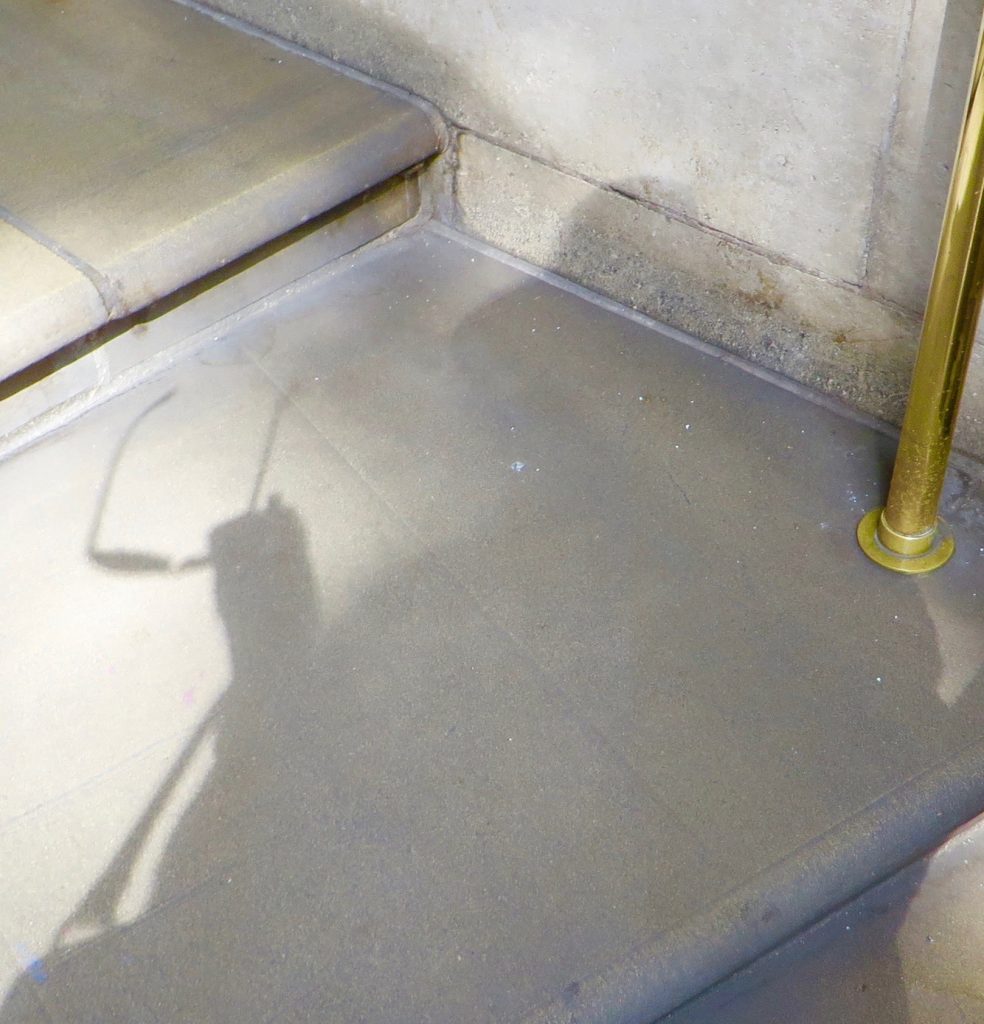
I’m starting with Muriel Spark, who was brought up in Edinburgh and ended up in Italy. She was quite a tricky personality but Alan Taylor, who has written her biography after many meetings and interviews over some years, became a friend and there was obviously a ‘spark’ between them.The book’s title is ‘Appointment in Arezzo’, subtitled ‘A Friendship with Muriel Spark’. What a great name, even though it came from her husband, who was, apparently, not so great! William Boyd writes on the cover, ‘A beguiling, fascinating memoir’ and I couldn’t put it more succinctly myself. I felt I got to know her well and found the book enormously enjoyable.
I also read her book, ‘Territorial Rights’. Much of it is set in atmospheric Venice – with rocky romance, adulterous liaisons, a would-be art historian meddling with a capricious countess, blackmailers and spies against a backdrop of ‘respectable’ ladies who run the Pensione Sofia. An interesting footnote – when Robert and Anna are tracked down by a middle aged man in a business suit, purporting to be a ‘talent spotter’, he tells them they have ‘style’ and can ‘make the top’. As a result, they are sent to the Middle East to train in a terrorist camp! This book was written in 1979 …?
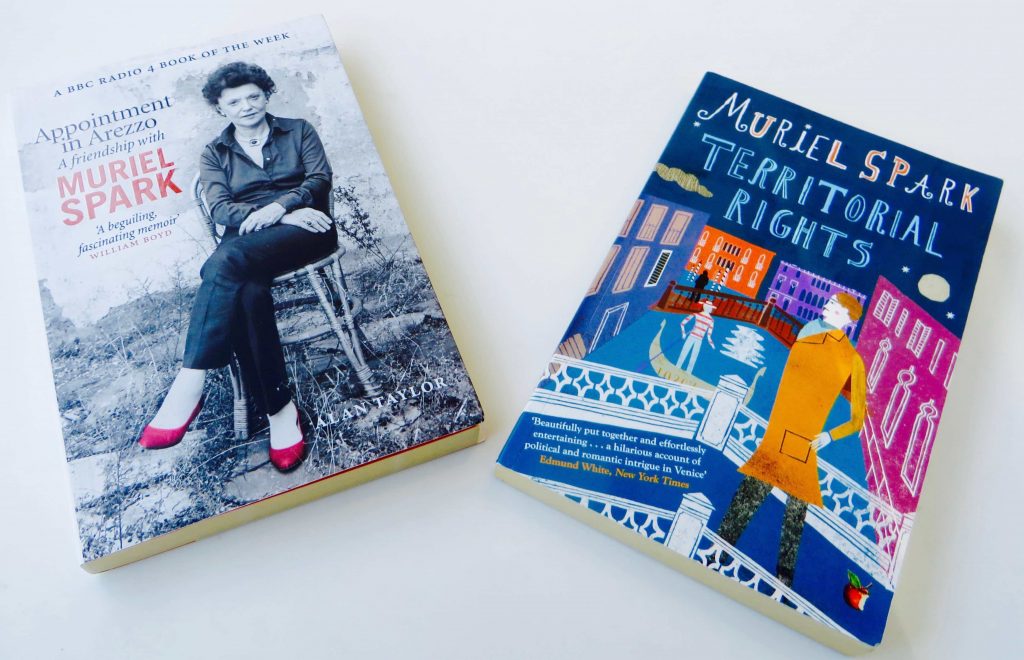
From there I came upon a great find in Waterstones. First published in the U.S. in 2017, ‘Sourdough’, by Robin Sloan, is set in San Francisco and features the Farmers’ Market on the sea front, where I remember sitting outside a great fish restaurant with a steam beer, feeling on top of the world. Sourdough bread is all the rage – now in the U.K. as well – and the author has soared on its wave of publicity. Lois Clary, a software engineer, is bequeathed a sourdough starter, which she, a novice in baking, must keep alive. Shades of ‘Burning Man’ eccentricity, a new life opens up for her in an unexpected way. The Financial Times calls it ‘An enjoyable slice of fiction, wonderfully written and absolutely brilliant’. It sparkles.
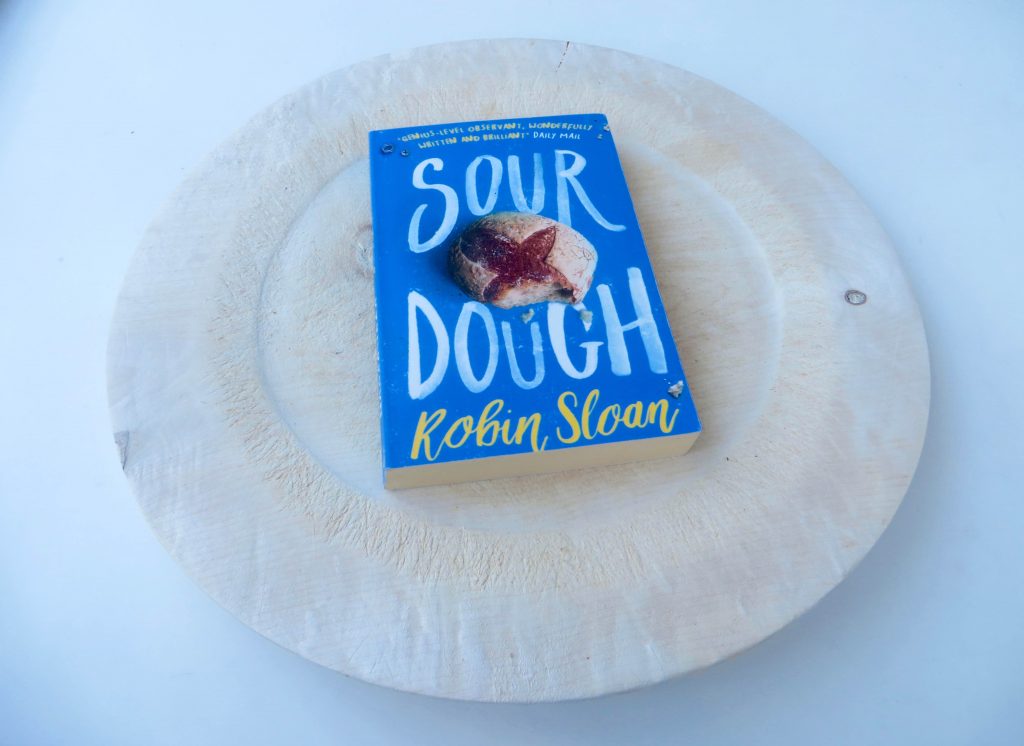
A non-fiction book from that part of the world – but based in Silicon Valley, is ‘Bad Blood’. John Carreyrou is an excellent investagative journalist who tracks down secrets and lies in a Silicon Valley start-up. A scientist becomes obsessed with a new idea and then hides the fact that the technology is flawed. Investors have put in millions of dollars. Carreyrou discovers a huge, corporate fraud. This is an example of the downside in taking risks with new technologies. It’s a fascinating read – quite shocking. It rather confirms my reluctant suspicions about certain people and projects in Silicon Valley. Hi-tech needs to be monitored and regulated. Difficult but necessary in a globalised world. No photo – the jacket is bright red but it’s disappeared … suspicious…
I’m interested in Japanese culture and found two books which really appealed to me. ‘Sweet Bean Paste’ by Durian Sukegawa and ‘Before the coffee gets cold’ by Toshikazu Kawaguchi. Both of these books explore the meaning of individual lives (‘no existence is devoid of meaning’), of the power of friendship, the importance of memories and how the celebration of good food and drink interweaves into our spiritual existence.
‘Sweet Bean Paste’ is a charming, sweet and tender book, using the deliciousness of the sweet bean pancakes to illustrate how unexpected friendships bring happiness to each person and harmony to the world around them, enhanced by the beauty of pink cherry blossom. And yet there will always be dark clouds, bad memories, bad times, challenges to overcome. ‘Poignant, poetic, sensual’ (Lausanne Cités) – ‘This mix of grief and solace, cherry blossoms and red beans is a recipe for happiness’ (Radio SRF 2 Kultur Kompakt). A book to be read when feeling overwhelmed with the modern world. It will ease your worries for a while and give you new insights into what life might mean to you. Much recommended.
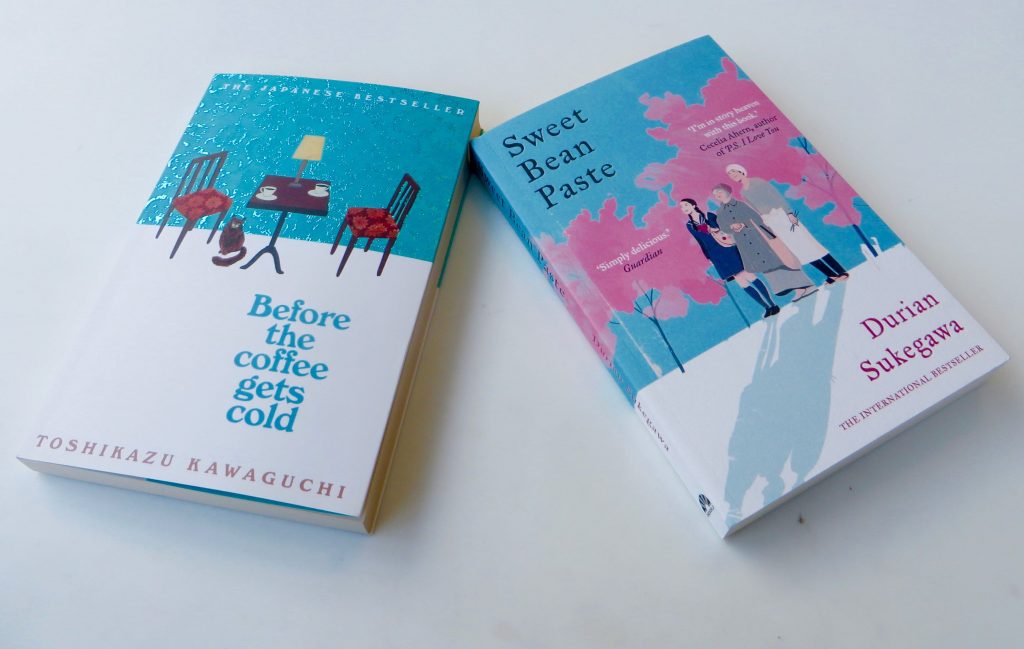
I picked up ‘Before the coffee gets cold’ partly because I liked the cover. It’s very offbeat, set in an old fashioned café and quite mysterious. There are three stories – three different people who wish to find out what the future holds, following things that have happened in the past, which cannot be changed. A chair in the café offers you the possibility to travel back in time but not without risk. And you must return to the present before the coffee gets cold. Mesmerising and extremely thoughtful. It starts slowly but stick with it and you will be rewarded.
Delving back into the past in a different way is a book by Lara Maitlem about the treasures to be found in the mud of the Thames in London. It’s called ‘Mudlarking’ and a mudlark is defined as ‘A person who scavenges for usable debris in the mud of a river or harbour’. I see many ‘mudlarks’ plying their trade along the banks of the Thames and have often thought I would like to join in. The author has spent fifteen years discovering objects from the past that the river throws up on its banks – buckles, pins, pipes, pottery, bottles, coins, sometimes engraved with initials and love knots, examples of which are illustrated on the endpapers of the book. Lara has many stories to tell – a fascinating read.
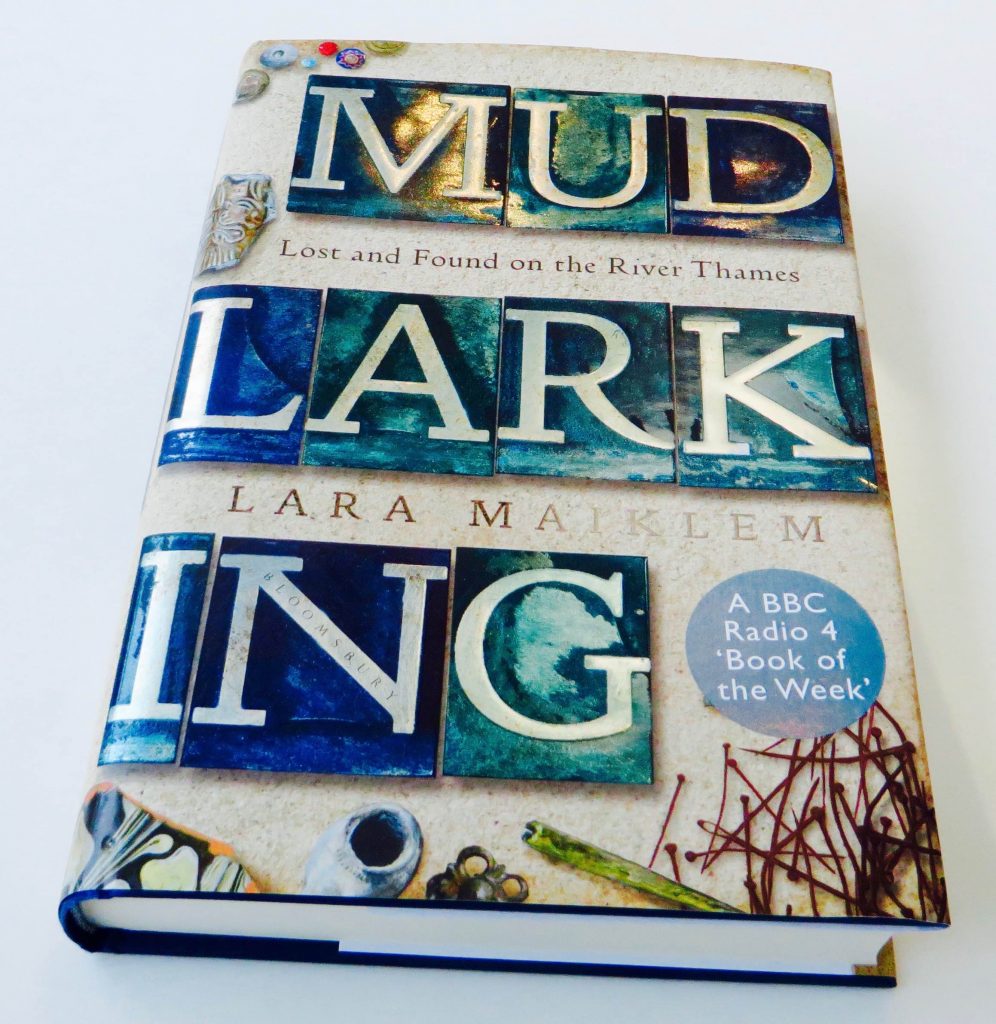
I don’t usually read the books which win the Booker Prize but ‘Hotel du Lac’ by Anita Brookner won it in 1984 and I have enjoyed many of her novels since – so much so that I read this one again recently. It was made into a film, starring Denholm Elliott and Anna Massey in 1986. The Times calls it ‘a smashing love story. It is very romantic. it is also humorous, witty, touching and formidably clever’. Hilary Mantel writes ‘Her technique as a novelist is so sure and so quietly commanding’.
Anita Brookner taught at The Courtauld Institute of Art and wrote twenty four novels. She died in 2016.
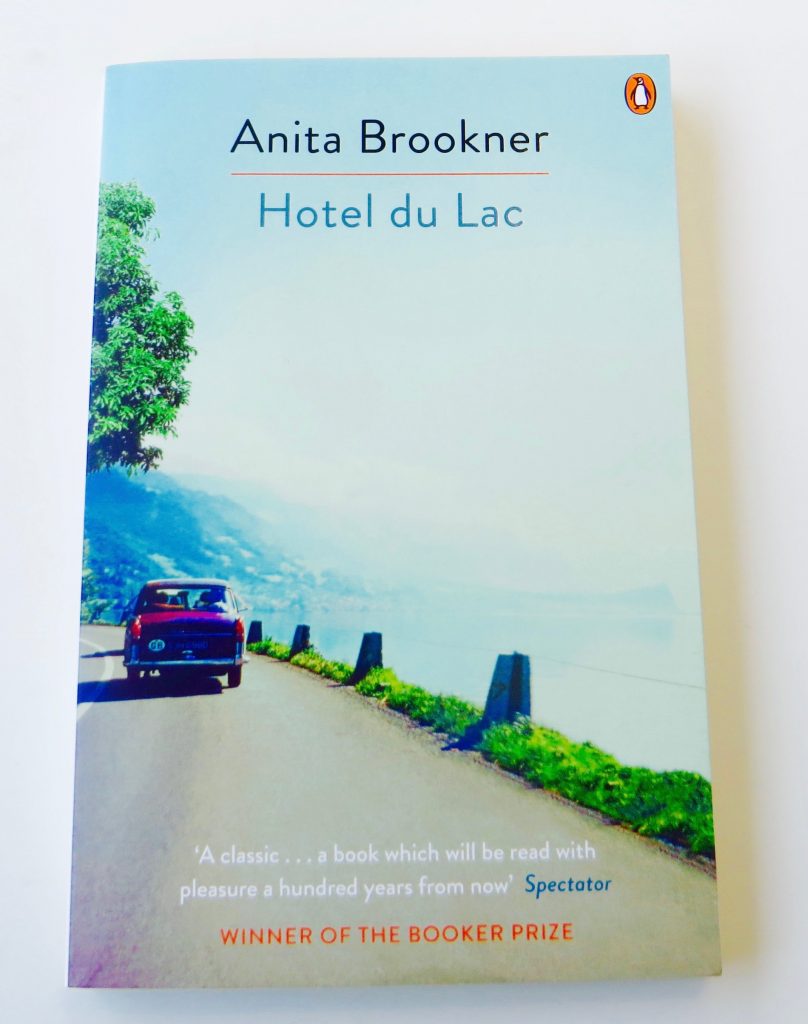
Talking of the merits of re-reading, ‘The Lady Vanishes’ by Ethel Lina White (1876 – 1944) also qualifies but in this case I saw the film on television and then decided to read the reprinting of this book. It was first published in 1936 under the title ‘The Wheel Spins’ and made into a film, entitled ‘The Lady Vanishes’ by Alfred Hitchcock in 1938. It starred Margaret Lockwood, Michael Redgrave and Dame May Whitty. Two further remakes were made.
Ethel Lina White wrote over fifteen mysteries and thrillers, several of which were made into films. She was enormously successful in her day and as well known as Agatha Christie and Dorothy L. Sayers but she fell into obscurity following her sudden death in 1944. The story is about a woman who goes missing on a train travelling through Europe and the tension is kept up until the very last page. The characters are well drawn and I can see why Hitchcock decided to make a film of it – which, in itself, was a great success.

Surprisingly, here is the detective novelist, Agatha Christie writing a very personal diary of the trips with her husband, Max Mallowan, to archaeological sites in Syria, Iraq and Mesopotamia. Fascinating photographs are interwoven throughout the text . I’m really impressed by how she copes with the primitive conditions in the desert. How would I compare if I was woken in the night by mice running over my face, only to struggle to light a lantern which then illuminates hundreds of cockroaches on the walls of what can hardly be called a bedroom. She describes everything with a wonderfully dry wit, and is very ‘beady’ about the local sheiks and their behaviour.
P.D. James writes ‘Agatha Christie has provided entertainment, suspense, and temporary relief from the anxieties and traumas of life both in peace and war for millions throughout the world’. She continues to do so today. Félicitations, Agatha. Very good to read something about your own life!
I’m now turning to contemporary writers. I have always loved Sebastian Faulks’ writing – ‘Birdsong’, ‘Green Dolphin Street’, ‘Charlotte Gray’ – and ‘Paris Echo’ (2018) doesn’t disappoint. If you love Paris, it’s an especially good read. I love the detailed descriptions, for example, of the markets in Paris and in Tangier. Sebastian Faulks is so thoughtful that I feel he must know some of these individuals personally … maybe not. But he pulls out all the stops to deliver a first rate story, balancing his characters between Paris and Morocco – delving both into the past, their daily life in the present and the hopes of Hannah and Tariq for their different futures. Again, a relationship which happens through a chance meeting which in the end fulfils both of them.
‘Trinity'(2018), by Louisa Hall, is extraordinary and mesmerising. It is based on the complex character of J. Robert Oppenheimer – the father of the atomic bomb. The title, ‘Trinity’, is used because ‘Trinity’ was the code name of the first detonation of a nuclear device on 16 July, 1945. It was named by Oppenheimer, who said he was inspired by the poetry of John Donne, (1572 – 1631). Maybe ‘Batter my heart, three person’d God’ …
The author takes seven fictional, separate individuals who fall into Oppenheimer’s orbit at different times of his life in order to unfold the scientist’s very complicated personality. It’s an absolutely riveting read. The ‘New York Times’ pronounced it ‘brilliant’.
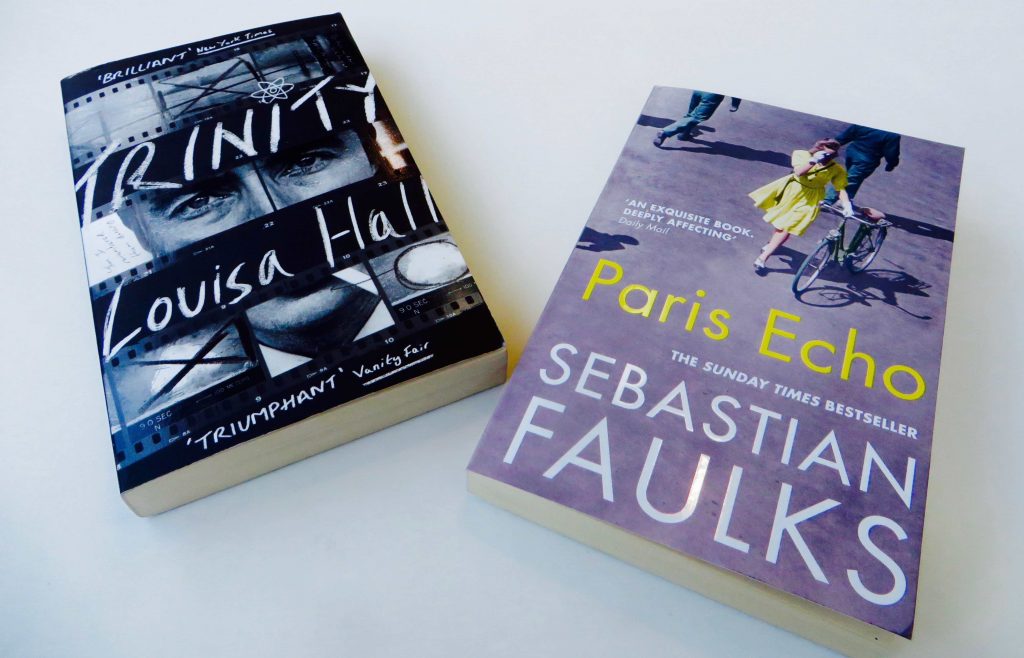
Two other contemporary novels, which I didn’t get on with quite so well. However, it’s good to see what other people like. John suggested ‘Liberation Square’ by Gareth Rubin. John likes ‘what if ‘ books. The Germans have won the war and London is now like Berlin, with a wall down the middle. Everything operates in an atmosphere of fear. I found it a bit muddled but on the whole, a good thriller. It didn’t do much for me though. Just added to the gloom of the present uncertainty in our general lives …
Elizabeth Strout is an acclaimed writer, obviously beloved by many. So I bought ‘Olive Kitteridge’. Somehow, I was reluctant to get into it but then began to really enjoy it, so it clattered along. Over half way, I began to find it so parochial and suffocating, I started to wonder why these people managed to go on living such tedious lives. Poor Olive is tied to a life of negativity because of her personality. I do see myself in a very small part of her (which I must keep extinguishing) – really so glad I wasn’t born Olive. She’s bitter, she’s irritating, she’s tetchy, she’s funny, her character assassinations are brilliant, she relies too much on common sense and can’t help breaking out in kindness and self pity from time to time but she’s also lonely and sad and won’t admit to it. She’s not someone I would like to see often. Too wet blanket, too needy, just tiresome. But still, I sympathise with her lot in life. Will I buy the new book, ‘Olive Again’? I’m curious but life is short, so I’m not sure. Elizabeth Strout does hit the nail on the head though. Ouch!
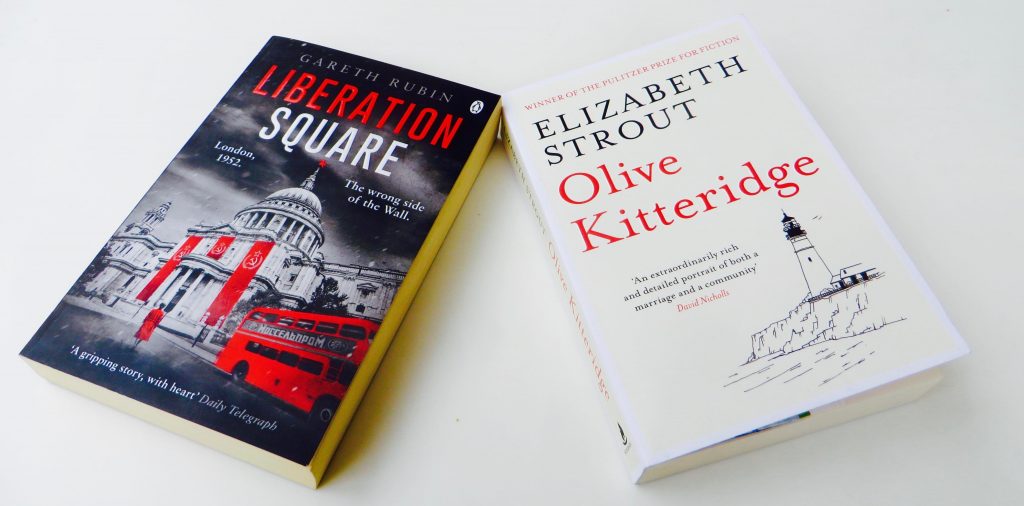
What I needed now was some tales of derring-do. An old fashioned phrase, stirring up memories of Hammond Innes and Alistair MacLean. Vintage have re-issued some of Hammond Innes’s thrillers – and I landed up with ‘The Lonely Skier'(1948). He dedicates the book to a friend, Peter Wilson, saying he hopes it will recall pleasant memories of places visited together. The setting is the Dolomites. This is a thriller at the top of its game – a great book to read either while travelling or tucked up in bed. Satisfaction guaranteed!
In 1975, Frederick Forsyth wrote a novella, Called ‘The Shepherd’. He’s not a writer I know well, although a film (1973) was made of his book, ‘The Day of the Jackal'(1971), starring Edward Fox, which was a massive success. The film was absolutely riveting but I don’t believe I ever read the book. I should. My father-in-law, who was in the RAF, died last year, aged 98. ‘The Shepherd’ has a picture of an RAF brooch on the front cover, which men gave to their sweethearts as they left for war. I had bought two of those for my daughters as mementoes of their grandfather. So I picked up ‘The Shepherd’ out of curiosity. It’s Christmas Eve 1957 and a pilot is flying home solo, on leave from Germany – a simple sixty six minutes of flying time. Things go wrong. It’s a miniature masterpiece. Tense, spooky, stirring and beautiful. I loved it.

I’ve just found a book which incorporates both travel and history in Europe. It’s called ‘Lotharingia’, by Simon Winder. Judith Flanders says ‘He has created a genre all of his own, the history-travelogue memoir’. It sounds just up my street!
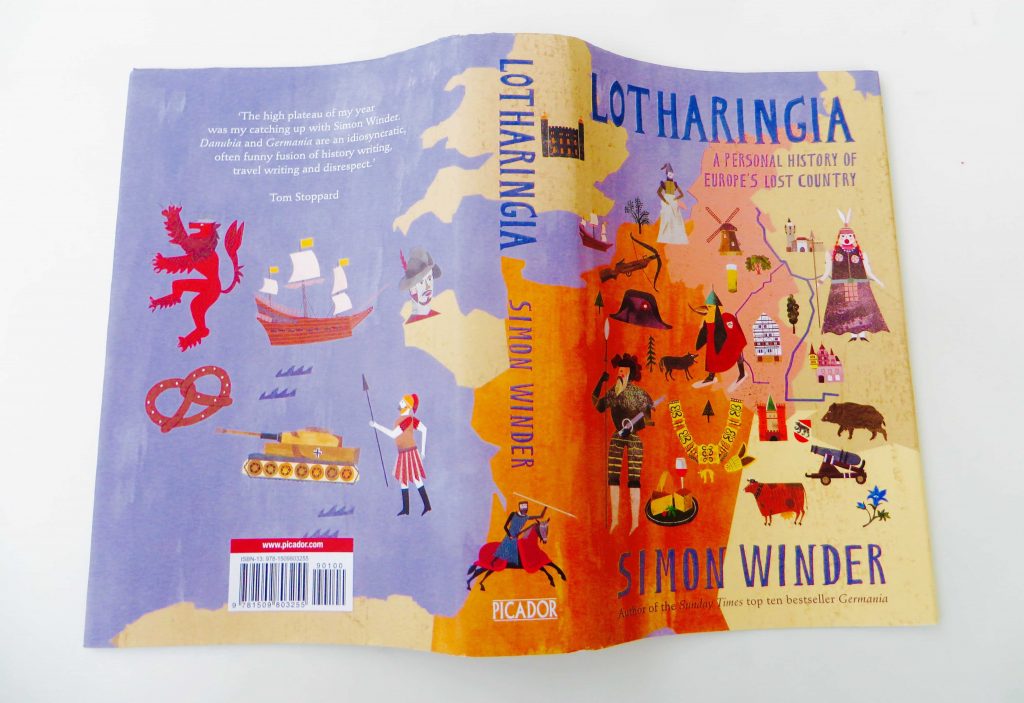
Art books by Taschen are fantastic and always a great gift to receive. I’ve been dipping into ‘What Great Paintings Say – 100 Masterpieces in Detail’. Alongside it, I’ve been reading ‘The Art of Rivalry’ by Sebastian Smee. He takes Manet vs Degas, Picasso vs Matisse and De Kooning vs. Pollock. This writer really knows his stuff and uncovers so much personal detail of each artist. This is rivalry that stems from admiration and friendship. It’s an illuminating and rewarding book.
‘The Secret Lives of Colour’ by Kassia St Clair is beautifully presented. It’s also packed full of information with fascinating stories about each colour. I’m besotted by colour and this is such a treasure trove. ‘A vivid, whirlwind tour through the rainbow’ says The Wall Street Journal. These are all books which reside by my bedside. Dippers!
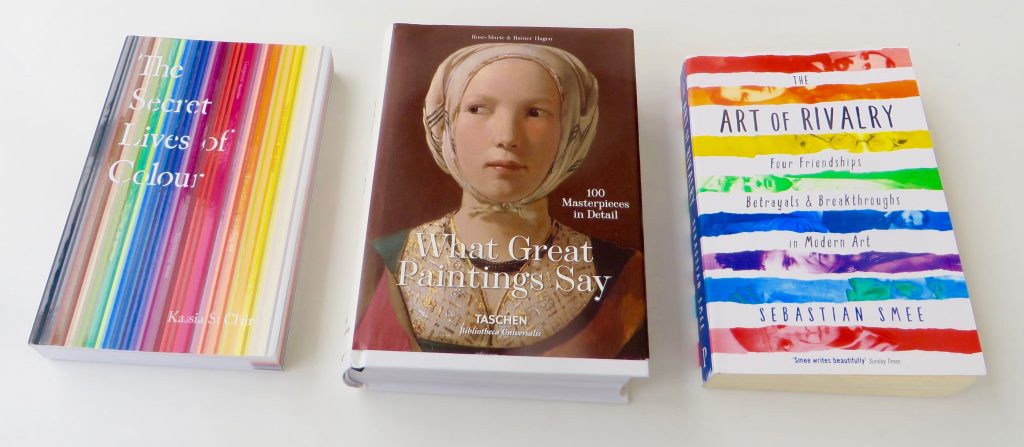
I love Alexander McCall Smith. I bought his new book of short stories, ‘Pianos and Flowers’, inspired by old photos which he has come upon randomly – he doesn’t know the people in them but has created stories around the images. There are fourteen stories from all over the world concerning love, friendship, happiness and how chance and serendipity play a part in changing lives. ‘McCall Smith’s generous writing and dry humor, his gentleness and humanity, and his ability to evoke a place and a set of characters without caricature or condescension have endeared his books to readers’ – (New York Times) . He’s a lovely man in real life too!
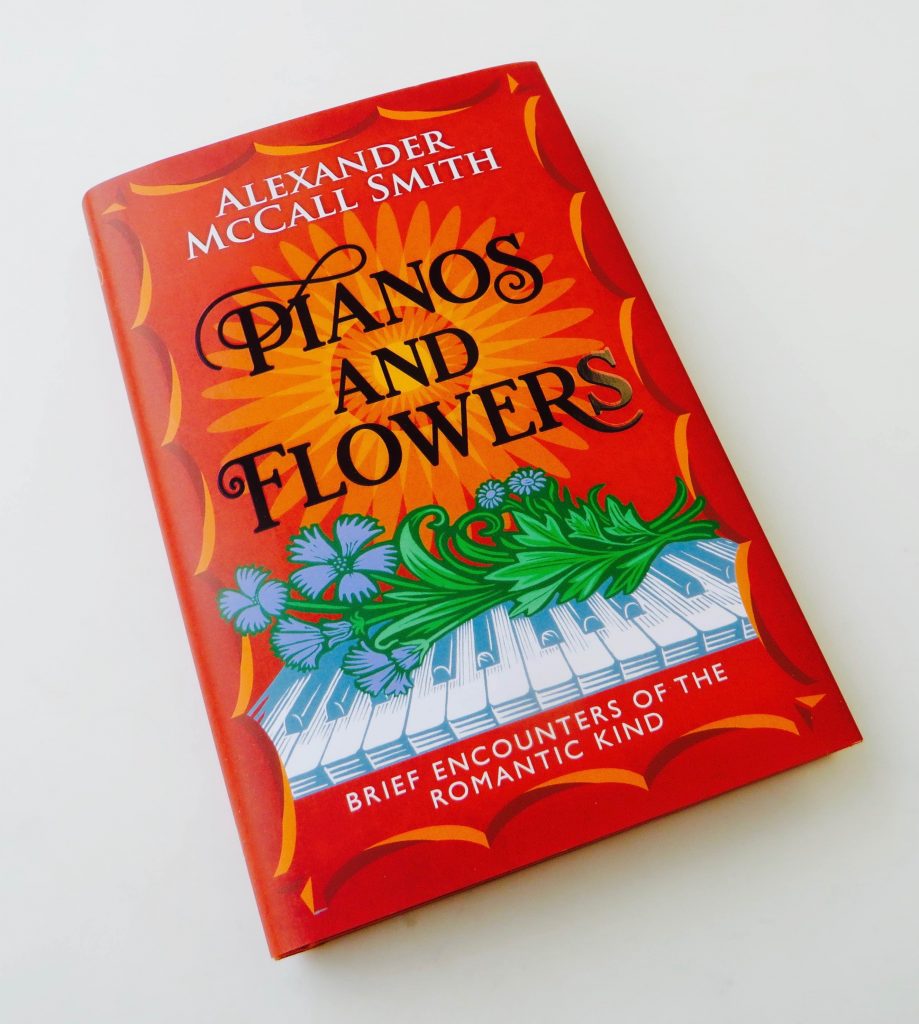
And now a cracker of a book, bought by John and definitely in my top three reads of the year. It is a non-fiction, historical account of The British Plot to Bring America into the Second World War and stars two unlikely heroes, Bill Stephenson and Bill Donovan. It really is a sensational piece of writing, entitled ‘Our Man in New York’ by Henry Hemming. There is praise from Ben MacIntyre, William Boyd, Max Hastings, ‘The Guardian’ and many other newspapers and journals. I couldn’t put it down. Those two men did so much for us all.
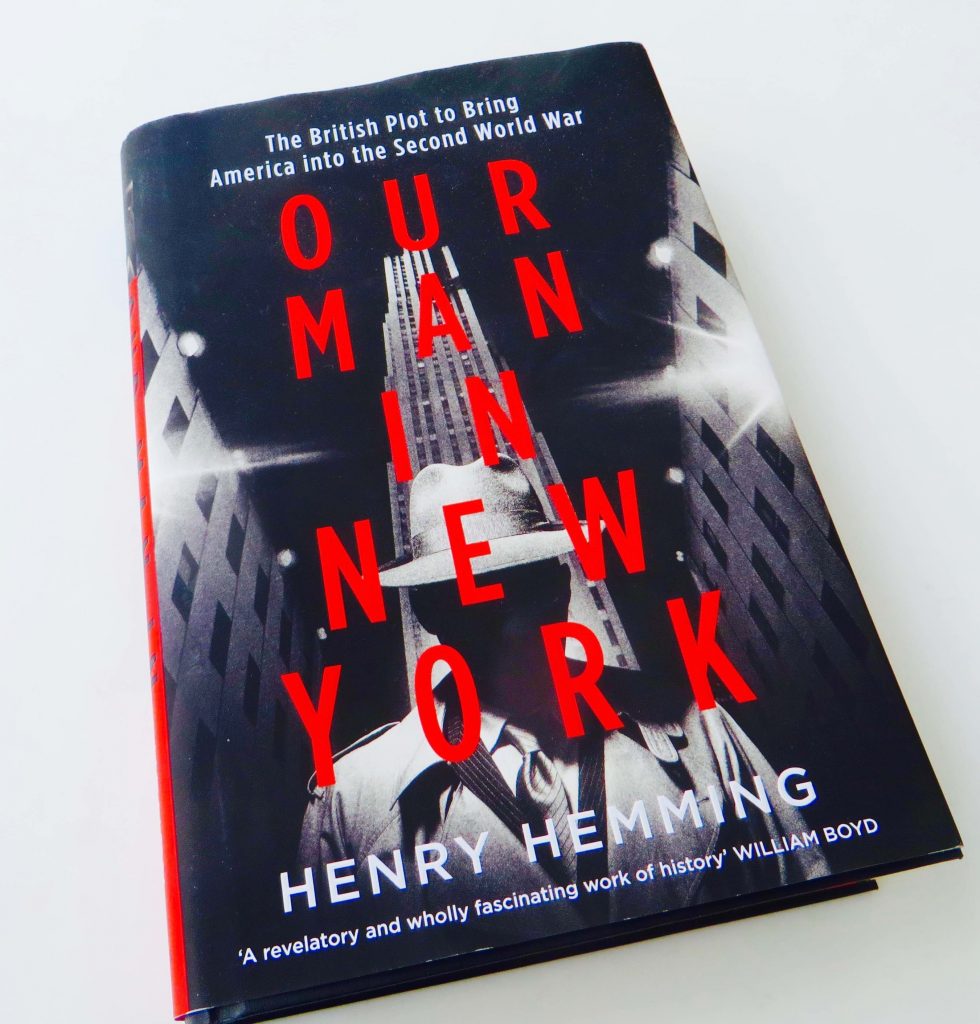
I finished up with a book advertised enormously in advance and very well worth the wait for! This is one of my favourite writers. ‘The Body – A Guide for Occupants’, by the illimitable Bill Bryson. Besides his brilliantly entertaining travelogues, he is also a mine of information about life in general. If you enjoyed ‘A Short History of Nearly Everything’, you should read ‘The Body’ too. His erudition is lightly worn and he has the enviable gift for explaining the most difficult subjects in the clearest possible way, spicing his writing with a dry sense of humour, often against himself. This is a book to return to. Like a knowledgable and engaging friend, you will always find something new and inspiring to discuss. I am always curious to learn, so this book is perfect company.
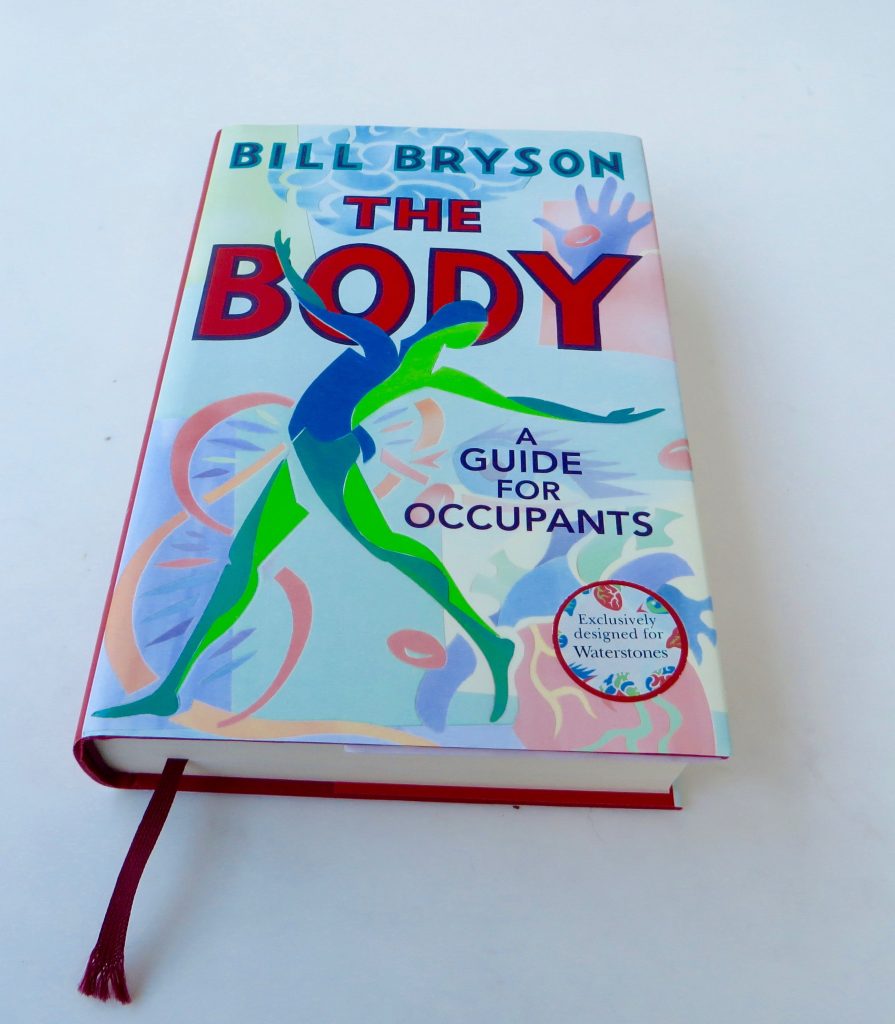
This has been a great year for books. I am happy, as I love reading, love bookshops and long may they continue to give us such pleasure. As you may have guessed, I am not an Amazon fan. Waterstones and Hatchards in Piccadilly are my stamping grounds – good cafés within at Waterstones, meaning I can always stay that little bit longer …
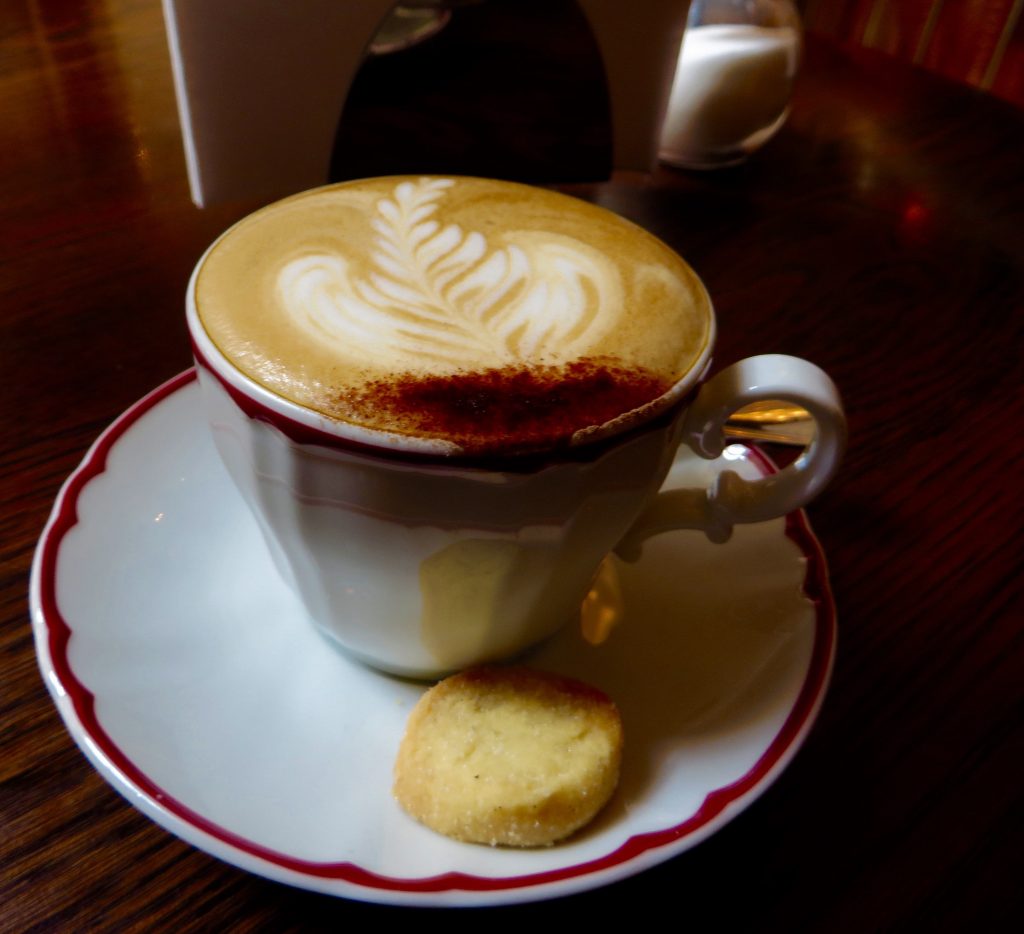
So often, Christmas Day is disappointing weather wise. But in 2019 it was beautiful – no snow, which would also have looked beautiful, but bright sunshine in a blue bowl of sky.

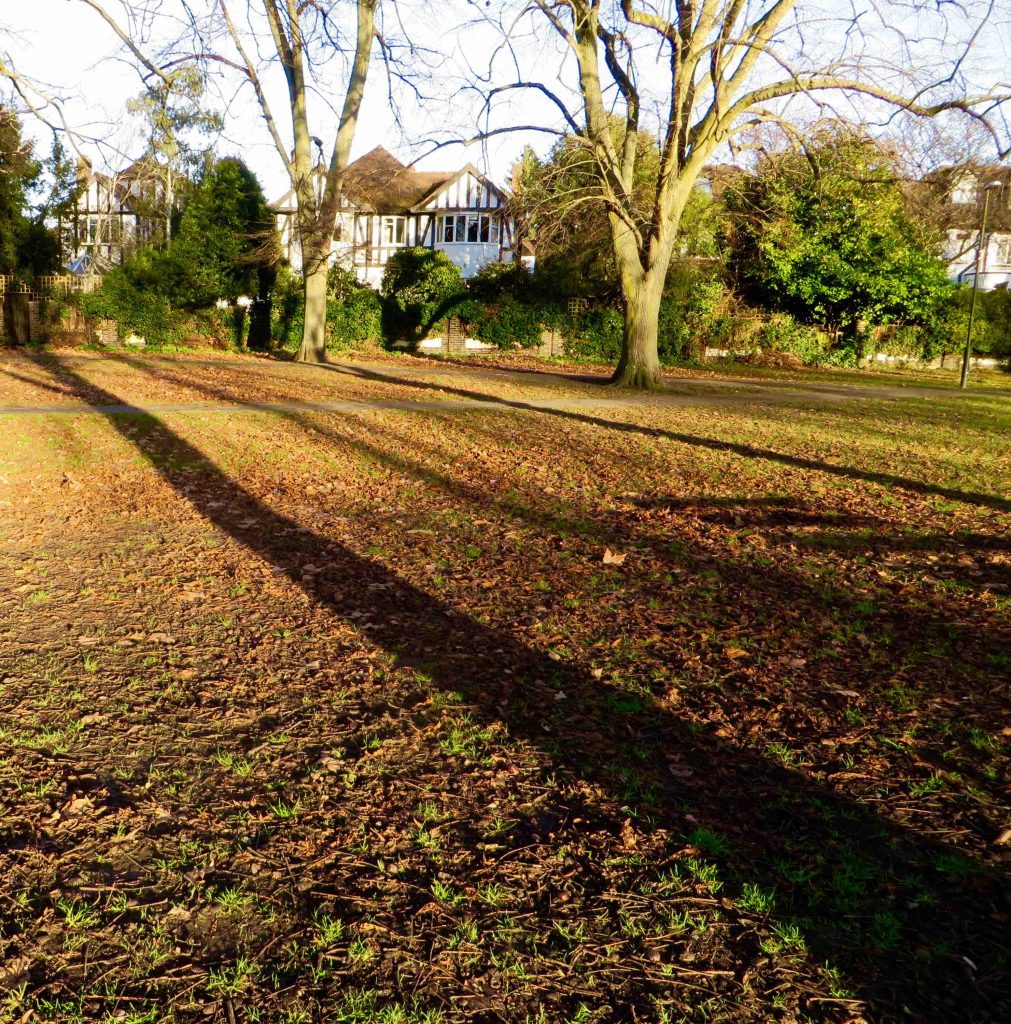
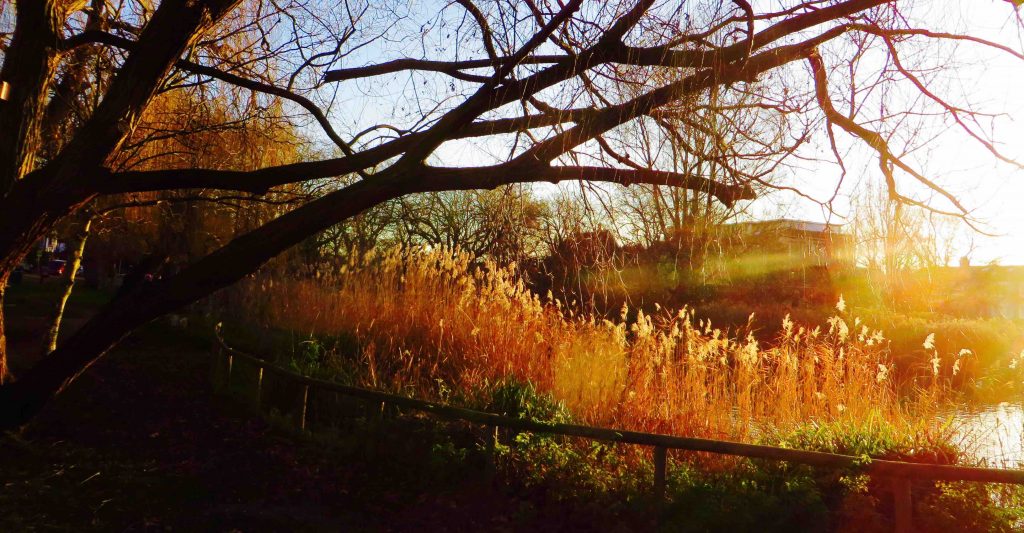
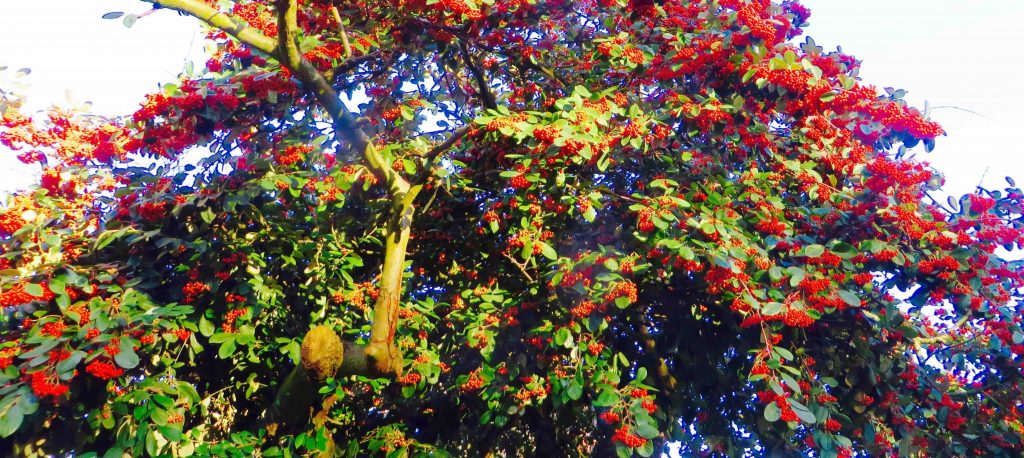
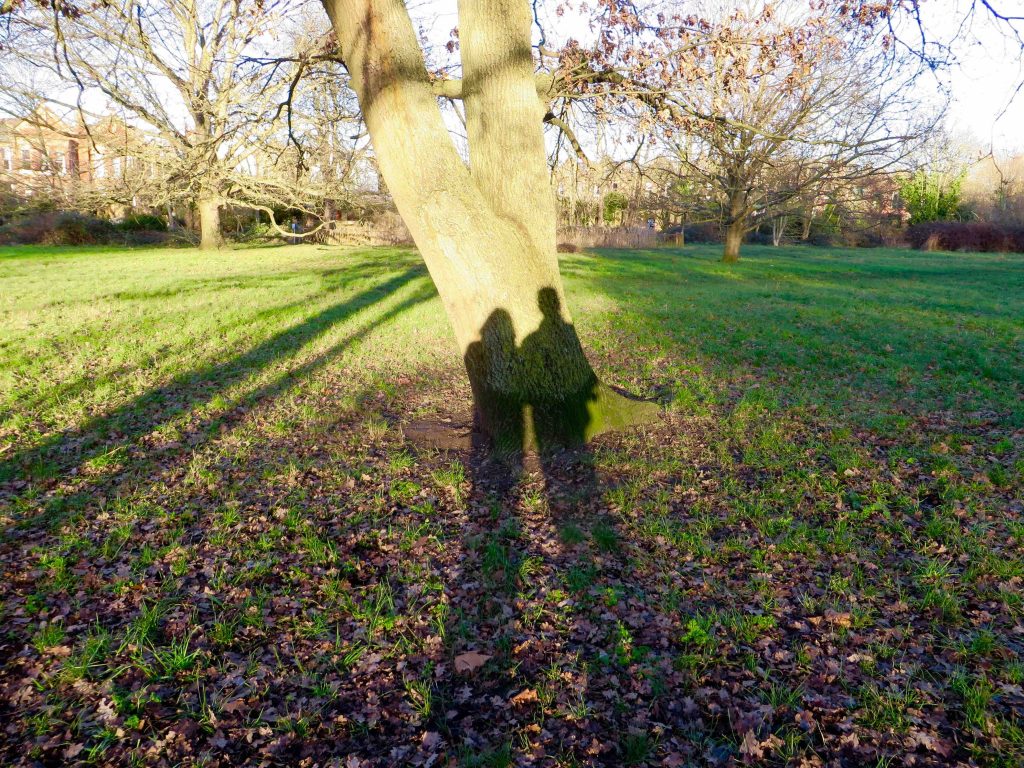
On our way across the Common we passed the giant tree, which reminded us of a heartbreaking accident.

Iris Goldsmith died, aged fifteen, on the 8th of July, 2019. An all terrain vehicle that she was driving over fields at the family home tipped over and trapped her. She was a lovely person and very special to all her friends, who have made a ‘shrine’ at Iris’s favourite tree on Barnes Common.
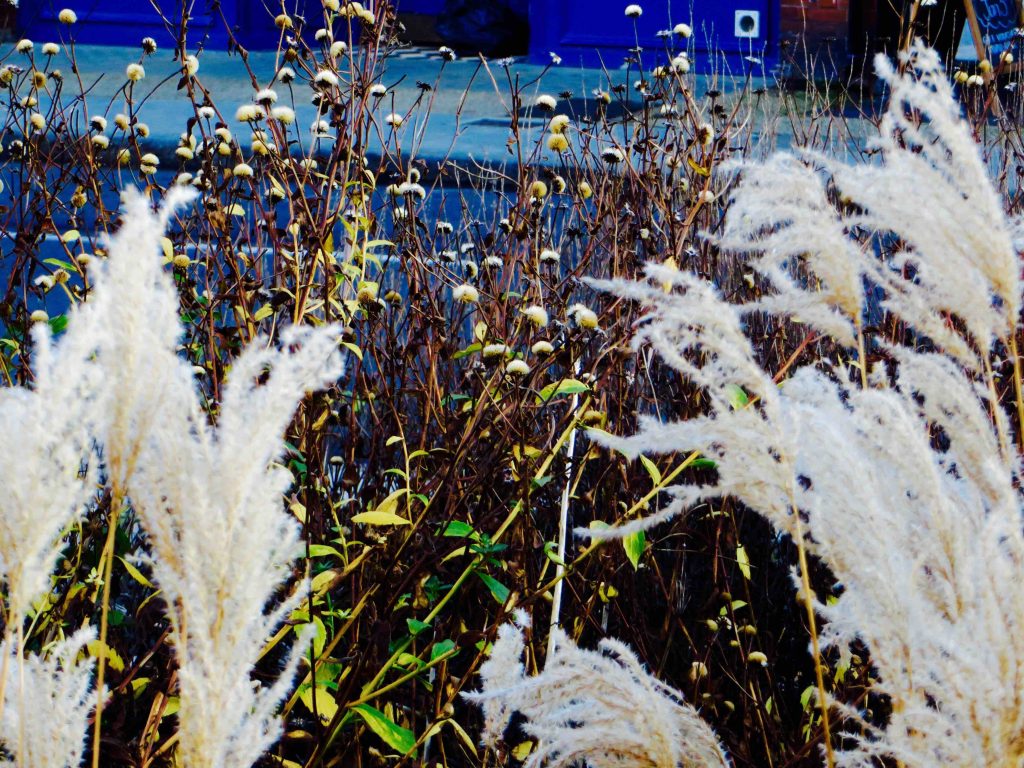
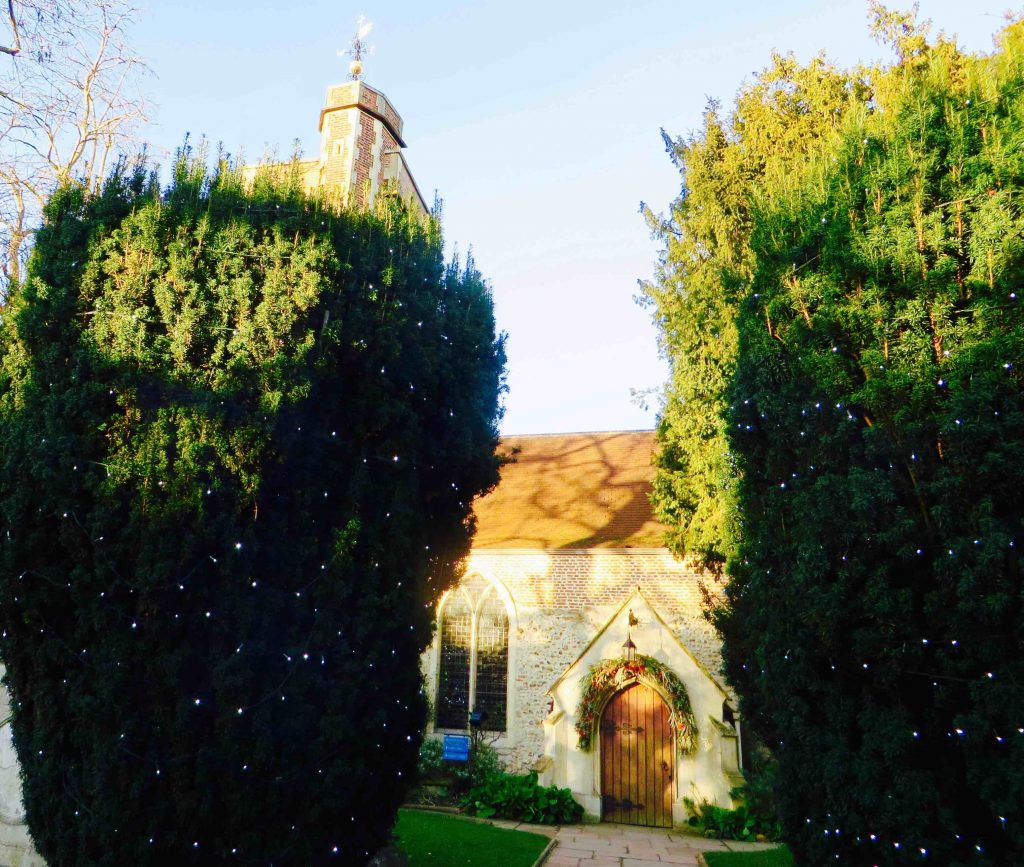

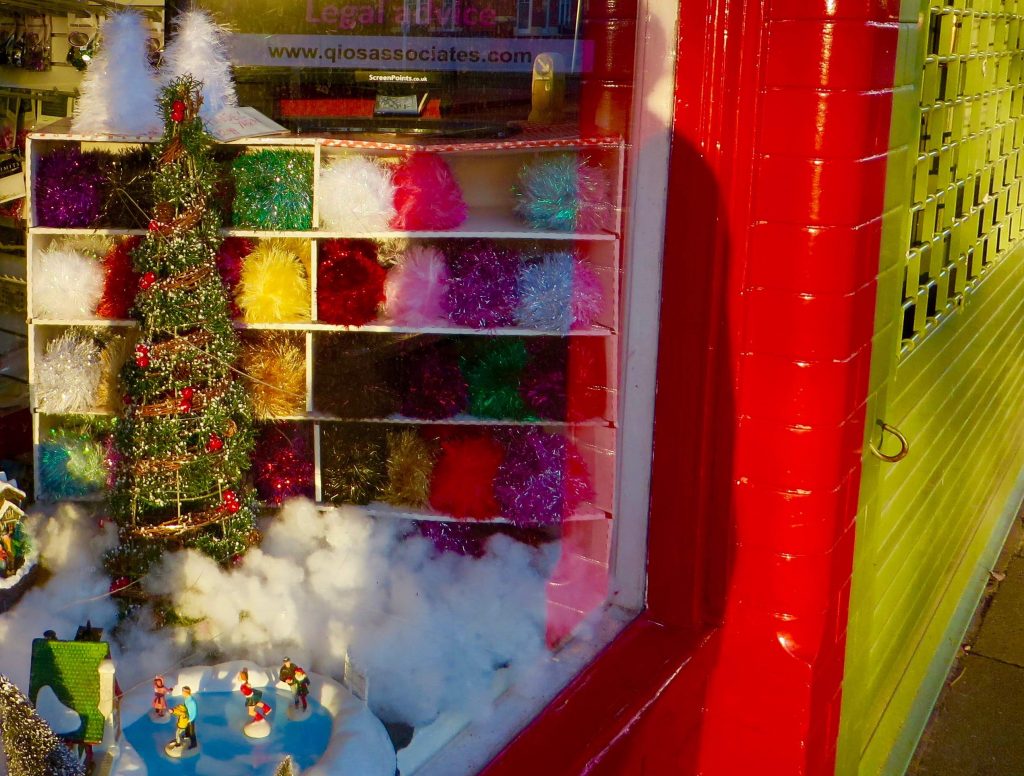
We are lucky enough to have an independent bookshop in Barnes as well as an independent cinema – ‘The Olympic’.
The Barnes Wetlands were created out of four old reservoirs, which were ‘places of scientific interest’. The wetlands are bringing wildlife and the countryside into the city. You are welcomed at the entrance by a wonderful sculpture, created by Nicola Godden of Peter Scott, who created the bird sanctuary at Slimbridge in Gloucestershire, encouraging similar ones across the country to be set up.
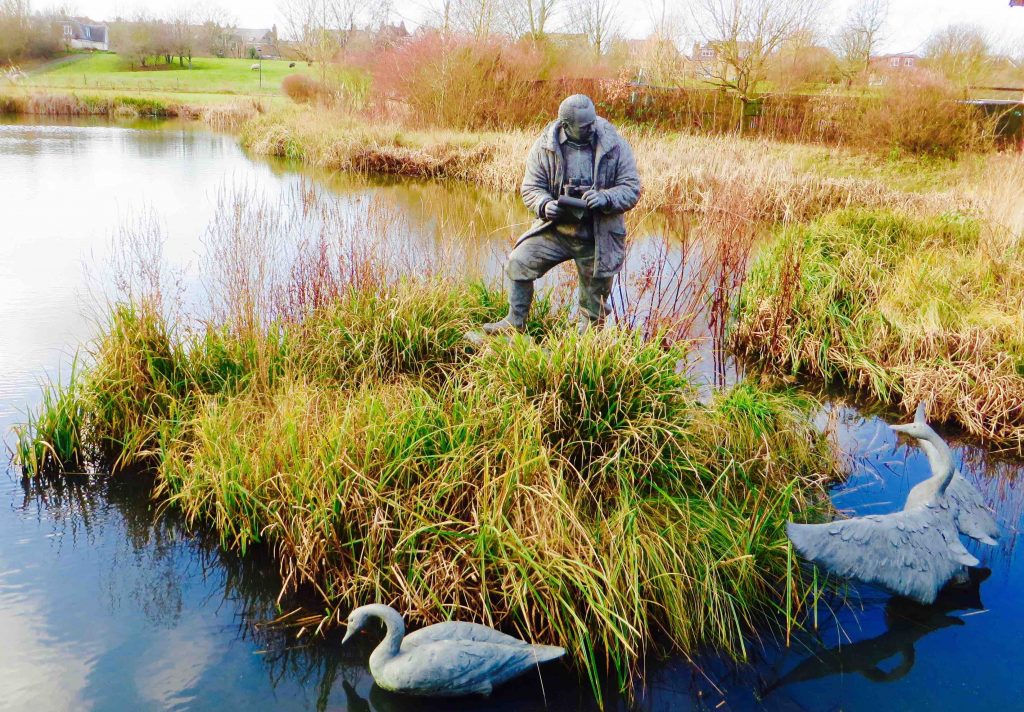
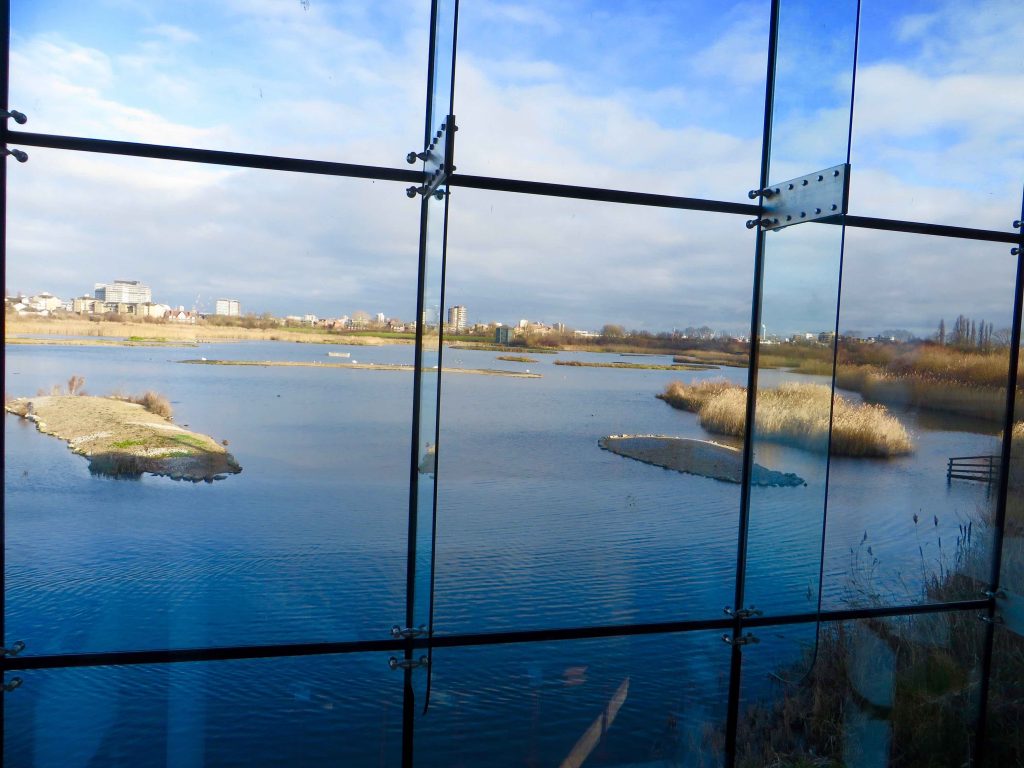
Many migrating birds stop off here – as well as local ones.
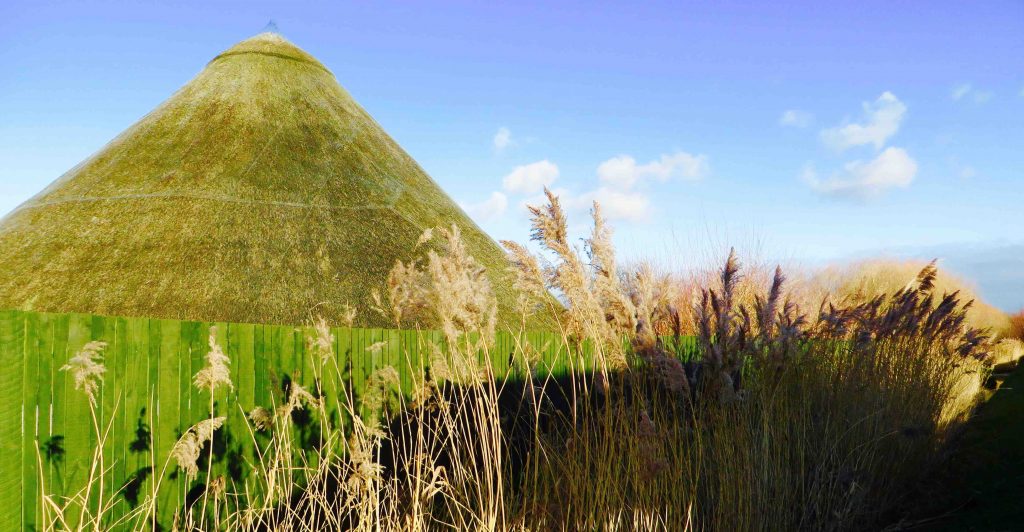
This is a great place on our doorstep, both for adults and children. Besides the wetlands themselves, there is a bird observatory, a café and a shop. And a big car park, although it’s also easy to get here from Central London on public transport.


I can’t help thinking that a glamorous dress along these lines would make people gasp at the Oscars.
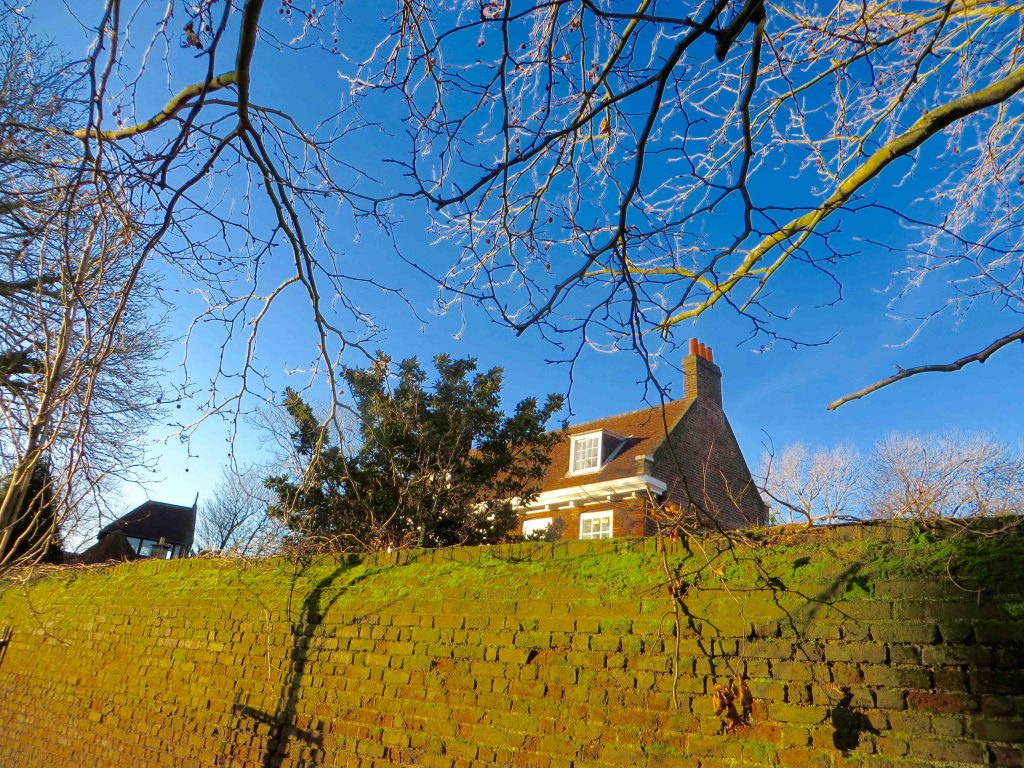
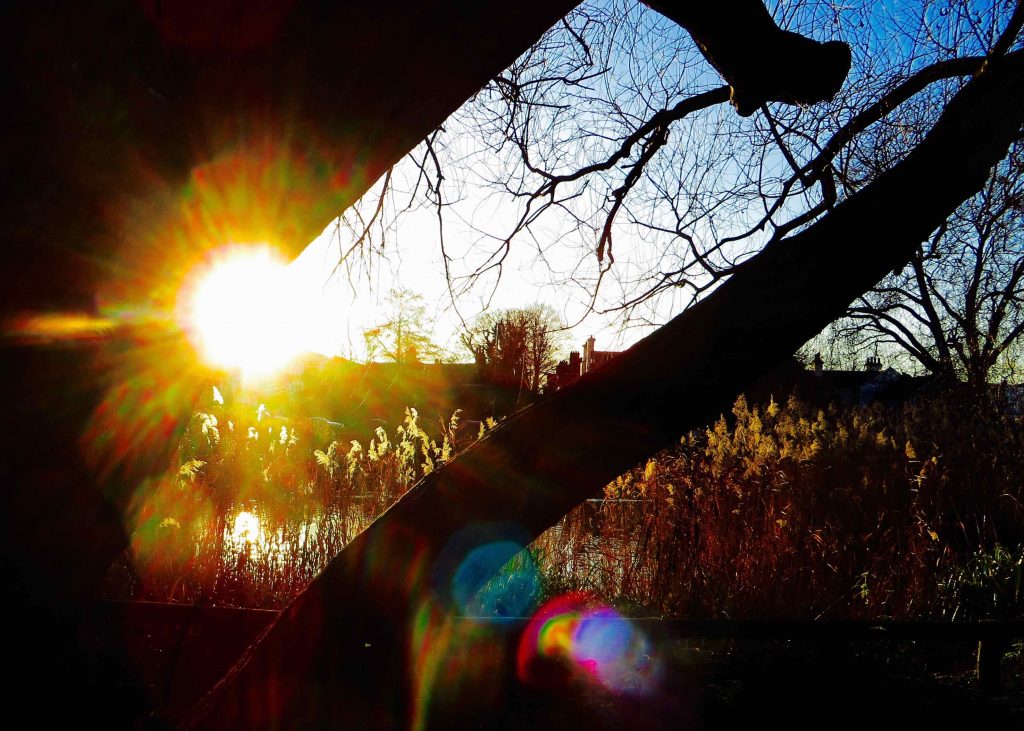
END
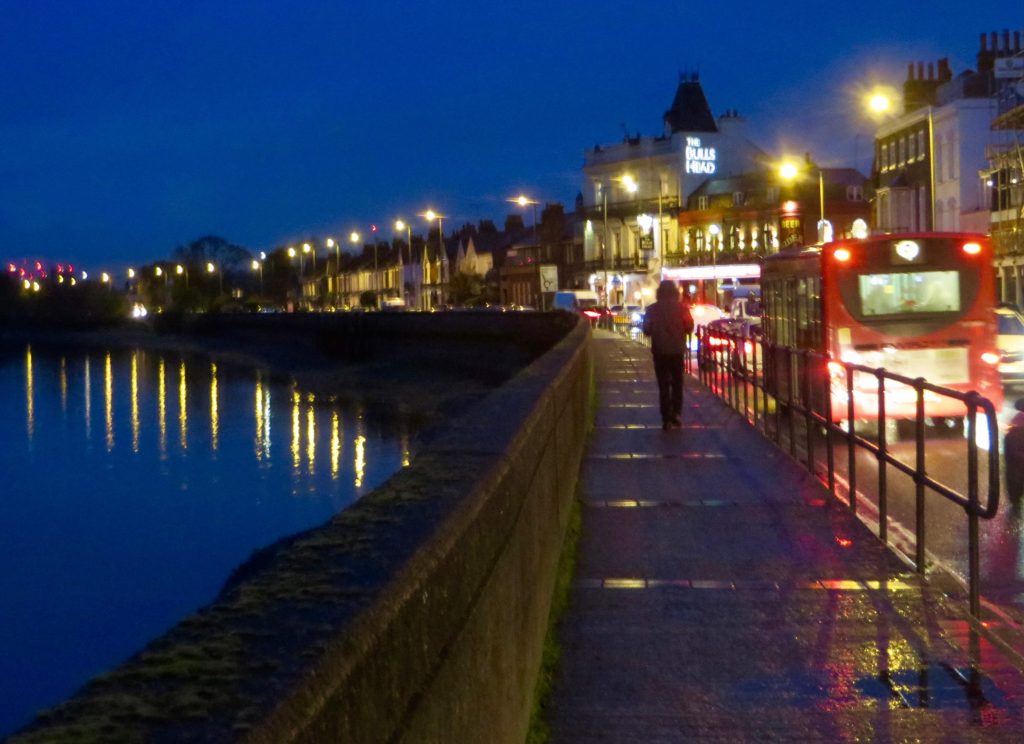
It’s late afternoon at the end of November. I just got off the bus which is continuing up river. Van Gogh’s painting ‘Starry Night over the Rhône’ comes to mind as I contemplate the reflections of the street lamps over the water.
What shall I make for supper?
Bridget Riley is best known for her eye wrenching optical illusion art in the 1960s – much of it in black and white. The idea spilled over into clothes, some designed by Mary Quant. I still have something from that time in my wardrobe – I must have been so slim, it was so easy to wear geometrical patterns which hung perfectly ‘spot on’ in 360 degrees/3D!
A friend wanted to go and see the ‘Retrospective’ at the Hayward and it is impressive. However, if you are prone to migraines, I don’t recommend it – my eyes went into a mix of Marty Feldman’s in ‘Young Frankenstein’ and those of the lorry driver in ‘Men in Black’. I felt peculiar, I looked slightly discombobulated. The paintings are decidedly unsettling in that they antagonise your eye at the same time as being quite geometrically perfect in their execution. It was interesting to see how Bridget Riley arrived at this quite extraordinary way of looking at things.
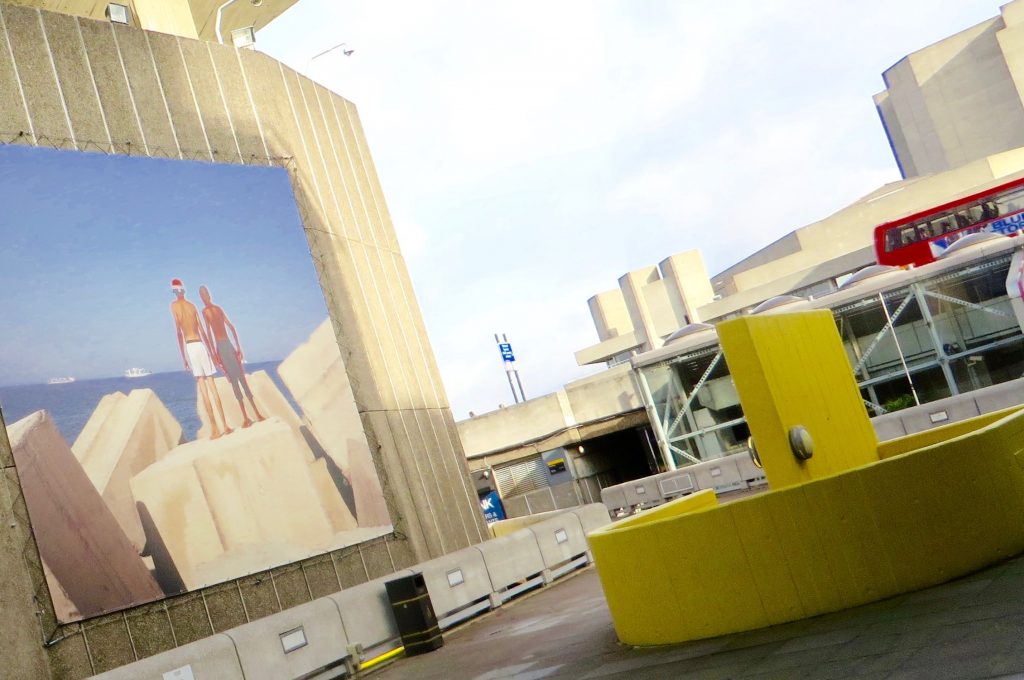
Bridget Riley was partly inspired by Seurat and pointillism. I had always thought of her as being more inclined to black and white but Seurat was fascinated by how colours reacted with one another. For example, red with green, yellow or orange with blue. I can almost taste the way they interact. And in this exhibition you can see how BR was exploring this too.
Seurat was very much influenced by Chevreul, who was a chemist. Chevreul noticed how a colour was influenced by the colours it was next to when he was director of the Gobelins Tapestry dye works in Paris. Seurat, for example, puts dots or small dashes of colour next to one another in many of his paintings but at the same time creating a figurative rather than an abstract painting. Later on, Matisse was also inspired by this way of using colours together. His cutouts illustrate this. But back to Bridget Riley …
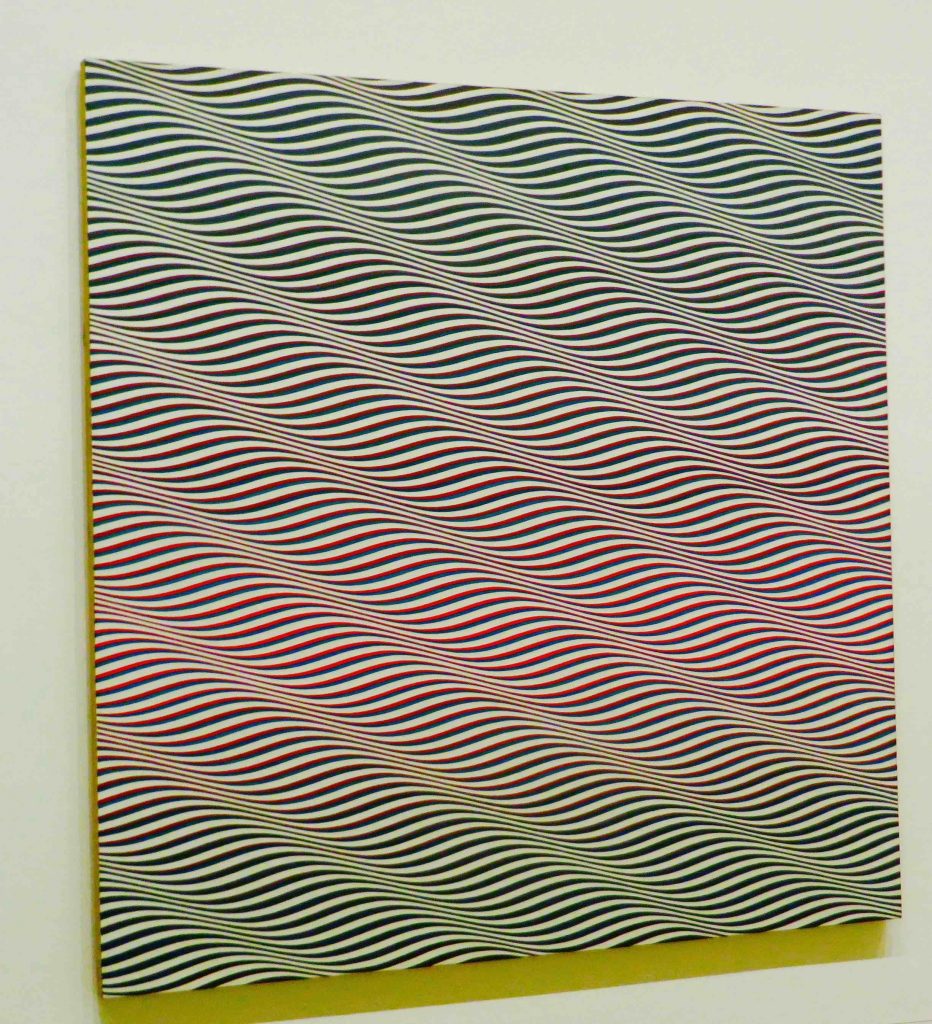

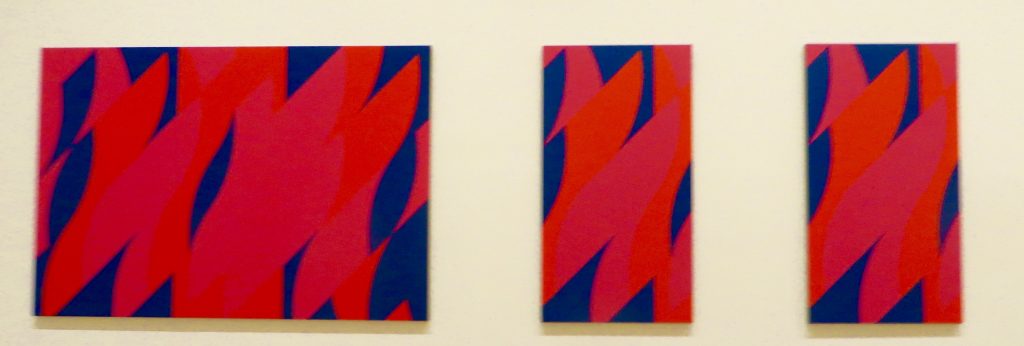
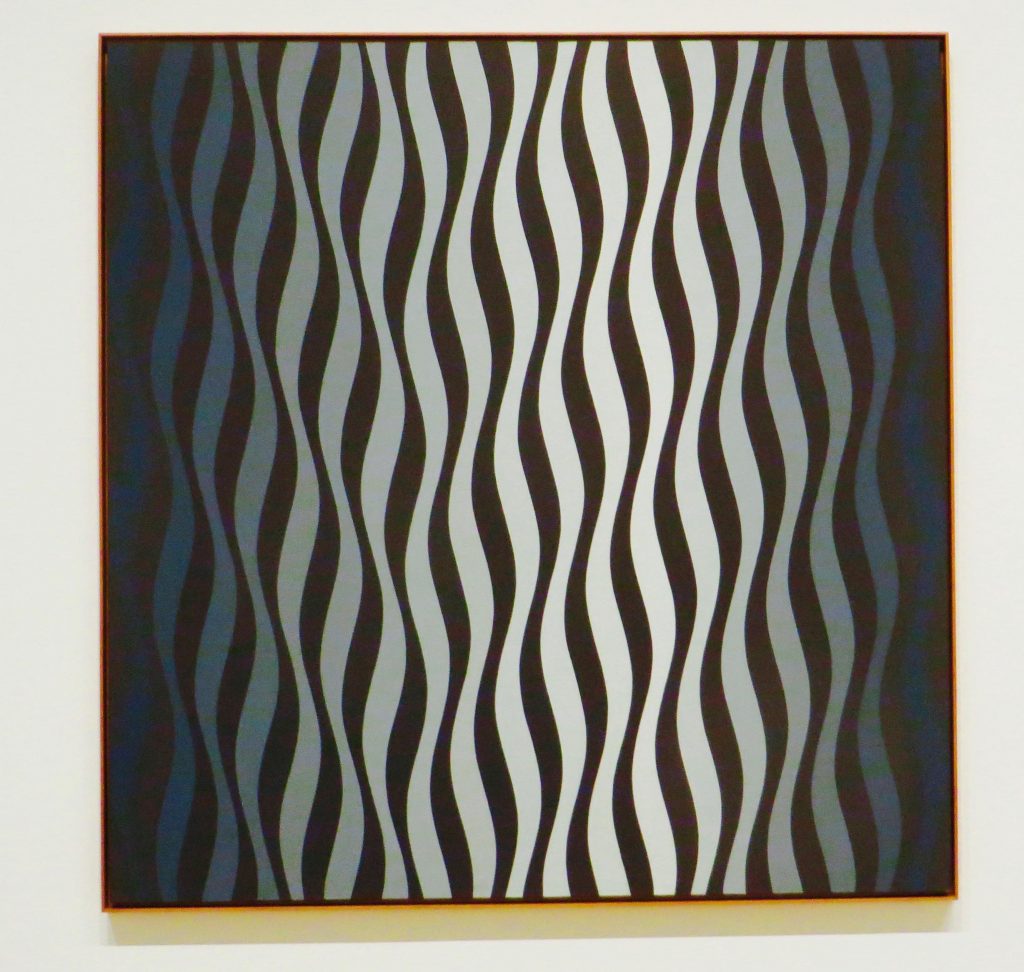
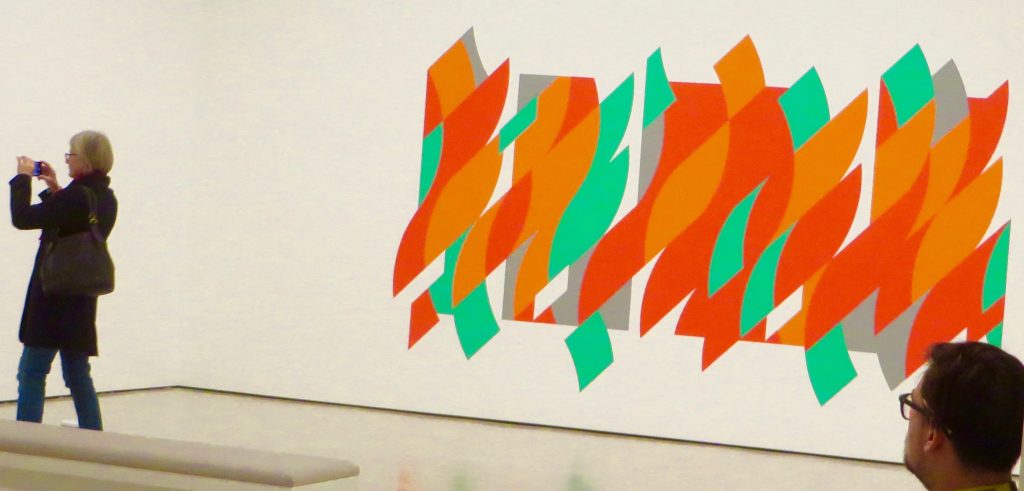
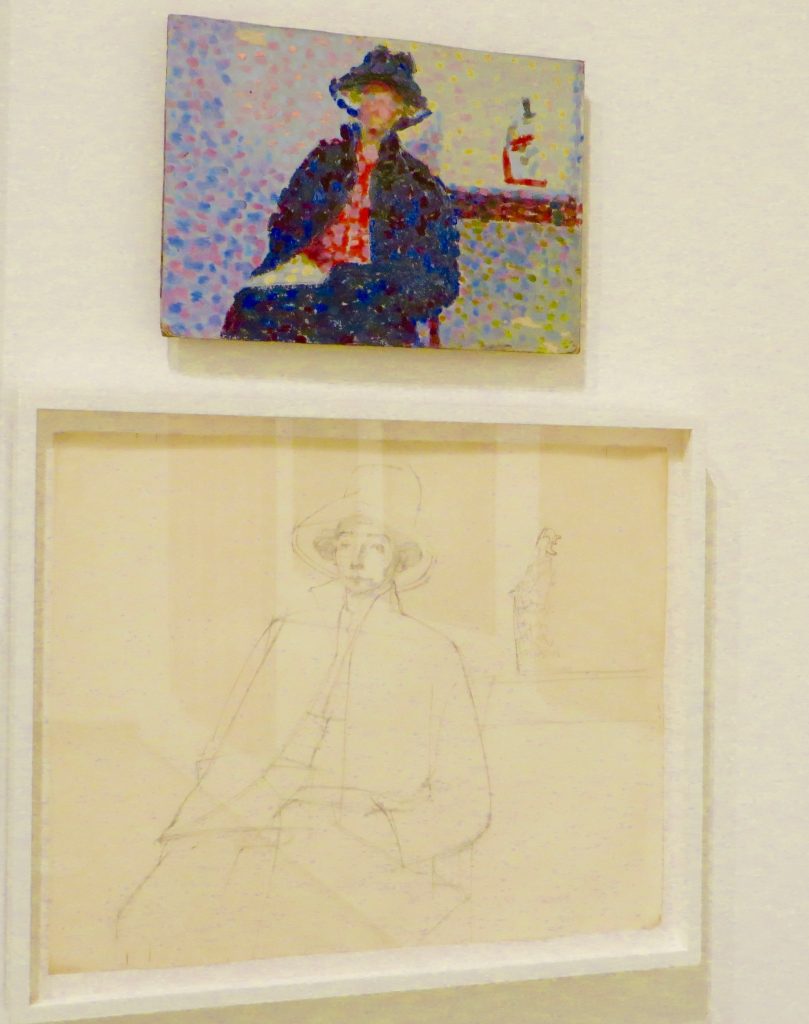
During his long life – he lived to age 102 – Chevreul came up with the idea of a ‘colour wheel’. This study of how colours interact had a great influence on art – especially with the Impressionists. Appropriately, given his long life, Chevreul also studied gerontology – the effects of aging – he was a chemist but came from a medical background. As a polymath, Chevreul managed to explore the intertwining of arts and science – he is only one of 73 people to have his name inscribed on the Eiffel Tower in Paris and truly deserves to be remembered for his many sided contribution to the understanding of the science that lies behind our feelings and emotions.
Personally I prefer the pointillist lady with a hat to the abstract display of colours below – but both paintings are experimenting with the interaction of different colours – it’s just that one seems human and the other seems robotic – one is imaginative and the other is digital … and yet they are both employing the effects of what Chevreul captured in his ‘colour wheel’.
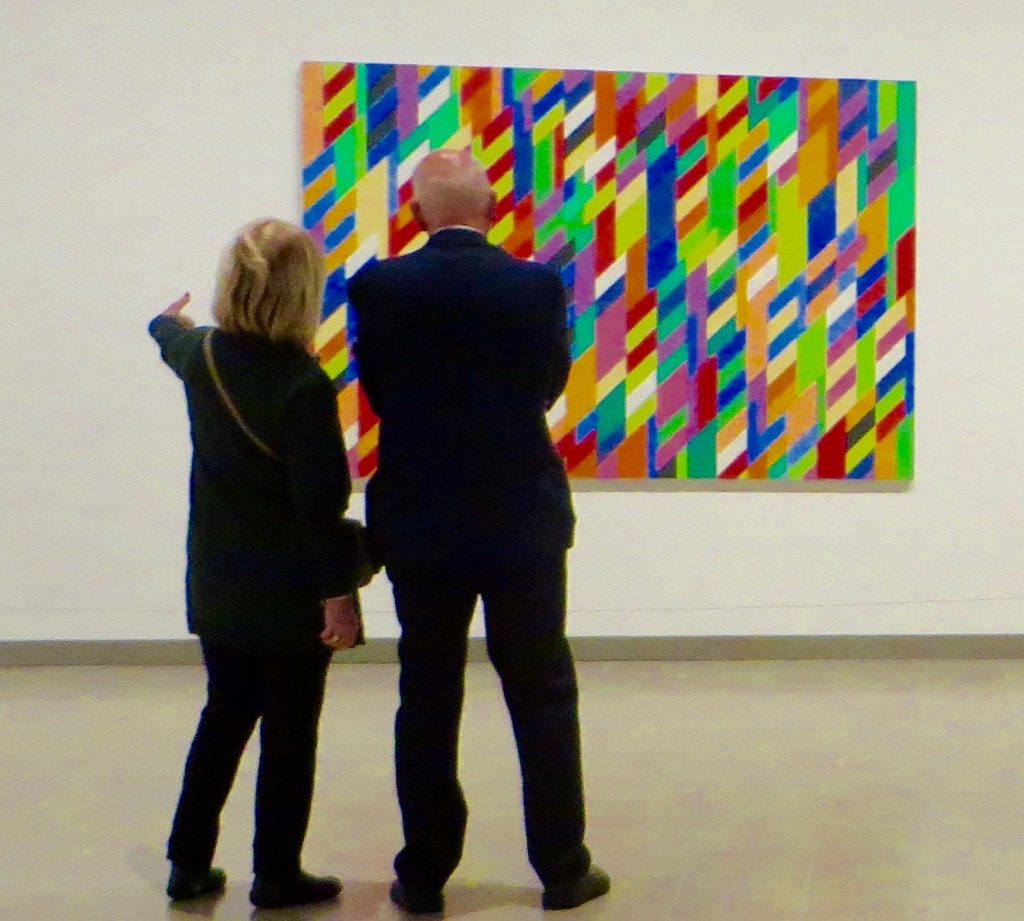
Bridget Riley shows how experimental she herself is. If you had asked me to guess who had painted the picture below, I would have opted for a Scottish colourist like Cadell.
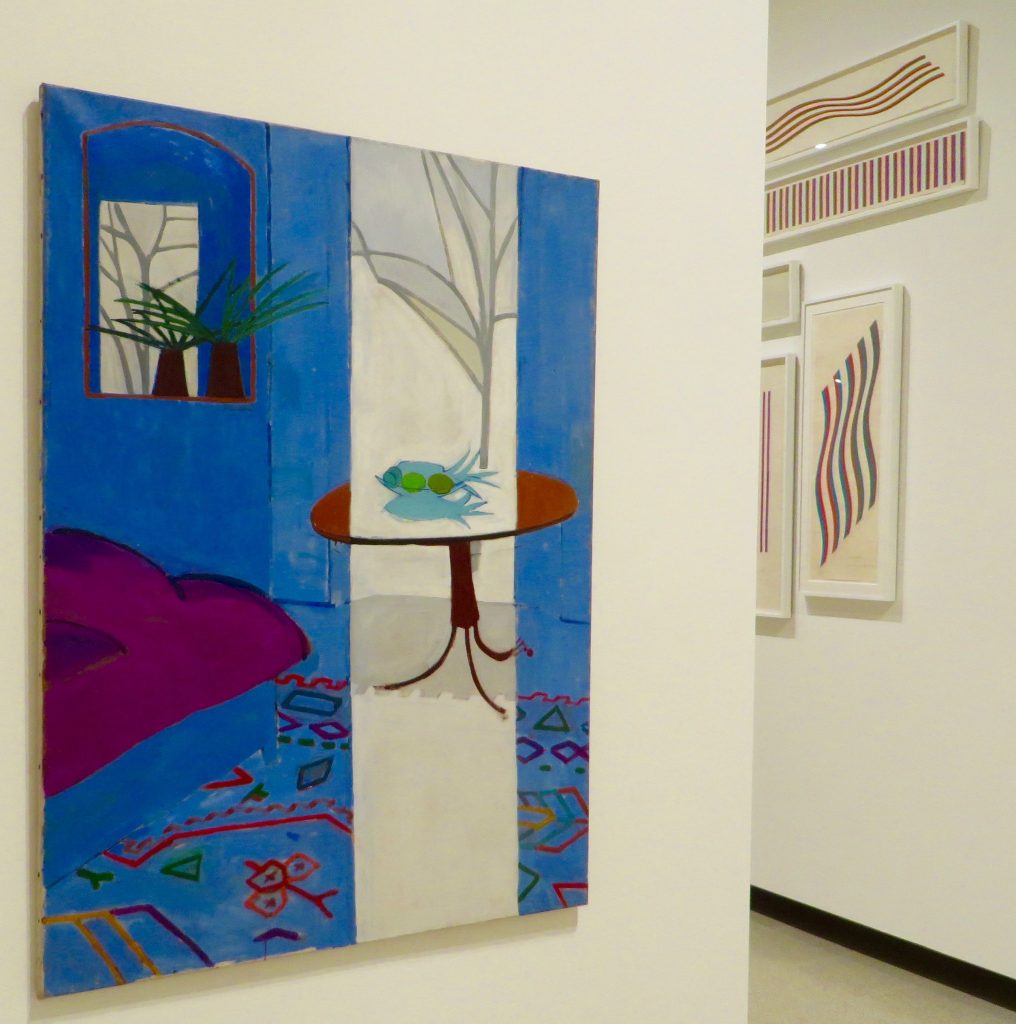
and now she’s in
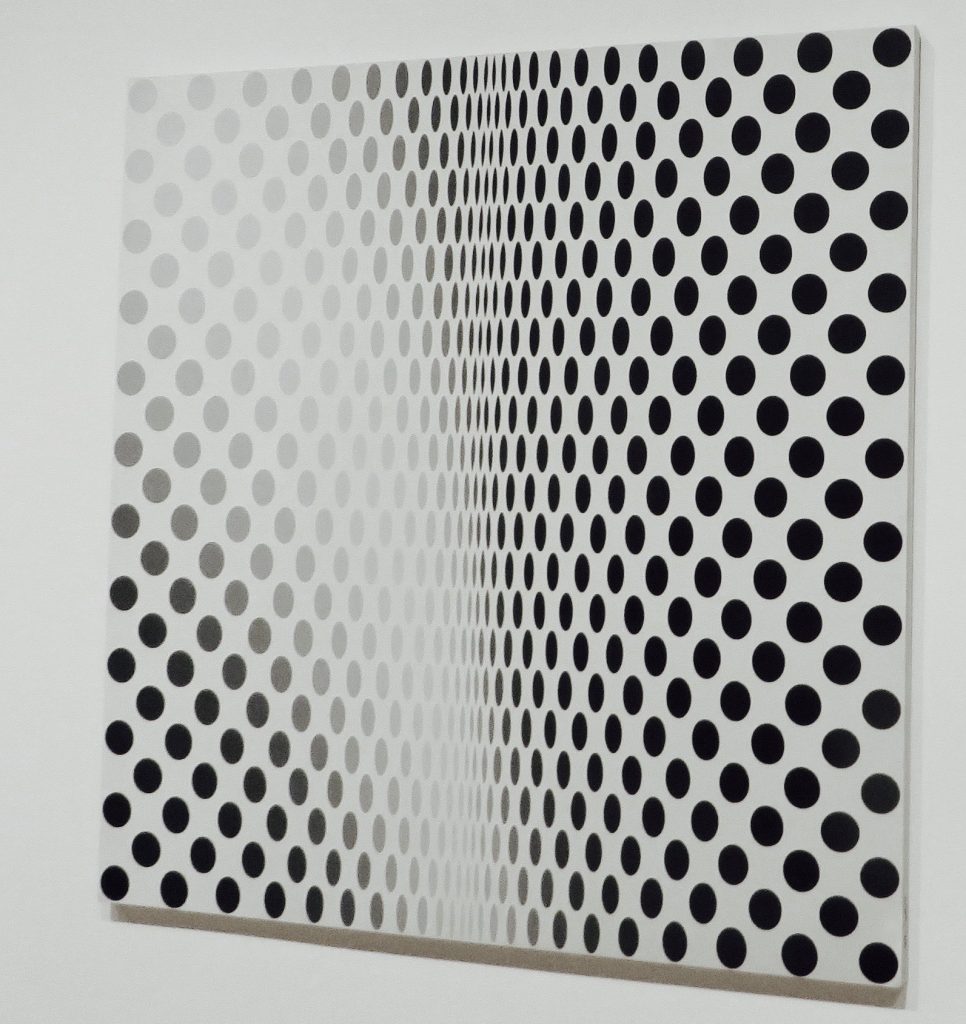
Black spots, black holes, sucked into 3D space …

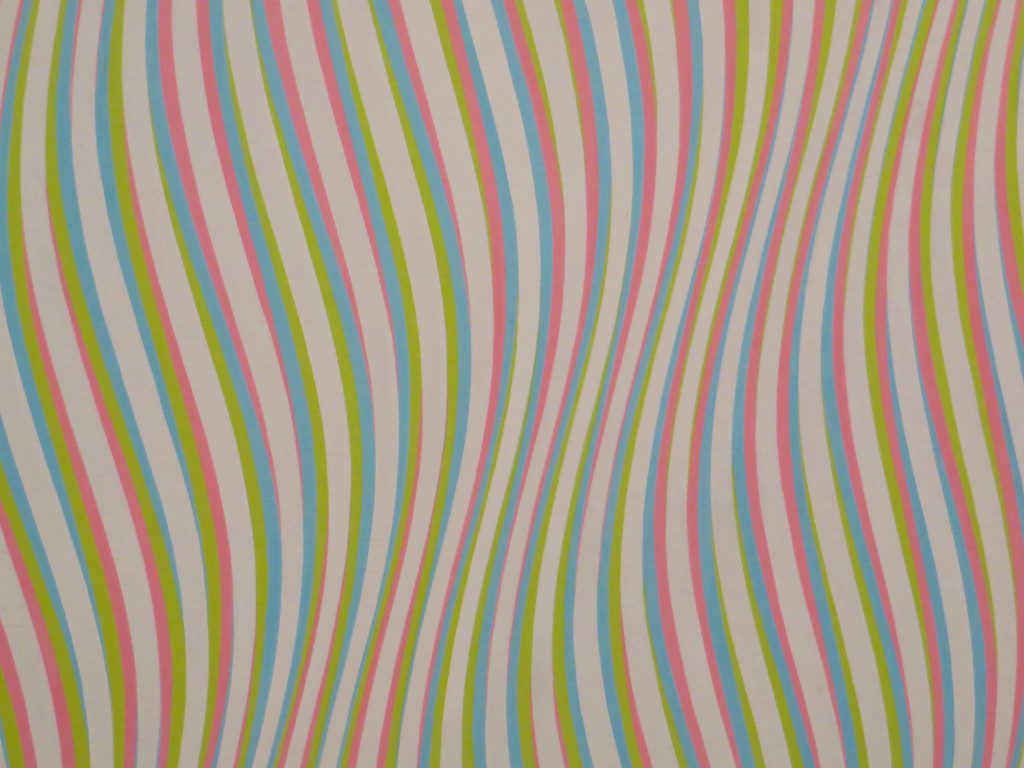
These candy stripes makes me feel queasy – like sinister clowns who use mirrors to change your shape and steal your soul …
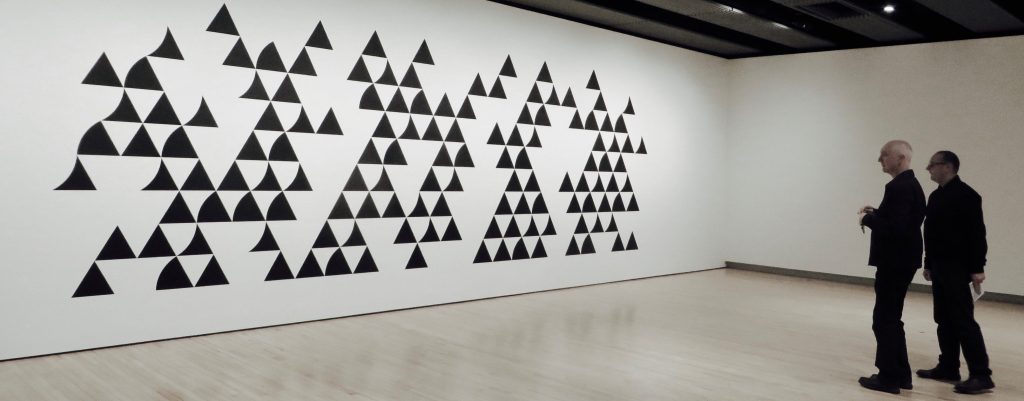
The above looks like a message in code but I am incapable of translating it …
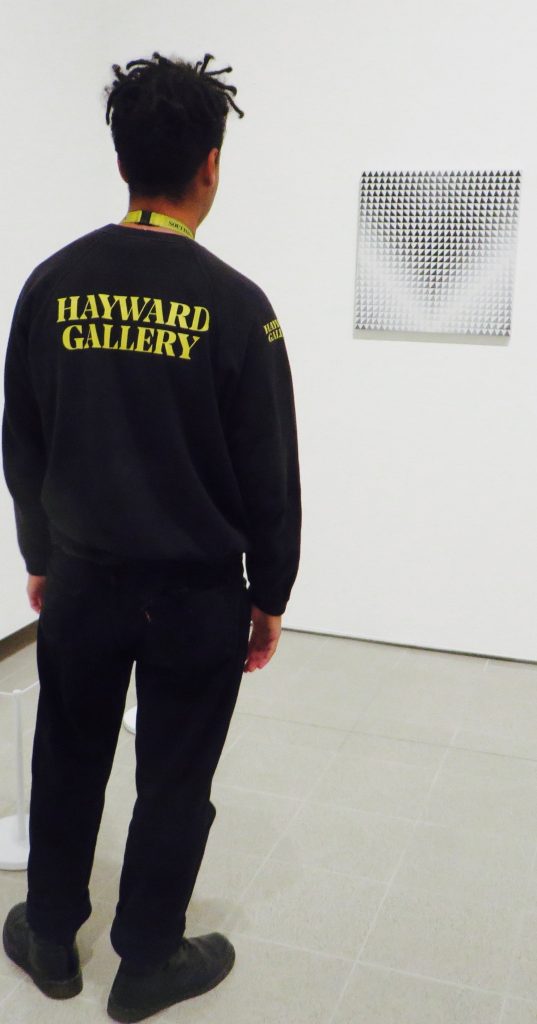
I wonder what this young man is thinking … ? He’s very personable.
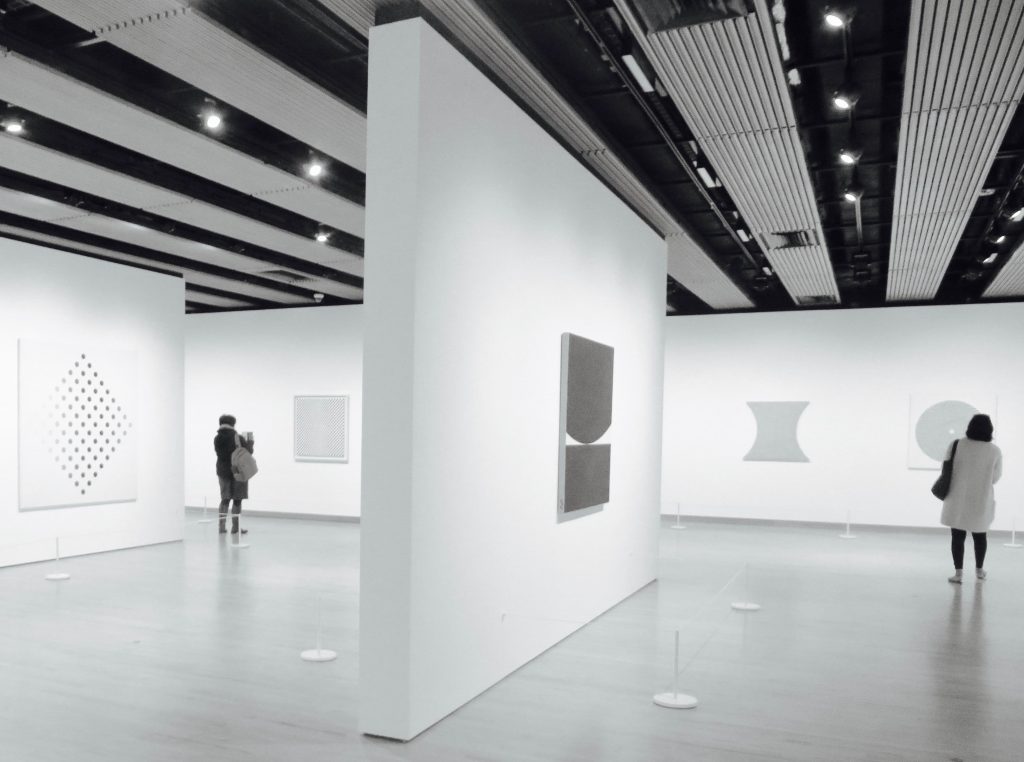

I enjoyed this exhibition for itself but even more because it threw up new channels of exploration and linked up various artists and ideas which I hadn’t connected. The sixties were a time bubbling with freedom to think outside of the box and that appealed to my curiosity. Now I can see the linkages in a different way. I expanded my mind!
On the way home, I passed some geodesic domes overlooking the river – a table and chairs set for a meal lie within. A suitable venue to discuss the art of Bridget Riley, while watching the waves …
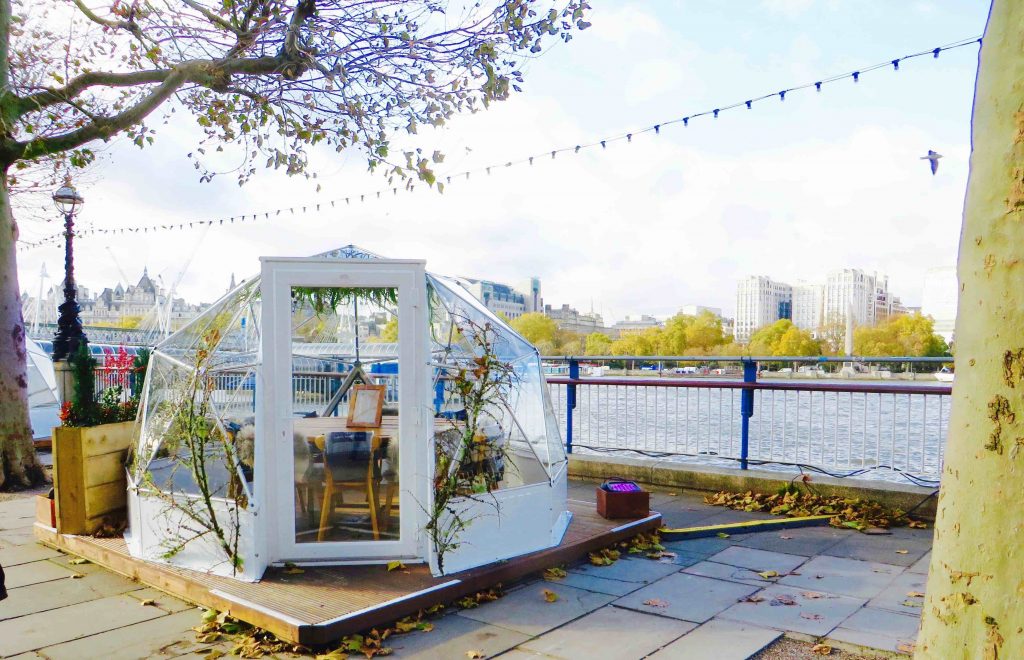
I’m thinking that if I came back in a hundred years – impossible – I would be as surprised and shocked, curious and questioning and maybe like a fish out of water – as Samuel Pepys would be if he appeared in London today. Progress is inevitable and includes the bad with the good. The universe will have changed but is unalterably made up of the same nanoparticles – it’s how we use them that makes change possible.
An interactive exhibition by this Danish-Icelandic artist is full of light and reflections – a mixture of the beauty of the natural world with the science that it is made up of and a universe that we don’t totally understand. Oddly, I had bought a ‘Little Sun’ (renewable energy) at the Design Museum in Copenhagen earlier in the year, unaware that it was conceived by Eliasson as one of his many projects. Eliasson is also keen that people should welcome being part of a community. In his own studio he established a kitchen using local, seasonal, vegetarian ingredients in order to help bring his team together.
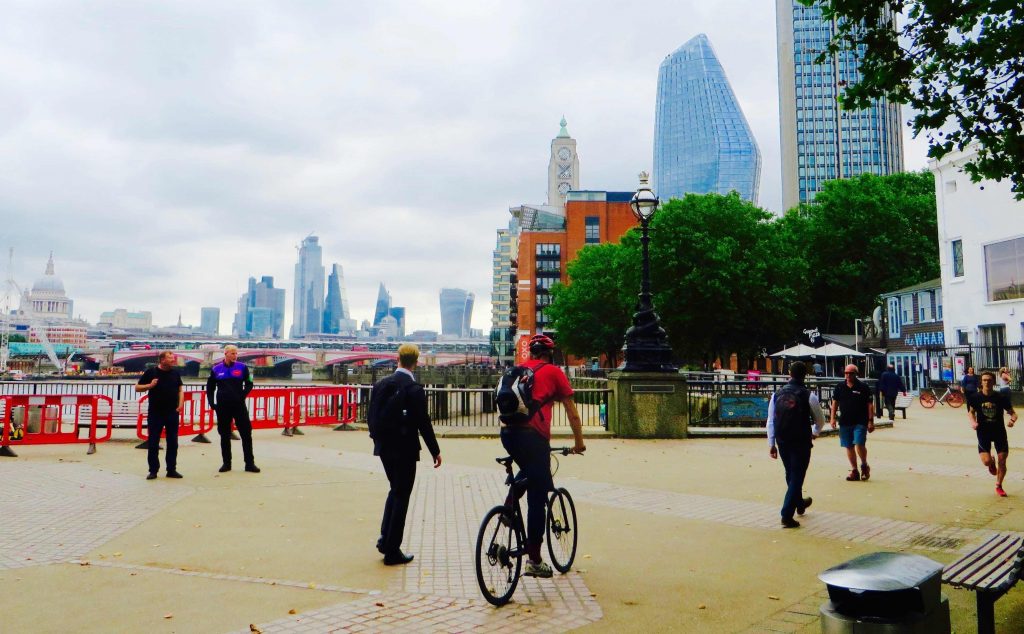
I walked along the river from Waterloo with plenty of time to explore the river front. Such a glorious mixture of buildings, old and new. The weather was mild – it was good to be out and about.

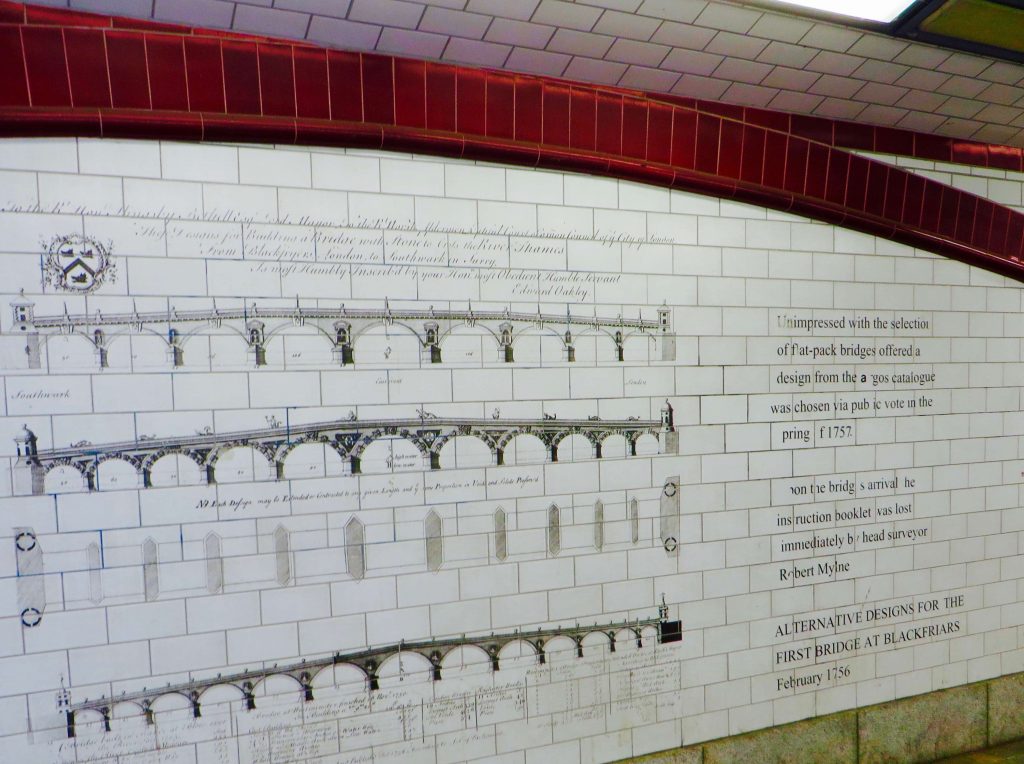
If you have time to stop and stare for a moment, it’s worth a look.

But I had already had breakfast and so I moseyed along the river thinking about the treasures that lay beneath the water in the mud and the mudlarks who patiently search for them. At the moment I’m reading all about this in a fascinating book by Lara Maiklem, unsurprisingly entitled ‘Mudlarking’. It is a BBC Radio 4 ‘Book of the Week’.

I’ve arrived – the poster for the exhibition is outside and to the left is the Millennium Bridge just touching base on the South Bank. I’m early, I find a bench, sit down and take in my surroundings.
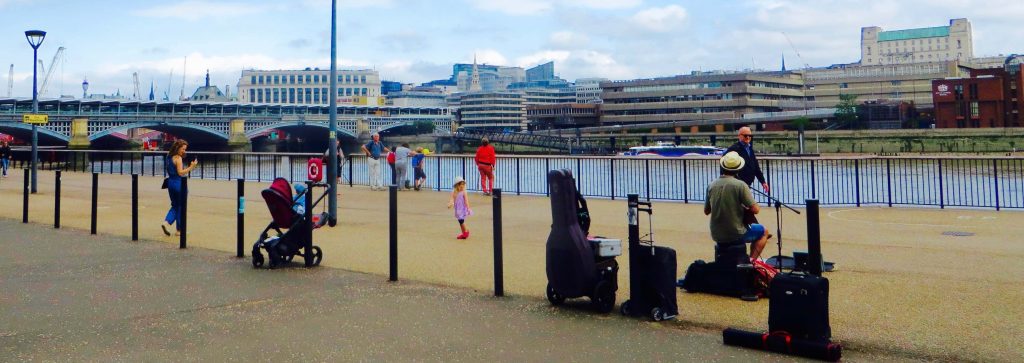
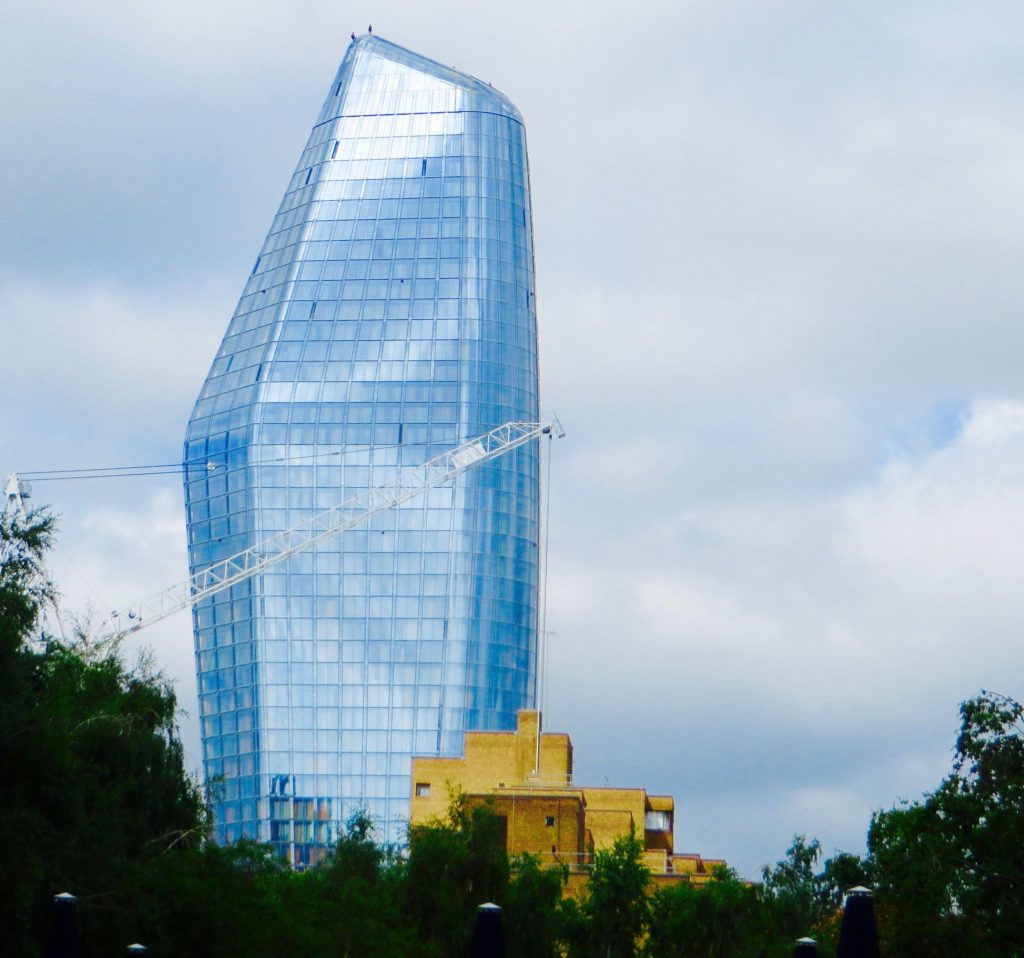
There are two men on top of this building. I feel dizzy watching them.
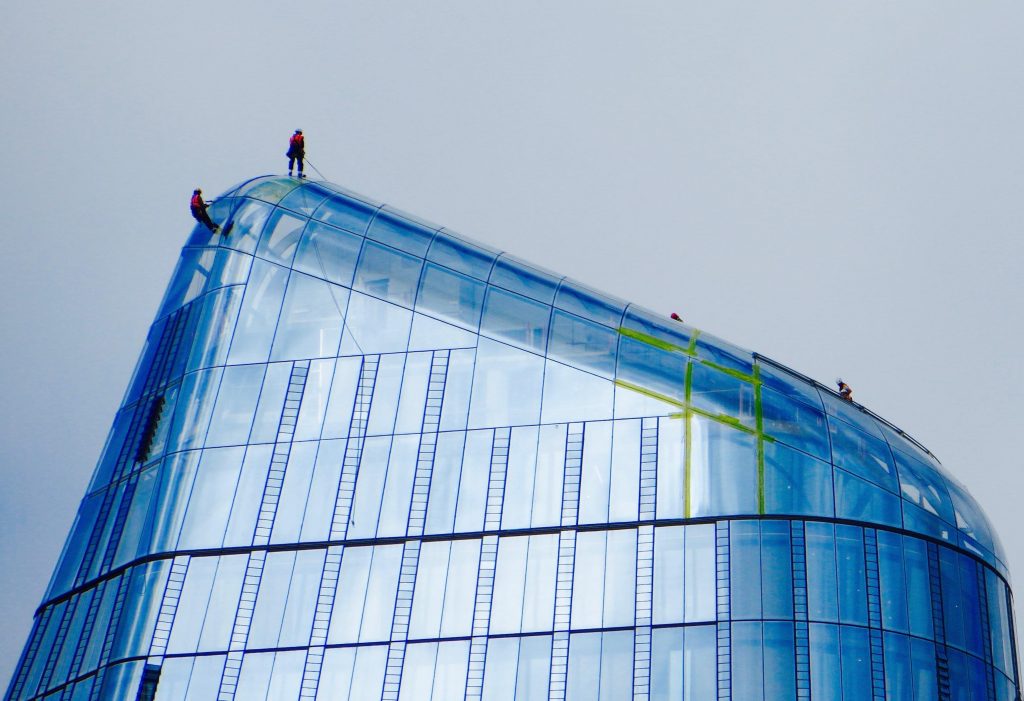
Not a job I would have the qualifications for …
My companion arrives and we make our way into the world of Olafur Eliasson. Light, mirrors, reflections, ice, fog, moss, multiple images …
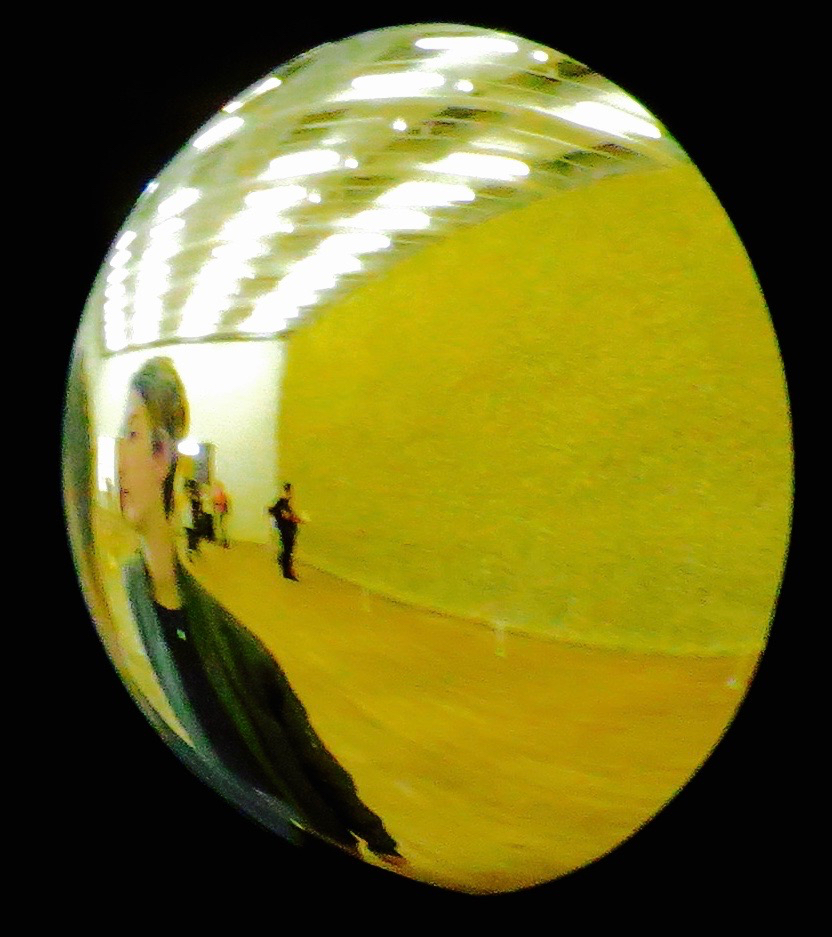
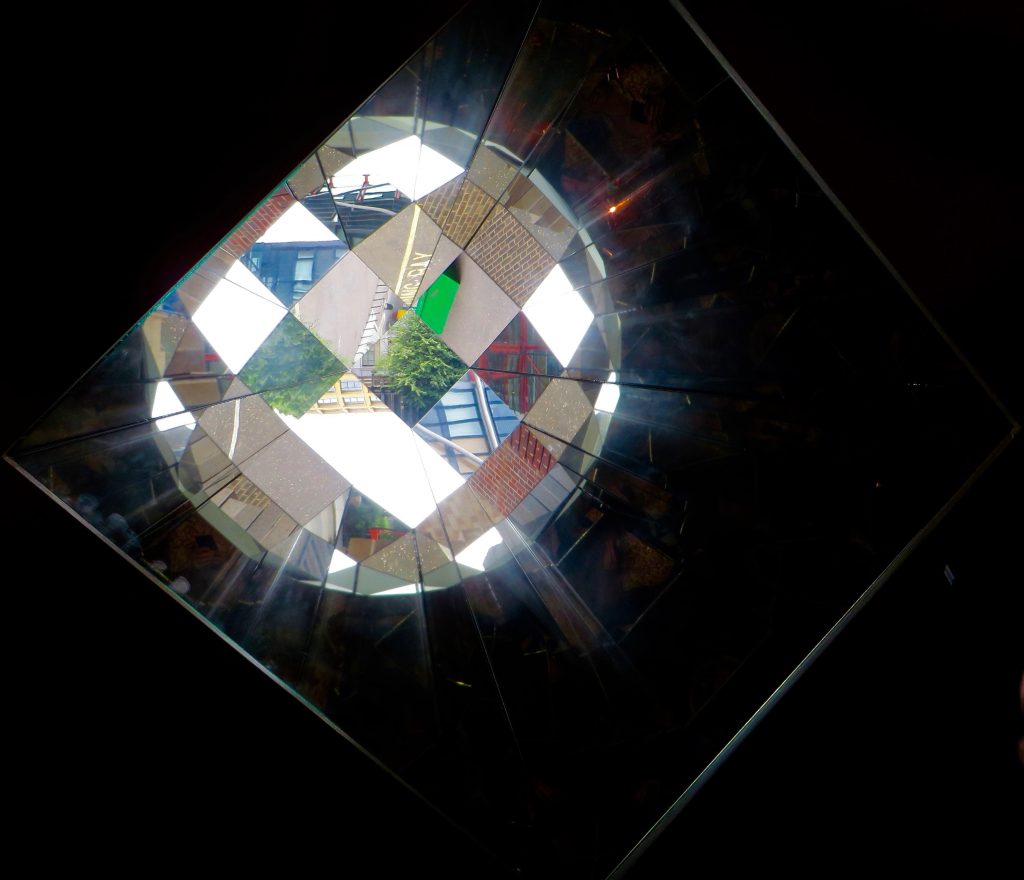
We come upon a long passage filled with fog called ‘Den blinden passager’.It is suffused in a yellow light but I can’t see very far in front of my nose. We are encouraged to keep moving forward. I feel disorientated and my balance is wonky but I persevere and begin to become acclimatised. It makes you think – good to be out of one’s comfort zone !
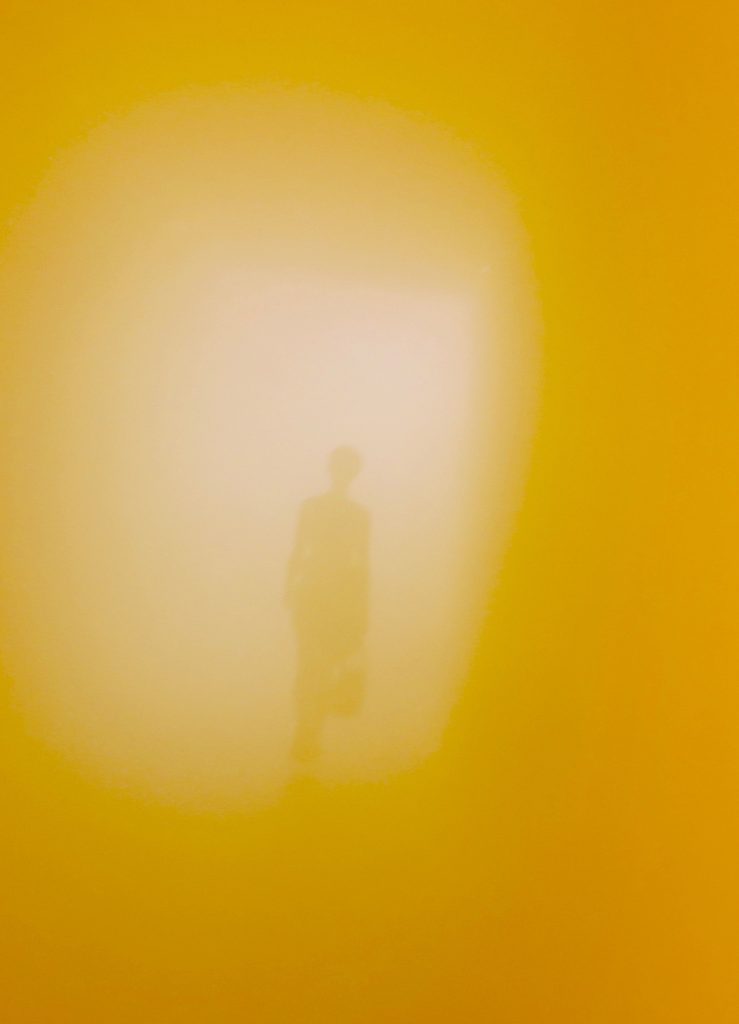

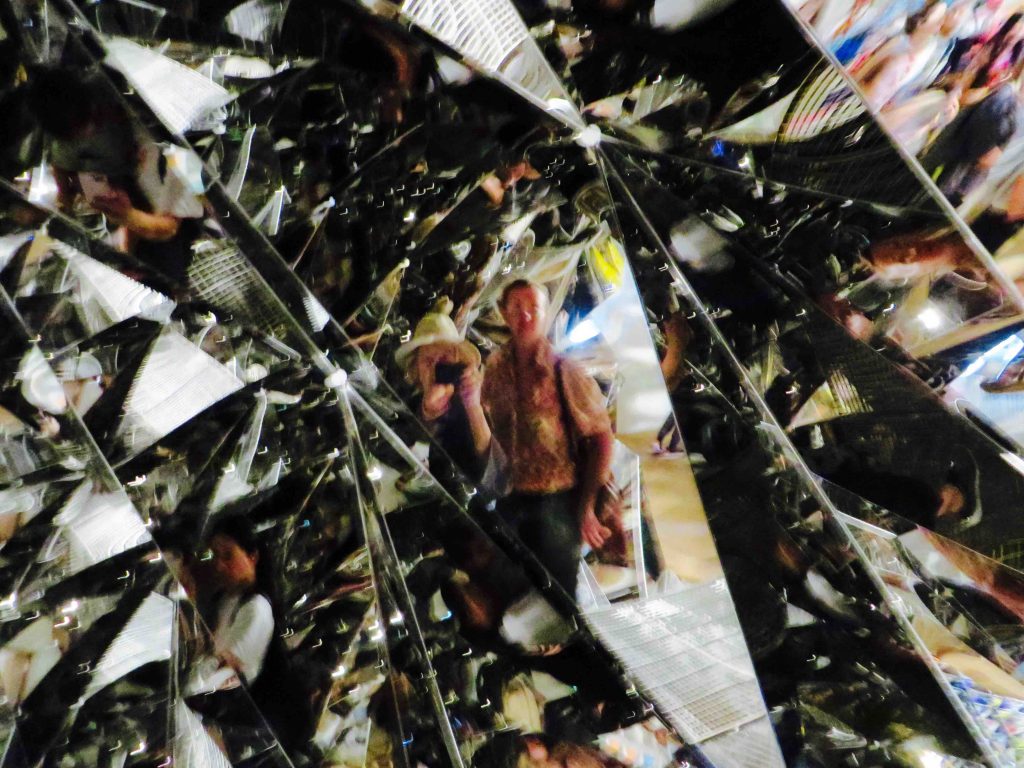
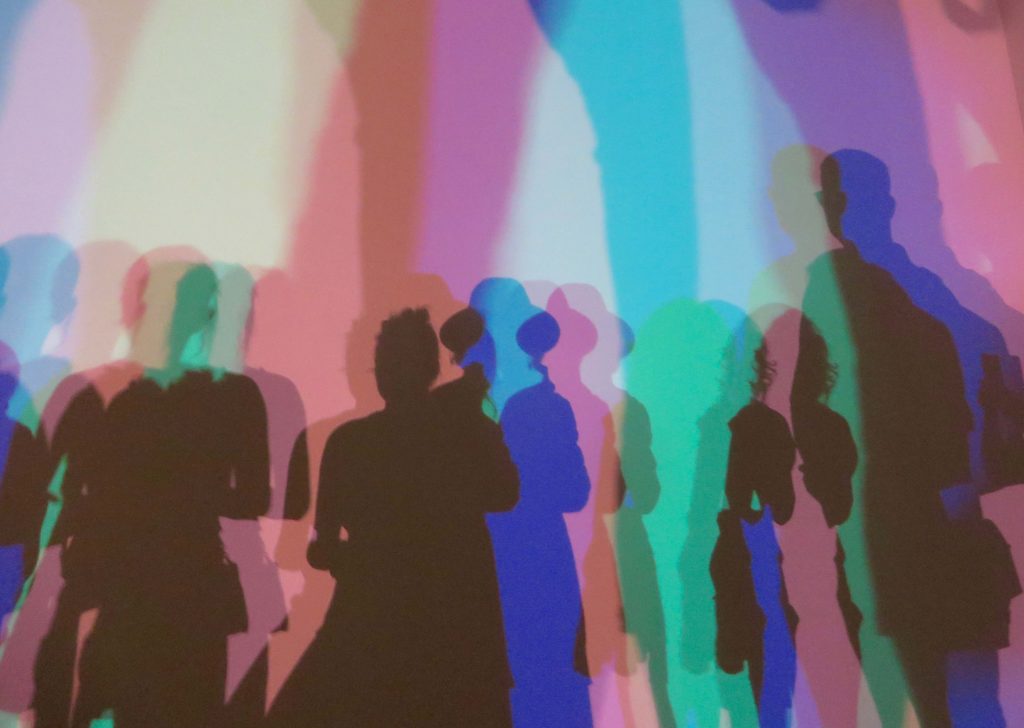
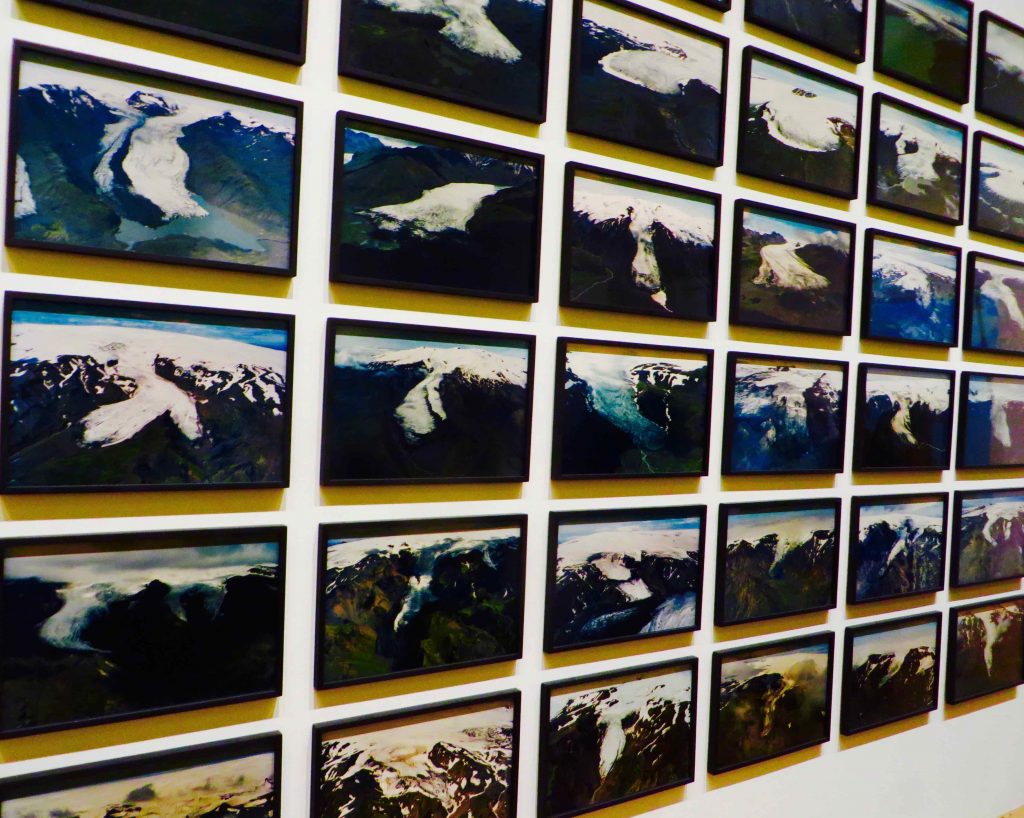
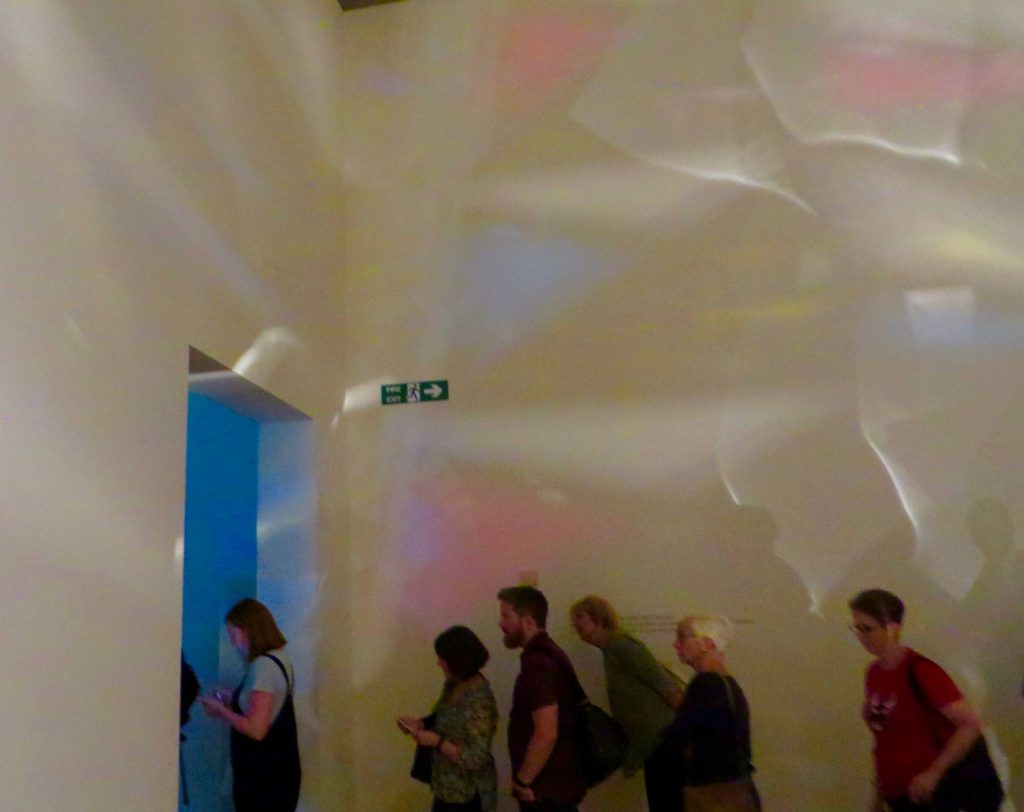
Colours, light, reflections – all these I am drawn to. I love artists like John Singer Sargent, Joaquín Sorolla, Claude Monet and many of the Impressionists who capture those things in their paintings. I love other artists as much in different ways but I would never choose to live on a planet without light and colours. I don’t expect I would be given a choice but as Jim Al-Khalili moots – your reality may be based on something that doesn’t exist … or at least things we haven’t yet understood. So there’s still room for learning and dreaming. It’s a pity I won’t be able to come back in a hundred years from now. But as it is, the planet has given me enough food for thought in my life to date …
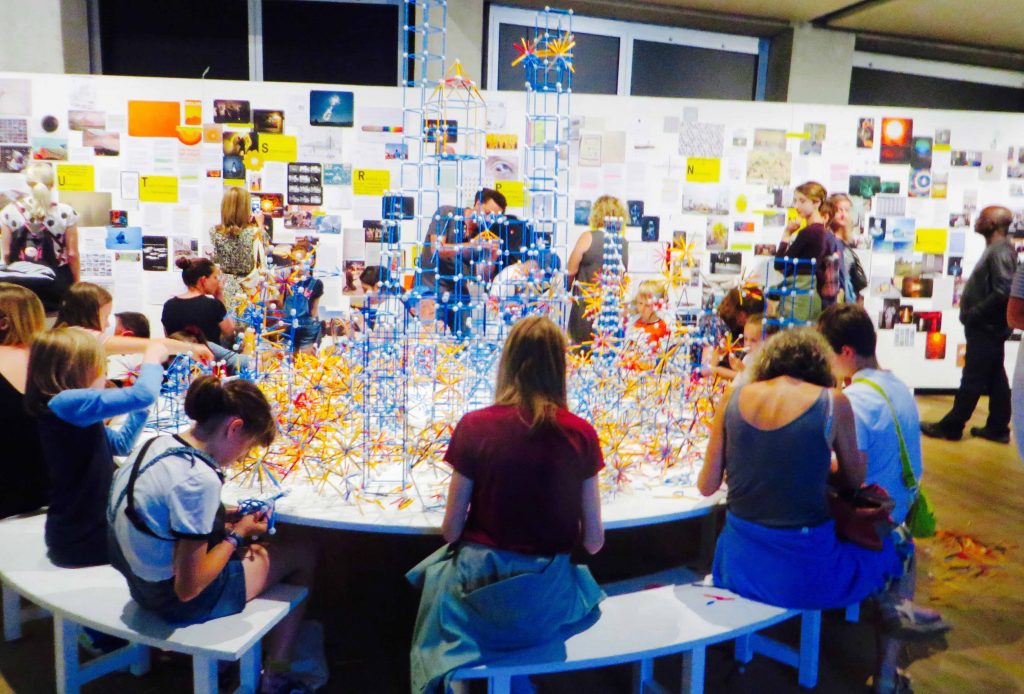
I love this ‘hands on’ room in the final zone where everyone looks completely fascinated by what they are discovering.
And finally, there’s a special treat. The Kitchen team have been set up by ‘Tate Eats’ for us to have a lunch which is similar to the ones made for Eliasson’s team. It is exciting, delicious and wraps up an excellent exhibition. Thank you Olafur Eliasson.
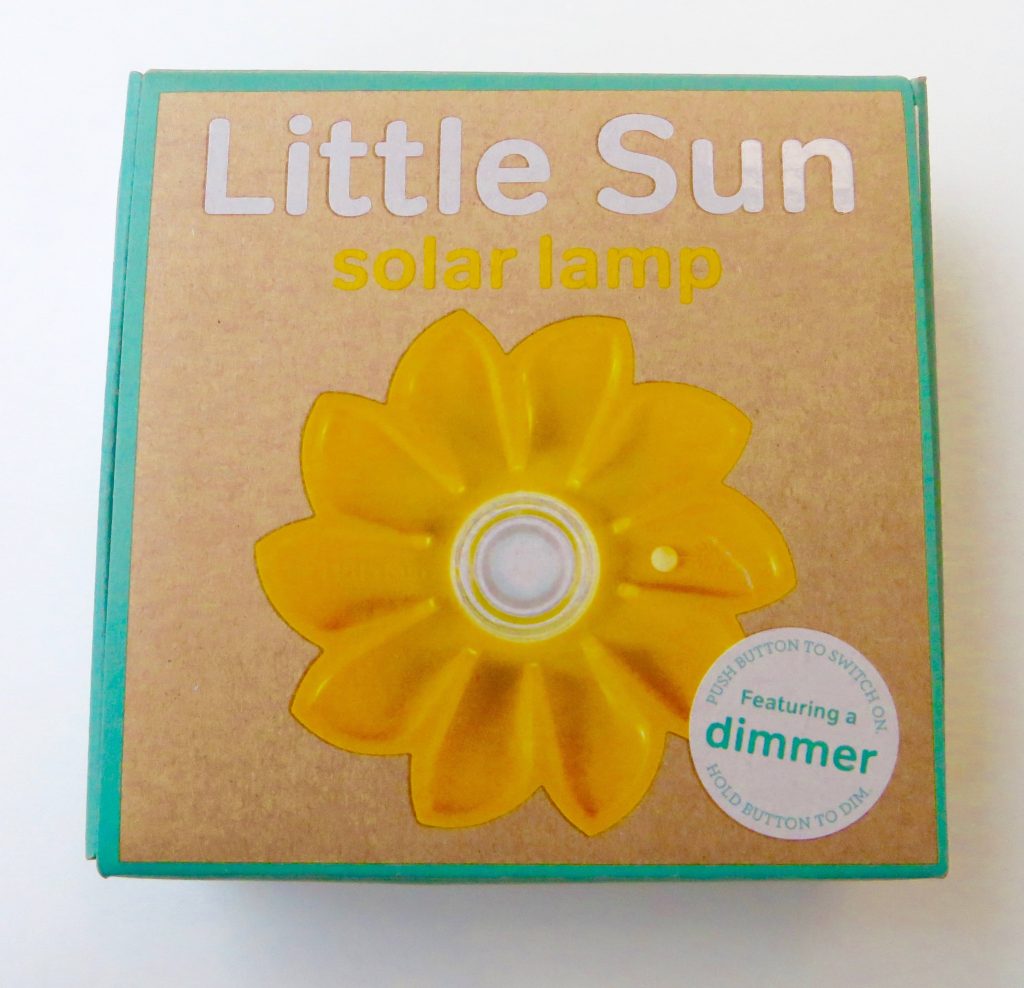
This old fashioned, Hulot-esque town overlooks the sea on the north coast of France. I was introduced to it by my sister and her husband. Almost fifty years ago Mickey and his friend managed to cross the Channel in not much more than a leaky dinghy. They lost their way and finally landed somewhere in total darkness, not knowing if they were still in England or had made it to France. France it was and Wimereux welcomed them. Mickey came back regularly over many decades …
Sadly, he is no longer with us. Times have changed and luckily the Channel tunnel is more reliable than the dinghy. We arrived in good time to board, the sky like grey goose down, shedding a few heavy raindrops onto the windscreen.
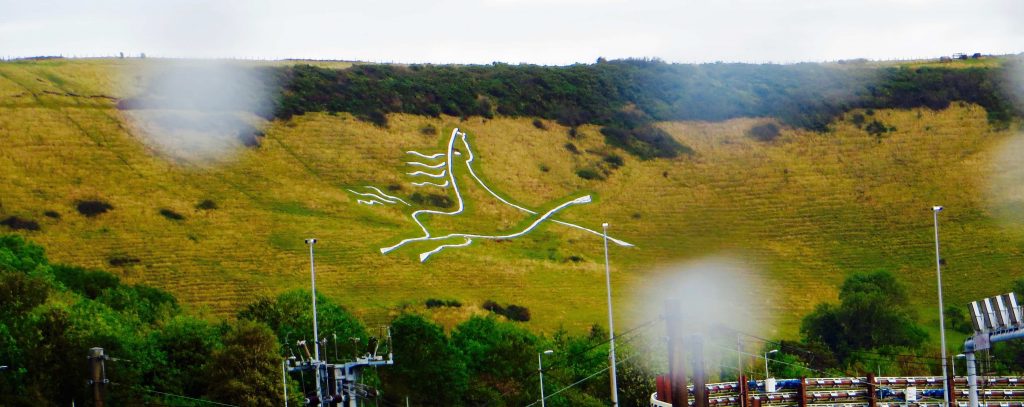
We left England at 11.20am. The photo below will remind me to take the coast road to Wimereux rather than the autoroute. It is empty of cars and full of fresh sea air, the waves rolling in like white horses.
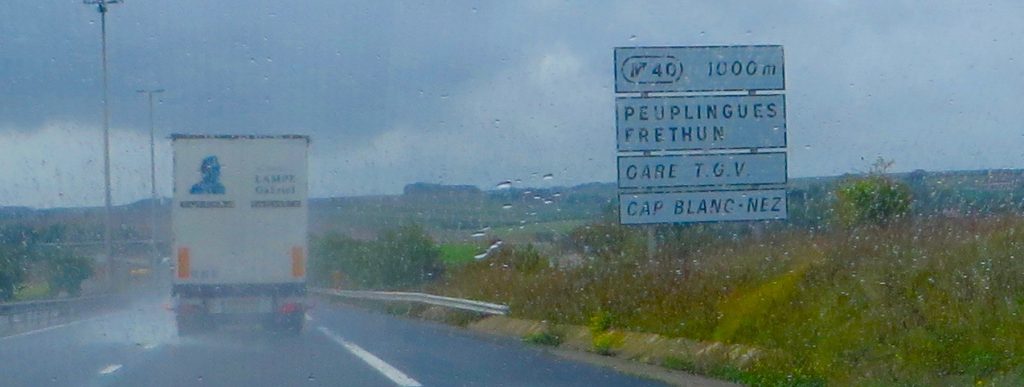
An hour later and we are settled in at ‘Les Oyats’ café by the sea, enjoying a ‘crêpe nature’ with salad and a ‘thé au citron’ – or maybe ‘un verre’. The sea is quite wild. ‘Oyats’ translates as marram (sea) grass. The café is busy, despite the weather.

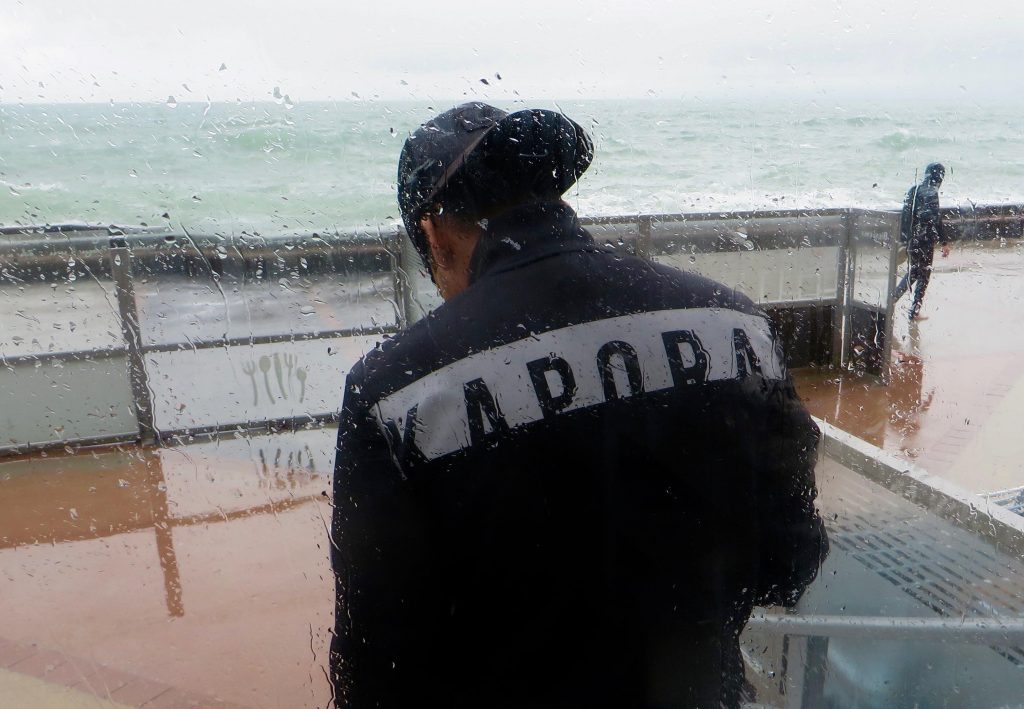

We walked along the ‘digue’ afterwards, feeling madly invigorated. Sun isn’t always a given for holidays – the force of the sea was pulsing through my veins, filling me with a new found energy.
Back at the hotel I noticed a couple at the reception desk and recognised the man straight away even though I hadn’t seen him for many years. Struggling through the cobwebs of my memory, I finally came up with it. A TV programme called ‘The Likely Lads’ – a series shown between 1964 – 66. He was James Bolam – his other half being played by Rodney Bewes.

The clouds are breaking up this morning. The rain has moved on and we have a clear palette for the day ahead. I sometimes wish I could paint but taking photos captures the moment very well. We are off to Boulogne, fifteen minutes away – market day.
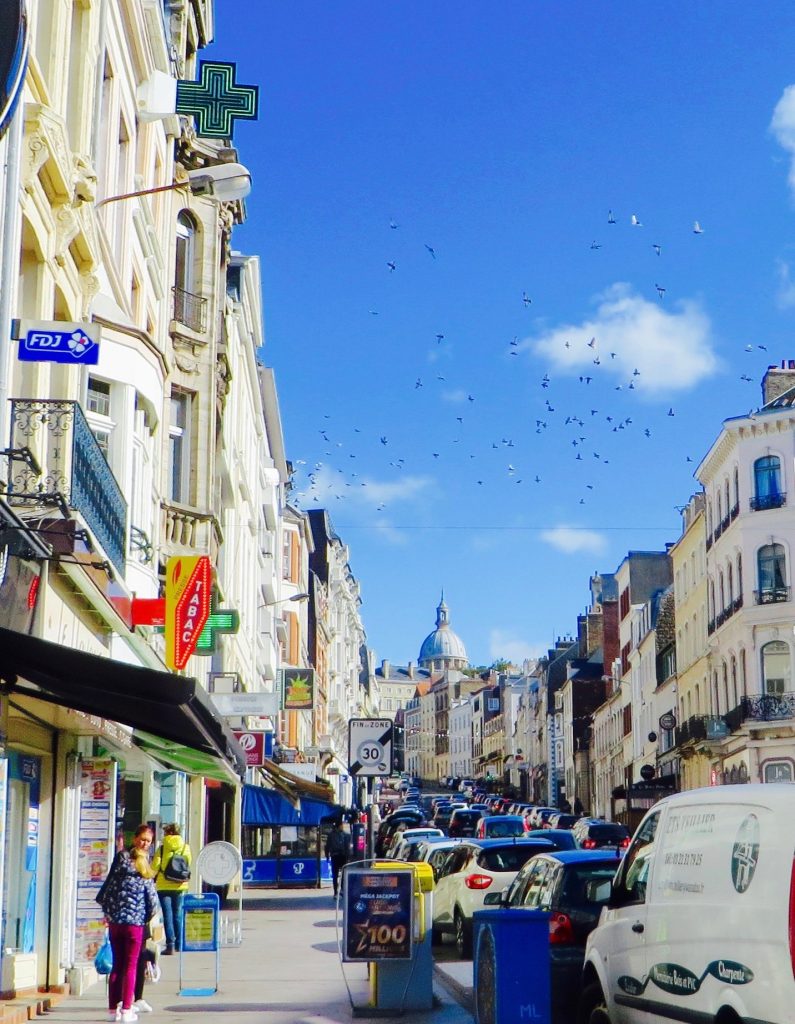

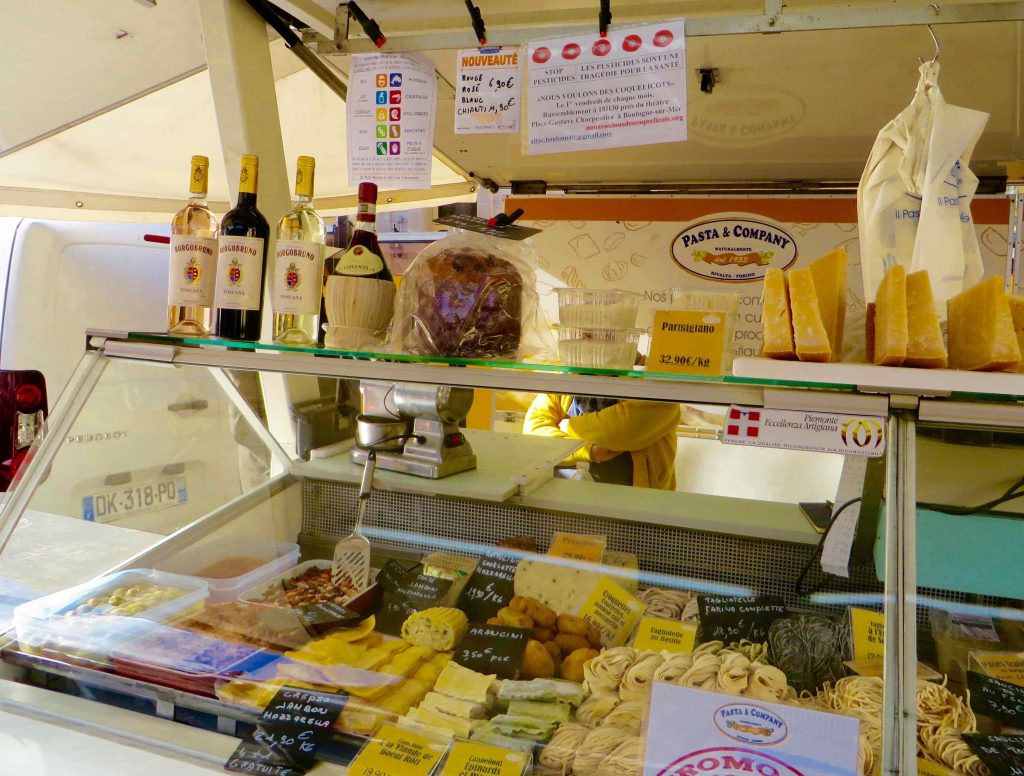
However, I’m even more interested in the notice above which is anti pesticides. It says pesticides are a tragedy for health – ‘nous voulons des coquelicots'(.org) (we want poppies). It has a message advertising a meeting about the environment on the first Friday of each month at the Place Gustave Charpentier. ‘Chapeau’ for the French!
It’s lunchtime and before we know it we’ve found ourselves in a ‘biker’ café, which is obviously very popular. We plump for a Flemish dish called ‘Flammekueche’ – roasted peppers, aubergines and courgettes on a base which resembles matzos. It’s super delicious, paired with a glass of red wine and a (glass) bottle of ‘Vittel’. There is quite a lot of Belgian influence on this north coast of France.
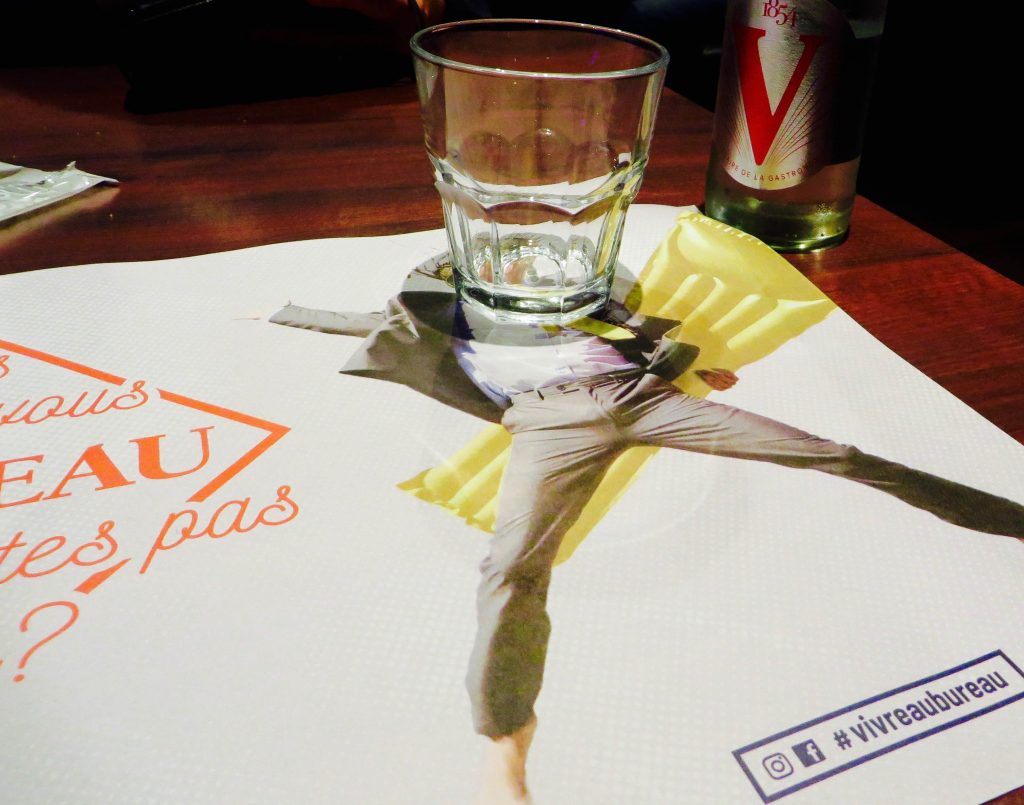
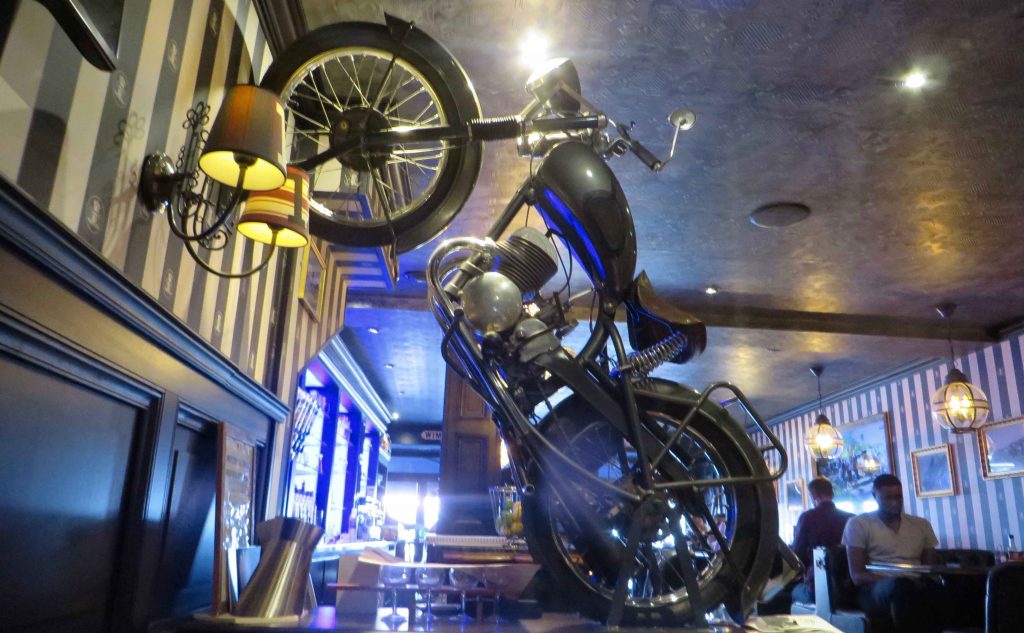
The man sitting on the right must be a basketball player. When he stood up, he was over 6’6″!
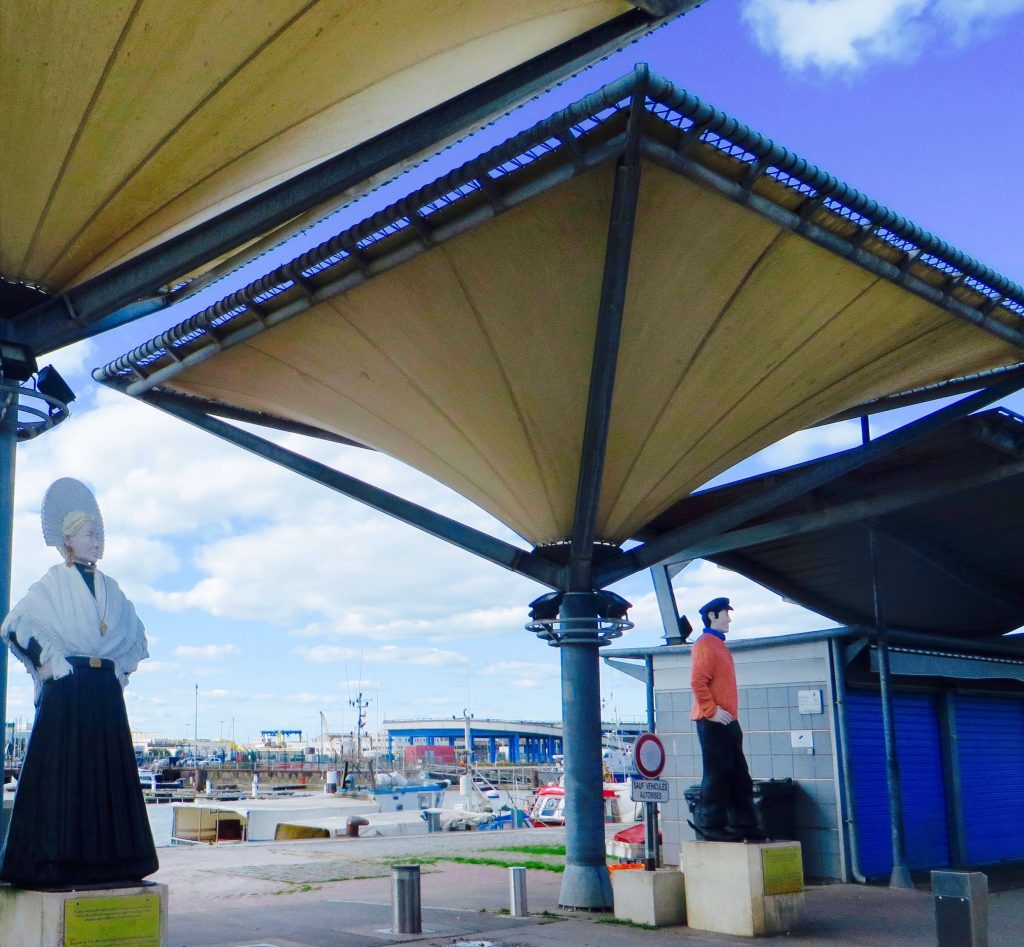
We decided to visit the aquarium in the afternoon. Got slightly sidetracked by the most delicious looking patisserie called ‘Fred’.
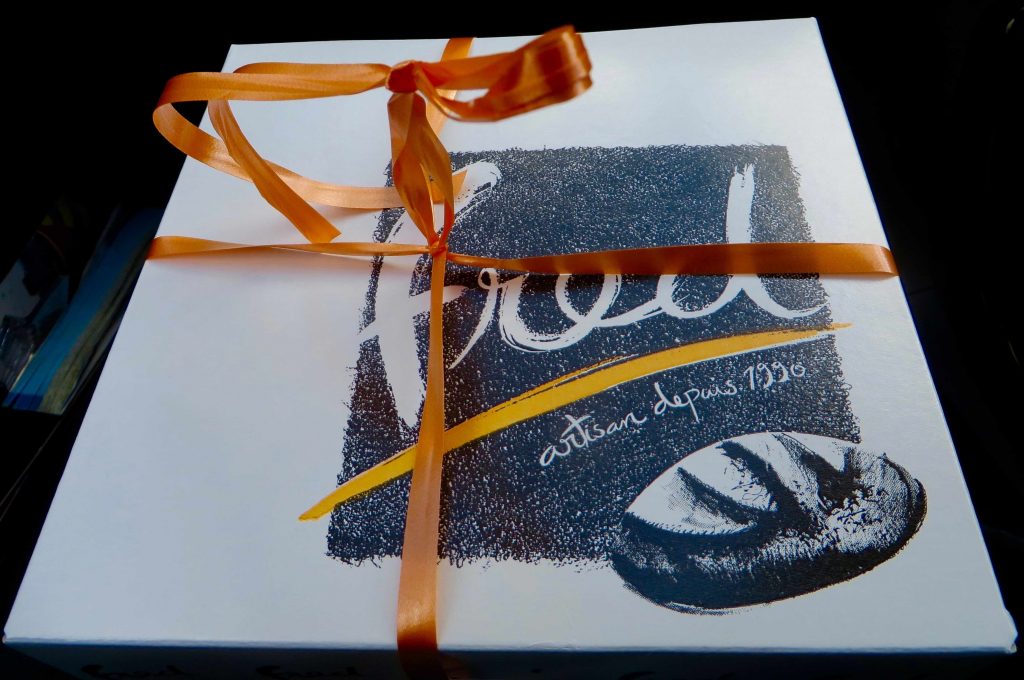
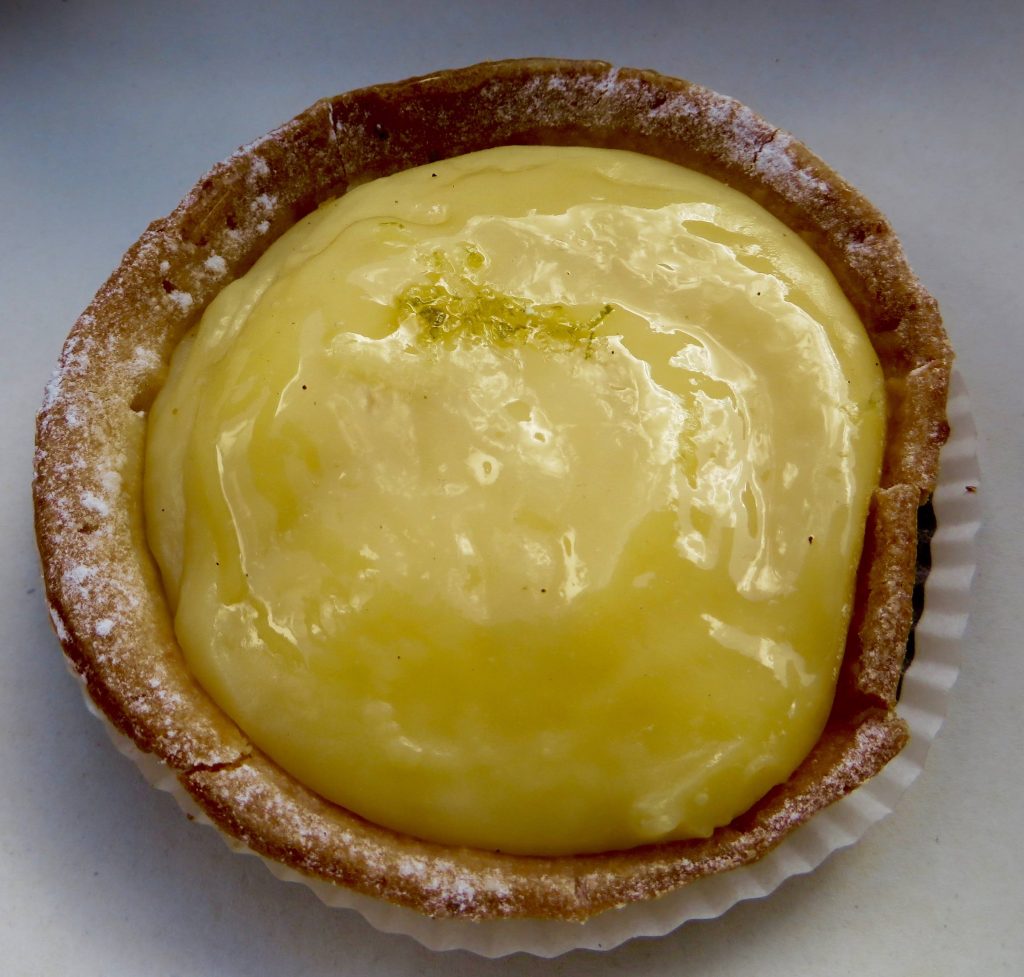
The aquarium is on the seashore and contains 10 million litres of sea water and 58,000 sea creatures. The entry, through curtains, leading to a down escalator, is dramatic.

This photo didn’t come out well because I was persuading my sister onto the escalator, while this enormous video screen seemed to be enveloping us over and over in a giant wave with a suitably mega soundtrack.
Having descended into the depths, we were met with a huge metal cage and surrounded by roving sharks …
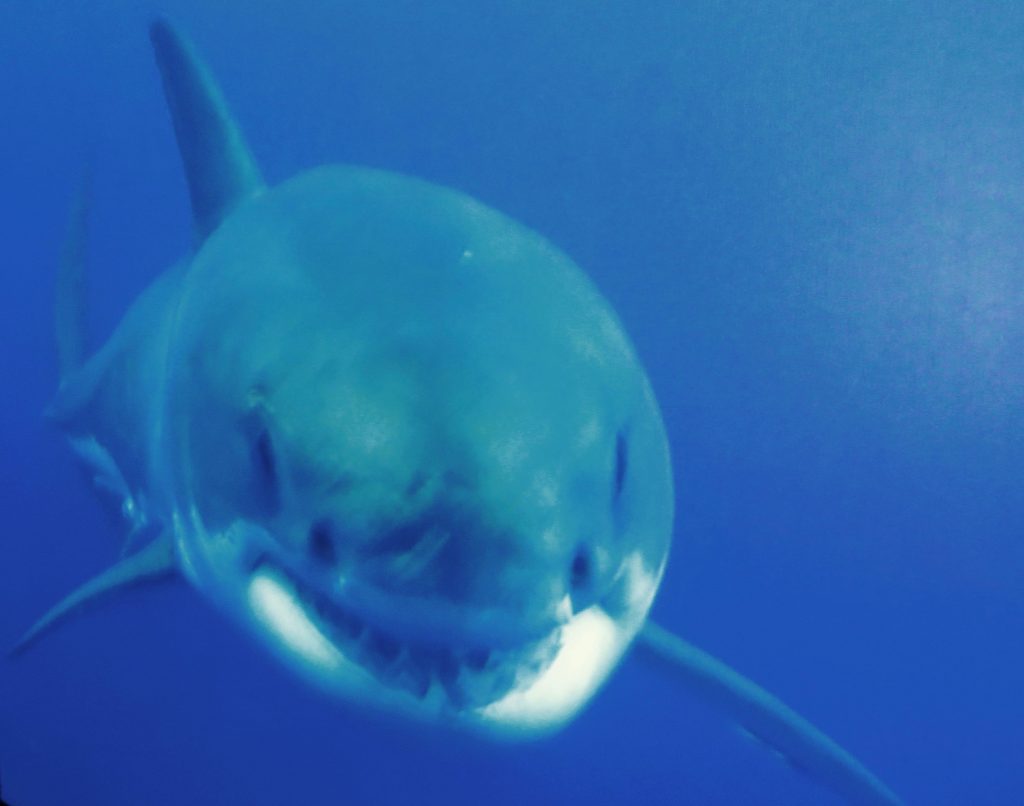
I feel very small – one tiny, tasty morsel …
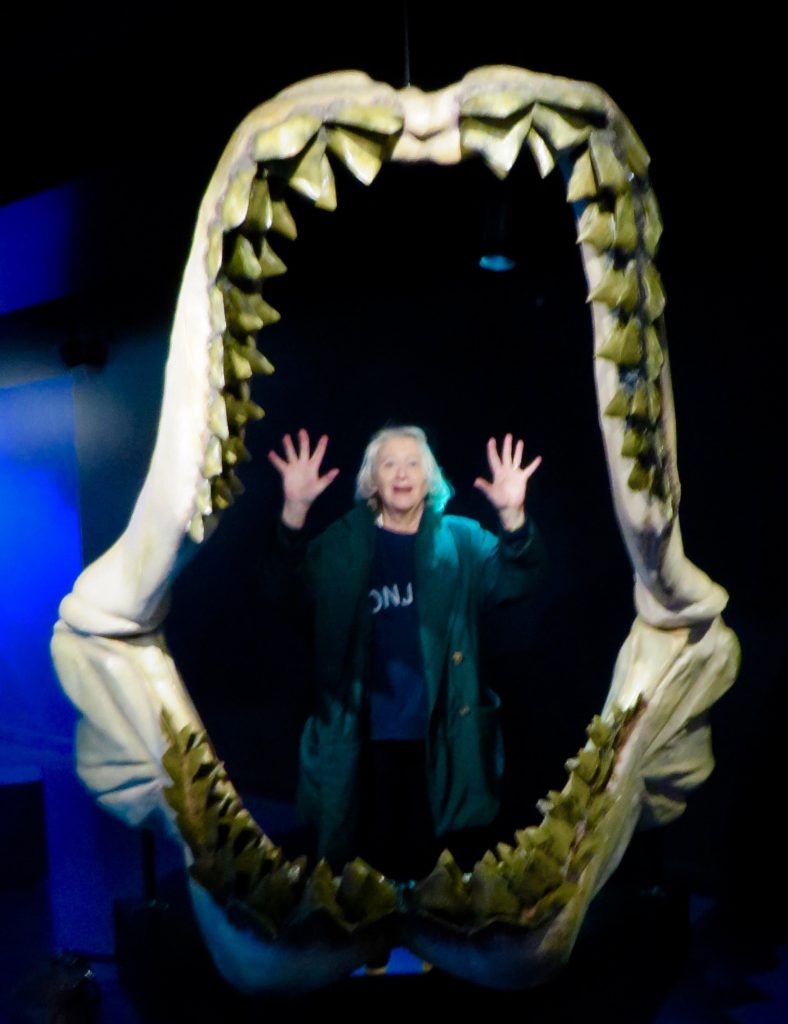
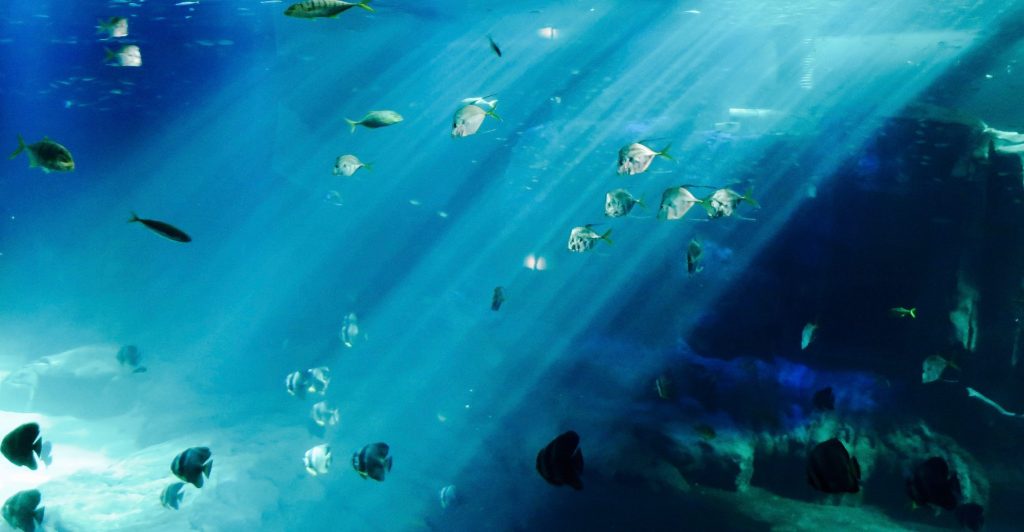
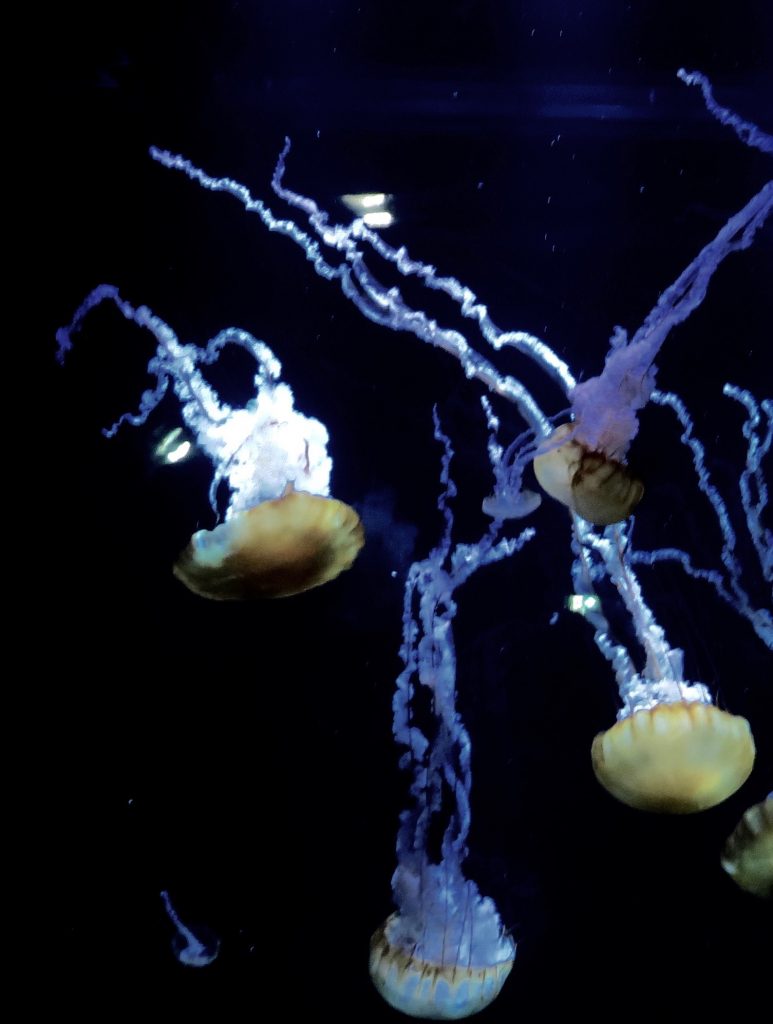
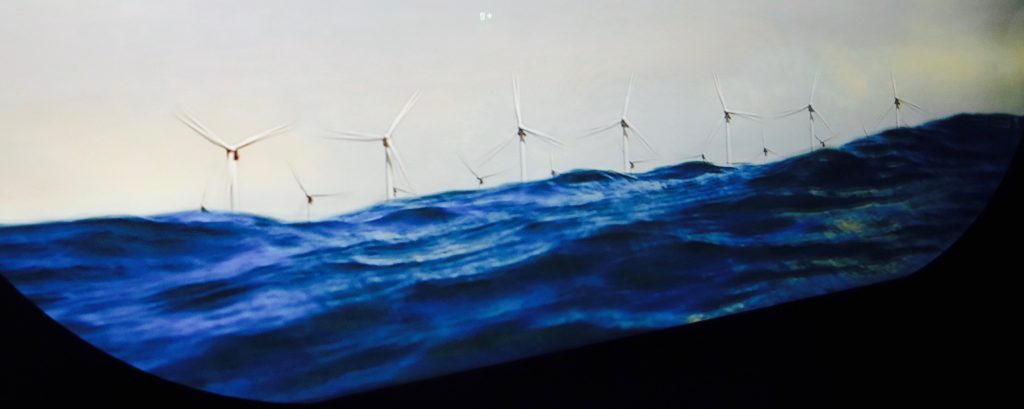
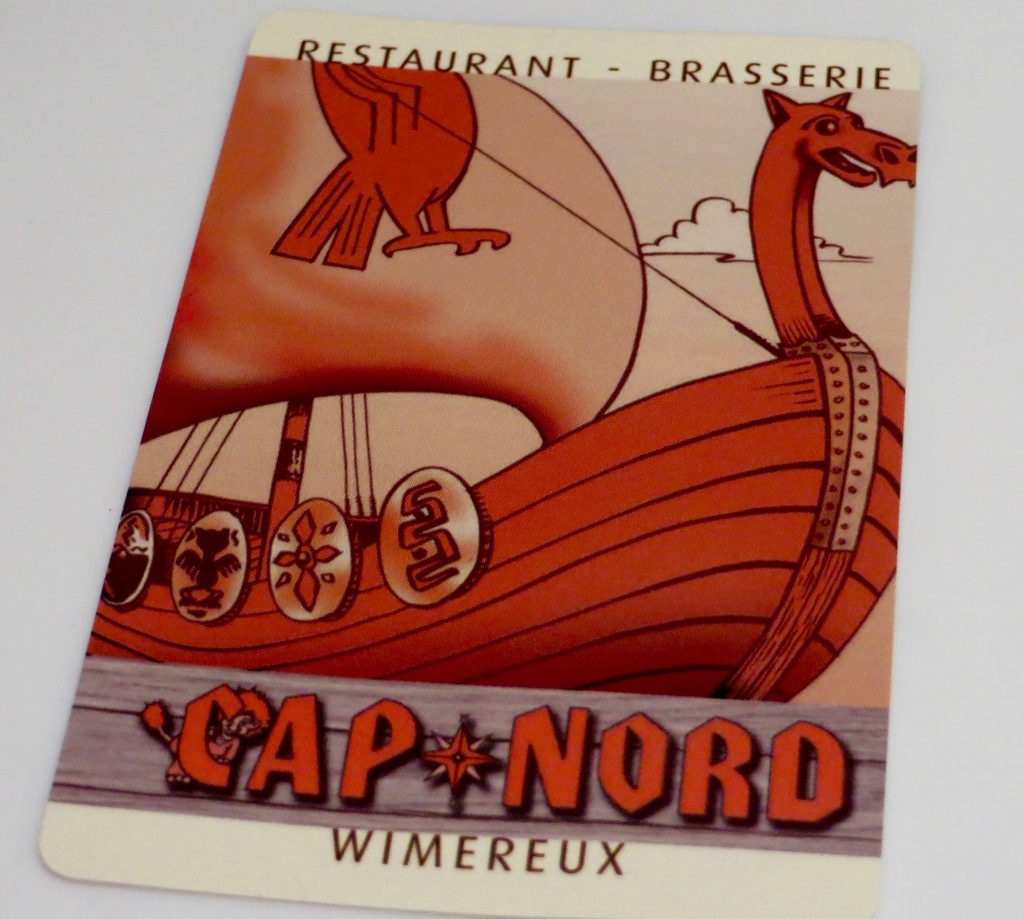
Dinner time was at the delightful ‘Cap Nord’ – a restaurant/brasserie on the sea front. We were in for an extra treat – front seats to watch a wonderful sunset while eating our ‘moules’.
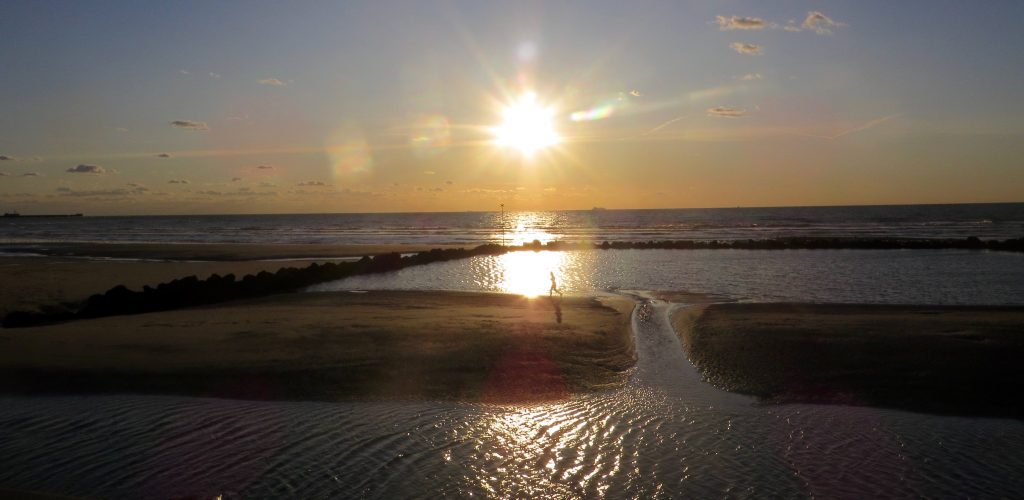

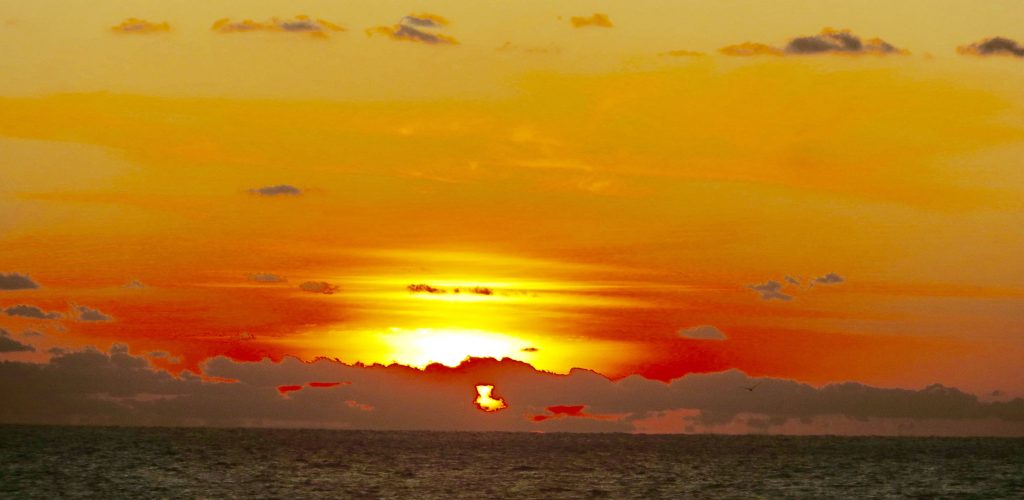

At this point you could read Shakespeare’s sonnet number 73, which expresses some of the feelings going through my mind at this moment better than I could. It was such a fabulous show this evening. What will tomorrow bring?
Our hotel has been in the same family for at least three generations. It has preserved its traditional French atmosphere downstairs in the hallway and restaurant. A modern addition however has been added at the back, overlooking the garden. Having breakfast with a Fornasetti vase examining your credentials is a sight to behold. I think we passed muster.
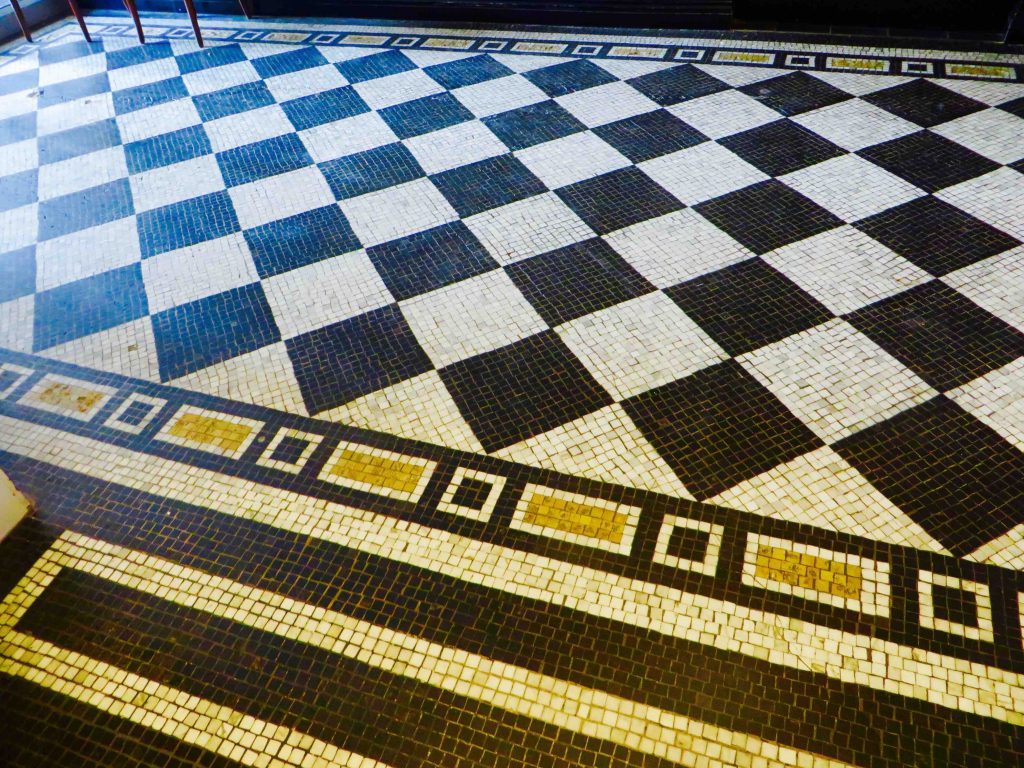
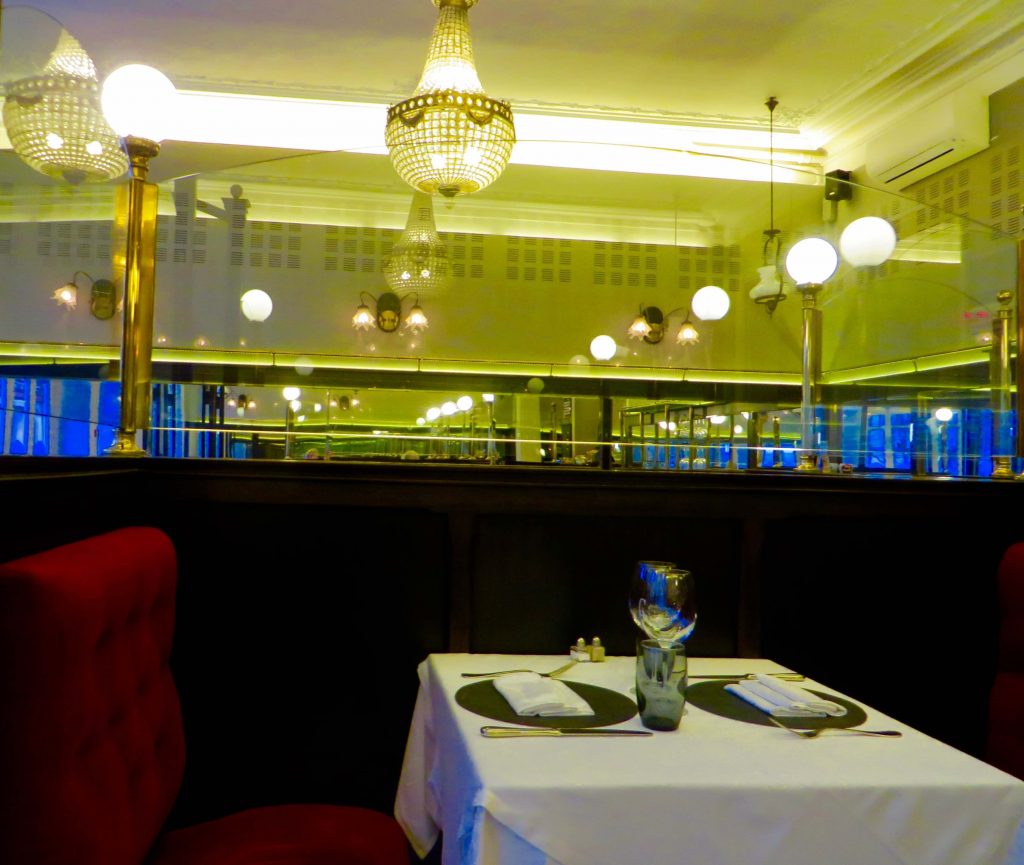

It’s worth looking up the Milanese designer, Piero Fornasetti (1913 – 1988). His designs are witty and surreal and continue to be popular.
The sky was becoming bluer by the moment and we headed for the beach, where the tide was out, passing some traditional buildings along the way.
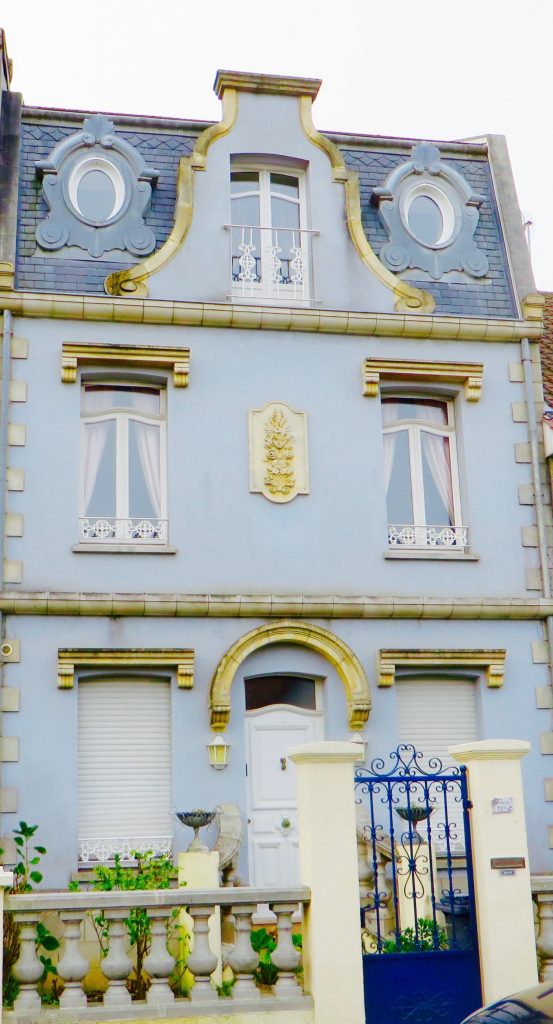
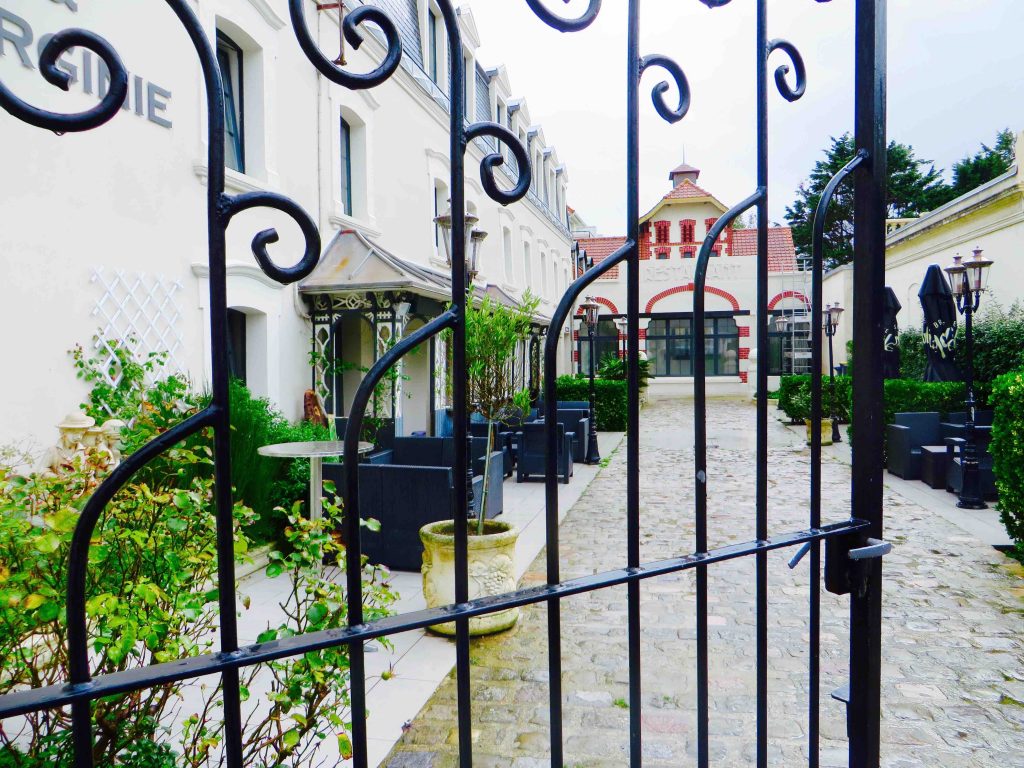
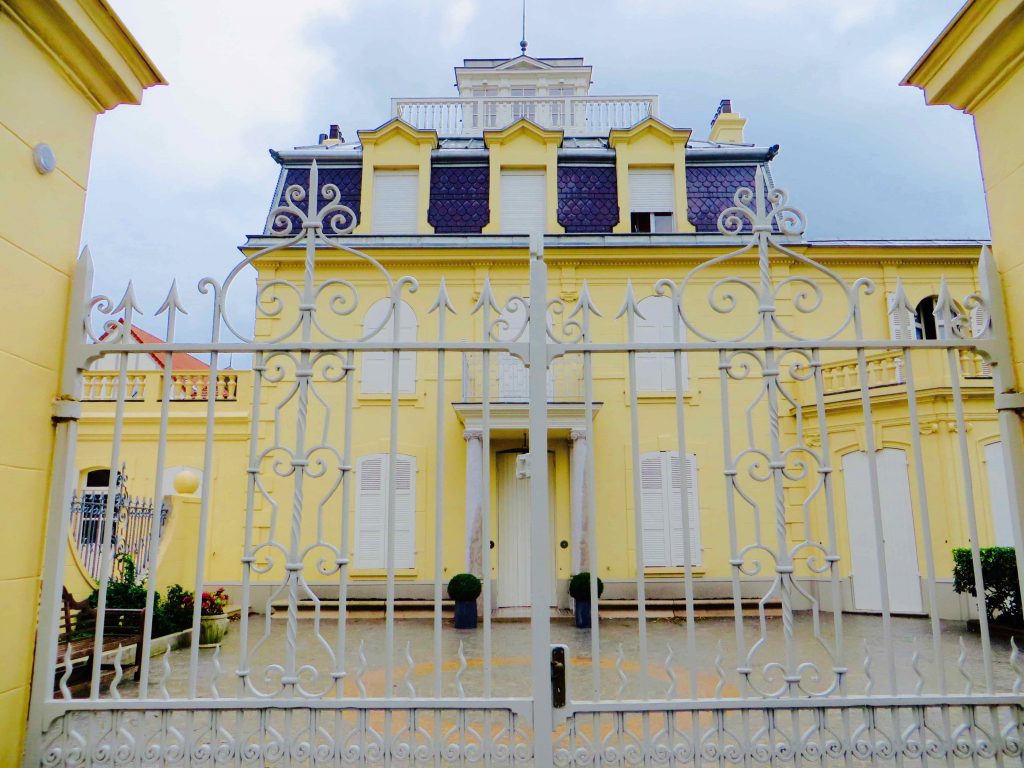
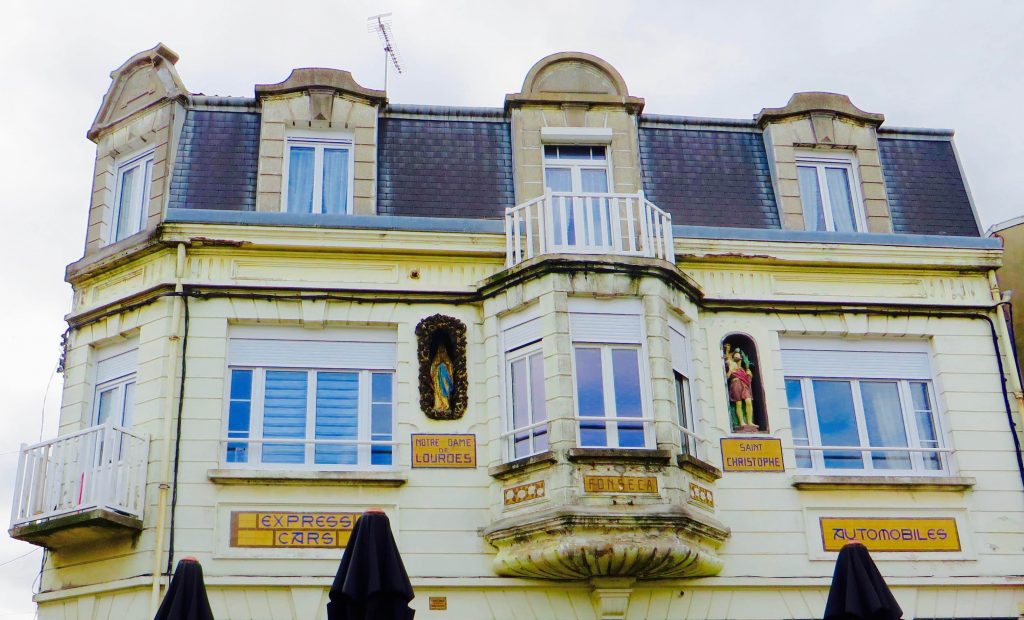
This building is on the main street. I find it bizarre that Our Lady of Lourdes and St. Christophe seem to be advertising ‘Express Cars’ and ‘Automobiles’ ! But 100% preferable to having a flimsy, tacky, garage advertising burgers. In fact, the non sequitur arrangement very much appeals!

In the summer, Wimereux is known for its kite surfing, sand yachting and hot air ballooning. On the beach, there are still a few hardy souls riding the waves from dawn until dusk.

This photo somewhat reminds me of Eugène Boudin, who was one of the first artists to paint ‘en plein air’ and was a mentor to the young Claude Monet, who was brought up in Le Havre. Boudin, (1824 – 1898), was born in Honfleur, the son of a sailor. He met Monet in 1858. Boudin is especially well known for his beach scenes.
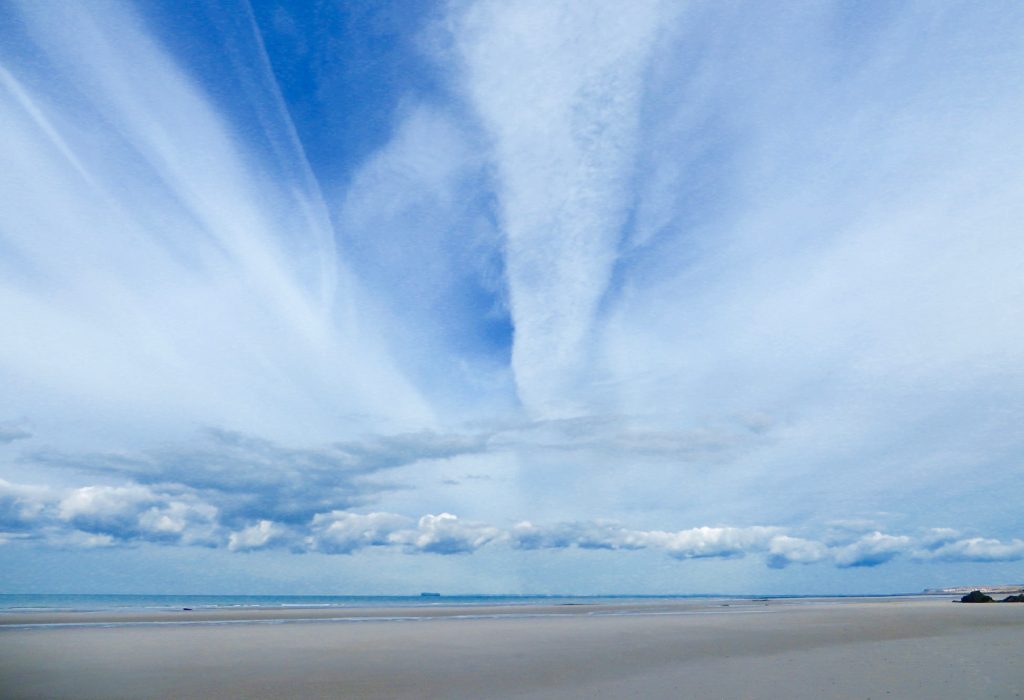

… and we had them almost exclusively to ourselves save for a few dog walkers. Magnifique. This is just the place to clear your head and make a fresh start.
On a more sombre note there have been a lot of landslides – the cliffs are friable and several pillboxes and blockhouses left from the Second World War are victims, hurled down onto the rocks below.
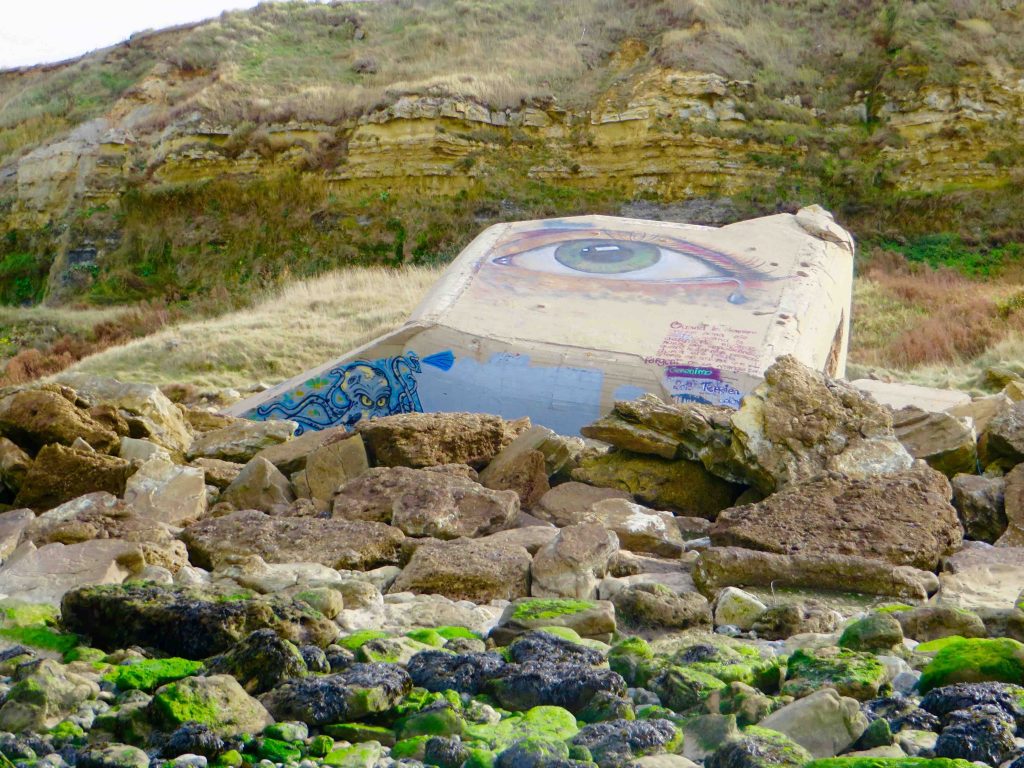
Maybe the eye is a reminder. ‘Lest we forget’. There are still many pillboxes dotted along this coast and also a huge, sinister looking blockhouse containing a small museum of memorabilia near Wissant. Worth a visit.
We retraced our steps and were soon striding back along the ‘digue’ with the wind in our hair.

Nowadays with email, many fewer postcards are sent, which is a pity. I hope the two I sent will be enjoyed!
I wonder what will have happened at the end of this month. Will Brexit have isolated us from the rest of Europe? Since the end of WW2 people have forgotten that an enormous effort was made to work out a structure of international agreements to prevent another war. The risk now looms again, ever larger, forces that seem to be out of our control.
A great percentage of the population know little about history in general. And some have no wish to learn or remember. I include here a lot of politicians, which is a disastrous situation. I am looking around in vain for a visionary with an addition of common sense.
However, there are a lot of good people doing great things out there and I am positive that at some point the tide will turn in their favour. There are natural cycles in our history, just as in nature.

The Channel is looking cold.
Dinner at the hotel is in the offing after a quick visit to the Carrefour supermarket and some of the exclusive looking delicatessens and wine shops in the rue Carnot.




A delicious box of biscuits with Snowy – Milo en français – on the lid. I have always been a fan of Tintin books and obviously he is as popular here. The author, Hergé, hailed from Belgium.
And thinking of things being delicious, here is our last dish in France coming up.
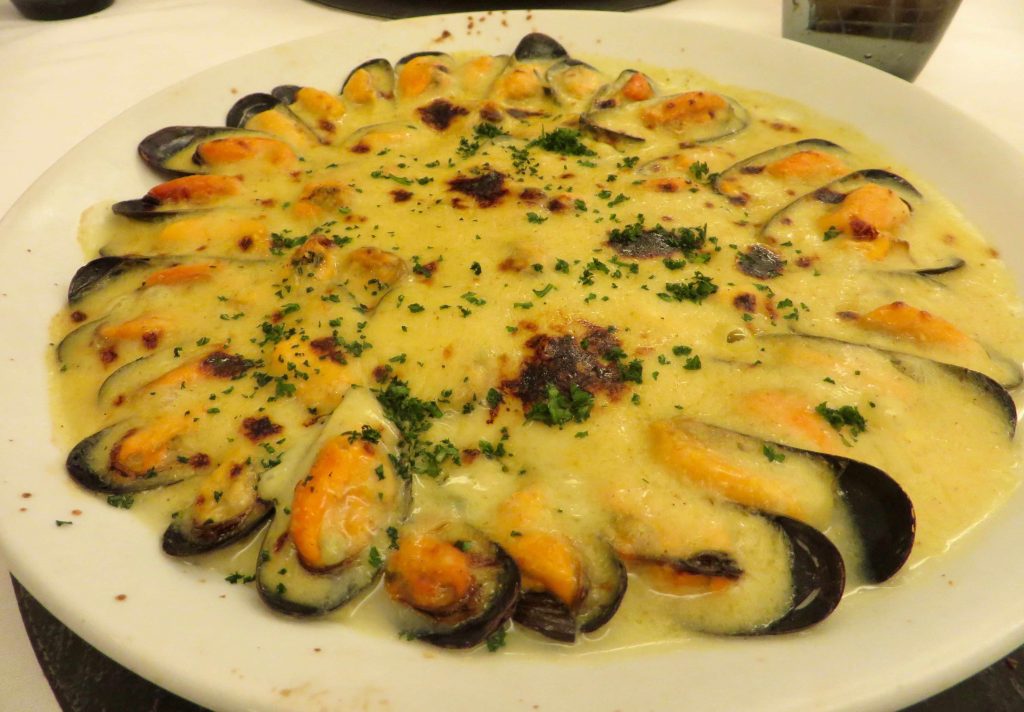
Time to leave but it’s not far to drive to the Channel tunnel. I always think just three or four days away from normal daily life gives a great boost to morale. Speaking another language, enveloping yourself in another culture, welcomed with delicious food and drink and a comfortable place to lay your head.
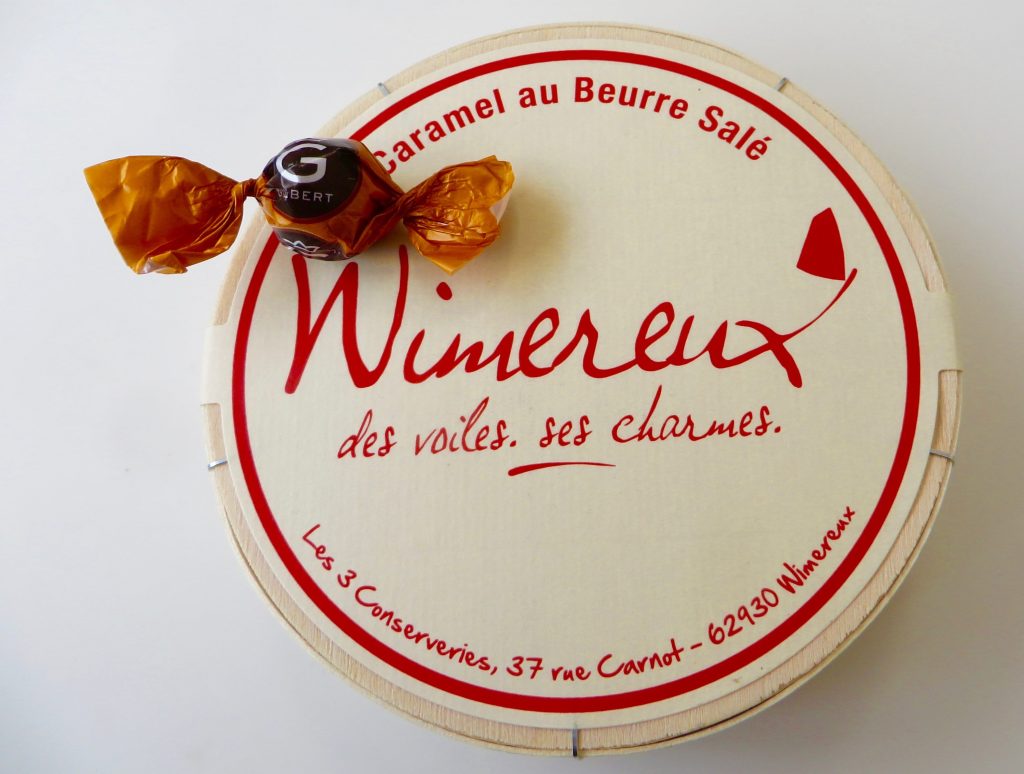
The ‘dog days’ of August – people on holiday, searching for the sun, which they seem to have left behind in London. It was so very hot. I used to work in Mayfair in the 1970s for Heinemann – publishers in Curzon Street, near Shepherd’s Market. Mayfair was always wealthy and quiet, with an ambient buzz around the narrow streets of the market area. Not the Berwick Street type of market with stalls – more an ancient pub or two, bijou boutiques, art galleries and discreet restaurants. And one or two ‘ladies of the night’. The Mayfair Curzon cinema with its marble ‘toilettes’ is nearby – always a treat. And the upmarket Connaught hotel. I’ve never been inside but it was a favourite watering hole for Alec Guinness … (he played ‘Smiley’ in John Le Carré’s novels, which were adapted for television).
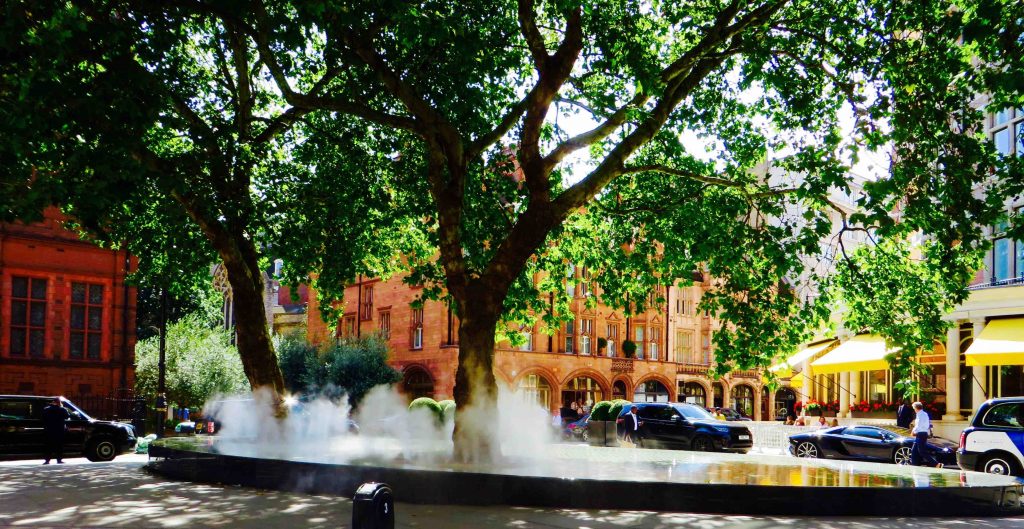
I stood next to the refreshing spray coming from the fountains – opposite was an exotic floral display at Roland Mouret – fashion designer. The display is by a friend of mine.

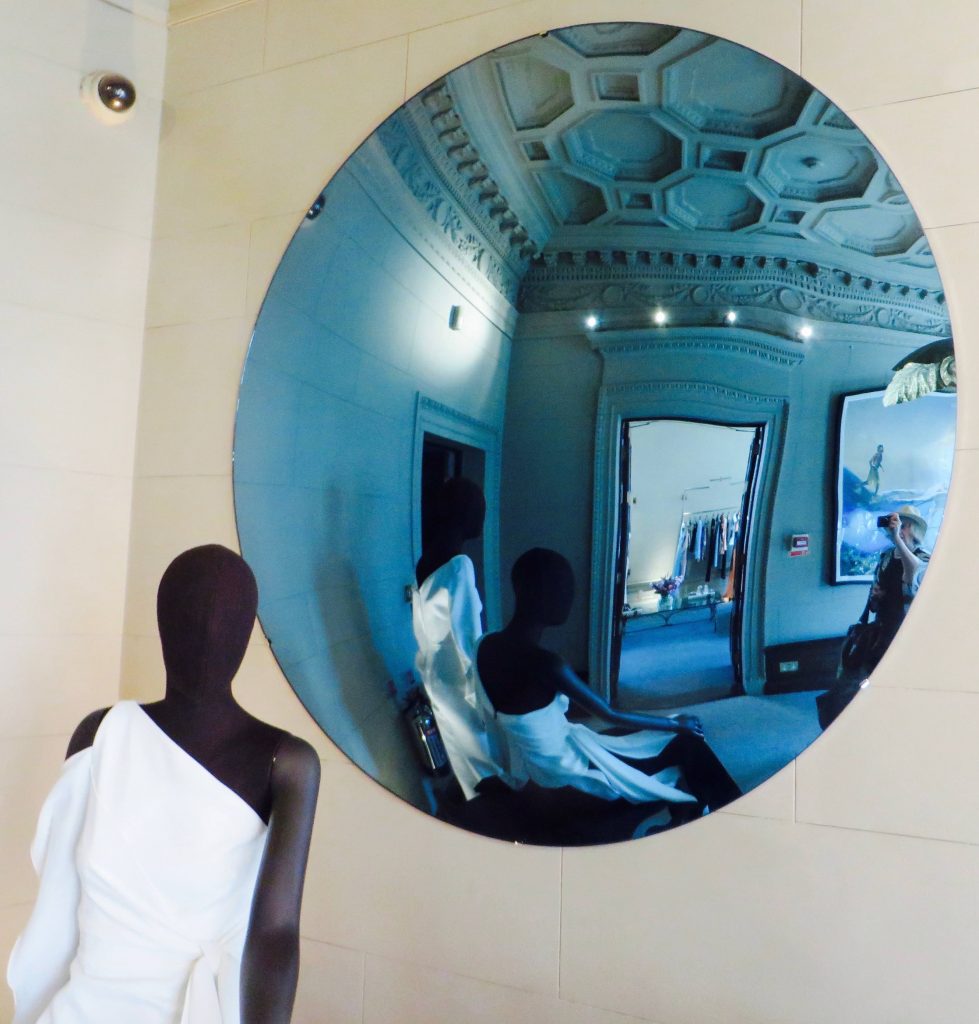
Designer fashion and sleek, purring cars with Dubai number plates are two a penny around here …

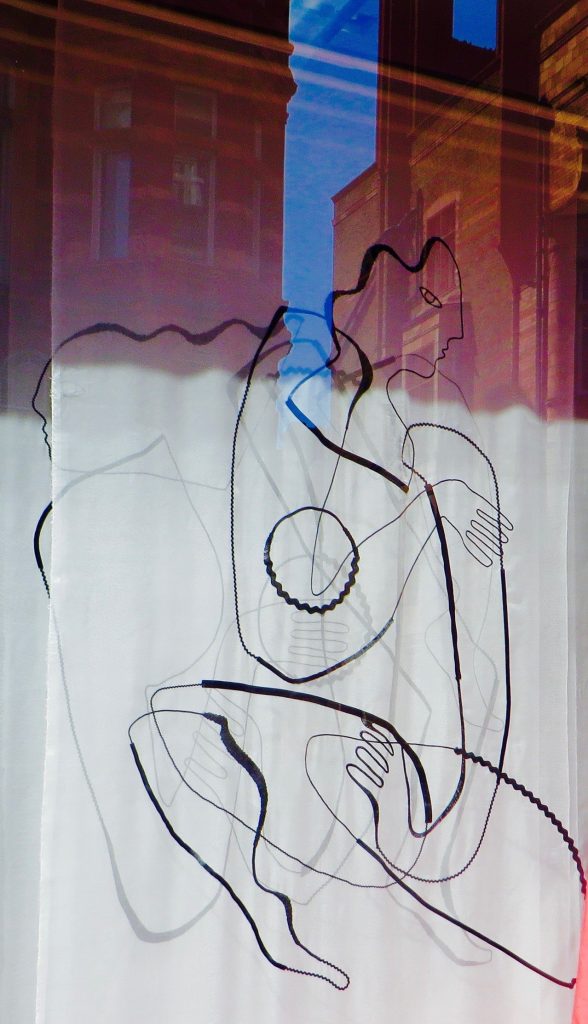

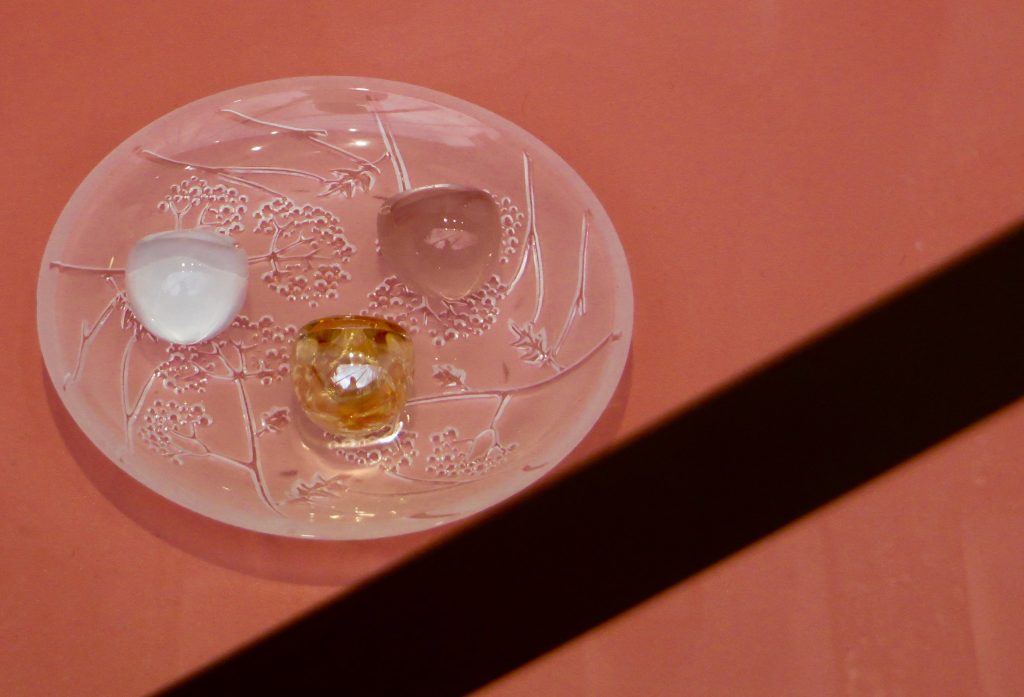




A lot of galleries have had to leave Cork Street because of modern redevelopment and presumably higher rents. Some have reverted to being ‘online’ only. I’m glad this one seems to have survived and look forward to its new persona. I especially miss the Medici … Some months ago I turned the corner left out of Cork Street, where there is a small café. It has been there for many years – this time I was especially happy to see Bill Nighy sitting outside, enjoying a cup of coffee. I smiled at him and hurried on.
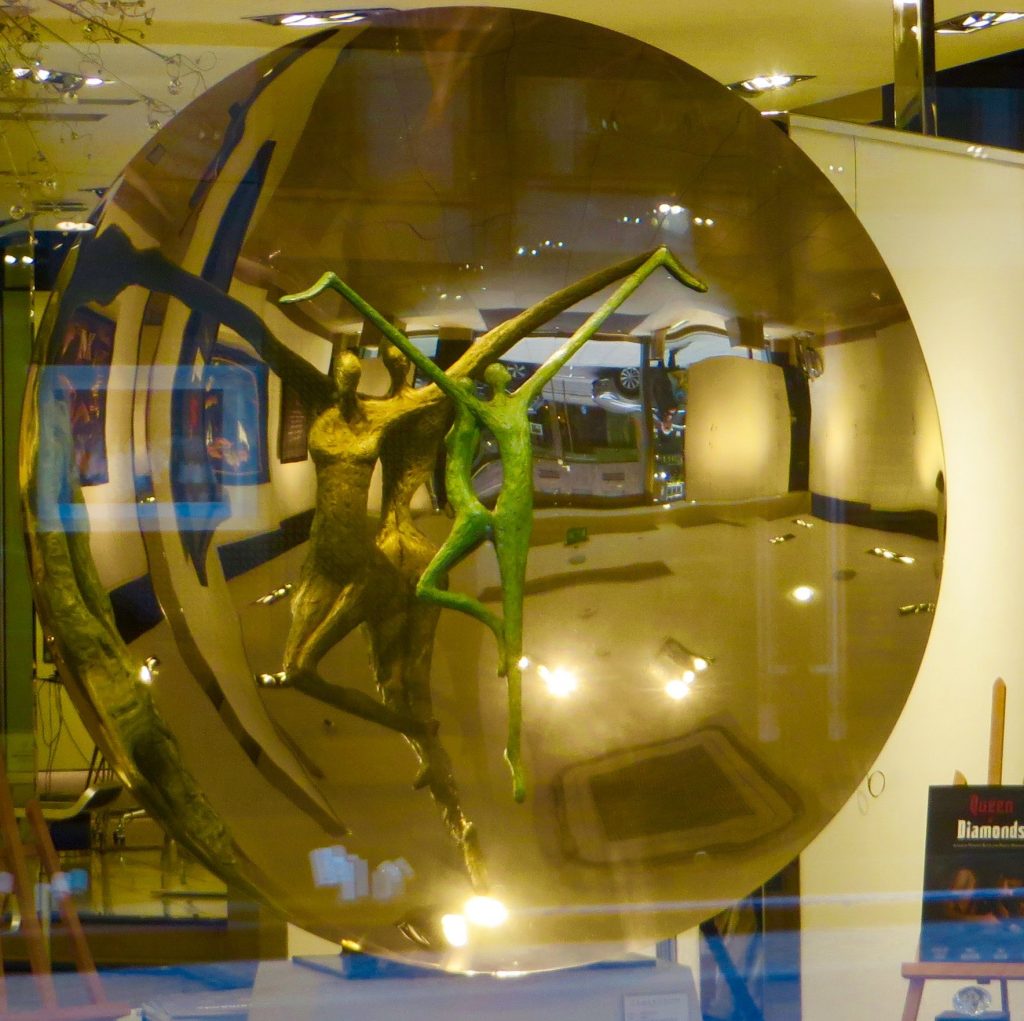
So that was my Bank Holiday Saturday. In a few minutes I will see my two favourite bookshops on Piccadilly – Hatchards and Waterstones. I can’t pass a bookshop without buying a book … but first, a glamorous afternoon needs to finish with a glamorous cup of tea.
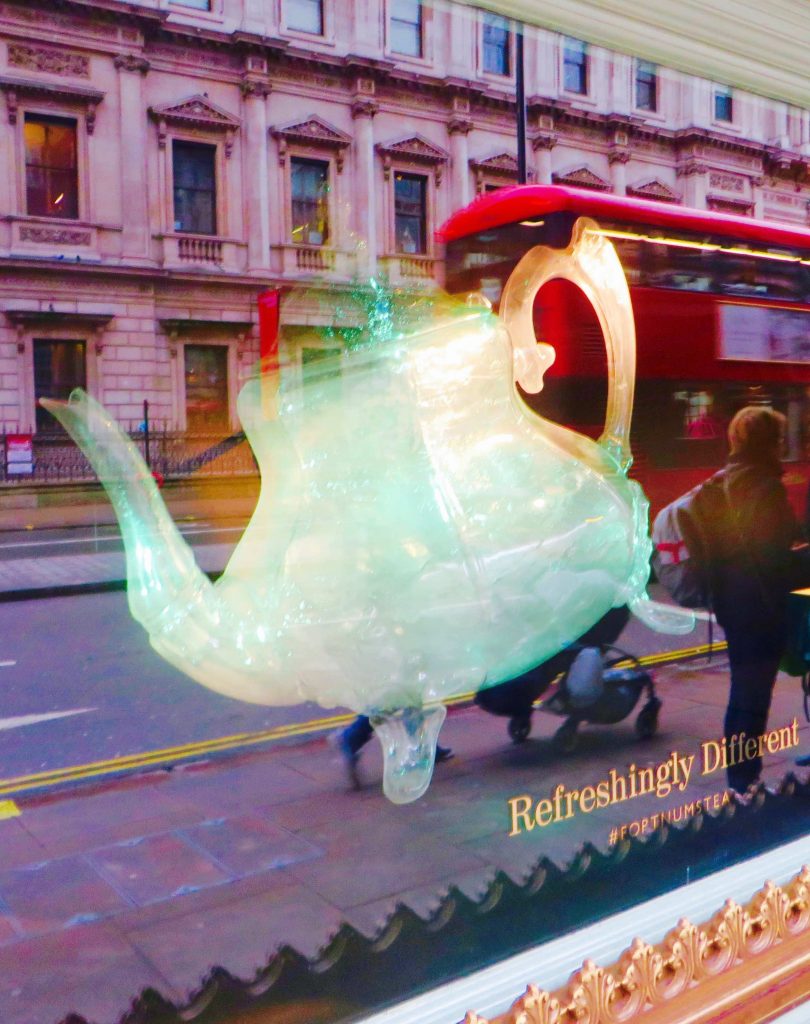
P.S. The book I came home with was ‘The Lady Vanishes’ by Ethel Lina White. She used to be as well known as Agatha Christie, writing over fifteen mysteries and Hitchcock made a great film of this book. Sadly, she fell into obscurity after her sudden death in 1944. Recommended!